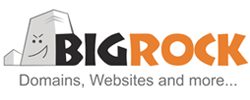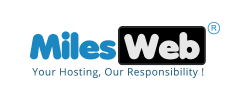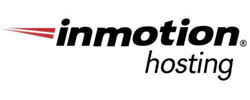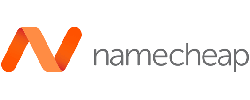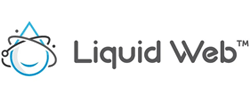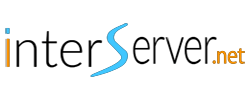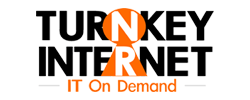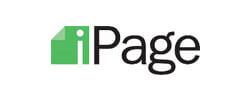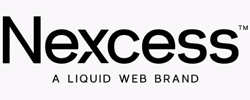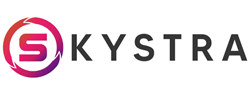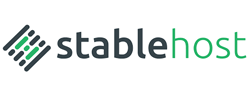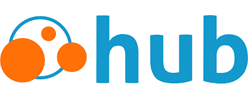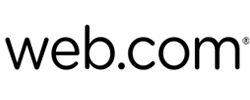30 Best Web Hosting Services Company
Last updated on January 19, 2025 by RGB Web Tech
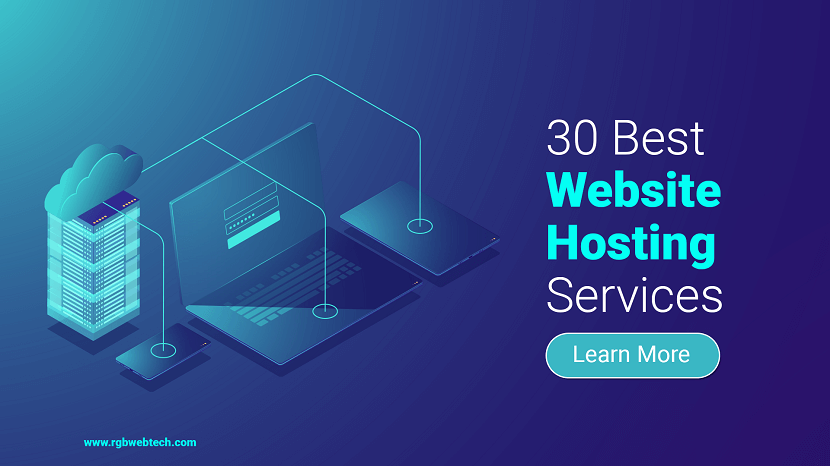
Introduction of Cheap Web Hosting Service
Cheap web hosting service refers to a type of web hosting that is available at a low cost. This hosting service is suitable for individuals, small businesses, or anyone who needs a simple website without the need for advanced features or high-performance servers.
A cheap web hosting service usually offers a shared hosting plan, where multiple websites are hosted on a single server. This type of hosting service is typically less expensive than other hosting options like dedicated hosting or VPS hosting, as the cost of server maintenance and upkeep is shared among multiple users.
While cheap web hosting services may have some limitations, such as limited storage space or bandwidth, they can still provide users with the basic tools and features needed to create and manage a website. These features may include a website builder, email accounts, and access to cPanel or other management tools.
Overall, a cheap web hosting service can be a good option for those on a tight budget who need to get a website up and running quickly without the need for advanced features or customization. It is important to research different providers to find one that offers reliable service and good customer support, as well as a plan that meets your specific needs and requirements.
Table of Article Contents
- What is Web Hosting?
- Top 30 Cheap Web Hosting Service Providers
- Advantages of Cheap Web Hosting Service
- Disadvantages of Cheap Web Hosting Service
- Types of Cheap Web Hosting Service
- Paid V/S FREE Cheap Web Hosting Service
- How to choose Cheap Web Hosting Service?
- Features of Cheap Web Hosting Service
- FAQs
- Conclusion
- Video
What is Web Hosting?
Web hosting refers to the service of providing storage space and access to web servers to host a website on the internet. In simpler terms, web hosting allows individuals or organizations to make their website accessible via the World Wide Web.
When someone wants to access a website, they enter the website's domain name (such as www.example.com) into their web browser. The browser then sends a request to the web hosting server where the website is stored, and the server responds by sending the website's content back to the user's browser, which displays it on the screen.
Web hosting services can be offered by companies that specialize in web hosting, known as web hosts or hosting providers. These companies provide different types of web hosting plans, such as shared hosting, VPS hosting, dedicated hosting, and cloud hosting, each with different levels of performance, security, and scalability.
Web hosting also involves the use of various software and technologies to manage the hosting environment and provide website owners with tools and features to manage their websites, such as cPanel, FTP access, database management, and email hosting.
Overall, web hosting is an essential service that allows businesses and individuals to establish an online presence and make their website accessible to anyone with an internet connection.
Top 30 Cheap Web Hosting Service Providers
Here are the top 30 cheap web hosting service providers along with their sales, discount and pricing plans:
- Exclusive Sale - Upto 60% OFF
- Starting at
$9.99.00$3.49/month*
Inmotion Hosting
- Alexa Rank 5,622
- Exclusive Sale - Upto 75% OFF
- Starting at
$7.99$1.99/month*
iPage
Advantages of Cheap Web Hosting Service
Here are some advantages of using a cheap web hosting service:
1. Affordability: The most obvious advantage of using a cheap web hosting service is affordability. With low-cost plans, you can get started with your website without breaking the bank.
2. Easy to Use: Most cheap web hosting services provide easy-to-use control panels and website builders, making it easy for even beginners to set up their websites.
3. Scalability: Cheap web hosting plans often allow you to upgrade to higher plans as your website grows. This allows you to start with a basic plan and upgrade as needed, without having to switch to a new provider.
4. Technical Support: Despite being low-cost, most cheap web hosting services offer technical support around the clock to help you with any issues you may encounter.
5. Flexibility: Many cheap web hosting services offer a range of plans with different features, allowing you to choose the one that best fits your needs and budget.
6. Good for Small Websites: If you have a small website with low traffic, a cheap web hosting service may be all you need. You can save money on hosting fees and invest in other areas of your website or business.
7. Backup and Security: Even cheap web hosting services offer backup and security features, protecting your website from data loss and security breaches.
Overall, cheap web hosting services can be a great option for individuals and small businesses looking to launch their website on a budget. However, it's important to research and compare different providers to find the one that best meets your needs and budget.
Disadvantages of Cheap Web Hosting Service
While there are many advantages of using a cheap web hosting service, there are also some potential disadvantages to consider:
1. Limited Resources: Cheap web hosting services often have limited resources, such as storage, bandwidth, and processing power. This can affect the performance of your website and limit its scalability.
2. Reliability: With a low-cost hosting plan, you may experience more downtime or slower website loading times due to the sharing of resources among multiple users.
3. Customer Support: While many cheap web hosting services offer 24/7 customer support, the quality of support may be limited due to the lower price point. You may not receive as much help or expertise as you would with a more expensive hosting provider.
4. Limited Features: Cheap hosting plans may have fewer features and limitations, such as limited email accounts, no automatic backups, or no advanced security features.
5. Shared Hosting: Most cheap web hosting plans are shared hosting, which means your website shares the server with other websites. This can cause performance issues or security risks if one of the other websites on the server experiences a problem.
6. Renewal Costs: Some cheap web hosting providers offer promotional rates for the first year, but the renewal costs may be higher. This can catch some people off guard and cause unexpected expenses.
Overall, cheap web hosting services can be a good option for those on a tight budget, but it's important to consider these potential disadvantages and do your research before making a decision. Look for a hosting provider that balances affordability with reliability, features, and customer support.
Types of Cheap Web Hosting Service
There are several types of cheap web hosting services available, each with its own advantages and limitations. Here are some of the most common types:
1. Shared Hosting:Shared hosting is the most common type of hosting, where multiple websites share the same server and its resources, including storage space, bandwidth, and CPU. It is an affordable option for small businesses and individuals who are just starting with their website.
2. WordPress Hosting:WordPress hosting is a specialized type of web hosting designed specifically for websites built on the WordPress content management system (CMS). WordPress is the most popular CMS in the world, used by millions of websites to create and manage their content.
3. Virtual Private Server (VPS) Hosting:VPS hosting involves a server that is partitioned into multiple virtual servers, each with its own resources, operating system, and control panel. It is a step up from shared hosting, providing more control, flexibility, and security.
4. Dedicated Hosting: With dedicated hosting, a website gets its own server, which means all the resources are exclusively dedicated to that website. This option provides the highest level of control, flexibility, and security, but it can also be expensive.
5. Cloud Hosting:Cloud hosting involves a network of interconnected servers that work together to provide hosting resources. This type of hosting is highly scalable, flexible, and reliable.
6. Managed Hosting:Managed hosting involves a hosting provider managing and maintaining a website's server, including updates, security, backups, and more. This option is ideal for those who do not have the technical expertise to manage their own server.
7. Reseller Hosting:Reseller hosting allows individuals or businesses to purchase hosting resources from a hosting provider and resell them to their clients, usually at a higher price. It is a way to start a web hosting business without the need for expensive infrastructure.
8. Colocation Hosting:Colocation hosting, also known as colo hosting or colocation, is a type of web hosting where a company or individual rents space in a data center to store their own servers and equipment. Unlike traditional web hosting, where a hosting provider owns and manages the servers, in colocation hosting, the client owns and manages their own servers and equipment.
9. Self Service Hosting:Self-service hosting, also known as unmanaged hosting, is a type of web hosting where the client is responsible for all aspects of managing their website, including server configuration, software installation, security, and maintenance. The hosting provider only provides the physical server hardware and internet connectivity, but no management services or technical support.
10. Cluster Hosting:Cluster hosting, also known as cloud hosting or clustered web hosting, is a type of web hosting that uses a cluster of servers to host websites and applications. In a cluster hosting environment, multiple servers work together to provide greater performance, scalability, and reliability than traditional hosting options.
Paid V/S FREE Cheap Web Hosting Service
When it comes to web hosting, you often get what you pay for. While free hosting may seem like an attractive option for those on a tight budget, there are some key differences between paid and free cheap web hosting services that you should consider.
Paid Web Hosting Service:
Advantages:
- More reliable: Paid web hosting services typically offer more reliable and consistent performance than free hosting services.
- More resources: Paid hosting plans typically offer more resources, such as storage, bandwidth, and processing power, than free hosting plans.
- Better customer support: Paid hosting providers often offer better customer support, with faster response times and more experienced technicians.
- More features: Paid hosting plans typically offer more features and tools, such as automatic backups, advanced security features, and website builders.
Disadvantages:
- Cost: Paid hosting plans come with a cost, which may be a barrier for those on a tight budget.
- Contract length: Many paid hosting providers require a minimum contract length, which may not be suitable for those who are unsure about their website's future needs.
Free Web Hosting Service:
Advantages:
- No cost: The main advantage of free hosting is that it's free, making it a good option for those on a tight budget.
- Easy to use: Free hosting services often offer simple and easy-to-use website builders and control panels.
- No contract: Free hosting services typically don't require a contract, which provides more flexibility.
Disadvantages:
- Less reliable: Free hosting services often have limited resources and may not offer consistent performance or uptime.
- Limited features: Free hosting plans may have limited features and may not offer advanced tools such as automatic backups or advanced security features.
- Limited support: Free hosting providers may not offer as much support as paid providers, and the support may not be as experienced or responsive.
- Advertisements: Some free hosting services display advertisements on your website, which can be distracting or unprofessional.
Overall, if you're serious about your website and want reliable performance, more features, and better support, paid hosting is generally the better choice. However, if you're on a tight budget and don't need advanced features, free hosting can be a good option to get started.
How to choose Cheap Web Hosting Service?
Choosing the right cheap web hosting service can be a daunting task, especially if you're new to web hosting. Here are some key factors to consider when choosing a cheap web hosting service:
1. Reliability and Uptime: Choose a web hosting company that has a reputation for high uptime and reliability. You want a provider that guarantees at least 99.9% uptime, ensuring that your website is always available to visitors.
2. Server Speed and Performance: Choose a web hosting provider with fast servers and high performance. Slow-loading websites can negatively impact user experience and search engine rankings.
3. Scalability and Flexibility: Choose a web hosting provider that can scale and grow with your website. Your hosting plan should allow you to easily upgrade or downgrade your resources as your needs change.
4. Security: Choose a web hosting provider that takes security seriously, with measures such as SSL certificates, firewalls, malware scanning, and regular backups to protect your website and data.
5. Customer Support: Choose a web hosting provider that offers reliable and accessible customer support, with multiple channels such as phone, email, and live chat available 24/7.
6. Pricing and Value: Choose a web hosting provider that offers a good balance between pricing and value, with transparent pricing and no hidden fees. Compare pricing and features across multiple providers to find the best fit for your needs and budget.
7. User-Friendly Control Panel: Choose a web hosting provider that offers a user-friendly control panel, such as cPanel, which allows you to easily manage your website, email, and other hosting features.
By considering these factors, you can choose a best website hosting service that meets your need and provide a reliable platform for your website.
Features of Cheap Web Hosting Service
Cheap web hosting services may vary in terms of the specific features they offer, but here are some common features you can expect from a good cheap web hosting service:
1. Storage Space: Web hosting provides storage space for all website files, including images, videos, and web pages.
2. Bandwidth: Bandwidth refers to the amount of data that can be transferred between the website and its visitors. Web hosting providers offer different bandwidth limits, so choose a plan that meets your website's needs.
3. Domain Name: A domain name is the website address that visitors use to access your site. Many web hosting providers offer domain registration services.
4. Email Accounts: Web hosting often includes email accounts, which allow you to use your domain name for email addresses, such as [email protected].
5. Control Panel: A control panel allows you to manage your website, email accounts, and other hosting features.
6. Security Features: Web hosting providers offer various security features, such as SSL certificates, firewalls, and malware scanning, to protect your website and data from online threats.
7. Website Builder: Some web hosting providers offer website builders, which allow you to create a website without coding or design skills.
8. Backup and Recovery: Web hosting providers should offer regular backups and a recovery system in case of data loss or website issues.
9. Technical Support: Good web hosting providers offer 24/7 technical support, with multiple channels such as phone, email, and live chat.
10. Scalability: As your website grows, you may need more resources, so choose a web hosting provider that allows you to easily upgrade or downgrade your plan to meet your needs.
FAQs - Cheap Web Hosting Service
Here are some frequently asked questions about cheap web hosting service:
1. What is a cheap web hosting service?
Answer : Cheap web hosting service is a hosting service that offers web hosting at a low cost, usually starting at a few dollars per month. These hosting services are suitable for small websites and individuals who have a limited budget.
2. What are the advantages of a cheap web hosting service?
Answer : The advantages of cheap web hosting services are that they are affordable, easy to use, and can provide all the necessary features to host a website. They are also suitable for small businesses and individuals who have a limited budget.
3. What are the disadvantages of cheap web hosting service?
Answer : The disadvantages of cheap web hosting service are that they may not provide the best performance, uptime, or customer support. They may also have limitations on the resources and features provided.
4. What are the types of cheap web hosting services?
Answer : The types of cheap web hosting service include shared hosting, VPS hosting, cloud hosting, and reseller hosting. Each type has its own advantages and limitations.
5. What should I look for when choosing a cheap web hosting service?
Answer : When choosing a cheap web hosting service, you should consider factors such as price, uptime, performance, features, support, scalability, and reputation.
6. Can I upgrade my hosting plan later?
Answer : Yes, most hosting providers allow you to upgrade your hosting plan as your website grows and requires more resources.
7. Is a free web hosting service a good option?
Answer : Free web hosting service may be a good option for personal websites or experimental projects, but it may not provide the best performance, uptime, or security. It may also have limitations on the resources and features provided. Paid hosting services are generally recommended for businesses and serious websites.
8. What is bandwidth?
Answer : Bandwidth is the amount of data that can be transferred between your website and its visitors. Web hosting providers offer different bandwidth limits, so choose a plan that meets your website's needs.
9. What is a domain name?
Answer : A domain name is the website address that visitors use to access your site. Many web hosting providers offer domain registration services.
10. What is a control panel?
Answer : A control panel is a web-based interface that allows you to manage your website, email accounts, and other hosting features.
11. What is SSL?
Answer : SSL (Secure Sockets Layer) is a security protocol that encrypts data between the website and its visitors. It is important for securing online transactions and protecting sensitive data.
12. What is a website builder?
Answer : A website builder is a tool that allows you to create a website without coding or design skills. Some web hosting providers offer website builders as part of their hosting plans.
13. What is uptime?
Answer : Uptime refers to the amount of time that your website is online and accessible to visitors. Good web hosting providers guarantee at least 99.9% uptime.
14. What is shared hosting?
Answer : Shared hosting is a type of hosting where multiple websites share the same server and its resources. It is an affordable option for small businesses and individuals who are just starting with their website.
15. What is VPS hosting?
Answer : VPS hosting involves a server that is partitioned into multiple virtual servers, each with its own resources, operating system, and control panel. It is a step up from shared hosting, providing more control, flexibility, and security.
16. What is dedicated hosting?
Answer : Dedicated hosting involves a website getting its own server, which means all the resources are exclusively dedicated to that website. This option provides the highest level of control, flexibility, and security, but it can also be expensive.
Conclusion - Cheap Web Hosting Service
In conclusion, cheap web hosting services are an excellent option for individuals and small businesses that have a limited budget. While they may have some limitations compared to more expensive hosting options, they can provide all the necessary features to host a website. When choosing a cheap web hosting service, it's important to consider factors such as price, uptime, performance, features, support, scalability, and reputation. By doing your research and comparing multiple hosting providers, you can find a reliable and affordable hosting service that meets your needs.
You now know which the best Web Hosting Services company is, and you are ready to try one out. Good luck in the world of hosting!
If this article is helpful for you, please share it on your social media handles Because sharing is caring!
If you found this article helpful, we encourage you to share it on your social media platforms—because sharing is caring! For more information about article submissions on our website, feel free to reach out to us via email.
Send an emailWritten by RGB Web Tech
Latest Technology Trends
Latest technology trends shaping the future, including AI advancements, blockchain innovation, 5G connectivity, IoT integration, and sustainable tech solutions. Explore breakthroughs in quantum computing, cybersecurity, augmented reality, and edge computing. Stay ahead with insights into transformative technologies driving innovation across industries and revolutionizing how we live, work, and connect.
19 Best Front End Framework for Web Development
Last updated on January 19, 2025 by RGB Web Tech
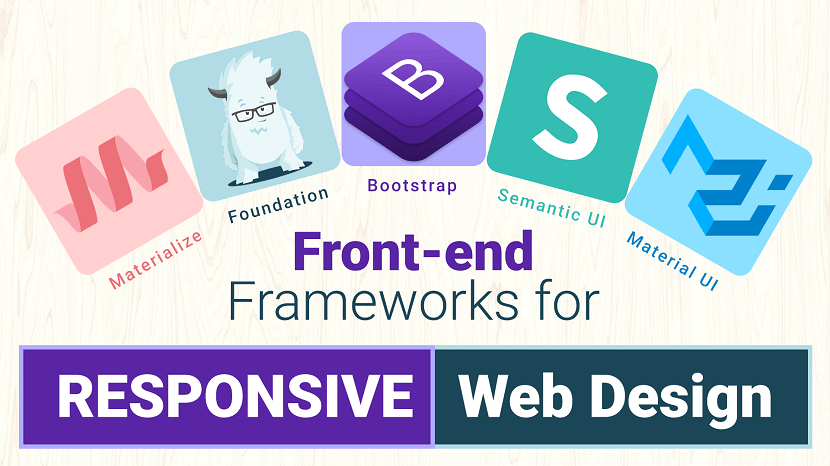
Front-end frameworks for responsive web design have become essentially important for the websites. There has already been too much buzz about the ongoing practice of using a responsive framework while initiating web designing. Because of the effectiveness of these frameworks, they are becoming more popular among the developers. Responsive frameworks are far better than the non-responsive ones. Additionally, they are effective and help in the development of user-centric applications.
Responsive web design front-end frameworks include CSS and HTML5 tags and thus they are the best choice to create exceptional website designs. There are several best front-end frameworks available to use to create exceptional websites. Here is a brief on some of the most renowned frameworks used popularly by developers.
1. Twitter Bootstrap
This list would be woefully incomplete without the inclusion of the wildly popular frontend framework, Bootstrap. Created by Twitter developers and initially released in 2011, it's the most used open source framework in the world.
Like any effective frontend framework, Bootstrap includes CSS, HTML and JavaScript, or JS, components. It adheres to responsive web design standards, allowing you to develop responsive sites of all complexities and sizes.
Because it is updated continually, Bootstrap typically includes the latest and best features. For example, it added themes that met Google's material design guidelines shortly after they were published, and it was also upgraded to use Sass as a CSS preprocessor.
Pros:
- Massive community support.
- Widest variety of themes.
- Best browser capability.
- Has both a fluid and fixed pattern grid system.
- More development tools available.
- Many popular websites are built on this framework.
- Superiority in mobile support.
- Most of the celebrated custom web development companies prefer this tool.
Cons:
- Not as lightweight when compared to others. Out-of-the-box file size of 276 KB due to an excessive number of rarely used styles.
- Difficult to use jQuery plugins.
- Websites are easily recognizable.
- The excessive number of HTML classes and DOM elements can be messy and confusing.
Ideal for: Beginners and those who prefer a robust front-end framework.
2. Foundation
Created by web design company Zurb, Foundation is a highly advanced, enterprise-grade frontend framework that is ideal for developing nimble, responsive websites. Used on sites like Facebook, eBay, and Mozilla, it is also fairly complex and may not be suitable for newbies.
This features-rich framework supports GPU acceleration for smooth, lightning fast animations and Fastclick.js for fast rendering on mobile devices. It runs on the Sass preprocessor and includes the Foundation-developed data interchange attribute, which lets you load lightweight HTML sections for mobile and "heavier" HTML sections for larger screens. For a comparison between Foundation and Bootstrap, read our complete article, Bootstrap vs Foundation.
Pros:
- Offers finest of the customization abilities.
- Possess a robust grid system.
- Provides rapid development of code.
- Easy to use templates available for download.
- Offers services for sites as well as emails.
- Design-it-yourself approach.
- Lightweight.
Cons:
- More complex when trying to customize.
- Not a great framework for beginners.
- Less popular in comparison to Bootstrap.
Ideal for:Developers who have decent amounts of experience and who are primarily concerned with developing fast, attractive, responsive websites.
3. Semantic UI
A relative newcomer on the scene, Semantic-UI stands out in several ways and is poised to become one of the most popular front-end frameworks out there.
This framework's main claim to fame is its simplicity. Because it uses natural language, the code is self-explanatory. Even those with very little coding experience will feel fairly at home working with this framework.
Another notable feature of Semantic-UI is that it is integrated with a dizzying array of third-party libraries. So much so, that you probably won't need to use any others. Therefore, the development process is a bit easier and more streamlined.
Pros:
- Semantic class names make for a low barrier of entry, so even beginners can hit the ground running.
- Small file sizes and minimal load times because you can load only the components that you need; each has its own JS file and style sheet.
- Versatile elements make for easy customization.
Cons:
- Very large packages when compared to Foundation and Bootstrap.
- Those with more complex design and development needs may find this framework lacking.
Ideal for: Beginners and those who want a lightweight, nimble framework.
4. Material UI
If you're looking for a front-end framework that makes it easy to adhere to Google's material design guidelines, you can't go wrong with Material UI. It is by far the most elaborate framework to implement these guidelines thus far, but there is one caveat: It isn't meant to be a starting point for a brand-new web design project.
Loaded with ready-to-use CSS and material design-compliant components, Material UI uses a CSS-in-JS solution. This unlocks many great features including theme nesting, dynamic styles, self-support, etc.
Pros:
- The easiest way to meet Google's material design guidelines when using a framework.
- Highly customizable.
Cons:
- Not intended to serve as a starting point for from-scratch web design projects.
- Need a decent understanding of React to use effectively.
Ideal for: Developers who understand and have experience with React and who need an easy way to adhere to material design guidelines.
5. Materialize
The Materialize responsive front-end development framework also implements Google's material design specifications and is loaded with ready-to-use buttons, icons, cards, forms, and other components. It is offered in both a standard version and in one that runs on Sass.
Materialize includes a convenient IZ column grid feature that can be used for website layouts. It is also loaded with CSS that's ready to use out of the box for material design shadows, typography, colors, and other features.
Additional features include ripple-effect animation, drag-out mobile menus, Sass mixins, and more.
Pros:
- Huge selection of components.
- Responsive support ensures that websites are supported across all devices.
Cons:
- The large file size makes this a bulky framework to work with.
- No support for Flexbox model.
Ideal for: Less experienced developers who need guidance regarding Google's material design specifications.
6. UIKit
UIKit is a highly modular front-end framework that stands out among most front-end development frameworks for many reasons. Chief among them is the fact that it includes both Less and Sass CSS preprocessors.
Loaded with an array of nimble, responsive components with consistent naming conventions, UIKit has become one of the most popular front-end frameworks out there.
It's more than 30 extendable, modular components can be combined for even more versatility. It includes navigation components like side navigation bars; elements like HTML forms and tables; JavaScript components like off-canvas bars and modal dialogs; common elements like buttons, badges, and overlays; and layout components, including a fluid, completely responsive grid system.
Pros:
- Highly customizable.
- Exceptionally modular, so you can add components to the style sheet without negatively impacting overall style.
- Create advanced user interfaces using components like nestable.
Cons:
- Very few resources out there due to the relative newness.
Ideal for: Fairly experienced developers due to the current lack of available resources. Otherwise, it is great for simple and complex projects alike.
7. Pure
Created by the Yahoo development team, Pure comes with a lightweight array of CSS modules that can be used in just about any project. Using Pure, you can easily create responsive buttons, menus, grids, tables, and other features. Because it is purely CSS based, however, it does not support JavaScript or jQuery plugins.
When minified and compressed with Gzip, Pure clocks in at just 4.5 KB, making it one of the lightest and nimblest front-end development frameworks out there. As a result, it is terrific for mobile website development, and many developers rely on it for precisely that.
Pros:
- Extremely lightweight, ensuring fast loading times even on mobile devices.
- A flexible array of CSS modules can be used on just about any web design and development project.
Cons:
- CSS only - does not include jQuery or JS plugins.
Ideal for: Developers who are focusing on creating responsive, fast mobile websites.
8. CreateJS
CreateJS is a suite of open-source JavaScript libraries and tools for creating rich, interactive HTML5 content. It consists of 5 modular JavaScript libraries. It will help you with implementing animation effects, supporting HTML5 audio on your website, and much more.
Adobe, Microsoft, and AOL sponsor this project.
Pros:
- It is helpful for rich, interactive HTML5 content.
Cons:
- You have basic knowledge of JavaScrip.
Ideal for: It is ideal for creating animation effects and HTML5 Audios on your website.
9. HTML5 Boilerplate
In 2010, HTML5 Boilerplate became one of the first, and subsequently, most popular open-source front-end web development tools for getting HTML5 websites and web apps up and running in no time. It’s a compilation web development solution that enables our websites to support modern web browsers.
Included in HTML5 Boilerplate is a mobile-friendly HTML template, placeholder icons, CSS resets for normalizing/standardizing your stylesheet property values, standard media queries for popular viewing screens, an HTML5shiv for non-modern web browsers, and more.
Pros:
- It is an open-source front-end web development tool.
- Mobile-friendly HTML template.
Cons:
- It required basic knowledge of HTML/HTML5 and CSS/CSS3.
Ideal for: It is ideal for designing responsive websites.
10. Milligram
Milligram is another extremely lightweight framework similar to Skeleton. When Gzipped, it comes out to just 2 KB in size and is used to provide developers with a simplistic and convenient starting point.
Milligram’s grid system is different than most because of its use of the CSS Flexible Box Layout Module standard. It also includes a few key components for getting you started including typography, buttons, forms, lists, tables, blockquotes, etc.
Pros:
- Very lightweight, only 2 KB when Gzipped.
- Uses CSS Flexbox as the grid system.
Cons:
- Few resources available due to the relative newness.
- Minimal styling components available compared to other larger frameworks.
Ideal for: Developers who are creating a small project that doesn't require any styling components and want to use a CSS Flexbox grid system.
11. Susy
Some would argue that Susy isn't a Front-end Framework in the truest sense of the term because it is focused on solving complex layout needs. Many classify Susy as a grid maker more than anything, but it can be an indispensable tool for those who have specialized layout needs.
Susy arms you with mixins that can be used to create grids. The framework does all of the calculations for you, saving a lot of time and effort.
With Susy, you can create any kind of grid layout imaginable. If you have been looking for a way to do this, Susy may be the answer.
Pros:
- Superior flexibility, so you can create any kind of grid layout that you need.
- Automatically performs all calculations.
Cons:
- Does not cover all aspects of website design, so you still need another framework solution.
- No pre-built grids.
Ideal for: Anyone who has unique or specialized layout requirements.
12. Zebra
Zebra is a rich UI open-source framework that leverages HTML5 canvas as the backbone of its rendering abilities.
Zebra says that using it “isn’t rocket science” and that you can get started in 5 minutes.
13. Siimple
Flexible, aesthetically built and a concise front-end CSS framework to accomplish clean web pages. Siimple is beautiful and mostly used for building web pages that are flat and clean. Working on these simple things sometimes proves to be exceptionally well for the development of user-centric websites. This framework is certainly minimal, having a few lines of codes that can also be zipped down to 6KB in total size. This framework is suitable for newbies who are just starting with their website designing and require a framework to experiment freely. Siimple helps such developers to create minimal and clean web designs.
14. Less Framework
Less Framework is a modern Front-end framework for building responsive designs. Similar to Skeleton (discussed above), Less Framework focuses on being just a plain and simple layout grid framework.
It has 4 pre-built layouts: Default, Tablet, Mobile, and Wide Mobile.
15. Montage HTML5 Framework
Being an HTML5 framework, Montage is great to kick start modern web page development. Montage has got the elements that help in the creation of scalable and feature-rich websites. These exceptional elements also help to maintain the HTML5 applications for a range of devices whether a desktop or a smartphone. Montage is amazing in its ways. It has got reusable components along with HTML templates in addition to the declarative component model, declarative data binding, and much more than it.
16. SproutCore
SproutCore is a front-end framework for building HTML5 apps rapidly.
It follows the MVC architecture pattern and promises its users the ability to craft native-like user experiences for the Web.
17. Cascade
Cascade is a great relief to the developers as it offers both semantic and non-semantic grid layouts along with base templates, navigational elements, table designs. Cascade has got a universal approach and thus it is easy for designers to include several elements in their design. With Cascade in use, designers, as well as developers, have got the option of creating high-performance web pages for a variety of browsers right from the older ones to the new browsers. Cascade can be used by developers to choose and work on the components most important for a particular project.
18. Skeleton
Skeleton is a lightweight responsive boilerplate that contains only 400 lines of code. This framework is meant to include only the minimum requirements to get you started on the development of a web project. It is not meant to be all-inclusive such as other frameworks as mentioned above.
Skeleton is also responsive, based on a 12-column grid system, and includes the bare essentials such as buttons, lists, tables, forms, etc.
Pros:
- Extremely lightweight.
- Greater simplicity and useful for smaller projects.
Cons:
- It does not include a wide selection of utility/styling components such as larger frameworks do.
Ideal for:Someone who is creating a smaller project that doesn't require all of the style components of a larger framework.
19. HTML KickStart
One of the newest kids on the block, HTML5 KickStart is a lean and mean package of HTML, CSS, and JavaScript files that promises to save UI developers hours of work.
At about 300KB, HTML KickStart packs quite a punch: UI components like stylish buttons and navigation bars, scalable icons (using Font Awesome), a responsive grid layout, a touch-enabled slideshow component and so on.
FAQs - Front-end frameworks
1. Which is the Best CSS Framework?
Answer : That depends on the website you’re looking to build. The most popular CSS framework, however, is Bootstrap.
2. What is a CSS Framework?
Answer : A CSS framework is a library of CSS stylesheets with pre-done code to help you design websites faster.
3. Why Do CSS Frameworks Use Preprocessors?
Answer : CSS frameworks use preprocessors to automate tasks.
4. Which Files Do You Need for CSS Frameworks?
Answer : You need CSS files from respective frameworks and sometimes JavaScript and HTML files.
Conclusion
There are plenty of Front-end frameworks, but we have chosen the best Front-end frameworks that matter in 2023. Out of these 19, we cannot say which one is best, as each has its own set of features. By choosing the right Front-end frameworks for your needs, all the complicated and time-consuming styling is taken care of, and you can focus on writing business logic.
If you’re just starting out with CSS and UI, go for Pure, or Skeleton. However, to build more complex elements, you’ll need a more inclusive framework like Bootstrap, Foundation, Material UI etc. read our complete article, Bootstrap vs Foundation.
If you found this article helpful, we encourage you to share it on your social media platforms—because sharing is caring! For more information about article submissions on our website, feel free to reach out to us via email.
Send an emailWritten by RGB Web Tech
Latest Technology Trends
Latest technology trends shaping the future, including AI advancements, blockchain innovation, 5G connectivity, IoT integration, and sustainable tech solutions. Explore breakthroughs in quantum computing, cybersecurity, augmented reality, and edge computing. Stay ahead with insights into transformative technologies driving innovation across industries and revolutionizing how we live, work, and connect.
24 Best HTML and CSS Editor
Last updated on January 19, 2025 by RGB Web Tech

We all make mistakes, and that also applies to write code. But whether you’re just starting or are a seasoned vet, making an error in your code can cause you a real headache. As we use all kinds of tools to help us with simple tasks, such as spellcheck for writing, an HTML (HyperText Markup Language) editor is no different. HTML editors have a lot of features behind them, and we will be covering that and much more when we look at the list of the best HTML editors.
There are two types of HTML editors available:
Since we discussed what is an HTML Editor and when to use one, we can finally sink our teeth into the actual editors themselves and pick the best HTML Editor.
We all have different tastes, and when it comes to choosing a platform for our work, where we will spend a lot of time on, it’s important to pick one that best suits us. Each editor has the same basic features. However, some provide more visual representation than others, more additional packages to install, and so on.
The list of the Best HTML Editors is based on popularity, features, design and alexa rank:
1. Adobe Dreamweaver CC HTML Editor
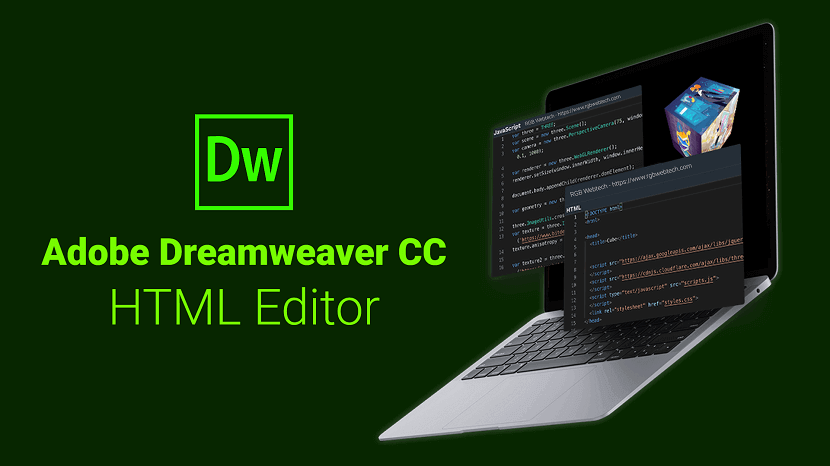
Adobe Dreamweaver is a proprietary web development tool from Adobe Inc. It was created by Macromedia in 1997 and developed by them until Macromedia was acquired by Adobe Systems in 2005.
Adobe Dreamweaver is available for the macOS and Windows operating systems.
Following Adobe's acquisition of the Macromedia product suite, releases of Dreamweaver subsequent to version 8.0 have been more compliant with W3C standards. Recent versions have improved support for Web technologies such as CSS, JavaScript, and various server-side scripting languages and frameworks including ASP (ASP JavaScript, ASP VBScript, ASP.NET C#, ASP.NET VB), ColdFusion, Scriptlet, and PHP.
Highlights:
- Alexa Rank - 53
- Developer(s) - Adobe Inc. (2005–present)
- Macromedia - (before 2005)
- Initial release - December 1997; 22 years ago
- Stable release - 2020 (20.1) / February 2020; 5 months ago
- Written in - C++
- Operating system - Windows 10 version 1703 and above, macOS 10.12 Sierra and above
- Type - HTML editor, programming tool, integrated development environment (IDE)
- License - Trialware software as a service
- Website - https://www.adobe.com/products/dreamweaver.html
2. Visual Studio Code HTML Editor
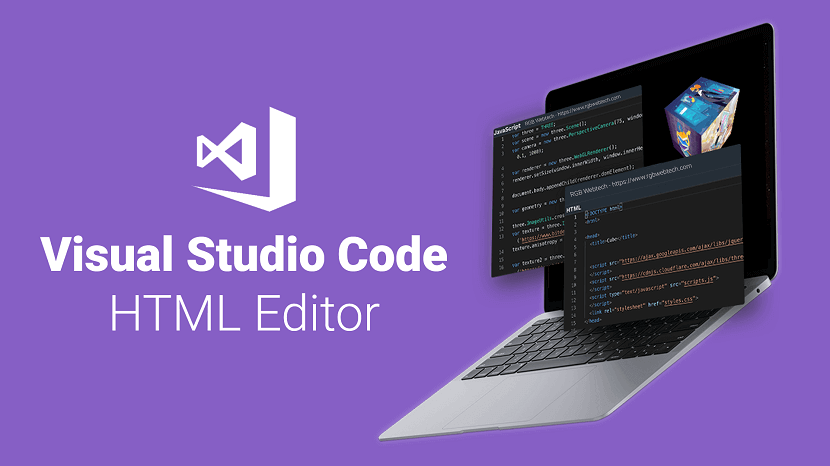
Visual Studio Code is a free source-code editor made by Microsoft for Windows, Linux and macOS. Features include support for debugging, syntax highlighting, intelligent code completion, snippets, code refactoring, and embedded Git. Users can change the theme, keyboard shortcuts, preferences, and install extensions that add additional functionality.
Visual Studio Code's source code comes from Microsoft's free and open-source software VSCode project released under the permissive Expat License, but the compiled binaries are freeware for any use.
Highlights:
- Alexa Rank - 973
- Developer(s) - Microsoft
- Initial release - April 29, 2015
- Stable release - July 23, 2020
- Written in - TypeScript, JavaScript, CSS
- Operating system - Windows 7 or later, OS X 10.9 or later, Linux
- Type - Source code editor, debugger
- License - Source code for Expat License & Binaries for Freeware
- Website - https://code.visualstudio.com
3. Notepad++ HTML Editor

Notepad++ is a free HTML editor that was developed for Windows-based machines. Linux users can also use it via Wine. This editor is distributed as free software and its repository is also available in GitHub. Like other community projects, third-party plugins are supported.
Notepad++ distinguishes its development environment for its simplicity. Notepad++ is super lightweight; there’s even a mobile version if you fancy it. Here are some highlights:
Highlights:
- Alexa Rank - 5991
- Developer(s) - Don Ho
- Initial release - 24 November 2003
- Stable release - July 16, 2020
- Written in - C++
- Operating system - Microsoft Windows
- Type - Source Code Editor
- License - GPLv2
- Website - https://notepad-plus-plus.org/downloads/
4. Bubble WYSIWYG Editor

Bubble is ideal for creating and launching fully-functional web applications in a fraction of the time it would take to build them from scratch. Its robust point-and-click editor allows you to build and customize your web applications and workflows — whether they’re simple prototypes, sophisticated SaaS products, or entire marketplaces.
Bubble has a user-friendly interface that makes building and customizing applications simple for those who aren't tech savvy. Users can also choose to incorporate logic into workflow programs so they are under specific conditions.
Lastly, Bubble integrates readily with any service that displays the REST API. These integrations include Facebook, Google Analytics, SQL, and many payments applications.
Highlights:
- Alexa Rank - 7,745
- Developer(s) - Bubble Group
- Website - https://bubble.io/
5. Sublime Text HTML Editor
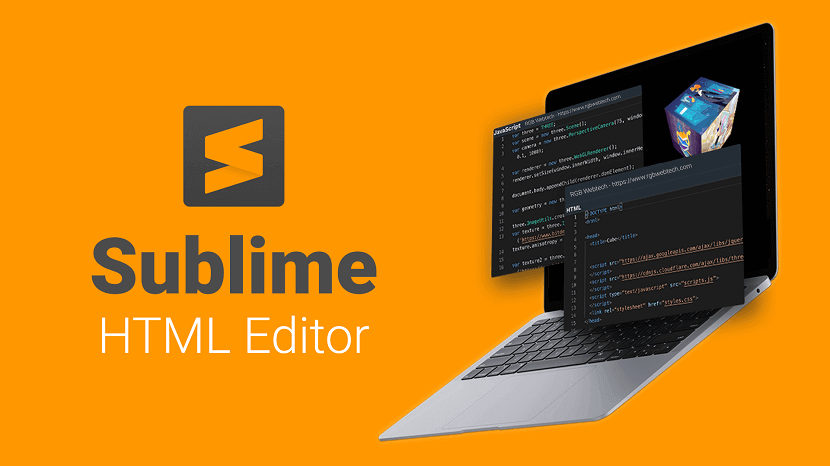
Sublime is another excellent free HTML editor. Developed by a Sydney-based company, this software falls under the category of freemium. Freemium means that you can use Sublime for free, but you have to buy a license to enjoy the full features.
Sublime offers great support to ensure that the program is constantly updated. Users can add plugins made by the community or build their own. We think using the free version of Sublime is more than adequate. However, if you feel like you need more features, you can get the license at a later point.
Highlights:
- Alexa Rank - 8559
- Developer(s) - Jon Skinner
- Initial release - January 18, 2008
- Stable release - October 1, 2019
- Written in - C++, Python
- Operating system - Linux 32/64-bit, macOS 10.6 or later (version 2), 10.7 or later (version 3), Microsoft Windows 32/64-bit
- License - Proprietary
- Website - https://www.sublimetext.com
6. Atom HTML Editor

Atom is an HTML editor that came out in 2014 and gained tremendous momentum since. Atom is a free, open-source code editor, and it was developed by the GitHub team. Atom uses a free software license for its package and it is maintained by the GitHub community. It aims to offer a premium feel to the editor while keeping it completely free. As well as the flexibility to customize the software itself.
As for the tagline, they boast as a hackable text editor for the 21st century. It means that developers can contribute to edit, extend, change, and share the program source code as well as create their packages to improve Atom.
Highlights:
- Alexa Rank - 9586
- Developer(s) - GitHub (subsidiary of Microsoft)
- Initial release - 26 February 2014
- Stable release - 14 July 2020
- Written in - Electron (back-end), CoffeeScript / JavaScript / Less / HTML (front-end/UI)
- Operating system - macOS 10.9 or later, Windows 7 and later, and Linux
- Type - Source code editor
- License - Binaries for Freeware and Source code for MIT License (free software)
- Website - https://atom.io
7. CKEditor WYSIWYG Editor

CKEditor is a browser-based rich text editor. It's extensible with a plugin-based architecture that makes it possible to bring necessary content processing features to the web.
On the market for almost 15 years, CKEditor earns its place on this list because of its tenure as one of the most reputable editors with wide-ranging features and legacy software compatibility.
According to users, ease of setup is one of its best qualities. CKEditor’s other benefits include fast loading (which saves development time) and the ability to modify projects on the fly without manually editing and uploading them to your server.
Highlights:
- Alexa Rank - 10,670
- Developer(s) - CKSource
- Stable release CKEditor 4 - July 17, 2020
- Stable release CKEditor 5 - July 24, 2020
- Written in - JavaScript
- Type - HTML editor, online rich-text editor
- Website - https://ckeditor.com/
8. TinyMCE WYSIWYG Editor

TinyMCE is the rich text editor behind many products including Evernote, Atlassian, and Medium.
According to its developers, the goal of TinyMCE is to help other developers build beautiful web content solutions. It's easy to integrate and can be deployed in cloud-based, self-hosted, or hybrid environments. The setup makes it possible to incorporate frameworks such as Angular, React, and Vue.
TinyMCE gives you full control of your design with functions for creating and editing tables, establishing font families, searching and replacing fonts, and changing font size.
Highlights:
- Alexa Rank - 14,686
- Developer(s) - Tiny Technologies Inc.
- Stable release - July 2, 2019
- Written in - JavaScript
- Operating system - Cross-platform
- Type - HTML editor
- License - LGPL
- Website - www.tiny.cloud
9. NetBeans HTML Editor
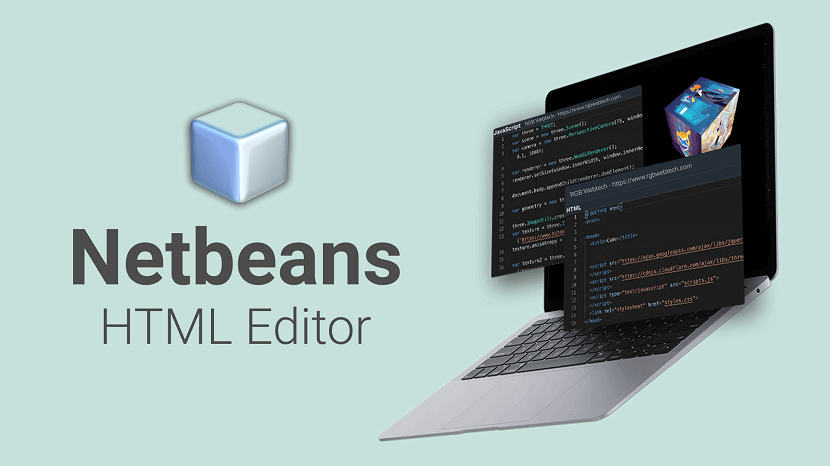
NetBeans is an integrated development environment (IDE) for Java. NetBeans allows applications to be developed from a set of modular software components called modules. NetBeans runs on Windows, macOS, Linux and Solaris. In addition to Java development, it has extensions for other languages like PHP, C, C++, HTML5, and JavaScript. Applications based on NetBeans, including the NetBeans IDE, can be extended by third party developers.
Highlights:
- Alexa Rank - 21,764
- Developer(s) - Apache Software Foundation Oracle Corporation
- Stable release - June 4, 2020
- Written in - Java
- Operating system - Windows, macOS, Linux, Solaris; feature-limited OS independent version available
- Type - IDE
- License - Apache License 2.0 (previously CDDL or GPLv2 with classpath exception)
- Website -https://netbeans.org/
10. Komodo Edit HTML Editor

Komodo Edit is a great editor if you’re looking for something powerful, yet simple. It is a free and fast HTML editor for numerous platforms such as macOS X, Windows, and Linux. It supports multiple languages such as HTML5, PHP, Perl, Ruby on Rails, Python, CSS3, JavaScript. It offers syntax highlight and code coloring options.
Highlights:
- Alexa Rank - 22,933
- Developer(s) - ActiveState
- Initial release - November 2007
- Stable release - June 21, 2018
- Written in - C++, C, XUL, Perl, Python, JavaScript, Tcl
- Operating system - macOS X, Windows, and Linux
- Type - Text editor, IDE
- License - Mozilla Public License 1.1
- Website - https://www.activestate.com/products/komodo-edit/
11. Froala WYSIWYG Editor

Froala is a lightweight WYSIWYG HTML editor written in JavaScript with built-in rich text capabilities and rapid extension. It has a clean design and is known to be easy to set up. The learning curve to master the use of this tool isn't steep, making it appealing to users who want to start working on their projects quickly.
Among development teams, Froala is a top pick because of its unique, real-time collaborative editing feature. Thanks to detailed documentation, powerful framework plugins, and many examples, Froala seamlessly integrates with existing technological infrastructure.
Also, the rich text editor — which initializes in 40 milliseconds — provides a great editing experience on any application.
Highlights:
- Alexa Rank - 29,854
- Developer(s) - Froala Labs
- Stable release - January 13, 2020
- Written in - JavaScript
- Type - HTML editor, online rich-text editor
- License - 3 licenses: Basic License (up to 3 domains), Pro License (unlimited domains), and Enterprise License (unlimited domains).
- Website - https://froala.com/
12. Brackets HTML Editor

Brackets is a source code editor with a primary focus on web development. Created by Adobe Systems, it is free and open-source software licensed under the MIT License, and is currently maintained on GitHub by Adobe and other open-source developers. It is written in JavaScript, HTML and CSS. Brackets is cross-platform, available for macOS, Windows, and most Linux distributions. The main purpose of Brackets is its live HTML, CSS and JavaScript editing functionality.
Highlights:
- Alexa Rank - 38,659
- Developer(s) - Adobe Systems
- Initial release - 4 November 2014
- Stable release - April 5, 2020
- Written in - JavaScript, HTML, CSS
- Operating system - macOS, Windows and Linux
- Type - Source code editor
- License - MIT License
- Website - http://brackets.io/
13. CoffeeCup HTML Editor

CoffeeCup Software is an American computer software development company based in Atlanta, Georgia, United States founded in 1996. The name comes from the company's origins in an internet cafe owned by its founder.
The company currently creates software applications for creating, designing, and editing responsive websites and a number of online services for webmasters. The company's third product, CoffeeCup Direct FTP, was the first FTP program to incorporate text editing functionality directly into the interface in a "split screen" fashion.
Highlights:
- Alexa Rank - 46,438
- Developer(s) - CoffeeCup Software
- Initial release - August 1996
- Stable release - June 5, 2012
- Operating system - Windows XP, Windows Vista, Windows 7
- Type - HTML editor
- License - Freemium trialware
- Website - https://www.coffeecup.com/
14. Editor.js WYSIWYG Editor

Editor.js is an open-source editor. It allows you to edit blocks of content that you can move around and reorder (it works in a similar way to WordPress's Gutenberg editor). When you click on a block, it shows the specific options available for that particular block. Similarly, when clicking on text content, options for text formatting and inline styles appear.
Editor.js is designed to be extensible and pluggable, thanks to its Application Programming Interface (API). It also returns clean data in the JSON output format.
Highlights:
- Alexa Rank - 86,163
- Developer - Editor.js
- Operating system - Windows
- Type - HTML Editor
- Website - https://editorjs.io/
15. Phase 5 HTML Editor

Phase 5 is an impressive German HTML editor. It is freeware but only for Schools and Home users. If you run a big organization or a Company then you are required to buy the license key to run the program. Phase 5 is compatible with Windows only. Phase 5 HTML editors support different languages such as HTML, PHP, Java, JavaScript, Pearl, and VBScript. It has a crisp and clear Menu arrangement. Integrated file management makes the switching between different documents easy. Phase 5 has a tidy interface to work with.
Highlights:
- Alexa Rank - 3,534,141
- Developer(s) - Ulli Meybohm
- Operating system - Windows
- License - Freeware
- Website - https://www.phase5.info/
16. Kompozer WYSIWYG Editor

KompoZer is a discontinued open source WYSIWYG HTML editor based on the Nvu editor, which was itself derived from the composer component of the Mozilla Application Suite. KompoZer was forked as a community-driven project with development coordinated through Sourceforge.
KompoZer's WYSIWYG editing capabilities are one of the main attractions of the software. In addition, KompoZer allows direct code editing as well as a split code-graphic view.
Highlights:
- Developer(s) - Fabien Cazenave
- Initial release - 30 August 2007
- Stable release - 11 March 2010
- Type - HTML editor
- License - MPL/GPL/LGPL tri-license
- Website - https://sourceforge.net/projects/kompozer/
17. UltraEdit HTML Editor

UltraEdit is a commercial text editor for Microsoft Windows, Linux and OS X created in 1994 by the founder of IDM Computer Solutions Inc., Ian D. Mead. The editor contains tools for programmers, including macros, configurable syntax highlighting, code folding, file type conversions, project management, regular expressions for search-and-replace, a column-edit mode, remote editing of files via FTP, interfaces for APIs or command lines of choice, and more. Files can be browsed and edited in tabs, and it also supports Unicode and hex editing mode.
Highlights:
- Alexa Rank - 105,725
- Developer(s) - IDM Computer Solutions, Inc
- Operating system - Windows, Linux, macOS
- Type - Text editor
- License - Trialware
- Website - https://www.ultraedit.com/
18. BareBones Edit HTML Editor
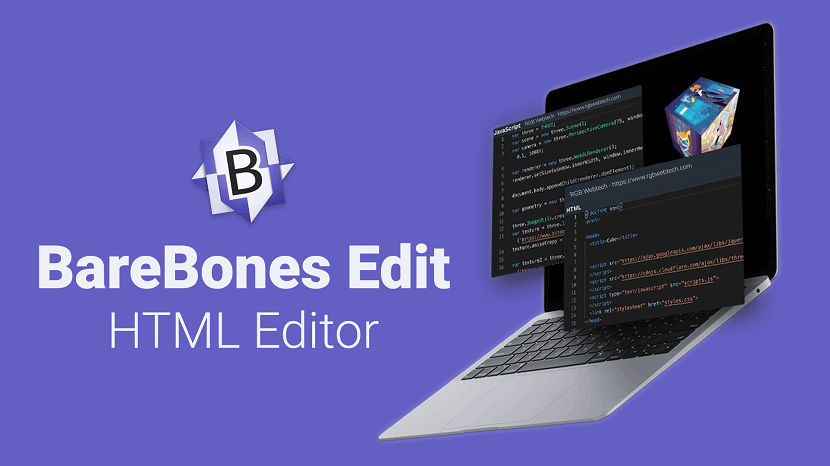
Bare Bones Edit Software is a private North Chelmsford, Massachusetts, United States software company developing software tools for the Apple Macintosh platform. The company developed the BBEdit text editor, marketed under the registered trademark "It doesn't suck", and has been mentioned as a "top-tier Mac developer" by Mac OS X journalist John Siracusa.
The company was founded in May 1993, and incorporated under the Commonwealth of Massachusetts in June 1994.
Highlights:
- Alexa Rank - 189,031
- Developer(s) - Bare Bones
- Operating system - macOS
- License - Freeware
- Website - http://www.barebones.com/
19. TextMate HTML Editor

TextMate for Mac brings Apple's approach to operating systems into the world of text editors. By bridging UNIX underpinnings and GUI, TextMate cherry-picks the best of both worlds to the benefit of expert scripters and novice users alike.
Whether you are a programmer or a designer, the production of code and markup is hard work. Without an editor dedicated to the task, it is also often cumbersome, overwhelming, and repetitive. Especially when you are dealing with a lot of files at once — like most projects do. The tool puts you back in control, reduces the mental overhead, and turns manual work into something the computer does.
Created by a closet UNIX geek who was lured to the Mac platform by its ease of use and elegance, TextMate for macOS has been referred to as the culmination of Emacs and macOS and has resulted in countless requests for both a Windows and Linux port, but the app remains exclusive for the Mac, and that is how we like it!
TextMate for Mac is not an IDE but by using its powerful snippets, macros, and unique scoping system, it can often provide features that even a language specific IDE lacks. It has enough project management features to keep most users happy but is otherwise kept lightweight with a clean and minimalistic GUI.
Highlights:
- Alexa Rank - 207,506
- Developer(s) - Allan Odgaard (MacroMates), Ciarán Walsh
- Initial release - 5 October 2004
- Stable release - 28 December 2019
- Operating system - macOS
- Type - Source code editor
- Website - https://macromates.com/
20. Setka WYSIWYG Editor

Setka Editor is a content editing platform with a no-code WYSIWYG editor and a channel-agnostic framework. This allows remote teams of any size to collaborate on content design projects and implement decisions quickly.
Setka is designed to help development teams efficiently deliver delightful and engaging content experiences with their content layouts and strong support.
Highlights:
- Alexa Rank - 269,415
- Developer(s) - Setka
- Operating system - WYSIWYG
- Website - https://setka.io/
21. Aptana Studio HTML Editor
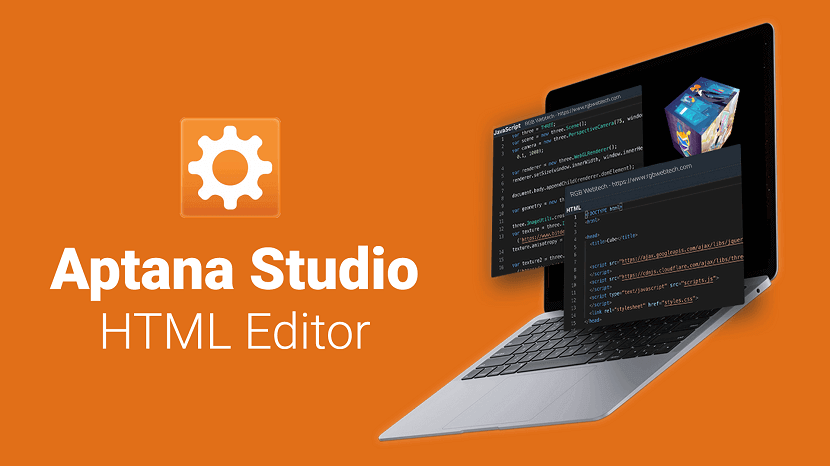
Aptana Studio is an open-source integrated development environment (IDE) for building web applications. Based on Eclipse, it supports JavaScript, HTML, DOM and CSS with code-completion, outlining, JavaScript debugging, error and warning notifications and integrated documentation. Additional plugins allow Aptana Studio to support Ruby on Rails, PHP, Python, Perl, Adobe AIR, Apple iPhone and Nokia WRT (Web Runtime). Aptana Studio is available as a standalone on Windows, Mac OS X and Linux, or as a plugin for Eclipse.
Highlights:
- Alexa Rank - 355,640
- Developer(s) - Aptana Inc.
- Stable release - November 19, 2014
- Written in - Java, JavaScript
- Operating system - Cross-platform
- Type - Web Development / IDE
- License - Dual License (Aptana Public License, v1.0, GNU General Public License)
- Website - http://www.aptana.com/
22. CotEditor HTML Editor

CotEditor is exactly made for macOS. It looks and behaves just as macOS applications should. It launches so quickly that you can write your text immediately when you want to. It is developed as an open-source project that allows anyone to contribute.
Highlights:
- Alexa Rank - 613,879
- Developer(s) - Mineko Imanishi
- Operating system - macOS
- Website - https://coteditor.com/
23. Bluefish HTML Editor

Bluefish is a powerful editor targeted towards programmers and web developers, with many options to write websites, scripts and programming code. Bluefish supports many programming and markup languages. See features for an extensive overview, take a look at the screenshots, or download it right away. Bluefish is an open source development project, released under the GNU GPL licence.
Bluefish is a multi-platform application that runs on most desktop operating systems including Linux, FreeBSD, MacOS-X, Windows, OpenBSD and Solaris.
Highlights:
- Alexa Rank - 617,644
- Developer(s) - Bluefish Dev Team
- Stable release - January 24, 2020
- Written in - C
- Operating system - Cross-platform (POSIX)
- Type - Text editor
- License - GPL
- Website - http://bluefish.openoffice.nl/index.html
24. NoteTab HTML Editor
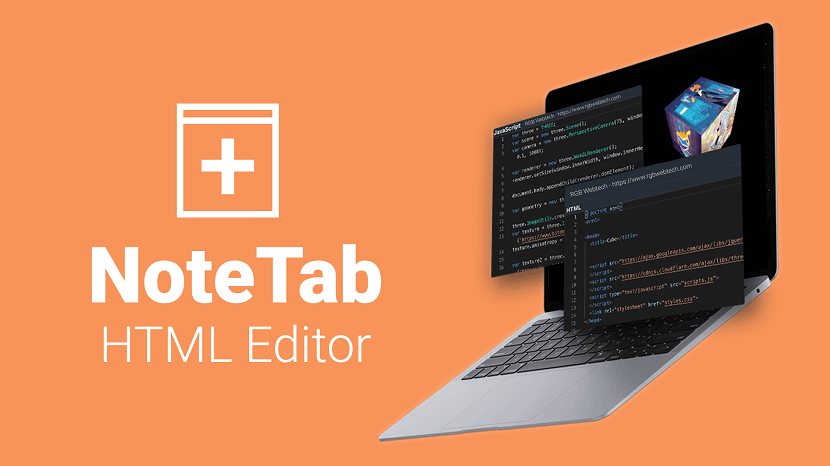
NoteTab is a freeware/commercial, multi-file, full-screen text editor for MS Windows. It was developed by Eric Fookes of Fookes Software, Switzerland. The program's name refers to the fact that it was one of the earliest text-editors to use a Tabbed Document Interface.
Highlights:
- Alexa Rank - 1,055,075
- Developer(s) - Eric Fookes
- Stable release - 4 November 2014
- Operating system - Windows
- Type - Text editor
- License - freeware/commercial depending on version
- Website - https://www.notetab.com/
Conclusion:
Getting a helping hand to write code faster and more efficiently is becoming a must, now more than ever. Whether you just started coding or you’re a seasoned vet, we believe that an HTML editor can become anyone’s best friend. Features aside, picking the best HTML editor that suits you might be hard. We encourage you to experiment with different editors and choose one that fits your style and workflow best.
We would also note that unless you need 24/7 support and manage code for a huge company, you will probably be fine with a free editor.
If you want to explore more about Text Editor or WYSIWYG Editor, We recommend you to go through our detailed article of HTML Editors.
If you found this article helpful, we encourage you to share it on your social media platforms—because sharing is caring! For more information about article submissions on our website, feel free to reach out to us via email.
Send an emailWritten by RGB Web Tech
Latest Technology Trends
Latest technology trends shaping the future, including AI advancements, blockchain innovation, 5G connectivity, IoT integration, and sustainable tech solutions. Explore breakthroughs in quantum computing, cybersecurity, augmented reality, and edge computing. Stay ahead with insights into transformative technologies driving innovation across industries and revolutionizing how we live, work, and connect.
40+ Best Website Monitoring Tools
Last updated on January 19, 2025 by RGB Web Tech
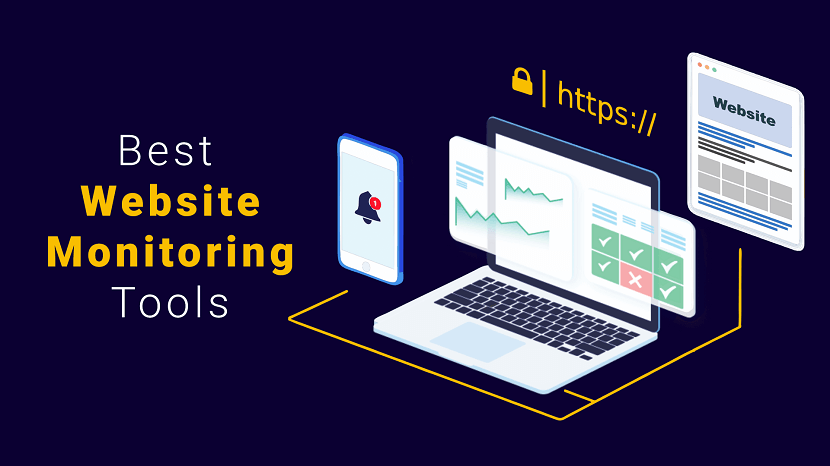
Website monitoring is the process of testing and verifying that end-users can interact with a website or web application as expected. Website monitoring is often used by businesses to ensure website uptime, performance, and functionality is as expected.
The website’s availability is a critical part of a business; we can’t stare at the monitor all the time.
Setting up a command center and monitoring team is feasible for a large organization to monitor their web applications uptime but not for small-medium businesses, non-profit organizations, or personal bloggers. Your website can go down for various reasons, including database down or hack.
Another common reason for website down can be a hosting provider, and that’s why you should always host your site with a reliable hosting provider. Any website owner or administrator needs to ensure proper alerting is in place, so you get notified when the website is not available.
I’ve listed the following tools, which will help you get notified in case your web URL goes down. Most of them offer a FREE plan, so pick the one you like.
However, if you are looking for an in-house solution, then you can try a PHP Server Monitor open source.
1. Datadog
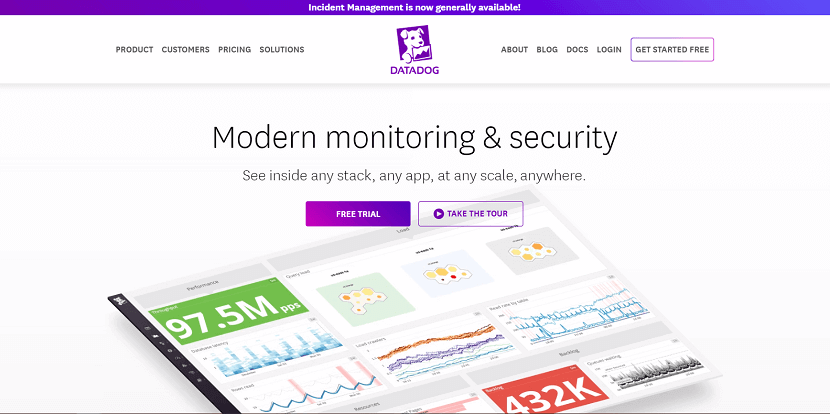
Datadog lets you proactively monitor your API endpoints and send alerts based on predefined parameters. You’ll be able to break down network timings that will eventually help you get to the root cause of your issues faster.
You can incorporate Datadog tests straight in your CI pipeline to ensure early problem detection allowing you to evaluate the state of your production environment after each deployment and minimize downtime by eliminating errors before your users ever see them.
All your critical transactions can be monitored with Datadog Synthetics without writing a single line of code with the web recorder. En user screenshots and step-by-step waterfall visualizations are paired with an intelligent system that identifies elements even after you make changes to the UI which results in a lot fewer broken tests.
Key features:
- Performs uptime and response time monitoring from several locations around the world.
- Enables user-journey modeling to check for load errors, programming mistakes, and poor website design.
- Enables website tests to be compiled through browser recording.
- Uses AI methods to vary user journeys during test runs.
- Tests are run through actual browsers for real-life user experience modeling.
2. New Relic
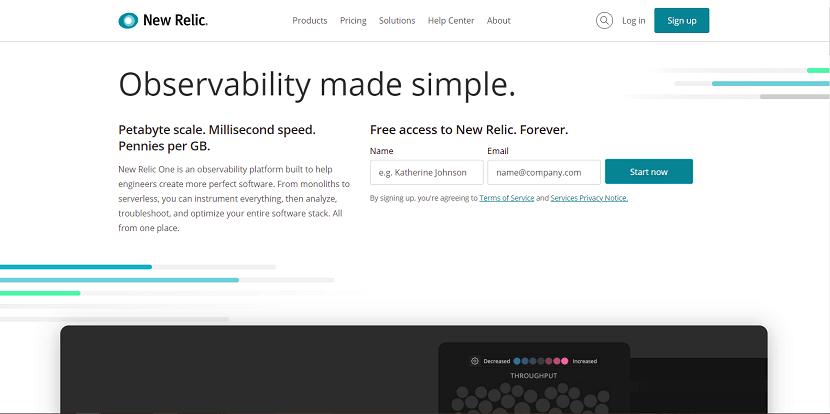
New Relic is a cloud-based software that helps users to track their website and application performances. Their technology is delivered in a software as a service (SaaS) model. The company is mostly known for its application performance monitoring (APM) abilities, but it also offers other services like infrastructure, browser, and synthetics monitoring, which you can combine with APM.
New Relic is a strong monitoring tool, but it can be difficult to navigate between different services and how they work together, especially compared to other monitoring companies like StatusCake or Montastic. However, you can check out and try their services for free for 14 days without any commitment.
Key features:
- Full Support for Google’s Core Web Vitals
- Custom dashboards
- Advanced alerting systems
- Integration with your favorite ticketing system
3. SolarWinds
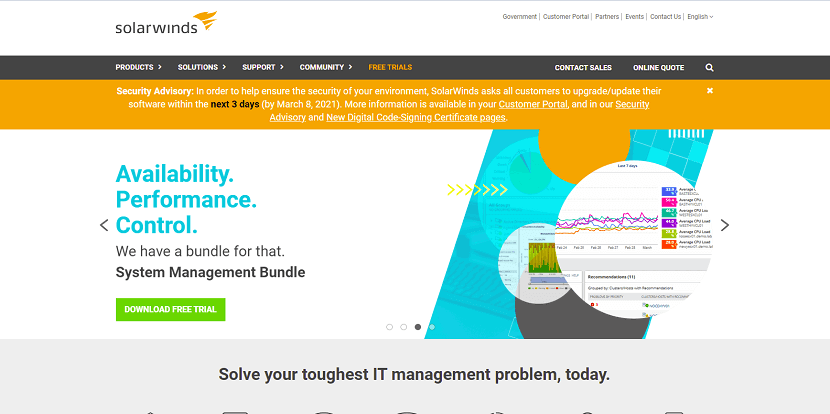
SolarWinds has been at the forefront of the monitoring space for years and in this time they’ve developed a large number of services to help their customers better understand what’s going on behind the curtains but that experience comes at a great(er) cost.
Web performance monitoring is just part of their impressive software ecosystem, and as it stands today, is one of the most complete solutions for DevOps in the world. While nobody can deny their experience or the value that their app brings to customers, the price tag can still be a tough pill to swallow, especially when you look at smaller competitors that charge a fraction of the price for, what it seems, a very similar product.
Their Web performance monitoring tool offers detailed load-time metrics from multiple locations across the world that record all browser-based transactions while providing key insights into what happens under the hood of your website.
Key features:
- Pre Configured alerts and dashboards that speed up the setup process.
- Synthetic monitoring solutions
- A neat mobile application is available for free
4. Uptime Robot
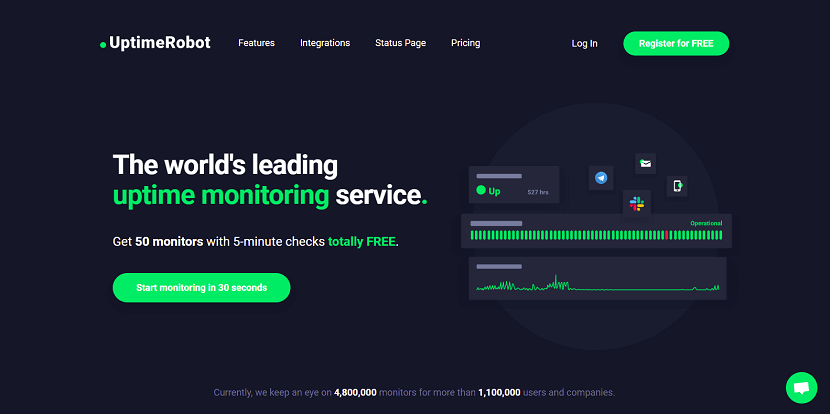
Uptime Robot is a good tool available at no cost to you, even though some users complain about the limited features, such as no manual alert testing. You also won’t get page speed insights like with some paid website monitoring tools.
Key features:
- Advanced notifications will let you set certain prerequisites for your alerts. Eg: x errors in y minutes
- Simple setup process
- Heartbeat monitoring for intranet and cron jobs
- SMS and email notifications are available
5. Freshping
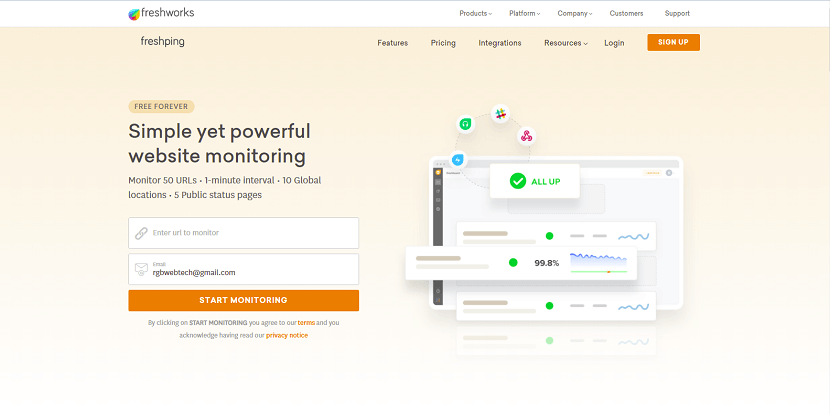
Freshping by Freshworks lets you monitor 50 URLs from 10 locations worldwide with one minute of internal in FREE.
Key features.
- Multi-channel notification
- Status page to announce real-time incident status to your users and customers
- Multi-user login
- Integrate with other services like Slack, Twilio, Freshdesk, Zaiper, etc. to get notified
Under the FREE plan, monitoring data is available for six months.
6. Pingdom
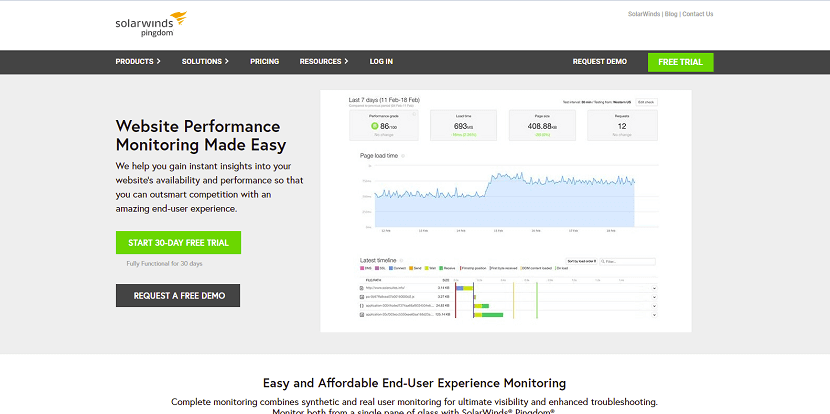
There are more options for choosing your monitoring frequency (up to 30,000 uptime checks) for more expensive pricing. Pingdom also offers an Enterprise plan which offers from 500,000 to 5 million pageviews a month. Moreover, there is a 30-day trial to check out their services.
If people can’t access your website at certain points throughout the day, then you’re losing sales and search engine rankings. Unfortunately, you can’t manually monitor your site’s uptime at all hours, and that’s where Pingdom’s tools come in handy.
Although Pingdom offers some free tools, such as a website speed test, where it shines is in its premium features. Pingdom can help you analyze your website’s uptime and performance by testing your site from servers across the world and alerting you if there’s an issue.
Pingdom also helps you improve user experience by delivering feedback from real users and analyzing performance factors such as website speed. They’ll also help you pinpoint any causes of problems to help you resolve them quickly.
Overall, it’s a powerful, reliable tool for smaller businesses on a budget, but some users complain that it puts little emphasis on mobile traffic, has unreliable SMS capabilities, and lacks monitoring servers in Asia-Pacific. We also use Pingdom to monitor the best hosting providers.
Key features:
- Detailed interfaces with user-friendly features
- Instantaneous alerting system
- Real user monitoring and synthetic monitoring
- The mobile application makes up for the somewhat complicated setup
- SMS and email notifications are available
7. Site24x7
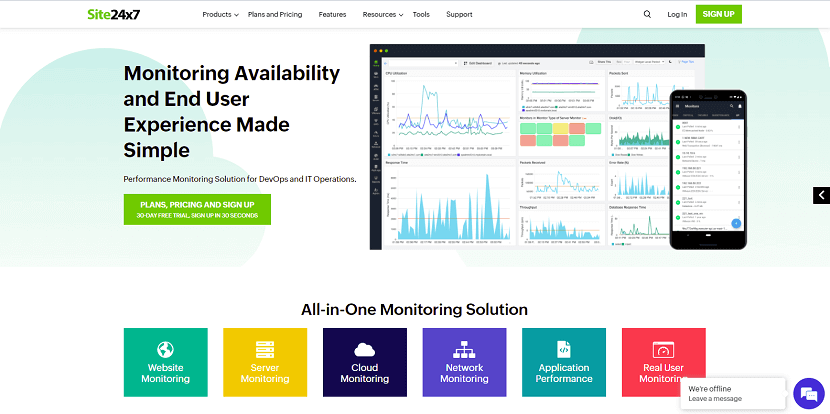
Site24x7 is a U.S.-based company, founded in 2006. The company provides performance monitoring solutions targeted at DevOps and IT professionals. You can use the service to monitor your websites, APIs, servers, and much more.
Key features:
- Performance monitoring: Comprehensive performance monitoring from 90 global locations, checking internet services, internal network performance, web page components, and more.
- Real User Monitoring (RUM): Real-time tracking will tell you everything you need to know about your users’ experience on your site. Detailed reports will allow you to analyze your visitors’ behavior and spot any pertinent issues.
- Public status pages: This feature allows you to notify your customers of any downtime. They are sure to appreciate your business transparency.
8. Uptrends
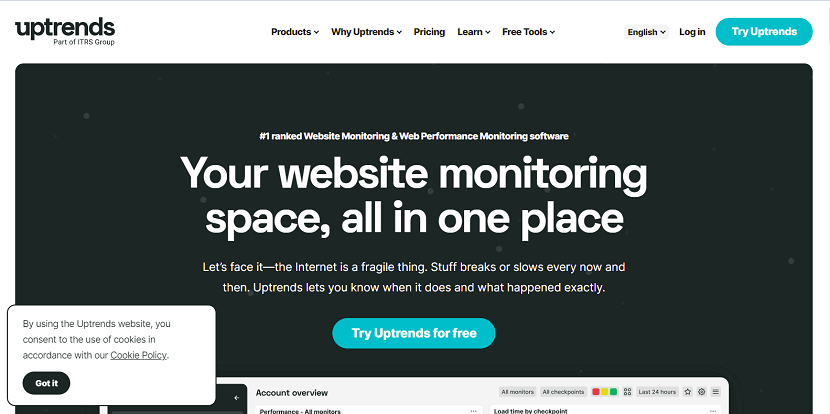
Founded in 2007, Uptrends provides a variety of monitoring services, from standard website monitoring to real user monitoring. The company’s impressive client list includes big names like Microsoft, HP, Virgin, and Zendesk.
While the paid plans offer an extensive list of advanced features, you can find several free tools on the company’s website, including a free-forever website monitoring tool that will monitor your site from locations all over the world.
The free version will send you an email alert whenever there’s a problem – but not before your site has been tested from two different checkpoints, to prevent false alarms. You also get detailed data reports which you can export to PDF or Excel.
Key features:
- Multi-browser monitoring: Uptrends offers “real browser monitoring,” which hits your website with the three major browsers to recreate your users’ experience. The Full Page Check feature hits every webpage and element on your website, and it’s got 200 worldwide checkpoints for true global performance monitoring.
- Private checkpoints: In addition to the company’s 200+ checkpoints around the world, you can also get your private checkpoint which can run behind your firewall and monitor your business’ intranet and internal applications.
- Transaction recorder: Record and monitor all transactions on your website and get detailed information on shopping processes, website functions, and load times. Analyze your results with a series of powerful tools.
9. Dynatrace
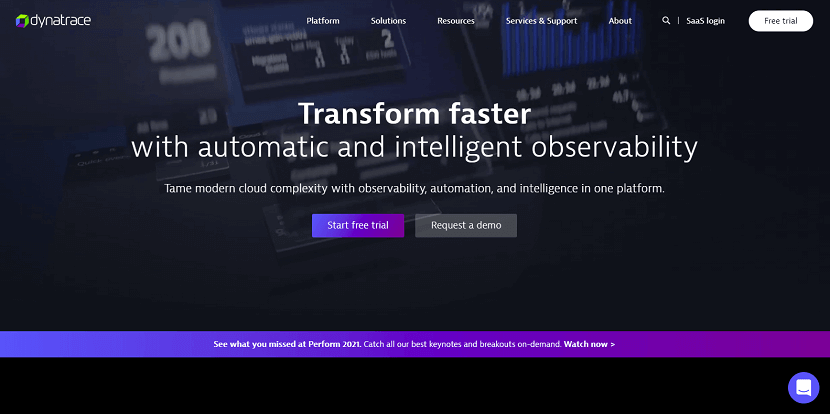
Dynatrace monitors the availability and performance of your internal resources with monitors from private elocution making it easy for you to understand how your users experience your website and apps by measuring and recording key metrics.
Dynatrace offers three types of synthetic monitors The first one is a single-URL browser monitor that acts as a simulated user visiting your app or website and can be configured to work from any of their available locations with a frequency of 5 or more minutes. The second one is Browser click paths that are similar to the single-URL act as a user but follow a path throughout your application. The third version is the HTTP monitor that is a simple HTTP request that can be customized and ran at various intervals.
Key features:
- Flexibility to utilize real-user monitoring, synthetic monitoring, and session replay
- Built with privacy and security in mind to meet your GDPR requirements
- Real-user monitoring for mobile, hybrid, and single-page applications with common analytics
10. Smartbear
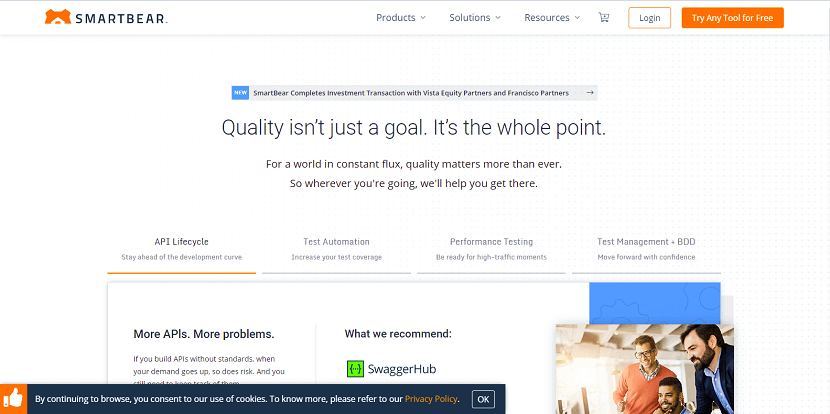
Smartbear is amongst the most comprehensive tools for large-scale enterprises that wish to monitor almost every aspect of their online presence. Besides keeping a very close eye on your web application through a wide variety of tools that range from run-of-the-mill uptime and alerting solutions to some innovative monitoring options, Smartbear also checks up on your mobile applications, API status, and database health.
Last but not least, Smartbear has an impressive 340 testing nodes around the world, which is at least double what most competitors have. Keep in mind that Smartbear does not have a real user monitoring product so if you are looking for that particular feature, you’ll have to look elsewhere.
Key features:
- Lots of third party integrations
- An extensive list of resources and support material
- Robust Reporting & Analytics
11. Host-tracker
Simple by design, Host-tracker is intended for site admins that want to monitor their servers’ availability as well as the transactions between server and client. It mainly focuses on key metrics like page errors, database connection problems, and network issues.
The pricing schema is simple enough, composed of three separate tiers, each with its own unique set of features and capabilities. It’s worth mentioning that at first glance the price for their basic tier seems high compared to the other products mentioned here but I believe that the packed features of the more expensive tiers make up for this.
One thing Host-tracker is missing compared to the other options listed in this list is the ability to monitor real users. It’s not a big deal if what you are trying to do is focus on the server’s resources but for websites that deal with a lot of users like online publications or e-commerce stores, RUM is going to be crucial to providing the best experience possible for your users.
There’s no free tier but every signup comes with a free, no credit card required, a 30-day trial where you can test all the features of the product, risk-free.
Key features:
- Performance monitoring: HostTracker breaks down its performance measurements into DNS lookup time, connect time, “first-byte” time, and download time. This enables a granular view that makes it easy to spot specific bottlenecks.
- Uptime monitoring: HostTracker’s “availability check” feature is similarly detailed and can be configured to check not only the website and server availability but also applications connected to your website as well as your database connections.
- Alerts: Highly customizable alerts via your choice of email, voice message, SMS, Skype, Google Hangouts, or Viber. You can also set conditions and assignments for alerts to ensure that each team member gets only the appropriate ones.
- Auto-pause Google Ads: HostTracker can automatically pause your AdWords campaign if your website is unavailable, and start it when the site is back up.
12. Versionista
Versionista is a simple yet powerful tool for monitoring web pages of static and dynamic websites. You can monitor web pages as well as documents like PDFs, like Visualping. What sets it apart is you can set filters to skip irrelevant content changes and manage and track changes in SEO to stay competitive in SERPs.
While creating a monitor, you can customize frequency, JavaScript support, proxy address, and more. What I like is it shows color code comparison to highlight changes and supports sending change alerts and detailed emails. Moreover, Versionista supports team collaboration, allowing admins to manage users and users to collaborate between them to support team projects.
Key features:
- It automatically crawls and monitors your website.
- This cloud-based tool provides summaries in email.
- You can collaborate with your organization team.
- Versionista manages the team's workflow.
- You can avoid irrelevant content using filters.
- It provides color-coded comparisons that show additions and deletions.
13. Distill
Distill is a featureful tool for monitoring web page changes. What makes it unique is its support for cloud as well as local monitors, unlike the above tools. Also, it supports automating steps like logging in, exporting data, using custom proxies, tracking changes in documents like PDF, and managing versions.
Key features:
- You can select items to track visually.
- It allows you to configure notification settings and account details from your single dashboard.
- You can see the version history.
- Track changes from any browser and you get updates on any device or channel.
- You can import or export data in CSV or JSON files.
- It allows you to track changes in PDFs.
- You can manage the version history of all changes.
14. Uptime
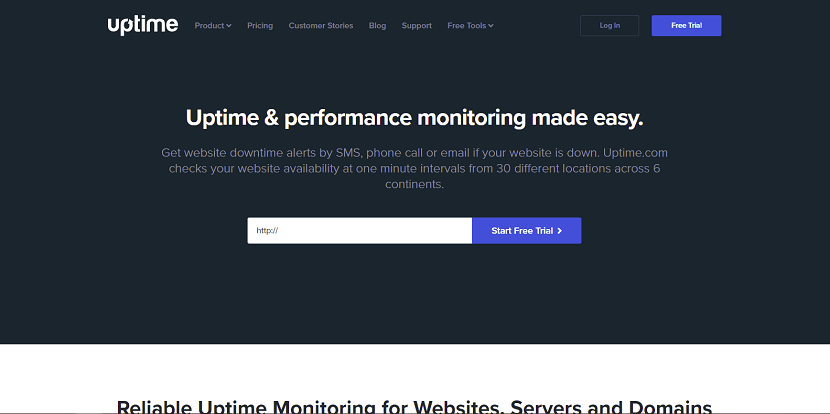
Featuring SSL monitoring, 24/7 support, malware scanning, and a large number of third-party integrations, Uptime is a great website monitoring tool that focuses on reliability and ease of use.
Uptime monitors your website availability at one-minute intervals across 6 continents. If anything goes wrong you’ll be notified via either SMS, phone call, email, or any number of custom integrations that they support.
Uptime has a RUM tool that helps you deliver the best user experience by tracking users across different devices, locations, and connection types. The data collected will be displayed in easy-to-understand dashboards that will provide actionable data on how to fix the performance issues of your site.
While there is no free tier, Uptime does offer you a risk-free, 21-day trial across all their packages that should give you a taste of everything it has to offer.
Key features:
- Simple to use UI
- Websites scanned with Google Safe Browsing & Yandex Safe Browsing.
- Detailed Uptime Reports
- Receive alerts via email, SMS, Twitter, web-hooks, or push notifications.
- Website uptime: Track uptime, response time, and performance from multiple locations worldwide.
- Server health: Detect bottlenecks before they arise.
- Network performance: Monitor multi-site networks, and receive notifications of any failures.
- Custom metrics: Customize your unique monitoring needs.
Monitis.com advertises that by using its service, you can improve uptime, eliminate hassles, optimize user experience, and grow your client base. Plus, it’s available in English, Portuguese, Spanish and German languages.
Overall, it’s a great tool packed with numerous features and you can try it out free for 15 days.
Key features:
- A mobile application is available
- Available in English, Portuguese, Spanish and German languages
- Simple granular control over how much you pay/mo
- 20% discount for annual payments
16. StatusCake
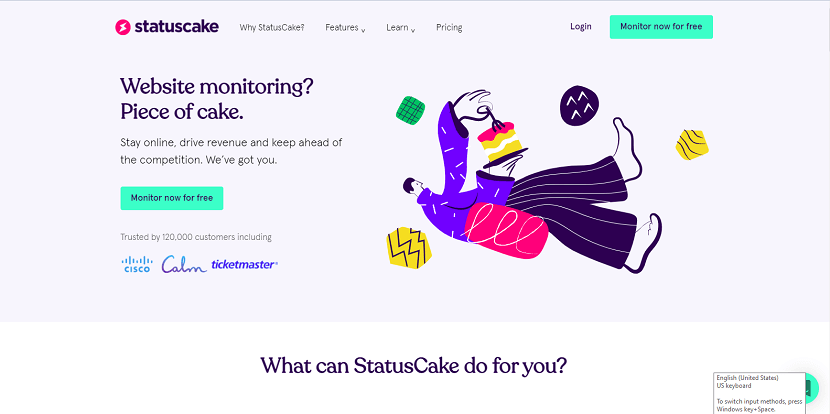
StatusCake also has a “Superior Plan” for 20.41$/mo and it includes 100 monitors with 15-minutes testing intervals. If you sign up with their paid plans yearly, you’ll get two months free (for life!).
You can sign up with their free plan (no credit card needed) and start testing your site’s uptime and speed immediately.
StatusCake will check on your site every 5 minutes and alerts you if there’s any downtime via email or integrations with a third-party app like Zapier. StatusCake also helps with root cause analysis, so you’ll know why the problem was caused. Moreover, with their free plan, you’ll get to test website page load time (1 test every 24 hours).
Key features:
- Page speed test (free plan includes 1 test every 24 hours)
- Global test locations (they have 48 locations in 28 countries)
- Domain monitoring (only with paid plans)
- Server monitoring (only with paid plans)
- SSL certificate monitoring (only with paid plans)
17. Sematext
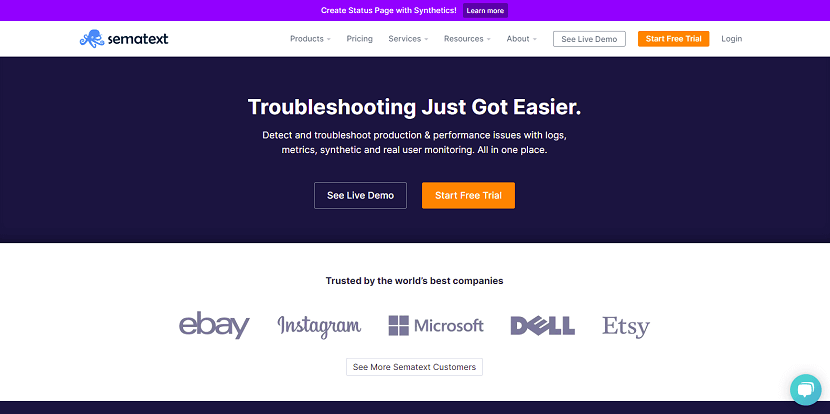
Sematext Cloud is an all-in-one log management and monitoring solution that provides end-to-end visibility and observability. When it comes to website monitoring, we offer Sematext Experience, our real user monitoring (RUM) solution, and Synthetics, our synthetic monitoring tool.
With the launch of Sematext Experience and Synthetics, Sematext became the go-to tool for developers looking to get insight into their infrastructure while still keeping an eye out on the user experience metrics.
With Sematext Experience, you’ll get a report on the experience and satisfaction of your users while providing key pieces of information as to how your website or application is performing in different locations, devices, or different connection speeds.
On the other side of the spectrum, you’ll be able to set up Synthetic Monitoring to create a complex system of monitors for all your resources in just a few clicks. The monitors will ping your resources from several locations all across the globe and report back stats like website speed, error rates, third APIs responses, SSL certificate expiry, and many other mission-critical metrics. You can even use it to benchmark against competitors and identify areas you should optimize to improve website performance.
Getting started with Sematext is quite easy and intuitive thanks to the simple setup wizard that every new user gets to see.
Every plan has a risk-free, 14-day trial that does not require any credit card to be added. We also offer granular control over what you pay for as every product is individually priced. This way you can pay only for the products and features he needs.
Key features:
- A unified location for all your logs, metrics, and events
- Identify resources & requests with the biggest negative impact on your website performance
- Real-time alerts and debugging solutions
- Support for all major frameworks
- Very well documented features
18. UPTIMIA
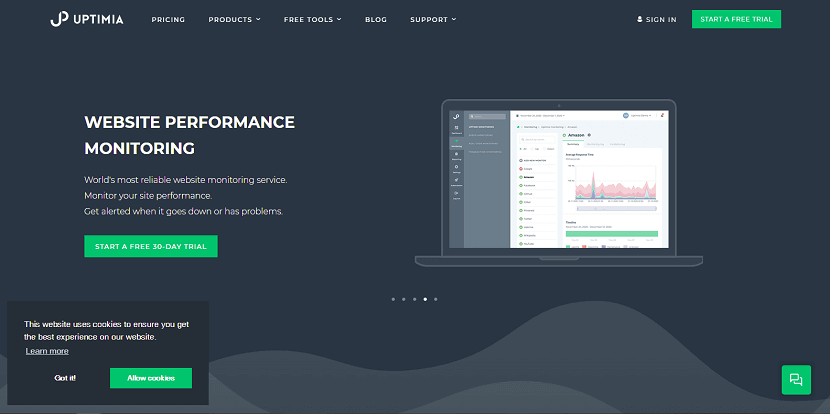
UPTIMIA is a relatively new player in the market, but it’s already shown impressive growth, landing clients such as Pepsi, Akami, and Nokia. The company offers monitoring services for small businesses and large enterprises, including uptime and speed monitoring as well as transaction monitoring and real user monitoring.
The company offers a free-forever plan which allows you to monitor one website in five-minute intervals. The free plan includes uptime monitoring only.
Key features:
- Uptime monitoring: Monitors your website from 170+ global locations at intervals as low as 30 seconds.
- Performance monitoring: Includes monitoring load times with real browsers as well as real user monitoring (RUM), which can measure your website’s performance according to individual visits.
- Custom-branded reports: You can use your company’s logo and color scheme for the daily reports, making Uptimia a good choice if you’re part of an agency managing websites for your clients.
19. Cronitor
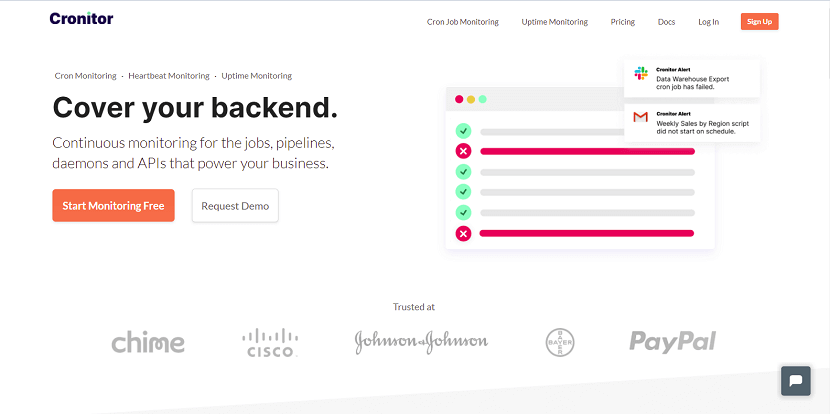
Cronitor is a modern uptime monitoring service with advanced features and a clean, approachable design that anybody can use. With 12 global monitoring locations and checks that run as frequently as every 30 seconds, you can trust you’ll be alerted quickly when your website or API is down.
Key features:
- Custom request headers, cookies, and more.
- Page content assertions.
- Real browser testing for JavaScript apps.
- Global monitoring with custom test locations.
- Instant alerts through Email, SMS, Slack, PagerDuty, OpsGenie, and more.
20. Checkly
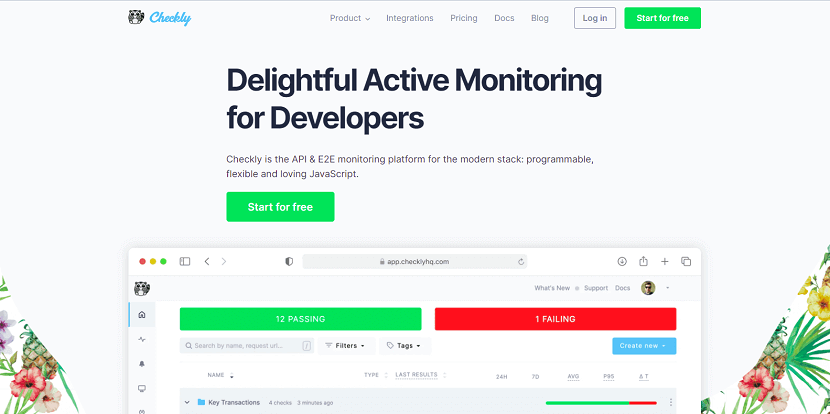
Checkly uses Puppeteer and Playwright frameworks to simulate users’ interactions with your website or application within a Chrome browser. While you can write the test scripts yourself, Checkly does offer a Headless Recorder browser extension to aid you. Once you’re done with the code you can run it every 10 minutes.
The alerting system is very versatile and allows you to get an alert whenever one or multiple parameters are met. The alert can go out to your Email, Slack, Pagerduty, or SMS.
Tests are run from one of six locations in America, eight locations in Europe and Africa, and six other locations from Asia. Getting feedback from different locations across the globe will paint a clearer picture of how your users are experiencing your website and allow you to make crucial decisions that improve performance.
Key features:
- CI/CD integration
- Screenshot for every transaction
- Tests are run from real browsers
- No coding needed
21. Better Uptime
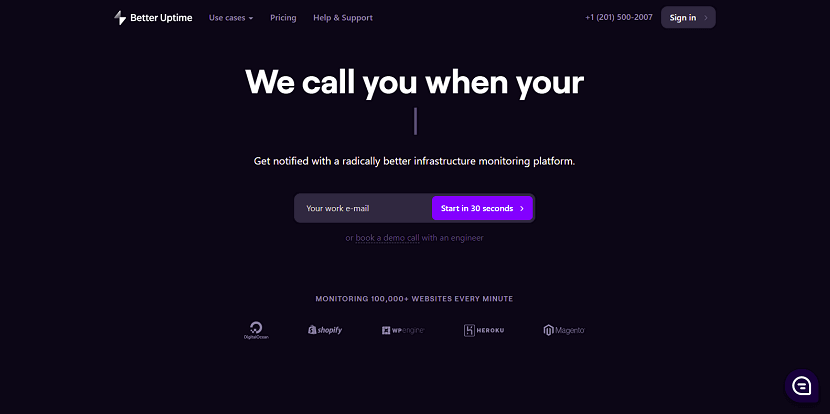
Better Uptime is a modern monitoring service that combines uptime monitoring, incident management, and status pages into a single beautifully designed product.
The setup takes 3 minutes and after that, you get a call whenever your website goes down.
Key features:
- Unlimited phone call alerts
- HTTP(s), Ping, SSL & TLD expiration, Cron jobs checks
- Easy on-call scheduling
- Screenshots & error logs of incidents
- Slack, Teams, Heroku, AWS, and 100+ other integrations
22. Calibreapp
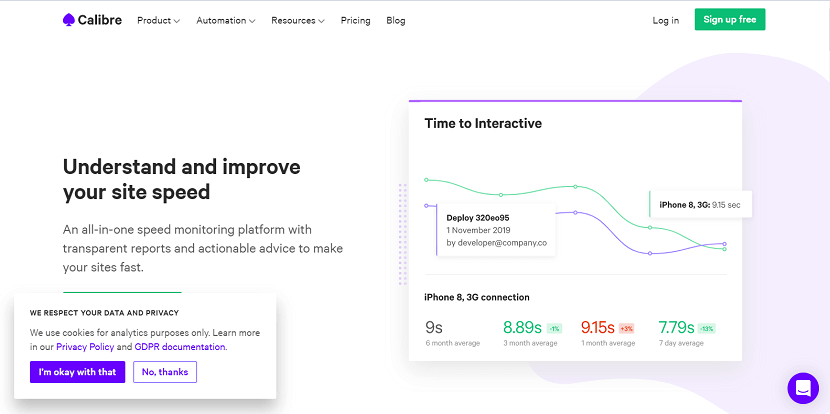
Calibreapp helps you deliver stellar experiences to your users regardless of their location, platform, or connection speed by simulating real-world conditions. It allows you to understand the impact of third-party code on your systems, automate tests for performance, and get notified the second your users experience an issue.
Calibreapp provides powerful performance reporting that provides a clear overview of your entire system allowing you to stay on top of any issues that might occur. The automatic insights reports that are being sent out save hours and hours of work that would be spent building traditional reports out of dashboards.
Key features:
- Core Web Vitals support
- Testing authenticated pages
- Google Lighthouse built-in
- Insights Email Report
23. Visualping
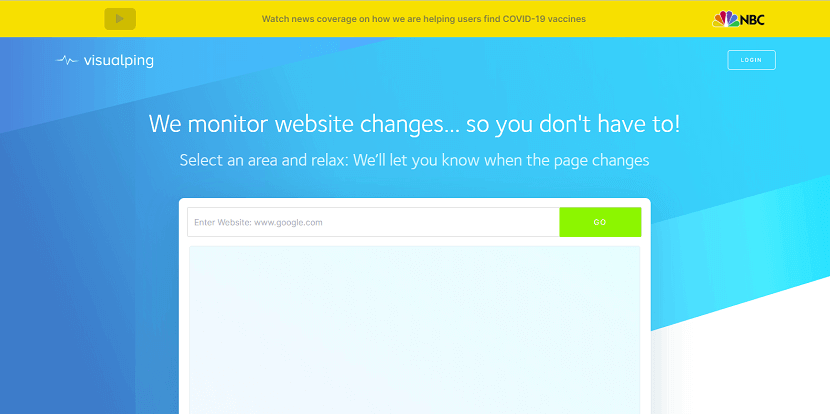
Visualping is among the best web page monitoring platforms available, which offers intuitive features fitted for both beginners as well as advanced users. What I liked the most about Visualping is it shows its monitoring form interface right on its homepage, allowing you to effortlessly start monitoring web pages.
Visualping claims it is used by more than 1.5 million users worldwide performing 5 billion checks. Its features include performing checks from every 5 minutes to every week, checking for documents like PDFs, choosing screen configurations, configuring proxy settings, and alert options. Also, these features are all packed under a clean and neat interface, making it super easy to monitor changes.
Key features:
- It offers access to public API as well as custom development work.
- You can review changes in images and basic account settings.
- Automatically alerts website users when any changes are made on the website.
- The browser extension allows you to monitor websites directly from the website.
- It provides intelligent alerts.
24. PageCrawl
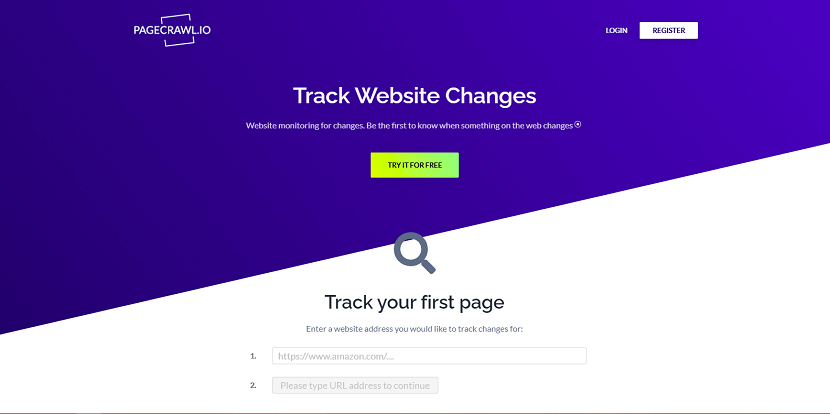
PageCrawl is another robust tool for monitoring web page changes. What I find interesting is PageCrawl.io supports tracking multiple elements on a page. You can share a tracked page with friends or team members, visualize results as charts, send notifications to email or Slack, export data, and do a lot more.
Key features:
- You can capture the full web page selected element image of your website.
- It provides proxy support to bypass IP bans.
- PageCrawl feature automatically updates tracked pages in Google Sheets.
- You can easily analyze changes in timeline charts.
- It enables you to share and track pages with your colleagues or friends.
- This application provides easy to use page element selector.
- You can export web page change to an excel spreadsheet.
25. Fluxguard
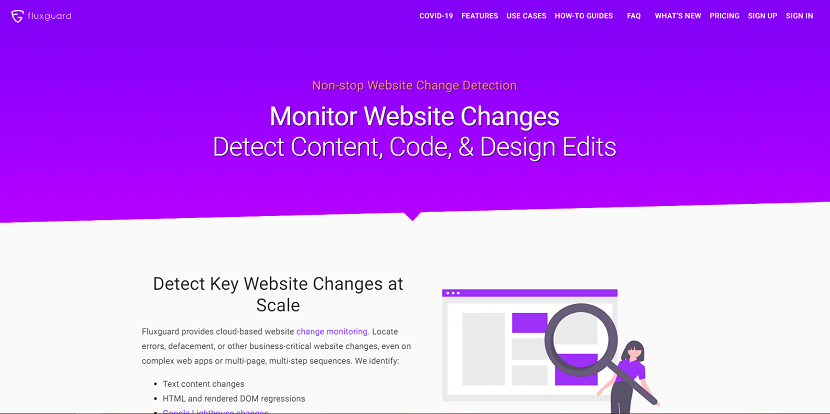
Fluxguard is another featureful tool for monitoring web page changes. One of its unique features is Google Lighthouse Audits, allowing you to check your site’s SEO. You can automate steps like submitting forms, add filters for alerts, use proxy networks, and receive alerts through Slack and webhooks.
Key features:
- It automates business-critical website change audits: from a single page to multiple steps.
- Multiple web change visualizations: visual, HTML, text, network, Google lighthouse.
- Fluxguard creates point-in-time archives of entire websites and their changes.
- It provides change reports via SMS, Webhooks, Email, API, and more.
- You can quickly toggle between screenshots, HTML code, and extracted text.
- Fluxguard captures all network activity, console logs, web storage, cookies, and more.
26. OnWebChange
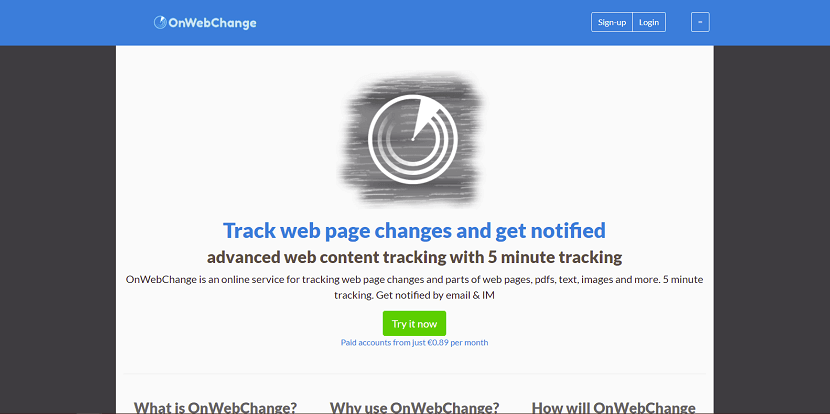
If you want to track exact information, OnWebChange can do it as simply as possible. Though it is not as powerful as Wachete some of its features even outstand the latter.
What got me stuck is its public tracker feature that lets you place a button on your site that helps your visitors track any page on your website.
Additionally, you use its ‘Change Report’ feature to share a public tracker with friends and coworkers and help you track changes conjointly. OnWebChange tracks change for various types of content like images, documents, PDFs, etc.
Another surprising feature is it creates an RSS feed to help you track the changes, unlike that of Wachete.
It allows three trackers for free and features multi-language support and a powerful change detection system with lots of customizable options. It can send mobile or email notifications in a single or digested form per your preference. Moreover, it sends emails to multiple persons, creates an email distribution list, and even notifies URL ‘Callback’, surprisingly.
Key features:
- Track changes to any plain text files and online files.
- It checks changes every 5 minutes, 24x7 hours, and 365 days.
- You do not require to download any files or browser plugins.
- Share notifications with family, customers, and friends.
- You can track changes to any specific part of the public web page.
- Track changes to online files (PDFs, images, etc.) and any plain text files.
- Receive notification directly to your mobile.
- This online tool allows you to filter out the content you want.
27. ChangeTower
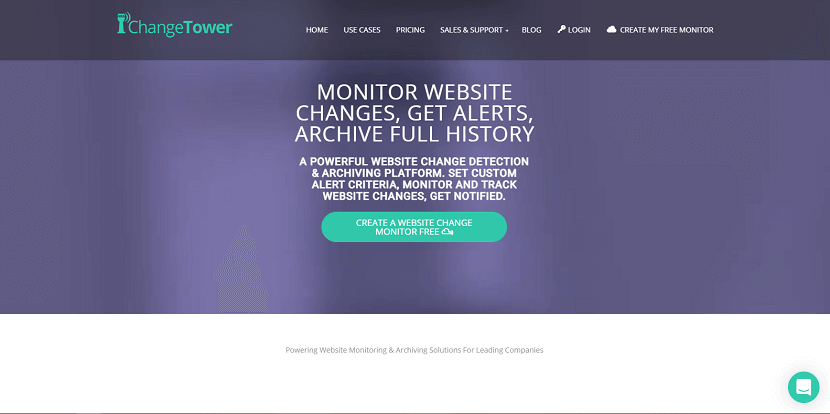
Using ChangeTower, you can monitor three addresses for free. It is a cloud-based, easily accessible tool that is capable of monitoring visual changes. You can track code updates, keywords and code changes, and visual changes made on a webpage.
What I like is that one can also check a site’s availability and receive alerts on configured conditions. ChangeTower can notify you, or your team using real-time email notifications and allows you to see notifications stream and check out detections.
Also, you can check the changed data of three months in for free, and even export it to a spreadsheet.
Another interesting feature is it sends you a detailed report of content, snapshot, and HTML changes, helping you to easily understand the changes.
Key features:
- It provides keyword alerts.
- This tool provides notification for only significant changes in keywords and phrases.
- It alerts when your website page goes down and comes back online.
- You can monitor HTML code.
- It allows you to store time-based code snapshots.
- Notify changes to the team via email.
28. Wachete
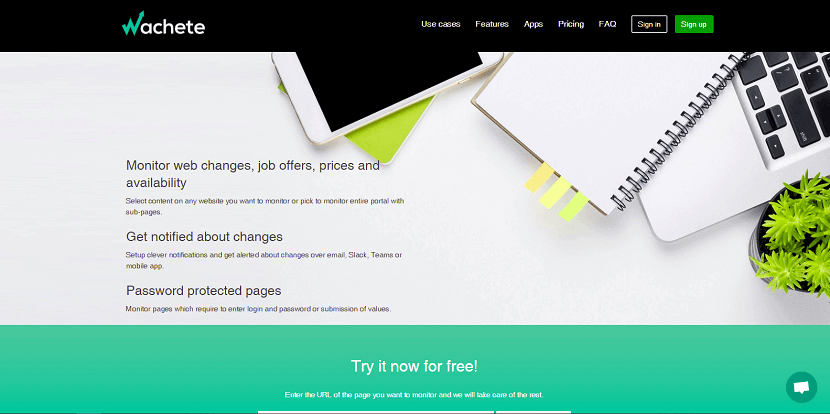
Wachete has a lot more to offer than other content monitoring tools on this list. What makes it stand out is its ability to monitor password-protected pages as well as dynamic and JavaScript pages.
Moreover, you can track changes on pages that require a click or an input and monitor configured pages from different locations and more.
It collects and stores web content along with change history for up to six months, allowing you to track old pages or changes when required.
You can freely monitor five pages, which suffices everyday users who wish to track product prices and job offers. You can also track the availability of a site, and download all the data as a spreadsheet.
What I like most is its set of REST APIs as well as its feature to create an RSS feed from the content of a page, like a feed of your wishlist products.
Key features:
- It helps you to monitor pages that are password protected.
- You can monitor web pages, including crawled subpages.
- Collect changes, web content, history up to 12 months.
- You can create an RSS feed from the content of any web page.
- Monitor updates of text in MS Word, PDF, XLSX file, JSON, and DOCX.
- It provides a REST infrastructure for 3rd party partners.
- You can monitor dynamic pages.
29. Sken
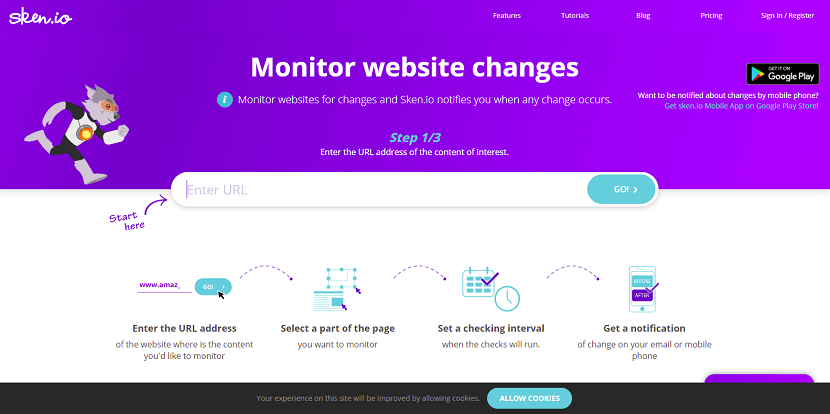
Sken is one of the robust platforms out there for monitoring changes. It boasts of offering a perfect rendering engine for web pages, allowing better change detection and webpage screenshots. It features a popup blocker, time scheduler, and a chart preview tool for visualizing changes visually.
Key features:
- With chroma extension, you can get change details in just a few clicks.
- Data stored in the cloud can be fully synchronized with chrome extension and mobile application.
- It provides a fully customizable scheduler to find change when you want.
- You can delete an element that hides or blocks your content.
- It shows a preview in the chart.
- Get notification in your mobile application.
30. DeepWebMonitor
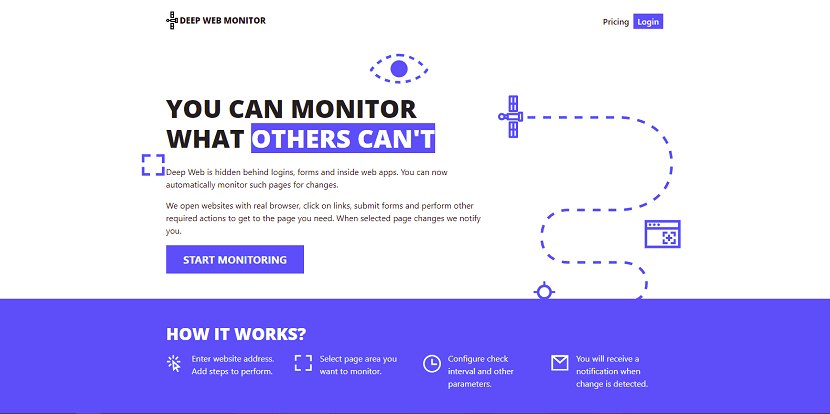
DeepWebMonitor is a web page change monitoring tool, which boasts of helping you to “monitor what others can’t“. Though it focuses on different terminology named deep web, it does similar to other tools. You can track changes, check at fixed intervals, receive notifications for detected changes, and more.
31. Trackly
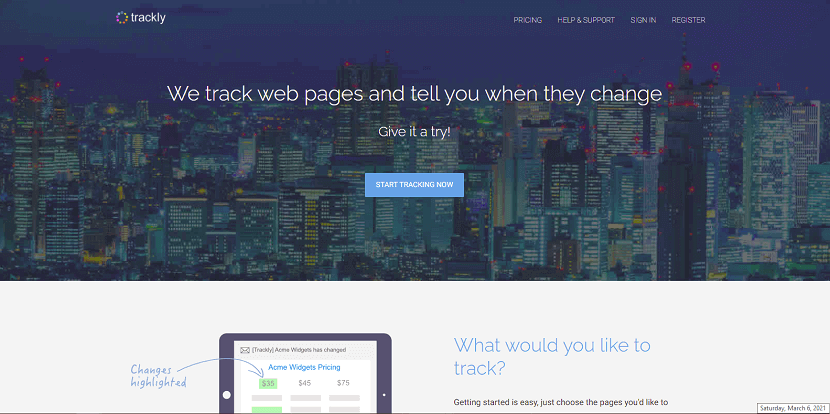
32. Pagescreen

33. WebSite-Watcher
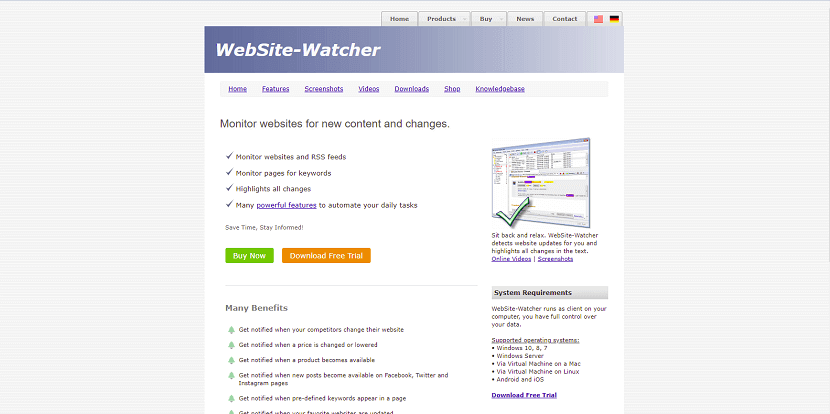
34. HetrixTools
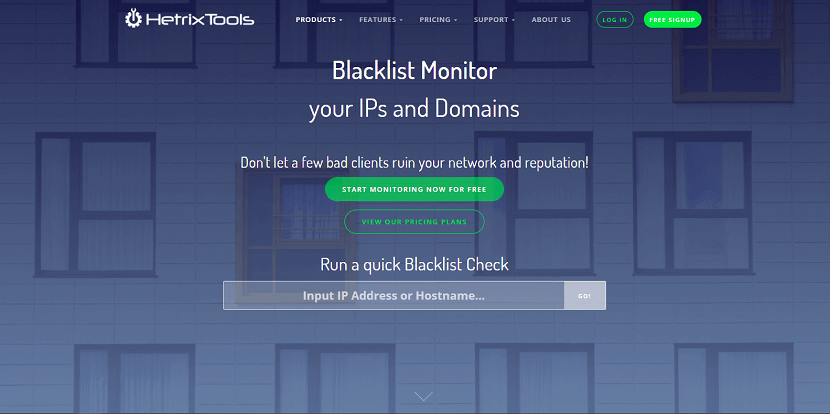
35. Dotcom-Monitor
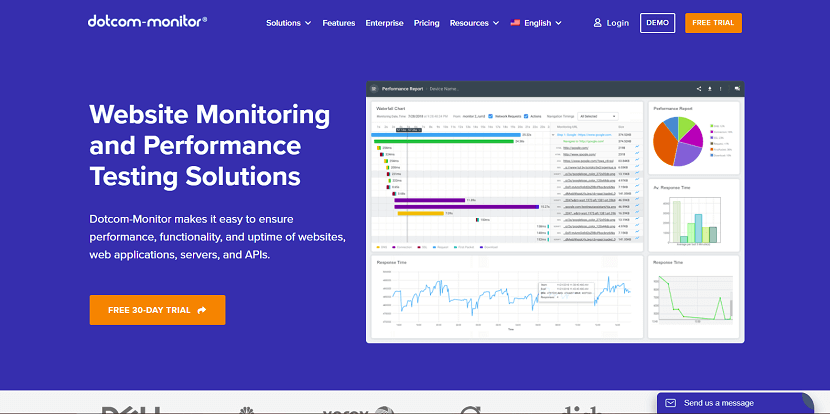
36. Montastic
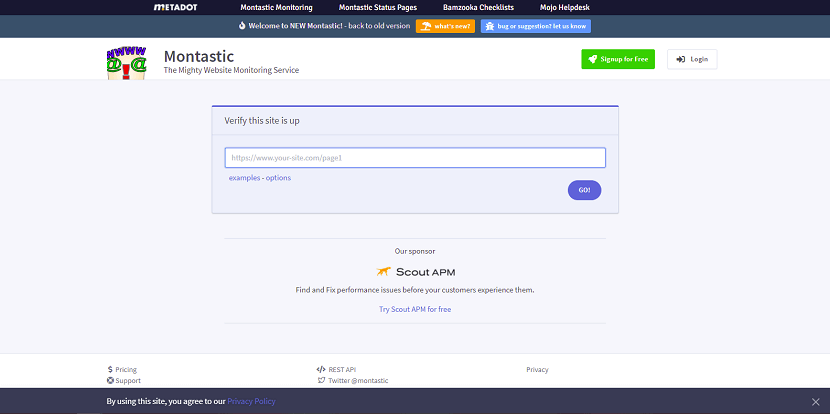
37. AlertBot
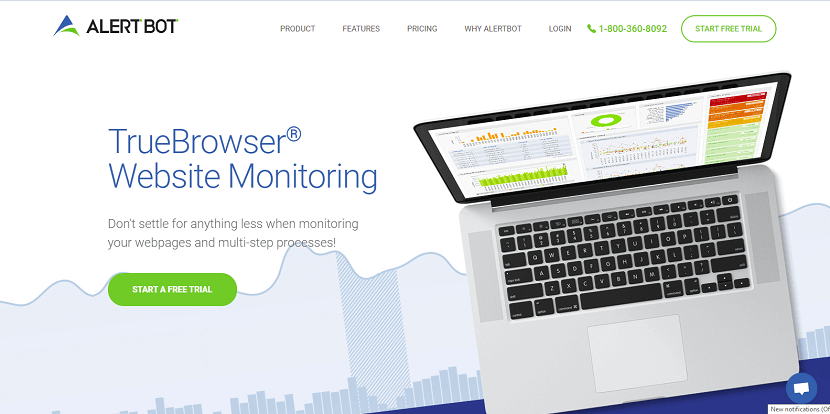
38. Happy Apps
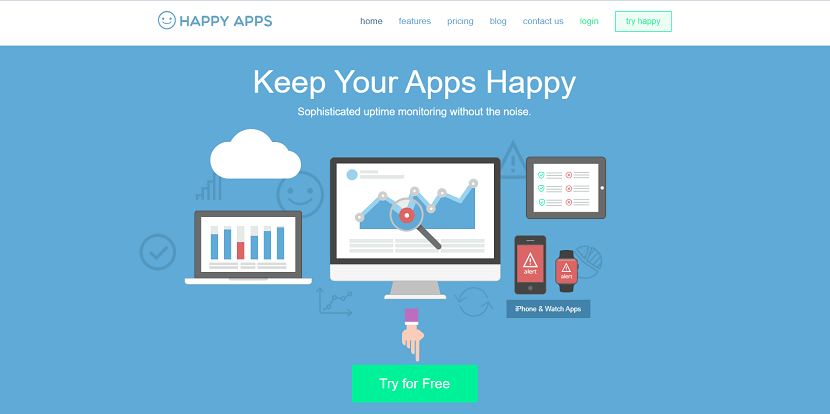
39. WebGazer
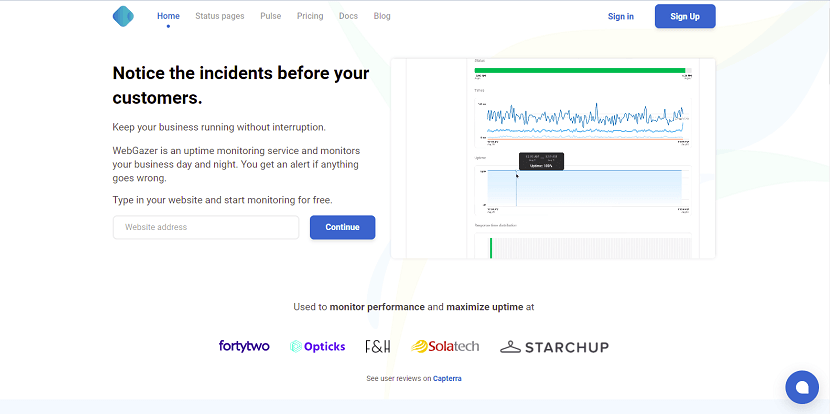
40. Are My Sites Up?
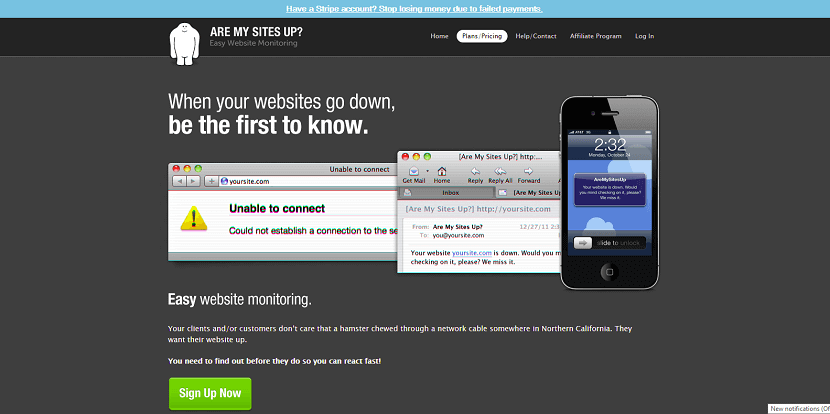
What’s the Verdict? Which One Should We Pick?
There’s no way to say which website monitoring service is better than the others because it all depends on what your goals are with your website.
From our experience, the best free options would probably be StatusCake and Uptime Robot. They have enough flexibility/features and can monitor your site at 5-minute intervals. So if you’re just testing the waters and aren’t sure if you really need one, go ahead and try them out.
The most bang for the buck you’d probably get from DotCom-Monitor, but we love the Pingdom user interface more, so it’s completely up to you.
One thing is for sure – Premium website monitoring tools will offer more features and reliable data to help you improve your site. If you’re serious about website monitoring, establish a budget so you can take advantage of these tools.
We’re not saying that the free tools are bad, though. In fact, they’re great if you don’t need all the bells and whistles. You can start with one of the free tools mentioned here, and if you feel you need a look at the “bigger picture,” consider a premium plan for monitoring your site performance.
45 Best Website Monitoring Tools | Free Online Website Monitoring Tools
45 Best Website Monitoring Tools | Free Online Website Monitoring ToolsIf you found this article helpful, we encourage you to share it on your social media platforms—because sharing is caring! For more information about article submissions on our website, feel free to reach out to us via email.
Send an emailWritten by RGB Web Tech
Latest Technology Trends
Latest technology trends shaping the future, including AI advancements, blockchain innovation, 5G connectivity, IoT integration, and sustainable tech solutions. Explore breakthroughs in quantum computing, cybersecurity, augmented reality, and edge computing. Stay ahead with insights into transformative technologies driving innovation across industries and revolutionizing how we live, work, and connect.
Bluehost Web Hosting Plans Review
Last updated on January 19, 2025 by RGB Web Tech
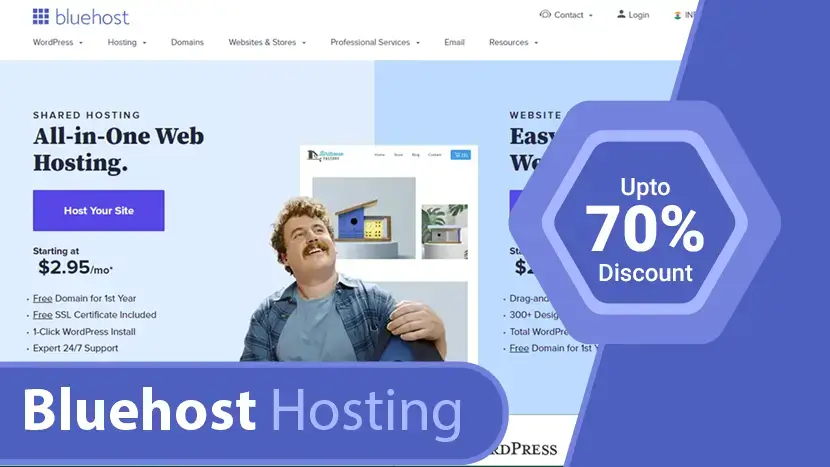
Bluehost started in 1996 and steadily grew to become one of the largest web hosting companies in the world. It now powers more than 2 million websites from all over the world.
Bluehost has a long-standing relationship with the WordPress community. They have been an official WordPress.org recommended web host since 2006.
They pride themselves in their 24/7 customer support, great hosting infrastructure, and support for the free open source software like WordPress.
On top of that, they are offering RGB Web Tech users an exclusive 63% off discount, a Free Domain, Free SSL, and a free Site Builder with templates.
Top Features
- Unlimited Websites
- Unmetered SSD Storage
- Unmetered Bandwidth
- 100+ Free WordPress Themes
- Free Domain for 1 Year
- Free Staging Environment
WordPress Website Builder
- Quick-Start AI Powered Templates
- Drag-n-Drop Builder
- Mobile-Responsive Themes
- Automatic Site Optimization
- 100+ Free Stock Image Library
Performance, Security, & Marketing
- SSL Certificate Protection
- Automatic Daily Malware Scan
- Speed Boosting CDN
- Website Stats Dashboard
- Email Marketing Tool
- WordPress Website Migration
- Free Bluehost SEO Tools
- Microsoft Office Email - Free 30 Days
- Domain Privacy
- Daily Website Backup
Bluehost Review Summary
- Performance grade - A+
- Average load time - 1.48 ms
- Average response time - 1.26 ms
- Free domain - Yes
- Free SSL - Yes
- 1-click WordPress - Yes
- Support - Phone / Live Chat / Knowledge base
Bottom line: In our Bluehost review, we found them to be reliable, fast, and affordable with friendly 24/7 customer support.
That’s why we’ve chosen to recommend Bluehost as one of the best WordPress hosting companies.
Now let’s dive into our detailed Bluehost hosting review so that you can decide for yourself.
In this comprehensive Bluehost review, we’ll put their promises to test with a rigorous and through analysis using industry standard benchmarking tools.
Following are the areas we’ll look into:
1. Speed: How fast will your website load with Bluehost? We will test their speed and server response time to assess that.
2. Performance: How does Bluehost perform under traffic spikes? We’ll test that by performing the stress test and see how well it performs under traffic.
3. Reliability: Will your website be available 24/7/365 without any downtime?
4. Customer Support: Can you count on Bluehost’s customer support when you immediately need help with your website?
5. Features: Do they offer all the features that you’ll need to build your website?
6. Pricing: Do they have the best pricing in the industry? Are there any Bluehost deals that can save you money?
This is our complete Bluehost review and we’ll be doing an in-depth analysis of Bluehost pros and cons. If you don’t want to read the full review, here is the quick scorecard of Bluehost with our verdict right below it.
Pros and Cons of Bluehost
All best web hosting services have their pros and cons. Some you can live with, and some you cannot ignore.
Here are the pros and cons of Bluehost that we learned.
Pros
First, let’s take a look at the advantages that make Bluehost the top choice.
1. Pricing: Their hosting plans are well within the reach of most users, particularly those who are just starting out.
2. Reliability: They power a large number of websites with minimum downtime.
3. No hidden charges: There are no hidden fees when signing up for your account.
4. Free domain: You get a free domain name for the first year when you sign up.
5. Free CDN + SSL: For each website, you get a free SSL certificate and free Cloudflare CDN to block malware and improve security.
6. Money Back Guarantee: They offer a 30 day money back guarantee on all plans.
Cons
As we mentioned earlier, there are always downsides with every hosting company. The following are some disadvantages of choosing Bluehost as your host.
1. Higher Domain Renewal Price: Their free domain renewal price is higher than average.
2. Upselling Addons: They have an aggressive upsell process during signup. But you can easily uncheck SiteLock and all other addons if you don’t need them.
Bluehost Hosting Plans and Features
Bluehost offers a variety of hosting plans for all budgets and sizes. Let’s take a look at Bluehost hosting plans and their features.
1. Shared Hosting:Shared hosting is the perfect way to start a new website with low traffic volume. In a shared hosting environment, your website shares server resources with other websites.
2. Cloud Hosting: A more reliable upgrade to the shared hosting plan. It allows you to utilize multiple cloud servers, allowing your website to automatically switch to a different server in case of a hardware failure or high traffic.
3. WordPress Hosting: Their WordPress plans are designed specifically for WordPress powered websites. It is optimized to run WordPress and can even protect your WordPress site against common threats.
4. VPS (Virtual Private Server) Hosting: An upgrade to shared WordPress hosting, VPS hosting allows you to virtual dedicated resources in a shared environment.
5. Dedicated Hosting Server: A dedicated hosting server for your website, means you will have all the resources of the dedicated server to yourself. The downside is that you will have to manage the server on your own.
All Bluehost hosting plans allow you to install WordPress with 1-click.
All plans come with an easy-to-use hosting control panel where you can manage your hosting, create databases, etc.
Bluehost has a custom control panel that improves ease of use for beginners. It also uses a customized version of the cPanel hosting dashboard for more advanced options.
Breakdown of Bluehost’s Shared Hosting Plans
Bluehost offers a shared hosting package suitable for starter websites. Their shared plan is available at four different levels.
Let’s take a look at Bluehost pricing and what’s included in each plan.
1. Basic: The basic plan only allows you to host one website. It hosts one domain and 25 subdomains, 50GB SSD storage, 5 email accounts of 100 MB disk space for each account. For the first term you’ll pay $2.75 per month. When you renew the account, you’ll have to pay $8.99 per month.
2. Plus: The Plus plan includes unlimited websites with unlimited storage space and unmetered bandwidth. You’ll also get unlimited email accounts. The price for the first term starts from $4.95 per month. When you renew the account, you’ll have to pay $11.99 per month.
3. Choice Plus: The Choice Plus plan includes all features of the plus plan. You will also get free domain privacy, and automated daily backups powered by CodeGuard as extras worth over $80/year. The price for the first term is $5.45 per month. When renewing, you’ll have to pay $16.99 per month.
4. Pro: The Pro plan starts from $13.95 per month for the first term after that you’ll pay $23.99 per month. It includes all features of above plans + dedicated IP address.
If you are just starting your website, then you can select any of these plans. You can easily upgrade your hosting plan as your website grows.
Bluehost Customer Support and Service
We all need help every now and then. It is really important that you choose a web hosting company that offers help and support when you need it.
Bluehost maintains a huge library of articles, step by step guides, and video tutorials as part of their extensive knowledge base. This is a huge help for beginners and most common issues can be quickly resolved by a simple search.
However, sometimes you may need to talk to an individual to get more help.
Bluehost offers a 24/7 support system where you can talk to their support team representatives using live chat or phone support. This is really helpful when you need quick help from technical support staff and you know they are just one-click away.
One thing that is missing is the ticket based support system. Bluehost recently decided to eliminate ticket-based support to focus on a personal approach of live chat support and phone-based support.
However, some users may still miss the ticket-based support system which is particularly good if your issue cannot be resolved in one live chat or phone session.
FAQs - Bluehost Web Hosting
In this detailed Bluehost review we have tried to cover all the aspects of their hosting services. The following are some of the most frequently asked questions about Bluehost that we hear from our users.
1. Can I make an online store using WooCommerce on Bluehost?
Answer : Yes, you can. In fact, Bluehost is one of the best WooCommerce hosting service providers. Their starter plan is perfect to start an online store.However, keep in mind that you’ll need to upgrade as your store starts getting more traffic. Hopefully, by that time you’ll be making enough money to justify the upgrade costs.
2. Is Bluehost good for beginners?
Answer : Yes. Bluehost is the most beginner-friendly WordPress hosting company on the market. They automatically install WordPress for you when you sign up. They also have an easy to use control panel which allows you to manage your hosting account by yourself.There is plenty of help available with detailed guides, video tutorials, and articles. You also have 24/7 access to their expert support via live chat and phone.
3. Can Bluehost handle high traffic?
Answer : Their shared hosting plans are suitable for starter websites and small businesses. In our stress test, their shared hosting plan was able to handle 100 virtual users without any slowdown.These plans can handle reasonable and sudden traffic spikes. However, they are still quite limited in server resources. If you are expecting high traffic then you’ll need to upgrade your hosting plan.
4. Why use Bluehost for WordPress?
Answer : Bluehost is one of the largest hosting companies in the world and an officially recommended WordPress hosting provider. They have been supporting the WordPress community for a very long time and know WordPress very well.Their platform is highly optimized for WordPress websites and engineered to run WordPress at peak performance. They also have WordPress engineers in their team so you know your website is in safe hands.
5. Do I need a credit card to sign up with Bluehost?
Answer : Bluehost accepts credit cards but you can choose to show more payment options during checkout and select PayPal as your payment method if you wish.
6. Is Bluehost better than GoDaddy?
Answer : Bluehost is better than GoDaddy because we believe Bluehost support is better. My Sites dashboard and overall onboarding experience is a lot more beginner friendly. Not to mention, Bluehost offers better pricing for small businesses.
7. How does Bluehost compare with SiteGround and HostGator?
Answer : When comparing Bluehost with SiteGround and HostGator, there are several pros and cons you should be aware of.Bluehost offers more value for the price when compared to SiteGround. Their plans start at $2.75 per month and include a free domain, whereas SiteGround plans start at $4.99 and do not include any free domain.On the other hand, the SiteGround platform comes with better speed and security features. For more details, see our comparison of Bluehost vs SiteGround vs WP Engine.In terms of Bluehost vs HostGator, they’re pretty similar when it comes to hosting CPU resources, functionality, site migration tools, pricing, and more. Bluehost is also more comparable with shared hosting providers like Inmotion hosting or Dreamhost. We find Bluehost user experience to be slightly better as they’ve invested heavily in their WordPress website builder platform.
8. Where are Bluehost servers located?
Answer : Bluehost operates its own in-house data center located in Utah, US. It is a massive 50,000 square feet facility that serves as their primary data center.
9. What Bluehost plan should I get?
Answer : If you are just starting out a brand new website, blog, or online store, then we recommend starting with their basic plan. It is good enough for a starter website and you can always upgrade later.Ready to start your website with Bluehost? Click here to select your Bluehost plan.
10. What are the types of web hosting?
Answer : This answer will be different for everyone. It depends on the type of website you have, the resources you need, your budget, and traffic.We gave our top recommendation for each category in this guide, so that’s the best place for you to start your search.Once you know what you need, you can narrow your options. To figure out what category you fall in, here’s a quick recap of the different hosting types.
Conclusion: Is Bluehost the Right Choice for You?
After reading this review, you might be wondering if Bluehost is the right choice for your website?
Bluehost is often ranked #1 web hosting provider by many websites. They offer a wide range of hosting options with tons of features that help you easily build your website.
All their hosting plans include expert 24/7 customer support from knowledgeable staff.
Most importantly, they offer affordable starter plans that fit any budget requirement.
If you are just starting out, then you cannot go wrong signing up for a Bluehost shared hosting plan. It’s easy on your pocket and comes with all the right tools. As your site grows you can easily upgrade your hosting plan accordingly.
Ready to start your website with Bluehost? Click here to select your Bluehost plan.
Alternatives - Web Hosting Providers
If you want to explore more web hosting plans, here is some web hosting services provider companies as below:
Read More : You can explore here 30+ Best Web Hosting and Domain name Providers 2023
Video - Best Web Hosting For Small Business
Affordable Website Hosting for your domainIf you found this article helpful, we encourage you to share it on your social media platforms—because sharing is caring! For more information about article submissions on our website, feel free to reach out to us via email.
Send an emailWritten by RGB Web Tech
Latest Technology Trends
Latest technology trends shaping the future, including AI advancements, blockchain innovation, 5G connectivity, IoT integration, and sustainable tech solutions. Explore breakthroughs in quantum computing, cybersecurity, augmented reality, and edge computing. Stay ahead with insights into transformative technologies driving innovation across industries and revolutionizing how we live, work, and connect.
GoDaddy Web Hosting Review
Last updated on January 19, 2025 by RGB Web Tech

GoDaddy Inc. is an American publicly traded Internet domain registrar and web hosting company. Its headquarters is in Scottsdale, Arizona, and incorporated in Delaware.
The Best Website Hosting providers will not be complete without mentioning GoDaddy, which is also known for their affordable website hosting plans. At only $1 per month, you will get not only website hosting but even free domain registration. They have global data centers, which can assure that speed will not be an issue. Plus, they are also guaranteeing 99.9% uptime. The cheapest plan also comes with unmetered bandwidth, 100 GB of storage, and a free domain when you sign up for the annual plan.
GoDaddy Hosting Features
GoDaddy’s platform is optimized for WordPress, with high-performance features like load-balanced servers. WordPress Hosting from GoDaddy uses servers modified to ensure WordPress websites run smoothly.
Their WordPress search engine optimization (SEO) plugin reviews pages and automatically handles basic SEO needs so search engines can easily find their client’s website. This service includes a security feature that finds and removes malware before it does damage available in their Ultimate and E-commerce hosting plans.
1. Easy-to-use Control Panel : Includes industry-standard cPanel to install apps, manage backups and security.
2. 1-click install of over 150 Free Apps : Provides access to over 150 free apps to create CMS sites (WordPress, Joomla), forums and blogs through Installatron.
3. 24/7 Network Security : Offers peace of mind, knowing network security and DDoS protection is monitored around the clock.
4. Resources on-demand : If you require more power for your site, seamlessly increase your CPU/RAM, I/O, and storage with a 1-click purchase.
5. Global Data Centers : Gives faster page loads and a better visitor experience with nearby, state-of-the-art data centers in North America, Europe, or Asia-Pacific.
6. 1-click Domain Name Setup : GoDaddy registered domain links your site to your domain name.
Pros and Cons of GoDaddy Web Hosting
There’s no question GoDaddy is one of the biggest names out there as far as how recognizable it is. It also houses the most domains globally, with over 17 million domain names on its roster.
Still, there are pros and cons to choosing GoDaddy as your web hosting provider. Here are the more prominent ones to take into account.
Pros
1. 24/7 Support : GoDaddy ensures it’s always within reach if you ever need a hand or run into trouble with your site. You can either reach them by phone or use its handy chat support option.
2. Lots of Storage : When you look through and compare GoDaddy’s hosting plans, it’s generous with its unmetered bandwidth feature for all tiers.
3. Affordable .com Domain : GoDaddy offers you the chance to snag a domain for only 99 cents for the first year, which can save you money as you begin.
4. Unlimited Site Hosting : Most GoDaddy plans let you host an unlimited number of websites except for its cheapest Economy plan.
5. Convenience : Since you can manage your domain and website in one place, GoDaddy offers convenience in managing both from one dashboard.
Cons
1. Constant Upsells : GoDaddy is notorious when it comes to its upsells through every step of the checkout process. While it does honor the prices for each tier if that’s all you’re going for, it’s quick to suggest add-ons and extra features you might not need.
2. Expensive Renewal Rate : This is one of the reasons why I think GoDaddy is great for beginner sites that just want to get their foot in the door with hosting. Once that initial year is up, GoDaddy’s renewal rates can start to get costly for what you get.
3. Charges for Add-ons : Other hosting providers throw in free first-year domain registration, for example, or include free SSL certification as part of its plans. GoDaddy does not always include these features depending on the plan you choose and can charge extra for them.
4. Inconsistent Customer Support : Support for GoDaddy isn’t always top-notch as convenience and reliability are concerned. There is always the possibility of long wait times to be connected to the right person.
FAQs - GoDaddy Hosting Review
1. Who owns GoDaddy?
Answer : GoDaddy was founded by Bob Parsons. About 70 percent of GoDaddy was sold to a private equity consortium several years ago, and the company has since gone public on NASDAQ with the stock ticker GDDY.
2. Where are GoDaddy servers located?
Answer : GoDaddy owns a massive 320,000 square feet data center that is located in Phoenix Arizona. The company also has data centers in Los Angeles, Chicago and Ashburn, Virginia, along with international facilities in Amsterdam and Singapore.
3. Does unlimited hosting mean what I think it means?
Answer : Yes and no. Shared plans do come with unlimited storage, but you are limited to 250,000 files/folders (and each email counts as a file). Furthermore, there are certain “soft” caps on other resources — if your usage exceeds these caps, GoDaddy may throttle the resources available to your website and, in extreme cases, may even prevent your use of the resources, leading to site downtime.
4. What kind of customer support do I get?
Answer : How do I contact GoDaddy’s support? You get first class 24/7 customer support via phone, live chat.
5. What are GoDaddy’s nameservers?
Answer : If your domain name is registered someplace else (for example with Namecheap) then you need to update the domain’s nameservers. You will find the correct NS values in your control panel. For example, GoDaddy’s default DNS nameservers look like: ns01.domaincontrol.com and ns02.domaincontrol.com. Their premium DNS nameservers look like: pdns01.domaincontrol.com and pdns02.domaincontrol.com.
6. How do I request a refund?
Answer : You can contact GoDaddy using live chat (Live chat can be launched via the “Chat with us” button on their website) or phone. To request a refund go to the “Contact Us”, select your country and perform a toll-free phone call.
7. What if I decide to cancel my hosting package with GoDaddy?
Answer : GoDaddy offers a money-back guarantee however it is related to the length of your web hosting plan. So do read the fine prints. However, you do qualify for a 45-day money-return guarantee if you have selected their annual plan.
8. What features does GoDaddy's website builder offer?
Answer : First of all, you’ll find many free templates to start customizing your website with. You’ll also find a nice library of 8,700 free photos. Another feature you can add to your website is a shopping cart. If you’re really short on time, GoDaddy’s Website Builder offers you pre-built websites with pre-written words and pictures. It just takes a mere 5 minutes to perform a tweak and you’re good to go.
9. What is GoDaddy’s cheapest hosting plan?
Answer : GoDaddy’s cheapest hosting plan is $2.99 per month and it comes with unlimited bandwidth and 100 GB storage and a free domain (for the first year) is included with the purchase.
10. Can I automatically install WordPress/automate WordPress installation?
Answer : WordPress installation is manual (though easy), but GoDaddy provides you with a WordPress managing tool suite, which automatizes your WordPress site backups and software updates. GoDaddy also enhances the performance of your WordPress website and offers you 24/7/365 specialized tech support. Managed WordPress plans come with the WordPress core pre-installed.
11. Which GoDaddy plan is best for WordPress sites?
Answer : The best plan for self-hosted WordPress users depends on the total number of sites hosted. Although the Developer plan is the most expensive one, it’s meant for people who own 5 websites and have up to 800,000 monthly visitors. On the other hand, the Ultimate plan can handle one or two WordPress sites, and 400,000 monthly visitors. It also includes malware protection.GoDaddy also offers managed WordPress options, which include bonuses like WordPress installed by default, staging areas, and dedicated phone support lines (no live chat, though).
Alternatives - Web Hosting Providers
If you want to explore more web hosting plans, here is some web hosting services provider companies as below:
Read More : You can explore here 30+ Best Web Hosting and Domain name Providers 2023
Video - Best Web Hosting For Small Business
Affordable Website Hosting for your domainIf you found this article helpful, we encourage you to share it on your social media platforms—because sharing is caring! For more information about article submissions on our website, feel free to reach out to us via email.
Send an emailWritten by RGB Web Tech
Latest Technology Trends
Latest technology trends shaping the future, including AI advancements, blockchain innovation, 5G connectivity, IoT integration, and sustainable tech solutions. Explore breakthroughs in quantum computing, cybersecurity, augmented reality, and edge computing. Stay ahead with insights into transformative technologies driving innovation across industries and revolutionizing how we live, work, and connect.
Hostinger Web Hosting Review
Last updated on January 19, 2025 by RGB Web Tech
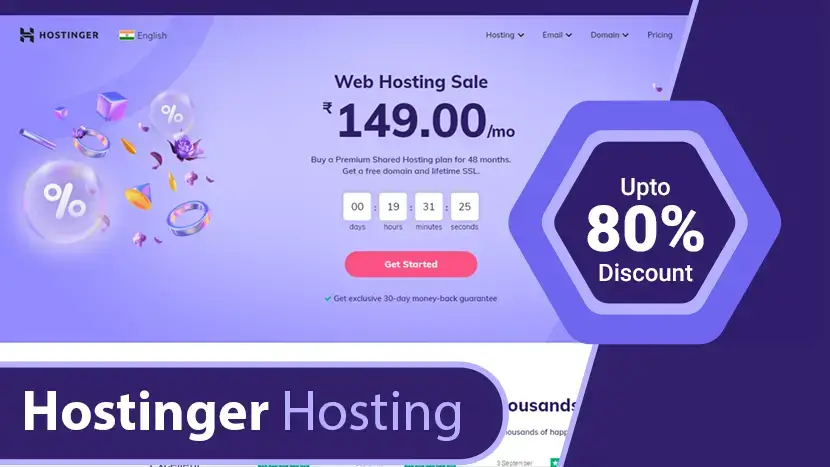
Hostinger is known for its inexpensive shared, cloud, and VPS hosting. All of their plans come with a 30-day money-back guarantee and a free website builder. Do these low-cost plans scrimp on features? Let’s take a closer look at Hostinger’s server speeds, performance, ease-of-use, and customer service.
Hostinger may be best known for its deeply discounted hosting. These Hostinger hosting plans are incredibly cheap compared to industry averages. All plans come with a 30-day free trial.
Hostinger provides free SSL certificates on all plans except for the entry-level Single Shared Hosting plan. SSL certificates are a must for all sites. Browsers may mark your site as ‘unsafe’ if you do not have an SSL certificate. Many hosting companies charge extra for SSL certificates.
Features
- Free Domain (₹679.00 value)
- Free SSL (₹855.00 value)
- Free Email
- 200 GB SSD Storage
- ~100000 Visits Monthly
- 30 Days Money Back Guarantee
- Daily Backups (₹660.00 value)
- Free CDN (₹545.00 value)
- Cloudflare Protected Nameservers
- 24/7/365 Support
- 99.9% Uptime Guarantee
- Unlimited Bandwidth
- Managed WordPress
- Unlimited Databases
- DNS Management
- 100 Websites
- 100 Subdomains
- Unlimited FTP Account
- Unlimited Cronjobs
What Are the Pros and Cons of Hostinger?
Pros
- Comprehensive knowledge base.
- User-friendly control panel.
- Competitive Pricing.
- Multiple Data Centers.
- Excellent onboarding.
- Free nightly backups.
- 30-day money-back guarantee.
- Free SSL & Domain name on entry-level plan
Cons
- Inconsistent website speed.
- Refund exceptions.
- Limited Support.
How is Hostinger’s Performance and Uptime?
Hostinger provides good server response speeds. Over the period from April 2019 through June 2019, our tests showed an average response of 509 ms.
Hostinger uses various technologies to boost site loading speeds, including:
1. SSDs: Solid-state drives are faster and more reliable than HDDs (hard-disk drives).
2. HTTP/2 and HTTP/3 (Quic): This is a network protocol that increases speed.
3. PHP 7: Most modern dynamic websites (like those built with WordPress) use the PHP language. PHP 7 provides greater speed and reliability.
4. Litespeed: Litespeed is a brand of web servers known for its speed.
5. GZIP compression: This is a form of file compression used to increase speed.
Uptime refers to the amount of time that servers are up and working correctly from the host’s end. A high uptime indicates that a host is stable, well-built, and can fend off network threats.
Hostinger provides a 99.9% uptime guarantee.
How Does Hostinger Keep Your Site Secure?
Hostinger’s SSL security guarantees lifetime security. Their web hosting plan offers a free SSL certificate to provide a safe online environment as it offers the highest level of encryption and immediate access results. Their servers have advanced security modules (such as mod_security, Suhosin PHP hardening, PHP open_basedir protection, and others) that give the highest security level available today.
Their free SSL certificate will ensure the safety of their client’s data including their clients’ target audience. Hostinger’s SSL for WordPress will also protect their clients’ blogs or e-commerce shops, ensuring the safety and reliability of every online transaction. The encryption, which protects their client’s data from theft and any other malignant act, is the strongest form of encryption in the open market and follows the SSL protocol – a guaranteed security service of Hostinger.
Hostinger’s Cloudflare is a CDN (Content Delivery Network) that not only speeds up your website’s loading speed but also protects it from intrusions and DDoS attacks. All of their hosting plans fully support Cloudflare that establishes a secure connection for sensitive data protecting their clients’ websites. This security service requires an additional fee before setting up.
Does Hostinger Handle Site Backups?
Hostinger provides daily backups with the majority of their hosting plans – the only plans that have weekly backups are their Shared Single and Premium hosting plans.
Their hPanel contains backup features that allow you to backup your files and data You can download both the website files and the database when backing up your site manually. In your hPanel, backups can be made by accessing your Backups option under the Files section. Click on Select near Generate new backup section, give it some time, your new Files and Databases backups will be made.
How is Hostinger’s Help and Support?
Hostinger provides 24/7 support. You have 2 main options.
Hostinger knowledge base – Consists of hundreds of tutorials and solutions to common issues. It’s easy to search, and from what I see, the answers are all easy to understand.
Live chat support – Available 24/7, every day of the year.
Hostinger is also active on social media and usually responds to messages and posts within a few hours.
FAQs - Hostinger Web Hosting
1. Which Company Owns Hostinger?
Answer : Established in 2004, Hostinger now has over 29 million users, collectively with its subsidiaries in 178 countries. Hostinger is the parent company of 000Webhost, Niagahoster and Weblink.
2. Which Languages Does Hostinger Support Team Speak?
Answer : Their customer support provides support in English for all locales. Additional languages they speak are Lithuanian, Portuguese and Brazilian Portuguese, Indonesian and Malaysian, Spanish, Russian, Ukrainian, French, Arabic, Thai, Vietnamese and Chinese.
3. What Kind of Support Do I Get With Hostinger?
Answer : Hostinger offers 24/7/365 support via live chat.
4. Where are Hostinger’s Servers Located?
Answer : Their servers are located all around the world. They have datacenters in Europe (the Netherlands, Lithuania, the United Kingdom), Asia (Singapore), North America (the USA).
5. What is Hostinger's Cheapest Hosting Plan?
Answer : Hostinger cheapest plan is their Single shared hosting package, which costs $1.39 per month.
6. Does Hostinger Have a cPanel?
Answer : Hostinger does not provide the classic cPanel to manage domain and hosting accounts. It has its own control panel, which is known as hPanel.
7. What are the types of web hosting?
Answer : This answer will be different for everyone. It depends on the type of website you have, the resources you need, your budget, and traffic.We gave our top recommendation for each category in this guide, so that’s the best place for you to start your search.Once you know what you need, you can narrow your options. To figure out what category you fall in, here’s a quick recap of the different hosting types
Conclusion
Hostinger is a user-friendly, secure, reliable, and affordable hosting option, especially if you are just starting out with your website.
Alternatives - Web Hosting Providers
If you want to explore more web hosting plans, here is some web hosting services provider companies as below:
Read More : You can explore here 30+ Best Web Hosting and Domain name Providers 2023
Video - Best Web Hosting For Small Business
Affordable Website Hosting for your domainIf you found this article helpful, we encourage you to share it on your social media platforms—because sharing is caring! For more information about article submissions on our website, feel free to reach out to us via email.
Send an emailWritten by RGB Web Tech
Latest Technology Trends
Latest technology trends shaping the future, including AI advancements, blockchain innovation, 5G connectivity, IoT integration, and sustainable tech solutions. Explore breakthroughs in quantum computing, cybersecurity, augmented reality, and edge computing. Stay ahead with insights into transformative technologies driving innovation across industries and revolutionizing how we live, work, and connect.
HostGator Web Hosting Review ( Web Hosting Plans for All Business)
Last updated on January 19, 2025 by RGB Web Tech

Given that HostGator has a lot to like and very few things to dislike, you should definitely try the company if you own a website or plan to build one.
If the web host does not make a good fit for your website, the 45-day money-back guarantee allows you to walk away without losing your money.
Having been around for more than a decade, HostGator is one of the most trusted and recognized web hosts. It excels in several areas including customer support, hosting flexibility, uptime, shared hosting, plus so much more.
This excellence in several aspects of web hosting coupled with the company’s experience, array of features, and performance makes HostGator a smart choice for any website owner.
Regardless of where you are in the website-building cycle, HostGator has something for you.
You can begin building your website using their drag-and-drop Website Builder. If you’re at the other end of the spectrum, you can enlist the help of HostGator’s dedicated Migrations Team to transfer your website and configure it for optimal performance on their platform – for free.
Features
- 1-Click WordPress Installation
- Free SSL Certificate
- Unmetered Disk Space & Bandwidth
- Easy-To-Use cPanel
- E-commerce Ready
- Drag & Drop Templates
- 24/7/365 Technical Support
- 45 days Money-Back Guarantee
What Are the Pros and Cons of HostGator?
So, is HostGator the right web host for you?
Well, given the fact that HostGator gives you a simple way to build and manage your site, provides you with all the resources you’ll need to deliver high-level services on your site, offers several feature-packed hosting packages, and brings a ton of experience to the table, it can be an ideal web host for anyone with a website.
What Are the Pros of HostGator?
HostGator offers several benefits including:
- Reliable uptime and fast response times.
- Affordable hosting plans.
- Plenty of room for growth.
- No restriction on bandwidth, disk space, and emails.
- Rock-solid security.
- Free Weebly site builder.
- A great control panel with a ton of features ranging from a web-based file manager to more advanced features such as cron jobs, image manager, error logs, and apache handlers.
- The option of cloud hosting.
- Flexible email management.
- Free shared or private SSL certificate on all hosting packages.
- Generous 45-day money-back guarantee that gives customers peace of mind.
Extensive Knowledge Base
Additionally, HostGator has a large knowledgebase with answers to practically any question you could have ranging from the simplest to the most advanced. So, when the customer support team takes too long to answer, you can seek out the solution to your problem from this knowledgebase.
What are the Cons of HostGator?
As for the negatives of the company, you’ll only have to deal with the issue of weekly backups, slow customer response times (according to some of the host’s users), an advanced cPanel that requires some getting used to, and no one-stop WordPress import.
Be aware that HostGator is not HIPAA-compliant. If you need such compliance to explore Atlantic.net, a web host that exceeds HIPAA guidelines and is fully compliant. If you serve Canada, explore Canadian Web Hosting, which is fully compliant with Canada’s health and privacy data regulations.
These are cons you can work around and still get to enjoy the immense web hosting quality of HostGator.
What Makes HostGator Stand Out?
Further making HostGator a good catch is the fact that the web host throws in a few extra features with their various hosting plans. For instance, each hosting plan comes with several freebies.
You get a free website builder and website building tools, unlimited bandwidth and disk space, over 4,000 website templates, free domain transfers, and unlimited MySQL databases.
HostGator are Generous with Valuable Extras
Other extras that you can look forward to with HostGator include:
1. $150 worth of Google Adwords or Bing/Yahoo advertising credits.
2. Free site transfers when you want to move your website from another host to HostGator. And the best part is that your website can be upgraded during the transfer at no cost. However, the said migration has to be done within 30 days from the day you sign up.
3. A free domain name for the first term when you transfer and set up a new account.
4. 1-click installs available for all major open-source projects such as WordPress, Magento, and Joomla.
5. A 45-day money-back guarantee for all HostGator hosting plans. Most web hosting companies only give you a 30-day window to cancel your account and get your money back.
6. A getting-started email with links to all of the resources you will need to build your website and get it up and running.
What Perks Are On the Table?
HostGator offers a range of plans. If you’re struggling to make a decision on which plan to choose, consider these features, which we’ll discuss below:
1. You manage your account using cPanel, the industry-standard interface.
2. To keep your account secure, you get a free Secure Sockets Layer (SSL) certificate.
3. If you want to increase security and malware scanning, you will have to buy SiteLock.
4. Even the entry-level shared hosting plan comes with support for unlimited email accounts.
5. Monthly billing options are available.
6. One-click installs, even from the basic plan.
7. Access to the website builder – at a cost.
8. A Content Delivery Network (CDN) keeps your site fast.
9. Multiple support options including live chat.
With all the other web hosting providers that are available, why choose HostGator? Well, the truth is that no single web host is perfect. So, whether you’re a novice webmaster or are looking to change web hosts, here’s a quick look at the good and the bad of HostGator to help you make the right decision.
FAQs - HostGator Web Hosting
Anything else you’d like to know about HostGator? We have created a group of frequently asked questions to cover any instant queries you have.
1. Who owns HostGator?
Answer : HostGator is owned by Endurance International Group (EIG). EIG owns a large slice of the web hosting industry, for example, EIG owns Arvixe, A Small Orange, Bluehost, iPage, HostGator.
2. What kind of support do I get?
Answer : You get 24/7/365 support via phone, live chat, emails, and a comprehensive database of knowledge. There are 500+ tutorials to help you with almost anything related to HostGator. There are also more than 680 helpful articles on their website.
3. What languages does HostGator support speak?
Answer : HostGator’s customer service is only provided in English.
4. How long has HostGator been in business?
Answer : Founded in 2002, HostGator is an established and reputable web hosting company that has been in business for over a decade. After being sold off in 2012, HostGator became a subsidiary of Endurance International Group (EIG).
5. Why should I choose HostGator?
Answer : With more than 8 million hosted domains, HostGator is among the top 30+ largest web hosting companies. HostGator is worth considering because of its top-notch customer support service, state-of-the-art data centers, and comprehensive web hosting packages. Millions of website owners choose them for these reasons.
6. What are HostGator nameservers?
Answer : There are two places where you will be able to find Hostgator name servers. You can find them in your welcome email or find them listed inside of your cPanel control panel. Your nameservers will have the following syntax: xx.hostgator.com – xx.hostgator.com.
7. What if I decide to cancel my hosting with HostGator?
8. Will I be billed monthly or yearly when using a HostGator account?
Answer : Customers get to choose their preferred billing cycle when signing up with HostGator. You can choose to be billed monthly, after 6 months, annually, biannually, or once every 3 years. The longer terms come with discounts that amount to significant savings over time.
9. Are there any hidden charges?
Answer : There are no hidden fees associated with any of HostGator’s hosting packages. A billing summary is usually included on the order page where you can easily remove add-ons that you do not want. New monthly subscribers should keep in mind though that the introductory prices for the first month are usually discounted and automatically renew at the regular rate.
10. What forms of payment does HostGator accept?
Answer : HostGator is very flexible when it comes to payments. They accept payments via PayPal, MasterCard, Visa, American Express, Discover, wire transfers, personal checks, cash, and money orders.
11. What types of hosting packages are there?
Answer : There are three shared hosting plans: Hatchling, Baby, and Business. There is also a range of VPS and Dedicated server packages. HostGator also offers cloud hosting and fully managed WordPress hosting for your WordPress websites and blogs.
12. Does HostGator offer Linux or Windows servers?
Answer : Unlike most web hosts that focus on Linux hosting only, HostGator offers the choice of Windows-based servers as well. Plesk is the default control panel on Windows servers while those who prefer Linux get to use cPanel.
13. Can I purchase a domain name with HostGator?
Answer : Yes, HostGator can be your domain registrar whether you decide to purchase hosting from them or not. They also offer dozens of extensions as well as Top-Level and country code Domains.
14. What are the best alternatives to HostGator?
Answer : HostGator is an affordable and good entry-level web hosting provider, and they’re one of the world’s most popular web hosting companies. However, if you are looking for alternatives to HostGator you should check out Bluehost, SiteGround, DreamHost, and A2 Hosting.
15. What is HostGator’s cheapest web hosting plan?
Answer : HostGator’s cheapest plan is 32.95. They offer a free trial with a 45-day money guarantee. In other words, you get your money back, no questions asked, if you decide to cancel within the first 45 days.
16. How do I transfer my website to HostGator?
Answer : HostGator makes it easy to transfer your website to your HostGator hosting account. They can transfer website files, databases, scripts, and one free domain registration transfer. HostGator provides free transfers for new accounts within 30 days of sign-up, and to newly upgraded accounts.
17. How do I install WordPress in HostGator?
Answer : WordPress is one of the most popular blogging platforms around. The first step to install WordPress is to log in to your cPanel account, the second step is to go to the MOJO Marketplace and go through the Quick Install process.
18. What are the types of web hosting?
Answer : This answer will be different for everyone. It depends on the type of website you have, the resources you need, your budget, and traffic.We gave our top recommendation for each category in this guide, so that’s the best place for you to start your search.Once you know what you need, you can narrow your options. To figure out what category you fall in, here’s a quick recap of the different hosting types.
Alternatives - Web Hosting Providers
If you want to explore more web hosting plans, here is some web hosting services provider companies as below:
Read More : You can explore here 30+ Best Web Hosting and Domain name Providers 2023
Video - Best Web Hosting For Small Business
Affordable Website Hosting for your domainIf you found this article helpful, we encourage you to share it on your social media platforms—because sharing is caring! For more information about article submissions on our website, feel free to reach out to us via email.
Send an emailWritten by RGB Web Tech
Latest Technology Trends
Latest technology trends shaping the future, including AI advancements, blockchain innovation, 5G connectivity, IoT integration, and sustainable tech solutions. Explore breakthroughs in quantum computing, cybersecurity, augmented reality, and edge computing. Stay ahead with insights into transformative technologies driving innovation across industries and revolutionizing how we live, work, and connect.
What is Windows Web Hosting?
Last updated on January 19, 2025 by RGB Web Tech
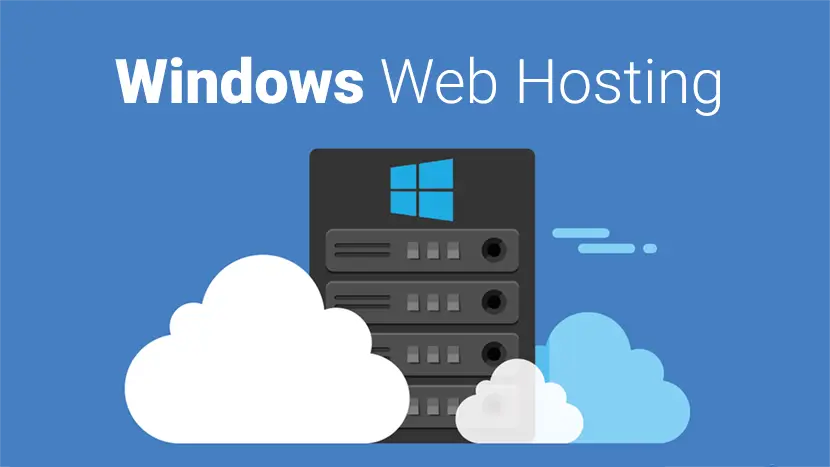
The necessity of having a dynamic website with visually attractive elements has now become an essential factor for many individuals. Windows web hosting is one of the most popular and feature-rich services offered by hosting companies that meet these needs markedly.
Generally speaking, there are two main options available for web hosting: Windows and Linux. Windows hosting with its dynamic technology can help you stay ahead of the competition with eye-catching pages that run smoothly.
What Is Windows Hosting Meaning?
It is typically a web hosting server that runs by the Windows OS or its other variants. Your website pages can efficiently have access to web development features of Windows when you use a hosting service of this kind.
The popularity of Windows as an operating system around the world has paved the way for windows hosting meaning to become hugely favorable among website owners. Currently, more than 75% of the desktop operating system’s global market belongs to Windows. Microsoft is continually researching this product, and we can see the improvements it makes on Windows every year not only in the technical aspects but also in support of various scripts.
Advantages of Windows Web Hosting Hosting
When you are looking for a hosting solution, you will come across numerous options. Windows hosting holds a prominent place among them. If you are looking for a feature-rich hosting solution, you may take a look at this type of hosting. However, it is better to evaluate its pros and cons before you proceed.
1. A Microsoft-Friendly Option
Many websites and businesses rely on different products and tools of Microsoft like FrontPage and ASP to function properly. The same conditions apply to Microsoft Exchange for efficient management of emails and Microsoft SharePoint for better collaboration between team members.
These products offer excellent quality and have proved to be the best option in their category. For instance, ASP is much easier to use than other server-side services and integrates perfectly with many other languages as well.
Therefore, windows shared hosting counts as a perfect solution for this purpose that provides you with enough capabilities to build dynamic and interactive websites. Moreover, many tech professionals are accustomed to maintaining and updating windows and its programs. This familiarity with Windows OS makes it easy for them to work with the server interface, too.
2. Powerful and Simple
Windows hosting services are often based on Windows Server OS. This operating system enables you to manage your server and scale it without any concerns about its security.
Additionally, these windows website hosting packages come with the user-friendly Plesk control panel that makes it much easier for you to update your website and make changes where needed. The intuitive interface of Plesk, with its great focus on commercial websites, lets you manage multiple sites conveniently. Plus, it’s completely compatible with the most popular content management systems, including WordPress and Joomla.
Above all, all the Microsoft products are developed in a way to support one another. This advantage has attracted developers towards creating various applications in complete compatibility with Windows. Similarly, open-source tools like MySQL and PHP run efficiently on this hosting platform, and this feature isn’t available on Linux to this extent.
3. A Reasonable Solution
It used to be a costly service due to the high price of Microsoft licenses. However, these days you can find affordable plans as low as $10 a month from different service providers. Although Windows hosting packages are costlier than Linux, compared to the features you receive in return for the budget, you can rest assured that your money is spent well.
4. It Runs on Windows Operating System
Most of us are familiar with Windows operating system which windows shared hosting runs on it. Hence, you don’t have to go through the struggle of getting used to it. In other words, you don’t have to go through a lengthy learning curve while you are trying to work with this hosting solution. You will find specific features, which you can use according to your preferences. On these plans, you will discover the Plesk control panel. This delivers an intuitive experience than cPanel, which you can find in Linux hosting.
5. It Is Compatible With Other Windows Tools
One of the main reasons why people go for this type of hosting is the presence of numerous familiar tools. This makes life easy for them when managing the hosting plan. For example, if your website is developed with ASP.NET, Windows hosting would be a great solution available to consider. On the other hand, you will notice how compatible your hosting plan with Microsoft SQL is. You might even be able to use Microsoft Exchange as the email server.
6. It Comes With a Plesk Control Panel
As mentioned earlier, hosting windows server comes with a Plesk control panel. You can access straightforward controls on this control panel. Hence, managing your hosting plan will never be a challenging thing. If you want to make any changes or updates to your website, you can easily do them. You will even be able to manage multiple domains and websites in your hosting solution without a problem.
Disadvantages of Windows Hosting
1. It Is Not Secure as Linux Hosting
When you make a cross-comparison between the security of Windows hosting and Linux hosting, you will notice some significant differences. In other words, Linux hosting is more secure. Windows hosting solutions are highly vulnerable to numerous attacks, including ransomware attacks. However, Linux hosting is more confident, and you will keep peace of mind. Since security is a significant concern, you must be mindful of this fact as you pick a hosting solution.
2. It Is Expensive
You will have to spend more money to get this type of hosting when compared to Linux hosting. However, this varies depending on the hosting solutions provider. For example, if you look at Hostgator, you will notice that Linux hosting plans start at $2.75 per month, whereas Windows hosting plans start at $4.76 per month. You will be able to save money in the long run by going ahead with Linux hosting.
3. It Is Less Stable
Linux servers are well-known for their dependability. They seldom need to be restarted and can perform many tasks at once. On the other hand, Windows servers have difficulty running many programs and processes simultaneously without crashing. Like any other web technology, Windows servers have improved over time and are anticipated to continue to do so. However, they aren’t relatively as constant in their performance as Linux servers.
However, this is another area where selecting the appropriate web hosting company may make a significant impact. When a Windows hosting business offers a 99.9% uptime guarantee, it means they’ve taken all the necessary steps to keep their Windows servers running as smoothly as possible. A competent web hosting company can assist overcome the gap in server stability between Windows and Linux hosting by paying attention to maintenance and planning.
Who Should Choose Windows Web Hosting Server?
Windows hosting, compared to its Linux counterpart, has many areas with exceptional strength that makes it a perfect match for a hosting service. It’s essential for some web programming languages and scripts such as ASP, Visual Basic, and C# to work seamlessly.
Additionally, it supports commonly-used databases like SQL and MS Access so that you won’t have any difficulty managing your database.
Frequently Asked Questions
Does Windows Hosting Support WordPress?
One of the common questions among users is “can you host WordPress on a Windows server?“. Microsoft provides a set of tools and a robust platform that is capable of hosting WordPress. One of the most important things about Microsoft’s web platform is its interface. The Microsoft Windows server family provides several roles which can take control of complicated IT tasks.
Does Windows Hosting Support PHP?
The answer is yes. Most shared hosting services of windows support PHP by default. If PHP is not enabled on your host, you should ask your hosting provider to activate it for you.
Conclusion
We know what is windows web hosting. Windows shared hosting is an excellent option for a broad range of requirements. Although you will need to pay more money compared to the Linux solution, the efficiency and advantages of windows web hosting will outweigh its costs. So if you want high functionality and integration with popular applications, don’t hesitate to go for this service.
List of Windows Hosting Service Providers:
Read More : You can explore here 30+ Best Web Hosting Providers 2023
Video - Best Web Hosting For Small Business
Affordable Website Hosting for your domainIf you found this article helpful, we encourage you to share it on your social media platforms—because sharing is caring! For more information about article submissions on our website, feel free to reach out to us via email.
Send an emailWritten by RGB Web Tech
Latest Technology Trends
Latest technology trends shaping the future, including AI advancements, blockchain innovation, 5G connectivity, IoT integration, and sustainable tech solutions. Explore breakthroughs in quantum computing, cybersecurity, augmented reality, and edge computing. Stay ahead with insights into transformative technologies driving innovation across industries and revolutionizing how we live, work, and connect.
What is Shared Web Hosting?
Last updated on January 19, 2025 by RGB Web Tech

Deciding on the hosting service for a website can be tough. Hosting service providers offer different packages and plans, which can leave you confused about which one to choose. To hit the right note, you should gain information about different types of hosting plans and pick the correct one based on your needs.
Shared web hosting can be a good choice when your website is still in its infancy and has not been expanded to require specific resources and access. But in most cases, there is a day when shared hosting will no longer meet the needs of your website. The advantages of shared hosting and also disadvantages of shared hosting can make them a viable choice or a troublesome limitation depending on your circumstances and needs. In the remainder of this article,
Here we discuss what is shared hosting that comes as a popular choice for many users launching their first website. In the following paragraphs, we will examine shared hosting pros and cons to determine the strengths and weaknesses of this type of hosting.
What Is Shared Hosting Meaning?
Shared hosting means are the most affordable option to use for running a website. As a shared web hosting definition, multiple sites share a single server when they run on shared hosting. That’s the reason why these services come at a lower price compared to the dedicated ones.
In most cases, the user doesn’t know other users who share the server. But, all users have access to the platform of the server to see the databases, find out about email accounts, and access other provided features. The allowed capacities are limited by the service provider, which is often described in the details of the package you buy.
Generally speaking, a shared hosting server is proper for a personal weblog, startups, local businesses, or other small websites that don’t need very high bandwidth or professional settings. Websites with high volume should go for VPS or other dedicated options available on the market. Owners of these sites can take advantage of more in-depth controls and more stable performance if they choose plans with higher prices than the shared hosting. In the past article, we have mentioned the advantages of shared hosting.
How Does Shared Hosting Work?
Shared hosting plans are cheap and affordable. Before you go ahead with it, you will come across the need to figure out what is shared web hosting and how it works. Shared hosting is where you will be provided with hosting space in a server, which hosts multiple other websites. It can even contain hundreds or thousands of websites. The server resources, including processing speed, RAM, and hard drive space, are shared between all the websites hosted. Due to the same reason, the performance of your website hosted on the shared hosting server can be affected by another website’s performance on the same server. This is something that you will need to be mindful of.
Advantages of Shared Hosting
Now you have answers to the question of what is shared hosting. There are some drawbacks and benefits of shared web hosting that you must know before deciding whether or not to use this kind of web hosting. In the following, we are going to mention some of the benefits first:
1. Cost-Effective: One of the advantages of shared hosting is being cheap; shared hosting services are the cheapest type of hosting services you can supply. In this type of service, the resources of a server are divided into several hundred or even several thousand websites. As a result, the cost per user is significantly reduced. The pricing plans you find for these services fall somewhere between $2.5 to $10 per month.
2. Simple User Interface: One of the main benefits of shared hosting is a simple user interface. Shared hosting is generally managed by control panels. This means that when you purchase the service, you are provided with a web interface with the ability to make changes, upload, create a site and add domains, and more. Due to the simple user interface in these types of management panels, you no longer need to have high knowledge of Linux or Windows servers and can use your service without paying attention to the details. The control panels provided on these services are generally Plesk, Cpanel or Solidcp.
3. Security : As with other shared hosting services, security is of particular importance. If there is a security problem with these types of services, this deficiency can cause problems for a large number of services running on that server or all of them. For this reason, companies offering these types of services are particularly sensitive to their security checks and even to the limitations of protecting users, so you don’t have to worry about security. Periodic server updates, data backups, restrictions on service changes, and the inability to use some protocols are security issues that generally apply to these services.
4. Support : One of the main shared hosting benefits is that it does not require server management. As mentioned above, server-side security issues are controlled by the provider on an ongoing basis in shared services. But security reviews are not the only things that need to be done to make a service sustainable. Hosting networks are generally complex systems, and because of this complexity, the possibility of disruption or a technical difficulty is very high. Investigating and resolving such cases can, in many cases, require increased knowledge and hours, or even days. It is up to the server to monitor and resolve such problems in shared services.
Technical support is another strength and benefit of shared web hosting that can, in many cases, make your work easier and return valuable hours to you. Generally, quality hosting services provide relatively extensive technical support. The technical teams prevent the services from being interrupted by a 24-hour review and investigation of the services and will resolve the interruptions as soon as possible. More importantly, you can contact your hosting service support experts at any time in different ways to investigate and troubleshoot any issues that may arise on these services.
5. Scalable : Scalability is among the important advantages of shared hosting. Since new and small sites don’t see much traffic, shared hosting works best for them. This feature allows them to remain within limits established by many users drawing from a shared server’s finite resources. In fact, shared hosting solutions are not just for personal website owners and casual bloggers. It can handle up to 100,000 visitors a month, translating to roughly over 3000 visitors daily. When a website gets to a certain level of monthly traffic, it may need to upgrade to a different rank of shared hosting or switch to another hosting entirely.
In sum, shared hosting services may require you to hire a server administrator to maintain the service. This type of support and management of service is generally not provided on virtual servers or will be significantly limited.
6. You Can Host Multiple Domains : You can have multiple domains under the user directory while using a shared hosting plan. The hosting provider will deliver a convenient interface, which you can use to manage all the websites. This interface can help you to overcome complexity in managing multiple websites.
7. It’s Professionally Managed : The maintenance cost associated with shared hosting is low. In fact, you will be able to manage the website as well professionally. All you have to do is seek the assistance of a professional team and hand over the job to them.
8. It Can Host Dynamic Websites: Dynamic websites are the websites that change dynamically based on how a user is browsing. Quora, Facebook, and Twitter are perfect examples of such dynamic websites. They are usually based on content management systems. You can easily host a dynamic website within your shared hosting plan.
Disadvantages of Shared Hosting
We have mentioned some benefits of shared hosting. There are also some factors that explain why shared hosting is bad for some businesses:
1. Resource Constraint : In shared hosting, the resources provided to your site are limited, and the overall server resources are shared among all users; this is one of the leading shared hosting drawbacks. Resource constraints become more critical when your site expands and needs more resources to operate. Lack of resources can severely impact your site’s performance, slow down the site, or interrupt loading. If the site in question uses more resources than what is specified by the server, access to the service may be restricted by the provider rules.
2. Lack of Full Access : One of the main Disadvantages of Shared Hosting is a lack of access. As mentioned earlier, shared hosting services have limitations on the amount and type of user access to server settings. This could be due to security issues or the impact of changes to other users’ services. If you need to make any changes to the server for any reason, you should discuss this with the server to make these changes if possible. In many cases, such changes cannot be made to these services. In fact, you do not have much authority for changes in shared services.
3. Influenceable : Shared services generally have a lot of investigations to control the quality of service. Different websites operate typically in the range of resources provided to them, using the Isolated Application Pool, which essentially prevents over-consumption on one website and affects it on other websites. However, there are other problems that if happen to other websites, can negatively impact your website.
For example, sending spam by a website can place the IP of the email service in the RBLs (which collect the IP of the spam senders). Since IP is shared in these services, this can also affect sending emails by your domain, and your sent emails are known to be spam.
4. Less Stable : Technologies such as cloud hosting, load balancing, and redundancy have greatly increased the ability of servers to provide more stable services. However, shared services are still less stable than dedicated services. The issues mentioned in previous sections are among the reasons that influence the sustainability of shared services. If your website requires a very high level of service sustainability, even the best-shared services may not meet your needs.
5. Insufficient Support: Insufficient support is one of the big shared hosting cons. Shared hosting companies often assert to provide easy support, but this support might not be enough. In other words, if the website meets head-on a problem, they might not be able to help you with that. If your problem goes under, they will just restart it for you.
If you ask why it continues going under, they might be unaware. And in the end, you might soon find out that you are talking to someone who is not a professional WordPress pro, but instead someone who is a newcomer and is reading from a prepared FAQ. If you have bigger problems, you have to call an expert help from outside, which could cost a lot for you.
6. More Vulnerable Against Security Issues : Another disadvantage of shared hosting is vulnerability to Security Issues and because of which you should just stay away from it. If a hacker hacks any website on a server, then other websites also face the potential threat. And if the main server itself gets hacked, then every website on the server threats Simultaneously. So, if you should try to work without mistakes, your website is at risk in a shared hosting environment.
7. Extra Payment For SSL Certificates : In general, you have no problem with the initial cost of shared hosting, because it is not high, but when you want to add a feature, you have to spend more. that is one of the main shared hosting disadvantages. One of these features is SSL certificates. Many shared hosting companies don’t prepare SSL certificates for free, and this causes your website to show a “Not Secure” warning.
However, these certificates are actually available for free. But, you still result up paying for them on shared hosting. So the cost of SSL Certificates becomes one of the biggest shared hosting disadvantages because you have to add up the cost of buying it from shared hosting.
Who Should Buy a Shared Hosting Server?
Overall, for those who are starting a website from the ground up, there is no alternative to shared hosting. It’s by far the best choice for this group of users. Also, shared hosting is the right fit for those who can’t invest much in their hosting and need to keep their costs down. Beginner users with little experience regarding website management who choose Joomla and WordPress cms as their CMS could also benefit from this service extensively. Furthermore, in the beginning, it’s hard to predict how much space and requirements a website needs precisely. To this end, shared hosting is a proper flexible solution that allows you to manage the unknowns easier.
Things To Consider When Choosing a Shared Hosting Plan
Upon understanding what is shared website hosting and the benefits of shared web hosting, you will need to explore the factors that can contribute towards the best results out of your shared hosting plan. Here are some important tips that you need to consider as you try to obtain your shared hosting plan.
1. Uptime : One of the very first things you should do as of now is to take a look at the uptime. If the shared hosting plan is leading you to continuous downtimes, you will end up with struggles. This is why you should be mindful of the uptime. You can then make your website available for visitors at all times.
2. Speed : Next, you should be mindful of safety. No person would like to wait for more than 3 seconds for a page of your website to load. While keeping this in mind, you should pay extra attention to the speed of the website.
3. Security : Shared hosting can be risky as your server will be shared with numerous other entities. This is why you should be mindful of the security of the website. Then you will be able to keep it away from threats.
4. Resources : There should be enough resources available for you to host the website. This is something that you should double-check and see. If not, you will run into struggles because of a lack of resources.
5. Easy to use dashboard : You never expect to go through any struggles when using the web hosting account. This is why you should check and see whether an easy-to-use dashboard is available or not.
6. Support : Last but not least, you need to make sure that proper support is available to you. Then you can get answers to all the questions you have promptly.
When we not use Shared Hosting
Your site is facilitated on a standard server with numerous different sites with shared Hosting. Subsequently, the server is arranged to permit well-known structures, for example, WordPress, to run effectively with traditional settings. To use a custom website system that isn’t introduced on the server or improve server assets for webpage explicit undertakings, it is likely best to use a web hosting or devoted hosting program. These projects require much more information and framework the executive’s experience, yet they permit you to alter the server precisely to your necessities.
Introducing WordPress or utilizing essential coding, for example, HTML or CSS, doesn’t need root access and is effectively finished with the underlying arrangement of a joint facilitating account. Email, essential security strategies, such as ModSecurity, Sucuri, and SSL testaments, likewise don’t need root access and can be applied rapidly without broad information.
Except if you want root admittance to introduce programming or unique settings, shared Hosting is the best spot to begin. Nonetheless, on the off chance that you wish to teach particular programming or set up another server to set up and run your site, consider Hosting a VPS or committed server.
Why Start with Shared Hosting?
Shared Hosting is the least complicated type of web Hosting to begin. Progressed server settings expect you to oversee server assets and upgrade server settings yourself. In a joint program, this is dealt with for you! Likewise, you can pick a joint undertaking with the support that your business needs—that way, you just get compensation for what you use. Assuming you at any point expected to change to a VPS or devoted hosting program, you can undoubtedly overhaul your application to something with more control.
In addition to shared Hosting, it is natural to have numerous destinations simultaneously. cPanel, Softaculous, and other engineer devices simplify the same goals, send off new locales, and attempt new things. You can undoubtedly test on different destinations without influencing your center business. Most independent ventures need a little data site to assist them with building mindfulness and cultivating leads while beginning a site.
Likewise, while sending off a site, traffic will probably be low until the site positions in web indexes. Utilizing a standard Hosting plan at this phase of development will assist you with setting aside cash while distinguishing your image, constructing an internet-based presence, and fostering an SEO technique.
Shared Hosting turns out best for primary, centered sites. Online journals, one-page pages, or destinations that sell a little assortment of items or administrations can all function admirably in shared Hosting. WordPress and other well-known substances the executives programming are frequently excellent for shared Hosting when a site has standard, predictable traffic. Some web-based business stages can, without much of a stretch, sudden spike in demand for shared Hosting, even with a wide assortment of items; however, a few scenes perform better compared to other people.
Frequently Asked Questions
Is Shared Hosting Good?
Shared hosting is a suitable option for small businesses that require small websites. Since every website doesn’t need to use its quota, then it works for most of the small businesses. It is really affordable for such organizations and also profitable for web hosting companies.
Is Shared Hosting Secure?
The answer is yes! Shared hosting has the same amount of security risks as other kinds of hosting. If hackers get the chance to hack your website, they can redirect your users to unwanted pages, display unwanted content and spam the customers.
What Is the Purpose of Shared Hosting?
If you are wondering what does shared hosting mean, we should say that it is a kind of web hosting capable of hosting multiple websites on a single server. In this way, several websites can host their website files and utilize the resources together. As a result, the cost for shared hosting plans is much more reasonable than the other kinds of plans.
If you are interested to compare wordpress hosting vs web hosting , this article can help you!
Is Shared Hosting Slow?
One of the most important shared hosting drawbacks is its speed. The performance of your website highly depends on the activity of other websites which are hosted on the same plan and also by the server infrastructure itself.
How Much Traffic Can Shared Hosting Handle?
Good shared hosting is capable of handling about 1.5–2k traffic per hour. It actually depends on how website owners optimize their website pages. With the average size of 700kb to 1.3 MB of website pages, we can say that shared hosting can handle 7–12 k daily traffic without any problem. But for more traffic, users may experience some slow loading issues.
If you are interested in comparing vps vs vds , this article can help you!
Conclusion
In this article, we have mentioned some of the pros and cons of shared hosting that can affect your business. It is important to choose the right kind of Web Hosting service for your website to attract more users to visit your site and also rank higher in SERP. We hope that this article can help you have a better understanding of shared hosting limitations, pros, and cons!
List of Shared Hosting Service Providers
Read More : You can explore here 30+ Best Web Hosting Providers 2023
Video - Best Web Hosting For Small Business
Affordable Website Hosting for your domainIf you found this article helpful, we encourage you to share it on your social media platforms—because sharing is caring! For more information about article submissions on our website, feel free to reach out to us via email.
Send an emailWritten by RGB Web Tech
Latest Technology Trends
Latest technology trends shaping the future, including AI advancements, blockchain innovation, 5G connectivity, IoT integration, and sustainable tech solutions. Explore breakthroughs in quantum computing, cybersecurity, augmented reality, and edge computing. Stay ahead with insights into transformative technologies driving innovation across industries and revolutionizing how we live, work, and connect.
Best WordPress Hosting - Fast & Secure
Last updated on January 19, 2025 by RGB Web Tech
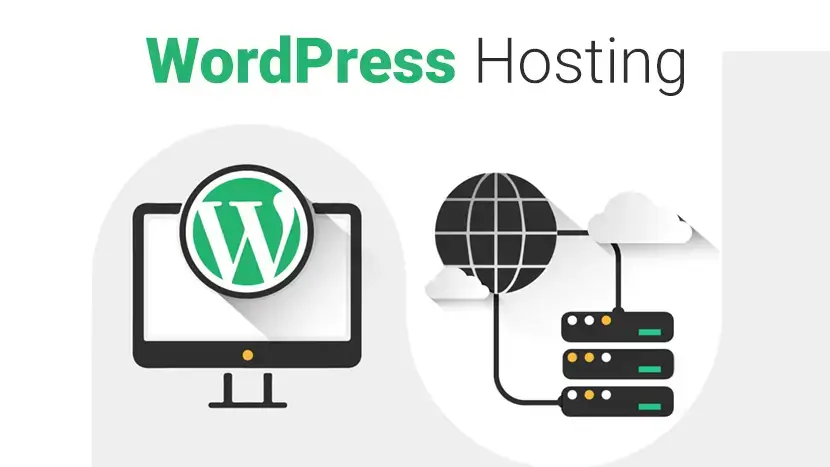
In this post, we’re going to tackle head-on the confusion that seems to keep coming up in the world of hosting with the terms WordPress hosting vs Web Hosting.
Using some form of web hosting is essential if you want to take your business online. Picking the right host can boost your site’s SEO, increase your sales, and provide tools and packages to help your business. But what is the difference between WordPress hosting and web hosting, and which is the better option?
WordPress hosting and web hosting are two very different types of hosting and are not to be confused. There are a few key differences between the two, and each has its own advantages, plans, and providers. Here’s a guide to WordPress hosting vs. web hosting and how to differentiate and choose between the two.
What is WordPress hosting?

In a nutshell, WordPress hosting is a form of web hosting optimized to run WordPress sites.
By using a WordPress host, you’ll receive lots of tools and services that are specifically tailored to WordPress sites. These may vary depending on what WP hosting service you opt for, but often include features such as one-click-install, automatic software updates, and a team of support staff who specialize in WordPress to provide you with customized support.
What is web hosting?
Web hosting is a much more general term and describes the process of an individual or organization buying a spot online to make their website accessible on the Internet.
A web host works by allocating space on a server to store the files associated with your website and by providing internet connectivity for your site. This allows your website to go live on the Internet and appear in search results.
Web hosting is very much an umbrella term, and there are lots of different types of web hosting, as well as different providers and features. If you plan on creating a website for your business, you’ll need to use some form of web hosting because you won’t be able to get your site online without a host.
What’s the difference between web hosting and WordPress hosting?
The key difference between web hosting and WordPress hosting is that web hosting is a much broader, overarching service, while WordPress hosting refers to a specific niche tailored to WordPress installs.
Web hosting is a more generalized service and refers to any hosting service that stores a site’s files on a server to make the site live on the Internet. A web host will cater to a wide range of site builders, and the websites stored on one of their servers may be operating on thousands of different platforms.
WordPress hosting, on the other hand, is a specific niche in web hosting. WordPress hosting can also use shared servers to host multiple websites at once but, unlike web hosting, every website on a shared server will be a WordPress site. A WordPress host caters specifically to WordPress installs and offers customized solutions, services, and support optimized for WordPress performance.
How to choose the best hosting option for your business
With over 338,561 web hosting service providers available worldwide, it can be difficult to choose the right one for your business – especially if you’re still deliberating between WordPress hosting vs. web hosting.
Both options have their advantages and are available from a wide range of providers in a variety of plans. To choose the best option for your business, keep in mind the key things a business needs in a web hosting service:
- Dedicated 24/7 customer service
- Supported domain name management
- Basic security features
- Uptime guarantee
- Server accessibility
WordPress Quick Overview
WordPress powers 35% of all websites on the Internet right now – and with a 4% annual growth, this is set to rise. WordPress is a hugely popular site builder and is used by businesses such as eBay, The New York Times, and Sony to create and power their websites.
According to research, WordPress is the most used CMS, and more than 1.1 million new domains are registered every six months. If you’re looking to create a business website or migrate your existing one, WordPress is a leading site builder – and it’s a noteworthy hosting option, too.
WordPress is an easy-to-use, simple, and fully customizable hosting option, and using a WordPress hosting service alongside your WP site will optimize your site’s performance and results.
WordPress hosting benefits
1. Improved Security : WordPress hosts offer servers equipped against WordPress-specific threats alongside a dedicated team who will stay on top of security issues and ensure your site is safe and secure.
2. Fast set-up and Performance : The website set-up process is made incredibly quick using pre-configured web technologies and the WordPress servers ensure fast loading times and quick uptime from the moment your site’s live.
3. Better Plugin Function : You won’t need to use as many plugins with a managed WP hosting service, because performance, security, and caching will all be optimized by the host. And for the plugins you do want or need, WP hosted sites are optimized to work with the most popular of them, which can be automatically updated.
4. Easy-to-add SSL Certificates : Most managed WordPress hosting plans allow you to add an SSL certificate to your site in a couple of clicks, at no extra charge.
5. Automatic Updates : Your website will receive automatic updates and upgrades, and security packages can be added to every website on a server at once.
6. Tailored Support : When using a WordPress hosting service, you’ll be able to access dedicated customer support services, experts in resolving WordPress issues.
Who should use WordPress hosting?
If you built your website using WordPress, you’ll benefit hugely from using WordPress hosting. WP hosting integrates perfectly with websites built with WordPress and will improve your site’s functioning, security, and offer automatic updates. You don’t have to use WordPress Hosting if you have a WordPress website, but combining the two creates the ultimate package.
Those looking for a managed hosting plan would benefit from WordPress hosting, too. WordPress hosts often offer managed services, where your site is run and maintained for you by WP experts. This is a great option for those with limited time or experience with running a website.
Web Hosting and WordPress Hosting Plans
Whether you choose to use WordPress hosting or web hosting, you’ll have to choose a hosting plan. Shared hosting, VPS hosting, Dedicated server hosting, and Cloud hosting are popular services offered by both WordPress hosts and web hosts.
WordPress hosts also offer some additional managed hosting services that can help with the running of your site.
Here are six of the most popular hosting plans available:
1. Shared Hosting : When you use a shared hosting plan, your website will share a server with other clients. This is a cheaper option and is easy to set up, making it ideal for those who are creating a starter website or who don’t have much site traffic.
2. Virtual Private Servers : A VPS plan is similar to shared hosting; you will share your server with other users, but you will be more isolated and have your own allotted space. This plan is ideal for those operating on a lower budget and who want a higher level of control and customization.
3. Dedicated Server : If you have a high-traffic website and need optimized performance and fast loading speeds, a dedicated server is a good choice. Dedicated servers offer you total customization, improved reliability, and the chance to scale your business up; but they are a high investment option.
4. Cloud Hosting : This is a relatively new type of hosting, where your website is hosted on a cloud infrastructure rather than stored on a physical server. This hosting plan has lots to offer to those looking for scalability and stability at a cheaper price, but pricing isn’t always fixed, so if your site experiences an increase in traffic, you might see an unexpected rise in costs.
5. Managed WordPress Hosting : Lots of WordPress hosting providers offer a managed service, where the host manages and runs all the technical aspects of your WordPress site for you. Managed Hosting plans can be run across any of the hosting plans listed above, and offer optimum security, performance, and configuration.
6. Optimized WordPress Hosting : If you’re looking for a hosting plan that offers pre-installed features and technologies to optimize your site, Optimized WordPress Hosting is a great choice. Optimized WordPress Hosting is a complete package plan and comes with pre-installed WordPress hosting, WordPress optimized servers, built-in WordPress security, and WordPress expert support.
Which plan you choose will depend on your budget, the amount of traffic your site receives, and how much help you want from your host in the running of your site.
List of WordPress Web Hosting Service Providers:
Read More : You can explore here 30+ Best Web Hosting Providers 2023
Video - Best Web Hosting For Small Business
Affordable Website Hosting for your domainIf you found this article helpful, we encourage you to share it on your social media platforms—because sharing is caring! For more information about article submissions on our website, feel free to reach out to us via email.
Send an emailWritten by RGB Web Tech
Latest Technology Trends
Latest technology trends shaping the future, including AI advancements, blockchain innovation, 5G connectivity, IoT integration, and sustainable tech solutions. Explore breakthroughs in quantum computing, cybersecurity, augmented reality, and edge computing. Stay ahead with insights into transformative technologies driving innovation across industries and revolutionizing how we live, work, and connect.
What is Cloud Web Hosting?
Last updated on January 19, 2025 by RGB Web Tech
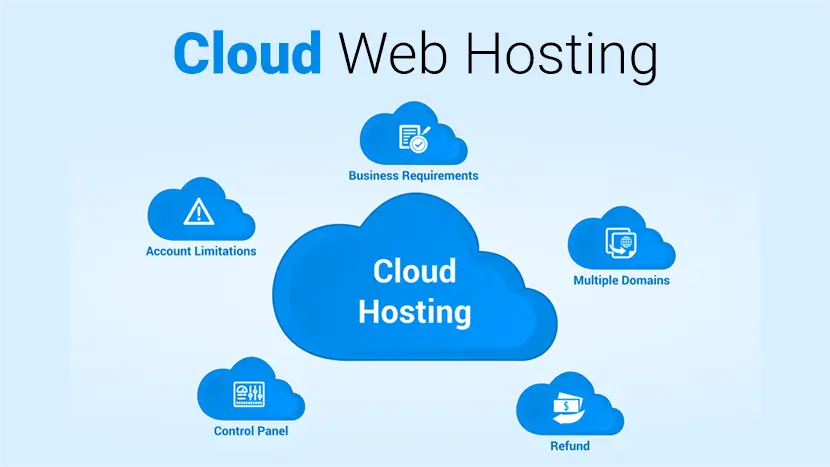
Cloud hosting is a type of web hosting which uses multiple different servers to balance the load and maximize uptime. Instead of using a single server, your website can tap into a “cluster” that uses resources from a centralized pool. This means that even if one server fails, another kicks in to keep everything running.
Visualize the cloud as a web of different computers which are all interconnected. As more machines are hooked up to the network, more resources are added to the overall cloud.
With cloud hosting, you get a part of the so-called cloud cluster. As opposed to traditional web hosting, where you get a certain amount of space from a single server.
Advantages of Cloud Hosting
There are many advantages of using cloud hosting over shared, VPS, or Dedicated hosting.
- Cost-Effective : One of the biggest reasons why businesses are switching to cloud hosting is because it is more cost-effective than the technology that runs on-premise. With traditional hosting, companies would have to spend money on disks or other storage devices and an IT team to look after these devices. But, with cloud hosting, you simply need to pay the vendor from which you are buying the resources. This saves resources, money, and time for the company. We can all agree on how important that is.
- Easy to Implement : When hosting on the cloud, businesses get to hold on to the same business processes and applications without dealing with the backend features. Since it is managed via the Internet, cloud infrastructure is easily accessible for companies.
- Scalability and Flexibility : A cloud server requires payment for only the used resources. A company does not always stay the same; it has the possibility to expand and shrink. Cloud hosting is also easily scalable which makes it easier for companies to add or remove resources according to their needs. The system grows with the company without extra burden on the company.
- Backup and Disaster Recovery : With every company, there is a risk of data and even financial loss. It is necessary that a company have a disaster recovery program. With cloud hosting, disaster recovery is rarely needed since data backups are automatic. This redundancy in data storage makes the possibility of losing data highly unlikely.
- Accessibility : With the Internet, it is so much easier to access data that is stored on web-based applications from anywhere. Having information that is stored in the cloud makes it much easier for that data to be accessed from anywhere and at any time regardless of the machine. This easy accessibility is one of the biggest advantages of cloud hosting.
Disadvantages of Cloud Hosting
Bandwidth Issue : Cloud hosting depends fully on the Internet. This means that a company needs to always have the Internet that it can rely on and is consistent. The Internet also has to have a fast connection and good bandwidth for the company to be able to take full benefit of the service. If you live in an area that does not have access to a good Internet connection, cloud hosting might turn out to be less fruitful for you.
Limited Control : The servers that host the cloud services are managed by the service providers. The providers are also the ones who own these servers. This makes it difficult for companies using these services to have the type of control that they want over their infrastructure.
Privacy: One of the biggest issues of Cloud hosting could be security issues that can arise if a person without some kind of technical knowledge is trying to use the service. You need technical assistance to benefit from the service. Another reason for security issues could arise from using a service that requires companies to share resources.
Vulnerable to Attacks: The biggest problem when using a web-based application or any kind of web-based service is that the Internet is filled with people who are looking to profit off of someone else’s loss. It is not unusual for a web-based service to get hacked or have a data breach.
When using a cloud hosting service, it is important to note that there are several other companies using the same service from the same vendor as you. This can result in information theft either via hackers or via a company that is in competition with your company. Even though security measures are applied in the cloud, the risk of attacks is something to consider before using this type of service.
Downtime : One of the biggest potential downsides to using a Cloud hosting service is downtime. The service providers, the vendors, can also face technical difficulties on their side. This could be power loss or faulty internet connections, maintenance of data centers causing them to go out of service for some time.
Conclusion : Just like with everything else, cloud hosting might not be the best option for every business. With the growing use of the Internet for almost everything, it is probably best to stay up to date with current technologies so that you are not left behind on progress. It is important to note that the advantages outweigh the disadvantages of cloud hosting but it might not be a necessity for everyone.
List of Cloud Based Web Hosting Service Providers:
Read More : You can explore here 30+ Best Web Hosting Providers 2023
Video - Best Web Hosting For Small Business
Affordable Website Hosting for your domainIf you found this article helpful, we encourage you to share it on your social media platforms—because sharing is caring! For more information about article submissions on our website, feel free to reach out to us via email.
Send an emailWritten by RGB Web Tech
Latest Technology Trends
Latest technology trends shaping the future, including AI advancements, blockchain innovation, 5G connectivity, IoT integration, and sustainable tech solutions. Explore breakthroughs in quantum computing, cybersecurity, augmented reality, and edge computing. Stay ahead with insights into transformative technologies driving innovation across industries and revolutionizing how we live, work, and connect.
What is Managed Web Hosting?
Last updated on January 19, 2025 by RGB Web Tech

Managed dedicated hosting is an IT service model where a customer leases dedicated hardware from a managed hosting services provider. This solution includes servers, storage, and networking hardware. Because you aren’t sharing these resources with anyone else, it’s referred to as a single-tenant solution.
When you choose managed dedicated hosting, you get to choose your operating system while your service provider handles the administration, management, and support of your solution. And because you’re not sharing any of these resources with another tenant, you have access to the full performance capabilities of the hardware you’re leasing.
Managed Web Hosting Pros & cons
Pros:
- Time-saving (managing and maintenance is taken care of so you can focus on your core business).
- Cost-saving (no expensive upgrading hardware, no IT staff to run and maintain the server needed, no own servers, therefore no risks of damages).
- Reduced risk (technical support of highly specialized technicians always available).
- Reliable (managed hosting service level agreement guarantee that your site is continuously available and monitors all important operations).
- Flexible and fast solutions (e.g., scalability).
- Technology is always up-to-date (a professionally managed hosting company provides you access to the latest technology).
Cons:
- No own server storage and network.
- Control is given away to the hosting provider; therefore, a highly professional and reliable company has to be chosen.
Unmanaged Web Hosting Pros & cons
Pros:
- Own servers.
- Fully and autonomous control over processes and operations
Cons:
- Time-consuming (you have to manage and maintain your networks, storage, servers, updates, etc.).
- Can be costly (specialized IT staff for running and maintaining the server has to be employed, defect hardware has to be renewed).
- Support depends on the working of team members.
- Scalability is not given or complicated.
- Usage of the latest technology depends on the budget.
Summed up, the benefits of managed web hosting are quite obvious.*
Conclusion
Managed hosting services are recommended for your e-commerce shop. While unmanaged hosting was a popular solution in the past, day to day, managed hosting services are providing individual solutions easily and comfortably.
By outsourcing your hosting to a reliable hosting provider, you are making the right choice.
Managed hosting ensures you get the latest technology combined with the professional support of highly specialized experts.
Having such a powerful hosting solution working for you in the background enables you to concentrate on your main business like never before.
List of Managed Hosting Service Providers:
Read More : You can explore here 30+ Best Web Hosting Providers 2023
Video - Best Web Hosting For Small Business
Affordable Website Hosting for your domainIf you found this article helpful, we encourage you to share it on your social media platforms—because sharing is caring! For more information about article submissions on our website, feel free to reach out to us via email.
Send an emailWritten by RGB Web Tech
Latest Technology Trends
Latest technology trends shaping the future, including AI advancements, blockchain innovation, 5G connectivity, IoT integration, and sustainable tech solutions. Explore breakthroughs in quantum computing, cybersecurity, augmented reality, and edge computing. Stay ahead with insights into transformative technologies driving innovation across industries and revolutionizing how we live, work, and connect.
6 Types of Website Design for your Website or Blog
Last updated on January 19, 2025 by RGB Web Tech

With 94% of first impressions relying on website design, you must create a beautifully crafted website for your business or blog. But when you get started with web design service or looking for a web design package, you may not know what approach to take with your website. What types of web design are best for your business or blog?
Luckily for you, we have got all the answers. Keep reading to learn about six types of web design and the pros and cons of each:
- One Page Website
- Responsive Website
- Static Website
- Dynamic Layout
- Liquid Website
- Adaptive Website
Plus, we will cover the different types of websites you can create, so you can determine which one is best for your business! Need some marketing inspiration?
Subscribe to our email newsletter for more updates!
6 Types of Web Design for your Website or Blog
Ready to build your website but are not sure which web design format is best? Here are six of the most common web design layouts for your business and the pros and cons of each.
1. One Page Website
We will cover on our list of types of web design as a one page layout website. As the name implies, a one page layout website uses only a single page that users scroll down to find information about your products or services. With this design layout, you can have a “Navigation Menu” with links to specific points of your page.
Pros of Single Page Website:
- Easy to create.
- Can help you create a clean and simple website.
Cons of Single Page Website:
- Can not be used for businesses that sell products online.
- Can not be used for companies that need multiple pages.
- Can deter people away if the single page is too long and requires too much scrolling.
2. Responsive Website
Next on our list of types of website layouts is responsive design layout website. This layout format is the most popular type, as it allows your site to accommodate all devices and fill the browser size perfectly. Responsive design is built with a mobile first approach.
You create your mobile layout first, and then you expand your website for bigger browser sizes. So instead of trying to trim down your website and make it smaller, you start small and build it bigger.
Pros of Responsive Website:
- Get a website that’s built for mobile users.
- Delivers a seamless experience on all devices.
- Do not have to build a separate mobile site.
Cons of Responsive Website:
- Takes more time to build and develop.
3. Static Website
Most basic type of website design is a static page layout website. With this layout, you build a website with pre-set page dimensions. It has a permanent width. Static layouts stick to these dimensions, regardless of the browser or device type.
Static layouts have phased out with the rise of mobile usage. Since these sites do not adapt to devices, they do not provide a positive user experience on smartphones or tablets. While static layouts are still an option, you typically do not want to use them unless you are creating a completely separate mobile version of your site.
Pros of Static Website:
- Easy to set up.
Cons of Static Website:
- Not responsive to devices or browsers.
- Requires creating a separate mobile site (more work).
4. Dynamic Website
When you look at a list of the types of web design, you will see that the dynamic website layout is an option. Dynamic website layouts are great for people who do not have extensive HTML knowledge. These websites can deliver different content to website visitors, even if two separate people look at the same page.
With a dynamic website vs. static website, you build a database of information and features. Then, when a user requests a page, the web coding automatically works to put the components together from your database to form the webpage.
Pros of Dynamic Website:
- Interactivity with users.
- Increased functionality for users.
- Less coding skills required.
Cons of dynamic Website:
- Can be more complex to set up with different functionalities.
- Tend to load slower because of all the different elements and page compositions.
5. Liquid Website
Next on this list of types of website design is liquid design layout website. This layout, also known as Fluid Design, uses flexible units rather than the fixed units static layouts use. Since the units are flexible, the page will always fill the width with the device’s screen, regardless of what device it is.
Because user experience is critical to your site driving and engaging traffic, liquid layouts have also started to phase out as a viable option for businesses. While you can still use this layout, you risk delivering a poor user experience from your site stretching too far or squishing information together on the page.
Pros of Liquid Website:
- Easier to set up than responsive design
- No information gets cut off on pages
Cons of Liquid Website:
- If a browser is really wide, information gets stretched to fit the screen and can look unappealing
- If a browser is smaller, information gets smooshed together to fit the screen, making it difficult to read and browse
6. Adaptive Website
One web design format you can use for your site is adaptive website layout. As the name implies, this website uses CSS queries to adjust the website’s size to detect the size of the browser. Adaptive websites will automatically alter the website’s layout to provide the best user experience for visitors.
With adaptive website layouts, there are set parameters for how a website will adjust. For example, a set parameter may look like this: “If the browser is 500 pixels wide, set the main content container for 400 pixels wide.” For example, if you have a website with a two-column layout, the adaptive layout would change into a single-column design on a small browser screen.
Pros of Adaptive Website:
- Easy to set up.
- Takes less development time than responsive layouts.
- Can adjust your website according to each browser size.
Cons of Adaptive Website:
- Device widths in between set points can cause your site to have too much space or not enough space.
- Is not fully responsive.
Types of website layouts
Here is a list of different website layouts and which sites benefit the most from them:
1. F-shape layout
The f-shape layout creates a website design that follows the general viewing pattern of the site's visitors. Scientific studies have found that website users often view and move their eyes across a web page creating an F or E shape. Webpages that design their layout to match those instinctive eye movements can help capture visitors' attention more naturally. These types of layouts are most common for websites that display a lot of options for users to choose from, such as news websites and search engines, allowing users to scan the options quickly and make a decision.
2. Z-shape layout
The z-shape layout is very similar to the f-shape layout, except it targets a different group of individuals. Scientific studies have shown that individuals from western cultures use a z shape with their eyes more often than an f shape to navigate the pages of different websites. Z-shape layouts are often most effective for websites that have a singular goal, such as having consumers sign up for a service or purchase a product. Creating a button that navigates users to the next step of company interaction and placing it along the z-shape path can help increase customer outreach and revenue.
3. Grid of cards layout
A grid of cards layout displays information in a grid system that users or website visitors can easily manipulate by adjusting the size of the browser window or screen. Some of the most common sites that use a grid of cards layout are video streaming websites that display image previews for their different video options. They display each of the previews as cards in a grid system, and the number of visible video options changes based on the size of the screen.
A grid layout is great for websites, like video streaming services, that display a lot of options and information of equal value, which can help users find what they're looking for more easily.
4. Boxes layout
The boxes layout uses one larger box as a website's header, which displays an image and two smaller boxes underneath that provide additional images or information for users. Each box gives the user important or engaging information about the company's or website's purpose and links the user to other dynamic web pages they can explore to find more helpful information. Because the boxes can prominently display images, artists often use this layout to show their portfolio and businesses use it to display featured products.
5. Split screen layout
A split screen layout divides a website into two sections that users can choose to explore. This layout works well for companies and organizations that have two pieces of content that are equally important to their business and consumers. For example, a clothing company that sells women's and men's clothing might use the split screen layout to advertise their products. Having both options on the front webpage can allow users to pick which one they're looking for quickly and continue exploring the site.
6. Fixed sidebar layout
The fixed sidebar layout places a stationary menu of options for users on the left or right side of the webpage. This sidebar menu provides visitors with quick and helpful navigation choices, allowing them to explore the website more easily. The fixed sidebar layout often works best with websites that have a limited number of webpages to choose from, such as businesses that sell one major product. For example, if a company that sold watches used a fixed sidebar, some of their menu options could include: about us, online store and contact us.
7. Magazine layout
The magazine layout uses a design that resembles printed publications. This design displays a lot of information to visitors by using a system of columns and grids to help individuals navigate the webpage more easily. The magazine layout is often used by publication companies to resemble how their product might look in its printed form, which can help create a fun and engaging format for users, motivating them to continue reading and exploring.
8. Asymmetrical layout
Asymmetrical layouts ensure that the webpage promotes an uneven design, meaning one half of the page is often larger than the other. Companies and organizations often use this layout to create an aesthetically pleasing web page while directing users to a certain area of the site.
For example, a business might use the larger section of the website to display an image or company slogan, while using the smaller side to encourage users to fill out their contact information to learn about special sales and promotions. The smaller section often attracts the visitor's attention, encouraging them to engage with the website or company. Because of its ability to entice users, the asymmetrical layout is often used on a website's homepage.
Featured image layout
The featured image layout places a prominent and large image at the top of the webpage to attract users. Most often, the featured image is a picture of a popular product that a company or business is selling. Companies that sell aesthetically pleasing products often use this type of layout to immediately attract visitors' attention and encourage them to make a purchase. For example, a company that sells computers might use a featured image layout to display their computers' design and style.
10. Curated visuals layout
The curated visuals layout uses illustrated images to promote a product or service. Companies and organizations often use this layout to display a certain emotion they want users to feel when they use the webpage. This type of advertising strategy can help consumers feel motivated to interact with the company and possibly purchase their goods and services. Most often, businesses or companies with a complicated service that's difficult to sell might use curated visuals to help ease the experience and relay necessary information to users.
Types of websites
4 Types of websites you can create
In addition to narrowing down your list of types of website layouts to the best one, you also must determine what kind of website you need to create for your business. Every business has different needs, which means your site type may differ from others.
Here are four types of websites you can create for your business:
1. Business websites
First on our list is the type of website you can create as a business website. A business website is a standard site. It contains information about your company and the services you offer. If you do not sell products online, you may also build a business site just to showcase what you offer.
These sites are simple and serve as a hub for people to learn about your business. You can use this website type if you are not selling products on your website. For a business website, you can use any of the types of web design listed above. You will want to choose the ones that help you deliver the best experience for your audience.
2. Blog
Second on our list is the type of website you can create as a blog. Blogs are websites that share helpful information with readers about topics in their industry. While a blog may not be your company’s primary website, you may consider creating a blog site if you are doing content marketing.
Content marketing is a crucial strategy for helping your business grow online and build trust with your audience. You may consider having a separate blog website, or integrating it into your core website to help you take advantage of the benefits of content marketing.
This website type can use any type of web design format, except for one page layout website.
The best types of web design layouts for this website type are adaptive and responsive.
3. Ecommerce websites
Another type of website you can create for your business is an ecommerce website. This website type is best for your business if you want to sell products on your site. Ecommerce sites are built to host product pages, add products to a cart, and complete transactions.
If you’re looking to sell products, this website type is best for your business.
In terms of the best types of web design for an ecommerce website, responsive and adaptive are most suitable for an ecommerce site.
4. Membership websites
The last type of website you can create is a membership website. With this website type, you have a paywall for people to enter. Only people who have a membership can enter your site and see your products.
A1truejobs.com is a membership website example. You must create an account and pay the membership fee and become a member of the site.
If you want to use this website type, you can use two types of web design layouts: adaptive or responsive.
Need help figuring out which type of web design is best for you?
With so many types of web design available, it’s challenging to know which type is best for your business. If you’re feeling overwhelmed with building the best website, RGB Web Tech can help you to create a beautiful web design for your business or blog.
Our team experts can help you craft a beautifully designed website that delivers the best experience for your audience. Ready to build your dream website? Contact us online or call us today at +91-9878585860 to speak with a strategist about our web design services and affordable web design packages
If you found this article helpful, we encourage you to share it on your social media platforms—because sharing is caring! For more information about article submissions on our website, feel free to reach out to us via email.
Send an emailWritten by RGB Web Tech
Latest Technology Trends
Latest technology trends shaping the future, including AI advancements, blockchain innovation, 5G connectivity, IoT integration, and sustainable tech solutions. Explore breakthroughs in quantum computing, cybersecurity, augmented reality, and edge computing. Stay ahead with insights into transformative technologies driving innovation across industries and revolutionizing how we live, work, and connect.
What are Search Engine Optimization Strategies?
Last updated on January 19, 2025 by RGB Web Tech
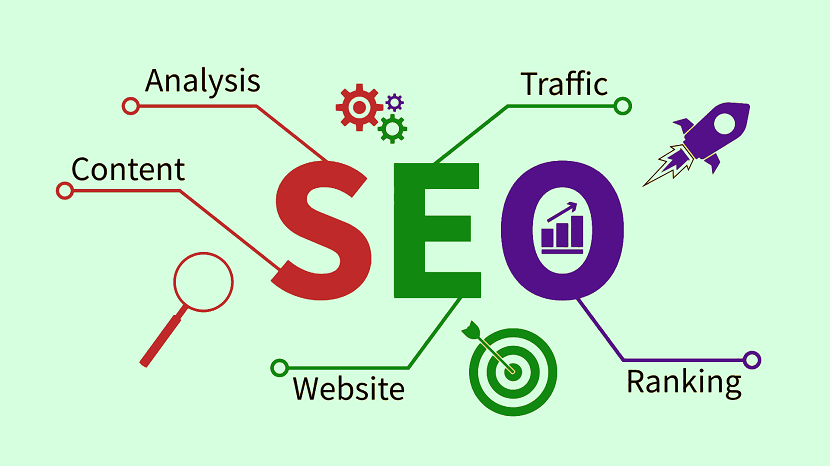
SEO stands for Search Engine Optimization and is the process of improving a website's performance, experience, and authority to gain better visibility in search engines like Google. The goal of SEO is to rank higher in organic (unpaid) search results.
SEO involves various strategies, including optimizing website content and structure, improving meta tags, using strategic keywords, and building backlinks. These tactics help the site appear higher in search engine results pages (SERPs), making it more likely that people will click through to the website. SEO is a critical component of digital marketing.
Contents Overview
What does SEO stand for?
SEO, or Search Engine Optimization, refers to the process of enhancing your website’s visibility in search results. Here’s what that entails:
- Search: This is the action people take to locate answers to their questions or to find products or services that suit their needs.
- Search Engine: Websites such as Google or Bing where users conduct searches.
- Search Engine Optimization: The strategies implemented to ensure that search engines link these searches to your website.
Types of SEO (Search Engine Optimization)
Search engine optimization (SEO) is a part of internet marketing that aims to increase a website's visibility in organic search results. SEO can be divided into two main types: On Page SEO, Off Page SEO, Technical SEO, Local SEO, Content SEO, Mobile SEO, eCommerce SEO, Image SEO and Video SEO.
1. On Page SEO
On-page SEO refers to the practices used to optimize individual web pages to help them rank higher and earn more relevant traffic in search engines. It involves both the content and the HTML source code of a page (as opposed to off-page SEO which involves links and other external signals). Here are the key elements of on-page SEO:
- Title Tags: Each page should have a unique title that includes the main keywords for the page. The title tag should be concise and informative, accurately reflecting the content of the page.
- Meta Descriptions: Although not a ranking factor itself, a well-crafted meta description can improve the click-through rate from search engine results. It should provide a brief summary of the page’s content and include relevant keywords.
- Headings and Content Formatting: Using headings (H1, H2, H3) to organize content is crucial for readability and SEO. The primary keyword should ideally be included in the H1 tag. Other headings can help structure the content and utilize secondary keyword phrases.
- URL Structure: URLs should be concise, include keywords, and be easy for a human to understand. A well-structured URL gives both users and search engines an idea of what the destination page is about.
- Keyword Optimization: Including relevant keywords in your content helps search engines understand what the page is about. However, keywords should be used naturally and not over-stuffed, as this can lead to penalties.
- Content Quality: The content of a page is crucial to its success. Google has continually emphasized the importance of high-quality, substantive, original content that satisfies the search intent of users.
- Images and Alt Text: Using images can make a page more engaging and informative. Alt text (alternative text) for images is used by screen readers and search engines to understand the content of pictures. It’s also useful for SEO when it includes relevant keywords.
- Mobile-Friendliness: With mobile devices accounting for a significant portion of web traffic, your site needs to be responsive and easy to navigate on smartphones and tablets.
- Page Performance: Websites that load faster provide a better user experience. Google considers page speed as a ranking factor, so optimizing your site’s speed is important.
- Internal Linking: Linking to other pages on your site helps search engines crawl your site more effectively and helps improve rankings for your other pages. It’s also useful for users, as it makes navigation easier.
2. Off Page SEO
Off-page SEO refers to the techniques used to improve the position of a website in the search engine results page (SERPs) that are implemented outside of the actual website. This aspect of SEO focuses on enhancing the perception of a site's popularity, relevance, trustworthiness, and authority. This is achieved through other reputable places on the Internet (pages, sites, people, etc.) linking to or promoting your website, effectively "vouching" for the quality of your content. Here are the key components of off-page SEO:
- Backlinks: The cornerstone of off-page SEO is building backlinks, which are links from other websites to your website. These can be achieved through natural links from external sites that link to yours without any action on your part, manually built links generated through deliberate link-building activities, and self-created links through adding a backlink in an online directory, forum, blog comment signature, or a press release with optimized anchor text.
- Domain Authority: Sites with higher domain authority are seen as more reputable and trustworthy, and links from these sites are more beneficial. Tools like Moz’s Domain Authority and Ahrefs’ Domain Rating help assess this metric.
- Social Media Marketing: While social media links don't directly impact search rankings, social media platforms can amplify the visibility of your content and increase your brand presence. This can lead to more people viewing your content and potentially linking back to it.
- Guest Blogging:Writing articles or posts for other relevant blogs can drive traffic back to your site through backlinks. This not only helps in creating more outreach but also enhances your reputation as an expert in your field.
- Influencer Outreach: Collaborating with influencers to promote your content can lead to natural backlinks, as their followers and other interested parties are likely to link to your content if it is valuable.
- Content Marketing: Publishing high-quality, valuable content is vital not just for on-page SEO but also for off-page tactics. Great content is more likely to be shared and referenced by other websites, blogs, and social media users.
- Forum Participation: Engaging in industry forums can help establish your expertise. By contributing to discussions and providing helpful answers, you can attract interest in your profile and website.
- Local SEO: For businesses with a physical location, off-page SEO includes managing local listings and citations in business directories like Google My Business, Yelp, and others. Accurate and consistent information across these platforms can improve your local search visibility.
- Brand Mentions: Google considers both linked and unlinked mentions of your brand. Getting your name out there through press releases, articles, or other content can influence your site’s search rankings.
- Reviews: Positive reviews, especially on authoritative platforms like Google My Business and Yelp, can enhance your business’s credibility and influence its search rankings.
3. Technical SEO
Technical SEO refers to the process of optimizing the infrastructure of a website to help search engines crawl and index it more effectively. This aspect of SEO focuses on the backend structure and foundation of a site, ensuring that the site meets the technical requirements of modern search engines with the goal of improved organic rankings. Key elements of technical SEO include:
- Site Speed: Enhancing how quickly your site loads is crucial as it affects user experience and search engine rankings. Techniques include optimizing images, reducing server response times, and leveraging browser caching.
- Mobile-Friendliness: With mobile-first indexing, Google predominantly uses the mobile version of the content for indexing and ranking. A mobile-friendly site is essential, and responsive design is the recommended approach to accommodate all device types and screen sizes.
- Crawlability: Search engines use web crawlers to understand the content of your site. Ensuring that these crawlers can access and interpret your site content without issues is critical. This includes proper use of robots.txt files to guide crawlers, creating and maintaining XML sitemaps, and avoiding deep nesting of pages.
- Security: Implementing HTTPS provides a secure connection by encrypting data between the user and the site, which is a factor Google uses for ranking.
- Structured Data: Using schema markup (structured data) helps search engines understand the content of your site and can enhance how your site appears in SERPs with rich snippets. These can include ratings, prices for products, or event information.
- Indexation: Ensuring that the pages you want are being indexed properly without duplication. Tools like Google Search Console can be used to monitor index status and optimize visibility.
- Canonical URLs: Use canonical tags to tell search engines which version of a page is the master or preferred version to address duplicate content issues.
- 404 Errors and Redirects: Properly managing 404 errors and setting up 301 redirects for pages that have moved permanently helps preserve link equity and improves user experience.
- Site Architecture: A well-organized site structure helps users and search engines find content on your site more easily. This involves a logical hierarchy for your content and ensuring that no important pages are more than a few clicks away from the homepage.
- Hreflang Tags: For sites that have content in multiple languages or regional variants, hreflang tags help search engines understand which version of the content is relevant to users in a specific region or language setting.
4. Local SEO
local SEO is a branch of search engine optimization that focuses on optimizing a business's presence to attract more business from relevant local searches. These searches take place on Google and other search engines but are specifically aimed at generating local results for users. Local SEO is crucial for businesses that have a physical location or serve a specific geographic area. Here are the key components of local SEO:
- Google My Business (GMB) Optimization: Setting up and optimizing your Google My Business profile is essential. This includes accurate and detailed business information such as your name, address, phone number, and business hours. Regularly updating the profile with posts, offers, and events can also help increase visibility.
- Local Keywords: Utilizing keywords that reflect local searches. This includes city or neighborhood names where the business is located. The content on your website should include these local keywords to improve local search rankings.
- Citations and Local Listings: Ensuring your business is listed on local directories and citation sites such as Yelp, YellowPages, and Bing Places. Consistency in business listings (name, address, and phone number) across these platforms is crucial for local SEO success.
- Reviews and Ratings: Encouraging customers to leave positive reviews on your Google My Business profile and other review sites. Responding to reviews, whether positive or negative, can also improve credibility and attract more local customers.
- Localized Content: Creating content that speaks to local news, events, or activities relevant to your business and area. This helps attract local customers and signals to search engines that your business is actively participating in the local community.
- On-Page SEO for Local Keywords: Besides integrating local keywords into the content, it’s important to optimize the title tags, meta descriptions, and header tags of your website with local SEO in mind.
- Mobile Optimization: With the increase in mobile searches, ensuring your website is mobile-friendly is essential, especially for local SEO, as many local searches are performed on the go.
- Backlinks from Local Sources: Gaining backlinks from well-regarded local sources (like local newspapers, blogs, and business associations) can significantly boost local search rankings.
- Structured Data Markup: Using schema markup to provide search engines with specific information about your local business, such as the type of business, operating hours, and location. This can enhance your search listings with rich snippets that attract more clicks.
- Local Maps Optimization: Ensuring your business appears correctly on map services like Google Maps. Accurate location data and a clear, precise map pin can help customers find your business more easily.
5. Content SEO
Content SEO refers to the aspect of SEO focused on creating and structuring content in ways that help improve visibility and rankings in search engine results pages (SERPs). It involves not only producing high-quality, relevant content but also ensuring it is optimized for both search engines and users. Here are the key components of content SEO:
- Keyword Research: Identifying the right keywords that your target audience is using to search for products or services like yours. This research informs the themes and topics of your content, helping ensure it meets the search intent of users.
- Content Quality: Producing high-quality content that is informative, engaging, and provides value to the reader. Search engines favor content that effectively satisfies user intent, keeping users engaged and on your site for longer periods.
- Content Freshness: Regularly updating existing content and adding new content to keep your website dynamic and informative. Fresh content is a signal to search engines that your site is current and relevant.
- Use of Keywords: Integrating targeted keywords naturally within your content, including in the title, headings, body text, and meta descriptions. The key is to use keywords thoughtfully and avoid over-optimization, which can lead to penalties from search engines.
- Content Structure: Organizing content using headings (H1, H2, H3) to make it easier to read and navigate. Proper use of headings helps search engines understand the structure and hierarchy of the content, improving indexing.
- Meta Descriptions and Title Tags: Crafting compelling meta descriptions and title tags that include relevant keywords. These elements can influence click-through rates from search results, drawing more traffic to your site.
- Image SEO: Including images with optimized file names and alt text descriptions can contribute to SEO efforts. Alt text helps search engines understand the image content and can improve accessibility.
- Internal Linking: Using internal links to connect content within your site helps search engines crawl the site more effectively and can keep visitors engaged longer by encouraging them to explore further.
- Content Length: While quality is more important than quantity, longer content can often provide more depth, increase engagement, and improve SEO performance. However, the length should be appropriate to the topic and user expectations.
- Readability and User Engagement: Ensuring the content is readable and engaging for the audience. This includes using simple language, short paragraphs, and visual elements to break up text, which can enhance user experience and retention.
6. Mobile SEO
Mobile SEO refers to the process of optimizing your website to ensure it performs well and provides a good user experience on mobile devices. As mobile traffic surpasses desktop traffic in volume, mobile SEO has become crucial for achieving high search engine rankings and capturing mobile user engagement. Here are the key aspects of mobile SEO:
- Responsive Design: Ensuring that your website is responsive, meaning it automatically adjusts to fit the screen size of the device being used. This is important because it improves usability, making it easier for mobile users to read and navigate your site.
- Mobile-First Indexing: Google predominantly uses the mobile version of the content for indexing and ranking since the majority of users now access Google search through mobile devices. This makes it crucial to prioritize the mobile version of your site in your SEO efforts.
- Page Speed: Mobile users often rely on mobile data, which can be slower than wired or WiFi connections, so page speed becomes even more crucial. Optimizing images, minifying code, leveraging browser caching, and reducing redirects can help increase mobile page speed.
- Touchscreen Navigation: Ensuring that your site is easily navigable with a touchscreen. This includes making buttons and links large enough to be clicked easily without zooming and spacing them adequately to prevent accidental clicks.
- User Experience (UX): Providing a good user experience is vital. This includes clear and readable fonts, accessible menus, and avoiding intrusive pop-ups and excessive interstitials that can frustrate users and lead to high bounce rates.
- Local SEO: Since mobile searches are often performed on the go, local SEO becomes even more important. Ensure that your business is listed in local directories, and use local keywords in your SEO strategy.
- Viewport Configuration: Setting the viewport (which controls how a webpage is displayed on a device) correctly ensures that your site can be viewed properly across different devices.
- Content Accessibility: All content on your site should be accessible on mobile devices, which means avoiding software like Flash, which isn’t supported on mobile.
- Mobile-Friendly Test Tools: Utilizing tools like Google's Mobile-Friendly Test can provide insights into how well your site works on mobile devices and highlight areas that need improvement.
- Avoiding Mobile-Specific Errors: These can include unplayable content, faulty redirects, or blocked JavaScript, CSS, and image files. Ensuring that mobile users have access to all necessary resources and content is crucial for good SEO.
7. eCommerce SEO
eCommerce SEO is the practice of optimizing online stores to rank higher in search engine results pages (SERPs) and attract more targeted traffic that can convert into sales. It involves a blend of general SEO practices along with strategies specifically tailored for eCommerce platforms. Here are the essential components of eCommerce SEO:
- Keyword Research: Conducting detailed keyword research tailored to eCommerce, focusing on product-specific keywords, category-specific keywords, and transactional keywords that indicate a readiness to buy.
- Site Structure: Designing an intuitive site structure that makes it easy for users to navigate and for search engines to crawl. Ideally, a user should be able to reach any product in three clicks or less from the homepage.
- On-Page SEO for Product Pages: Optimizing product pages with high-quality images, detailed and unique descriptions, product-specific metadata, and structured data (such as schema markup for prices, availability, and reviews).
- Optimized Category Pages: These pages should not only include category-specific keywords but also be designed to facilitate user navigation and improve product discoverability.
- Technical SEO: Ensuring that the website loads quickly, is secure (uses HTTPS), and is mobile-friendly, since many users shop on their mobile devices.
- Content Marketing: Creating valuable content that targets potential customers at various stages of the customer journey, from awareness to decision-making, which can include blogs, buying guides, and reviews.
- User Experience (UX): Providing an excellent user experience by having a fast, easy-to-navigate site with minimal friction in the checkout process and clear calls to action.
- Link Building: Acquiring high-quality backlinks from reputable sources to enhance domain authority. This can be achieved through collaborations, influencer marketing, and guest blogging on relevant sites.
- Social Signals: Leveraging social media platforms to boost product visibility and engagement, which indirectly supports SEO efforts by generating traffic and increasing brand recognition.
- Customer Reviews: Encouraging customer reviews, which can boost SEO through fresh, unique content and improve trust and conversion rates.
- Avoiding Duplicate Content: Especially common in eCommerce sites where product descriptions are often repeated across multiple pages or products. Utilizing canonical tags can help manage duplicate content issues.
- Local SEO: For eCommerce businesses with physical stores, integrating local SEO practices by including local keywords, creating a Google My Business profile, and gathering local reviews.
8. Image SEO
Image SEO is the practice of optimizing images to be discovered via search engines' image search features, contributing to the overall SEO performance of a website. It's particularly important for websites that rely heavily on visuals, such as eCommerce sites, art galleries, or recipe blogs. Optimizing images can enhance user experience, reduce page load times, and improve rankings. Here are key strategies for effective image SEO:
- Relevant Images: Use images that are relevant to the content of the page. Relevant images enhance the user experience and reinforce the textual content for better understanding and retention.
- File Names: Choose descriptive, keyword-rich file names for your images. Instead of naming an image "IMG_123.jpg," use meaningful names like "homemade-chocolate-chip-cookies.jpg" that describe the image and include a target keyword.
- Alt Text: Alt text (alternative text) is used within an HTML code to describe the appearance and function of an image on a page. Alt text helps search engines understand the image content, which is crucial for SEO. It's also vital for accessibility, helping screen readers interpret the image for people with visual impairments.
- Image Compression: Optimize image file sizes to reduce load times without compromising quality. Tools like Adobe Photoshop, TinyPNG, or JPEGmini can reduce file size, enhancing page speed—a factor in Google's ranking algorithms.
- Image Format: Choose the right file format for your images. JPEG is good for most photos due to its balance of quality and file size. PNG is preferable for graphics with fewer than 16 colors or when you need transparency. WebP is a modern format that provides superior compression and quality characteristics compared to JPEG and PNG.
- Responsive Images: Ensure images display well on all devices, especially on mobile. Using responsive image techniques, such as the HTML srcset attribute, allows different image versions to load depending on the user's screen size and device capabilities.
- Structured Data: Using structured data (schema markup) can help to provide search engines with more information about the images and how they relate to other content. For example, if you have a recipe site, using structured data can link images directly to recipes.
- Sitemaps: Include images in your XML sitemaps or create a dedicated image sitemap. This makes it easier for search engines to crawl and index your images, potentially increasing their visibility in image search results.
- Accessibility: Ensure that your images do not obstruct site accessibility. Use CSS styling to position images and make sure they are integrated seamlessly with the design for users on all types of devices.
- SEO-Friendly Image Hosting: Host your images on a server that quickly delivers images to users. Slow-loading images can hurt your SEO and user experience.
9. Video SEO
Video SEO involves optimizing video content to increase its visibility and ranking on search engine results pages as well as within video search engines like YouTube. It is an important aspect for businesses and content creators who use video to communicate with and engage their audience. Effective video SEO can drive more traffic to your website, enhance user engagement, and increase conversions. Here are key strategies for optimizing your video content for search engines:
- Keyword Research: Just like traditional SEO, video SEO requires targeted keyword research. Identify keywords relevant to your video content that potential viewers are likely to use during their search queries.
- Video Titles and Descriptions: Optimize your video titles and descriptions with relevant keywords. The title should be catchy, informative, and include main keywords. The description should provide a detailed overview of the video content, including long-tail keywords, without keyword stuffing.
- Video Hosting Platform: Decide where to host your video based on your goals. Hosting on your own site can increase traffic to your site and is good for exclusive content. Using popular platforms like YouTube or Vimeo can enhance visibility and reach due to their large built-in audiences and high domain authority.
- Thumbnail Image: A compelling thumbnail can significantly increase click-through rates. The thumbnail should be visually appealing and relevant to the content of the video.
- Video Transcripts: Adding a text transcript of your video content can greatly improve indexability and accessibility. Transcripts act as page text and are beneficial for SEO as they're crawlable by search engines.
- Video Sitemaps: Create a video sitemap and submit it to search engines. A video sitemap includes important metadata about your video content such as the video title, description, play page URL, thumbnail, and video file URL, which helps search engines understand and index your video content more effectively.
- Engagement Metrics: Encourage viewer engagement by asking for likes, comments, and shares. High engagement rates are a positive indicator to search engines regarding the quality of your content.
- Embedding and Sharing Options: Enable embedding and sharing options to increase the likelihood of your video being shared and linked to. More embeds and links can lead to higher rankings in search engines.
- Social Media Promotion: Promote your videos on social media platforms to increase visibility. More shares and traffic can lead to higher rankings both on traditional search engines and within video platforms like YouTube.
- Accessibility Features: Including features like captions and audio descriptions can make your videos more accessible to a wider audience, including those who are deaf or hard of hearing, which can also improve your SEO.
- Loading Time and Mobile Optimization: Ensure your videos load quickly and are optimized for mobile viewing. This affects user experience and can impact search rankings, especially on mobile devices.
- Watch Time: For platforms like YouTube, watch time is a critical ranking factor. Create engaging and valuable content that compels viewers to watch through to the end.
Type of SEO Techniques
SEO (Search Engine Optimization) involves various techniques to improve the visibility and ranking of websites in search engine results. These techniques can be classified into different types:
1. White Hat SEO
White Hat SEO refers to the use of optimization strategies, techniques, and tactics that focus on a human audience opposed to search engines and completely follow search engine rules and policies. Here are some key aspects of White Hat SEO:
- Quality Content: Creating content that is original, relevant, useful, and well-written. The goal is to provide value to the user, not just to rank well in search engines.
- Keyword Usage: Using keywords naturally and strategically, without overstuffing. This involves placing them where they make the most sense in terms of context and readability.
- Backlinking: Gaining links from reputable and relevant websites. Unlike Black Hat SEO, White Hat SEO focuses on quality over quantity and on getting backlinks through legitimate ways like guest blogging, content marketing, and natural partnerships.
- Mobile Optimization: Ensuring the website is mobile-friendly, considering that a significant amount of searches are done via mobile devices. This includes responsive design and fast loading times.
- Site Architecture: Structuring a website clearly and logically. A well-organized site helps search engines index your content more effectively and improves user experience.
- Meta Information: Proper use of meta titles, descriptions, and tags that accurately describe page content and encourage higher click-through rates.
- User Experience (UX): Focusing on making the site user-friendly, which includes having a clear navigation, engaging design, and accessible content.
2. Black Hat SEO
Black Hat SEO refers to the use of aggressive SEO strategies, techniques, and tactics that focus primarily on manipulating search engine algorithms to gain higher rankings, rather than serving a human audience. These practices are against search engine guidelines and can result in severe penalties from search engines like Google. Here are some common Black Hat SEO techniques:
- Keyword Stuffing: Overloading webpages with keywords in an unnatural way to manipulate a site's ranking. This often results in a poor user experience.
- Cloaking: Showing different content to search engines than to users. This technique tries to deceive search engines to rank content for particular keywords that are not actually relevant to the user's actual content.
- Doorway Pages: These are low-quality pages that are overloaded with keywords and are designed only to attract search traffic and then redirect visitors to a different webpage.
- Hidden Text and Links: Implementing text or links that are invisible to visitors but visible to search engine crawlers. These are often used to manipulate the relevancy of content in search results.
- Link Farms: Participating in communities where large numbers of pages are created to hyperlink to each other, solely to increase the number of inbound links to a site. This can artificially increase a site's ranking.
- Content Automation: Using software to generate content automatically, often without regard to quality or relevance. This can include scraping content from other sites and publishing it as new.
- Malicious Behavior: Including malware, phishing, or other malicious techniques to redirect or deceive users.
3. Gray Hat SEO
Gray Hat SEO is a practice that falls between White Hat and Black Hat SEO. It involves strategies that are not as clearly defined by search engine guidelines but could be considered questionable or might become classified as Black Hat SEO in the future. These techniques are often used by those looking to gain a competitive edge without crossing into outright Black Hat practices, but they still carry risks, including potential penalties if search engines update their algorithms and policies.
Here are some common Gray Hat SEO tactics:
- Article Spinning: Using software to rewrite content so it appears unique, although it's essentially the same content, often with a slight decrease in quality. This is done to avoid duplicate content penalties and create more content faster.
- Link Exchanges: While link building is a legitimate practice, excessive reciprocal links or partner pages exclusively for the sake of cross-linking can be considered manipulative.
- Buying Expired Domains: Some practitioners buy expired domains that have built up authority and either use them to create link networks or redirect the traffic to their primary website.
- Cloaking with a Twist: Slightly altering the technique of cloaking, such as showing search engines a character-level variation of content that isn't exactly what the user sees.
- Dubious Redirects: Redirecting a high-ranking page to another page to transfer the SEO benefits in a way that isn't entirely transparent.
- Paying for Reviews: Encouraging reviews with incentives or paying for them outright, which can sometimes blur the line between genuine user reviews and sponsored content.
- Using Clickbait: Employing sensationalist headlines that aren’t completely aligned with the content on the page to boost click-through rates.
4. Negative SEO
Negative SEO refers to the practice of using Black Hat and unethical techniques to sabotage a competitor’s rankings in search engines. It's a malicious tactic that targets other websites with the intention of causing harm to their search engine credibility and rankings. Here are some of the common methods employed in negative SEO:
- Link Farms: Creating or purchasing large numbers of spammy links and directing them to a competitor's website in an attempt to trigger a Google penalty for unnatural links.
- Scraping Content: Copying content from a target website and distributing it across the internet. This can dilute the uniqueness of the content and potentially lead to penalties or decreased rankings due to duplicate content issues.
- Creating Fake Social Profiles: Misrepresenting the target company on social media to create a bad reputation or spread false information.
- Forceful Crawling: Causing heavy server loads by intentionally sending very high volumes of automated requests to a website, making it slow or even temporarily inaccessible.
- Removing Backlinks: Contacting websites that link to a competitor’s site and requesting the removal of those links, often by pretending to be the competitor themselves.
- Posting Negative Reviews: Flooding review sites with negative feedback and reviews to harm a business’s reputation and search engine standing.
- Hacking the Site: Gaining unauthorized access to modify or deface the website, insert malicious code, or negatively affect its SEO performance directly.
Benefits & Importance of SEO (Search Engine Optimization)
SEO (Search Engine Optimization) is crucial for any business or individual seeking to increase their online presence and visibility. Here are some of the key benefits and reasons why SEO is so important:
- Increased Website Traffic: SEO helps to improve the ranking of your website on search engines. Websites that appear on the first page of search engine results tend to get significantly more traffic. This increased visibility means more visitors, which can translate into more sales and leads.
- Cost-Effectiveness: Compared to other forms of online marketing, such as Pay-Per-Click advertising, social media marketing, or purchasing leads for an email marketing program, SEO provides a relatively good return on investment. While PPC may drive more revenue and social media may be more important for your image, organic SEO in many ways remains a bedrock of your online presence.
- Improved User Experience: SEO involves optimizing the user experience of your website. A well-optimized site is more likely to have clear navigation and relevant, engaging content that meets the needs of users. Search engines like Google prioritize websites that provide a good user experience.
- Brand Credibility and Trust: Ranking higher in search results can also improve the credibility of your business. Users tend to trust the first listings in Google as reputable companies; the further back you are in rankings, the more skeptical users might be about your site.
- Higher Conversion Rates: SEO-optimized websites load faster, are easy to read and navigate, and will display properly in almost all types of devices, including mobile and tablets. Websites that are easy to read and navigate are more likely to grab and hold attention from your readers or visitors – i.e., they’re more likely to become your loyal customers, subscribers, and returning visitors.
- Long-Term Marketing Strategy: While the impacts of a good SEO strategy may take time to manifest, they can be long-lasting. With ongoing effort, the results of SEO can be sustained, unlike advertising which stops the moment you stop paying.
- Competitive Advantage: By investing in your SEO strategy, you can move ahead of your competitors in search engine rankings. This can help you gain market share by being more visible and accessible than your competitors.
- Local SEO Increases Engagement, Traffic & Conversions: Local optimization focuses on specific towns, cities, regions, and even states, to establish a viable medium for a brand's messaging on a local level. SEO pros do this by optimizing the brand’s website and its content, including local citations and backlinks, as well as local listings relevant to the location and business sector a brand belongs to.
Frequently Asked Questions (FAQs)
Search Engine Optimization (SEO) is a critical component of digital marketing. Here are some frequently asked questions (FAQs) about SEO that might help you understand it better:
1. What is SEO?
Answer : SEO stands for Search Engine Optimization. It involves optimizing a website or content to improve its visibility and ranking in search engine results pages (SERPs). This is done through various techniques such as optimizing content, improving site structure, and building backlinks.
2. Why is SEO important?
Answer : SEO is important because it helps increase the visibility of a website, attracting more traffic from organic searches. This can lead to increased brand awareness, higher sales, and more engagement.
3. What are the key components of SEO?
Answer : The key components of SEO are On-page SEO, Off-page SEO and Technical SEO
4. How do search engines rank websites?
Answer : Search engines use algorithms to determine the relevance and authority of pages. Factors that influence rankings include the quality and relevance of content, the user experience on the website, the number and quality of backlinks, and technical aspects of the site.
5. Can I do SEO myself?
Answer : Yes, it's possible to do SEO yourself, especially if you have a basic understanding of website management and online marketing. There are many resources available online to learn SEO, from blogs and tutorials to comprehensive guides and courses.
6. How long does it take to see results from SEO?
Answer : SEO is a long-term strategy. Typically, it can take several months to a year to see significant changes in search rankings due to the competitive nature of rankings and the time it takes for search engines to recognize and index changes.
7. Is SEO different from SEM?
Answer :Yes, SEO (Search Engine Optimization) is different from SEM (Search Engine Marketing). SEO focuses on optimizing a website to get traffic from organic search results, while SEM includes tactics like paid advertising (PPC) alongside SEO strategies to increase visibility.
8. How do I know if my SEO efforts are working?
Answer :You can track your SEO progress using tools like Google Analytics and Google Search Console. These tools provide insights into traffic, rankings, and conversions, helping you understand the effectiveness of your SEO strategies.
9. What are some common SEO mistakes to avoid?
Answer : Common mistakes include keyword stuffing, neglecting mobile optimization, using duplicate content, and ignoring meta tags and descriptions. It’s also a mistake to neglect the quality of content while focusing solely on SEO tactics.
10. How does content affect SEO?
Answer :Content significantly affects SEO because it helps to establish relevance and authority. High-quality, relevant content is more likely to be shared and linked to, which boosts SEO. Regularly updated content is also favored by search engines.
Conclusion
SEO, or Search Engine Optimization, is an indispensable strategy in the digital marketing landscape, aimed at enhancing the visibility and ranking of websites in search engine results. By leveraging techniques that span on-page optimization, off-page activities, and technical enhancements, businesses can attract higher organic traffic, improve user engagement, and increase their online authority. While SEO demands patience and consistent effort, the benefits are substantial, offering long-term gains in visibility and competitive advantage. As search algorithms evolve, staying informed and adaptable is crucial, making SEO an ongoing, integral part of any successful digital marketing strategy. Thus, businesses that invest wisely in SEO can expect to not only boost their online presence but also secure a significant edge in the increasingly crowded digital marketplace.
You might also consider exploring our lists of Profile Creation Sites and Directory Submission Sites to build quality backlinks for your SEO.
Additionally, we've put together a Technical SEO Checklist tailored for SEO professionals, which you might find useful.
If you find this article beneficial, please share it on your social media channels. Remember, sharing is caring!
If you found this article helpful, we encourage you to share it on your social media platforms—because sharing is caring! For more information about article submissions on our website, feel free to reach out to us via email.
Send an emailWritten by RGB Web Tech
Latest Technology Trends
Latest technology trends shaping the future, including AI advancements, blockchain innovation, 5G connectivity, IoT integration, and sustainable tech solutions. Explore breakthroughs in quantum computing, cybersecurity, augmented reality, and edge computing. Stay ahead with insights into transformative technologies driving innovation across industries and revolutionizing how we live, work, and connect.
Social Media Marketing for Businesses
Last updated on January 19, 2025 by RGB Web Tech
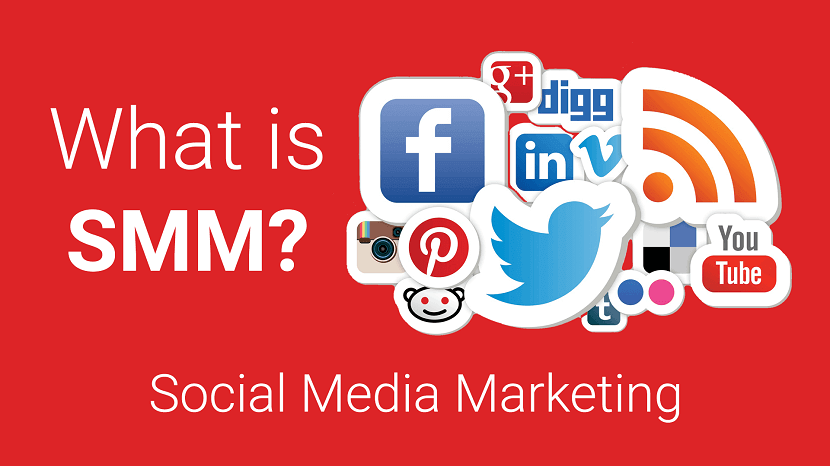
When you use social media marketing, whether on Facebook, Twitter, Instagram, LinkedIn, or another platform, you’re engaging and interacting with your audience on multiple levels, building their brand awareness and interest to drive leads and sales.
You can create devoted fans of your business through your social media strategy.
What is social media marketing?
Social media marketing is a digital marketing strategy that uses social media to promote your business online.
When you market your business with social media, you use different social media networks, like Facebook or Instagram, to connect, engage, and communicate with your target audience, as well as promote your products or services to drive brand awareness, website traffic, and sales.
It sounds easy enough, but there is more to SMM than meets the eye.
This guide serves as your partner for getting started with social media and learning the basics of social media. Use it to learn how to bring social media and marketing together. Plus, get inspiration from real-life social media marketing campaigns.
Social Media Marketing Guide Definitions
Here are some common terms you need to know when developing your social media marketing strategy.
- Content : Content is whatever you post on social media. It can be a Facebook status update, a video on Instagram, a Tweet, and so on. Content comes in many different forms, and you need to tailor it to each platform. What’s even more important than content, though, is context.
- Context : Gary Vaynerchuk said, “Content is king, but context is God.” For instance, you might have a great joke, but if you place it somewhere inside a 3,000-word blog post, very few people are likely to see it. On Twitter, however, that same joke as a tweet might crush it. Plus, anyone can get in on the fun. When looking at the most retweeted, funniest Tweets ever, we can see even the CIA sees the value in using social media to create some positive buzz.The opposite is also true. Packaging your entire blog post into one tweet is hardly possible, so try a good call to action with some relevant hashtags instead. And that brings us to hashtags.
- Hashtags : By now, you probably know that hashtags are a very common tool that people use to add meta information on almost all social media channels. Twitter, Facebook, Instagram, and Pinterest all use hashtags to let you describe the topic of your content or mark it as part of current trends.They make your content easy for users to discover and therefore more likely that they’ll share it.
- Shares : Shares are the currency of the social media world. When people engage and interact with your content, that’s good. But when they share it, that is the time to celebrate. A great social media tool to measure shares and the overall impact of content is BuzzSumo. The more shares, the more people love your content. Shares are the best form of engagement that people can have.
- Engagement : This is a general term referring to how people interact with the content that you produce. It can be a like, a reaction, a comment, or a share. All of these are good, but the shares are where it’s at. Now that we’ve covered some social media definitions, let’s take a look at the core pillars of social media.
Core Pillars of Social Media Marketing
There’s no doubt about it: these days, your business needs to be on social media, and you should concentrate at least some of your marketing efforts (and budget) on your social media strategy.
With 4.48 billion people owning social media accounts, there’s a whole world of potential customers that any business can access, simply by logging in and creating brilliant content.
Brands like BooHoo, Depop, and Chipotle excel at social media, and there’s one simple reason: they integrate the core pillars of social media marketing.
There are five main pillars. Let’s talk through them one by one.
1. Strategy
A sound social media marketing strategy is the backbone of your social media presence. Without a strategy, you’re wasting time, unlikely to achieve your goals, and will most likely struggle to reach your target audience.
In case you’re not sure, a content strategy consists of getting the “Right content, to the right people, at the right time.”
In its most basic terms, a content strategy helps you achieve your business goals by enabling you to:
- Create Valuable Content
- Drive Engagement
- Increase Conversions
A good social media marketing strategy has clear goals, specific plans to reach those goals, and must be measurable.
Finally, you need to set benchmarks to see how things are going and whether you need to change your approach.
2. Planning and Publish
Social media is a powerful tool, but you can’t just go out there and start publishing content without a plan behind it.
When you’re planning content make sure that you:
- Know your audience: You need to know the demographic of your audience in order to connect with them.
- Focus on quality: The quality of content is just as important as the quantity.
- Consider your brand: Keeping in line with your brand values is crucial.
When it comes to publishing, there is one golden rule: consistency. A regular publishing schedule keeps people coming back for more.
3. Listening and Engagement
Plan your content and above all, actually engage with your audience.
Your feedback might not always be positive; but, if you don’t make changes, neither will the tone of your responses.
Listening and engagement are all part of a successful digital transformation, especially if you’re going to enhance the overall customer experience.
It’s also worth mentioning that social listening isn’t just about customer experience. It can allow you to:
- Pick up on New Trends
- Identify New Streams of Income
- Gain Industry Insights
- Find Influencers in Your Niche
Need some assistance to get started with social listening? Hootsuite has a free introductory tool for measuring key terms and hashtags.
4. Analytics
The success of any social media marketing campaign depends on analytics for tracking and collecting data. Without this information, you can’t:
- Understand user behavior
- Refine your strategy
- Find which platform works best for your brand
- Discover the best times to post
- Analyze your competitors
Once you have all this, you’ll know with certainty what works and what doesn’t. That way you can spend more time on what does, and waste less. In turn, analytics will inform the decisions that you make for future campaigns—and highly influence the success rate.
Similarly, A/B testing is great for determining what content, design, CTA, etc. work best.
If you’ve been noticing certain types of content receiving double the engagement than other posts, play on that.
For example, if you’re a small business, your followers are most likely going to be family and friends who will love the personal insight and celebratory posts because they care about you and your successes.
Producing high-quality content that your audience isn’t interested in will mean that engagement levels tank. You need to work on making sure your posts appear in people’s feeds before you start feeding through those insightful industry blogs.
5. Advertising
For anyone looking for an audience, social media advertising is worth exploring. With approximately 2.89 billion active monthly users on Facebook alone, that’s an incredible amount of prospects.
The three main types of social media advertising are:
- Organic: Content that picks up views naturally and you don’t pay for.
- Paid: Content that an organization sponsors and therefore costs money to post.
- Earned: Content that has been given freely in the form of shares, likes, and comments.
In today's digital age, the demand for captivating online content is at an all-time high, particularly for social media platforms. To meet this demand and create engaging posts and videos, content creators often rely on the expertise of an online video editor. As a powerful tool, an online video editor enables creators to transform their raw footage into visually appealing content that stands out in the crowded social media landscape. With features like trimming, merging, adding transitions, and applying special effects, an online video editor empowers creators to craft professional-looking videos that capture attention and drive engagement.
There are several ways you can advertise on social media. For example, you can:
- Create content: This includes posts and videos.
- Promote content: Create posts that are promoted/sponsored.
- Engage with people: Get active in groups related to your industry, interact with influencers in your industry, etc.
- Grow a following: Get people in your industry to follow your brand by creating and sharing content that appeals to them.
- Get downloads: Offer PDFs, white papers, PowerPoints, videos, podcasts, etc. on your social channels and profiles.
Additionally, if you aim to enhance your brand recognition, build loyalty, and increase conversion rates, advertising could be the way to go.
Aside from these main pillars, you should also:
- Ensure you focus your content on a specific niche or demographic.
- Build quality connections with influencers, brands, and customers you can build relationships with.
- Add value with your content and comments
Finally, ensure you’re accessible on social media so your customers know they can reach out to you. Don’t just wait for feedback. Invite it!
Different Types of Social Media Marketing
Aside from the likes of Facebook, Twitter, and Instagram, social media marketing takes many different forms, such as:
- Content Marketing / Content Creating
- Advertising / Sponsorship
- Influencer Marketing
- Social Media Management / Community Management
- Paid Media
- Building Your Following
- Contributing to Forums
- Reviews
If you’re serious about growing your brand, don’t just focus on the large sites with a vast audience. Although they’re an obvious place to start, look for different, more creative ways to engage your prospects and develop leads.
Also, while you’re exploring some of these other methods, find which content works best for each channel to optimize your results.
FAQs of Social Media Marketing
1. What is meant by social media marketing?
Social media marketing (SMM) is a form of internet marketing that uses social media apps as a marketing tool. These social media platforms enable brands to connect with their audience to build a brand, increase sales, and drive traffic to a website.
2. What is an example of social media marketing?
Social Media Marketing (SMM) is marketing that targets social platforms like Facebook, Instagram, TikTok for brand promotion, target audience growth, driving website traffic, and increasing sales.
3. What is the role of a social media marketer?
Social media marketers are marketing specialists who use social media platforms to promote a company's offerings. They often use platforms like Facebook, Instagram, Twitter, and TikTok to reach new customers, engage with current ones, and announce new products or services.
Conclusion
It's clear that social media marketing has its advantages, so if your business doesn't already have the appropriate profiles, create them! Fill out your business' information and post some engaging content to begin gaining followers. As mentioned, ask people relevant to your business to "like" and "share" your page to help build your profile. With consistent updating, the right social media marketing strategy will lead to increased traffic, better SEO, higher conversion rates, improved brand loyalty, and much more. There are virtually no reasons not to implement social media into your marketing strategy. Since it is so cost-effective, there is hardly anything to lose. Your competition is most likely already on social media, so don't let them take your potential customers. The sooner you start, the sooner you'll see growth in your business.
If you found this article helpful, we encourage you to share it on your social media platforms—because sharing is caring! For more information about article submissions on our website, feel free to reach out to us via email.
Send an emailWritten by RGB Web Tech
Latest Technology Trends
Latest technology trends shaping the future, including AI advancements, blockchain innovation, 5G connectivity, IoT integration, and sustainable tech solutions. Explore breakthroughs in quantum computing, cybersecurity, augmented reality, and edge computing. Stay ahead with insights into transformative technologies driving innovation across industries and revolutionizing how we live, work, and connect.
What is Reputation Management?
Last updated on January 19, 2025 by RGB Web Tech
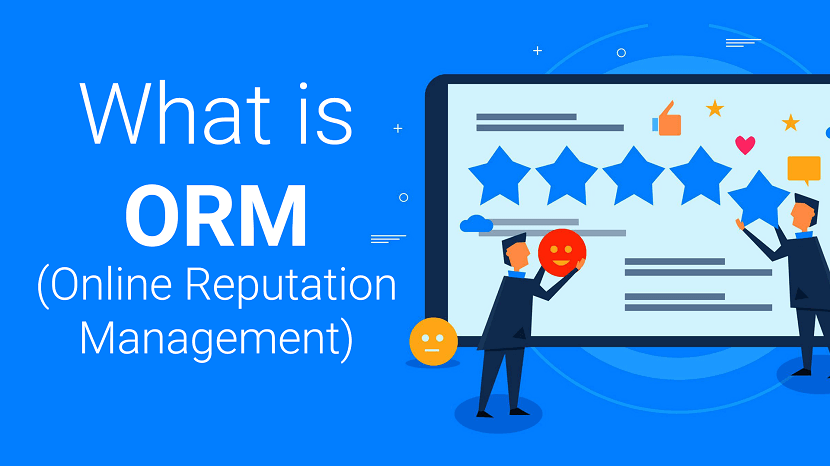
Only a decade ago, things like PR and reputation management seemed like matters of concern for big businesses and celebrity personas. And it seemed like smaller brands had little to care about; their brand perception was a one-way alley with customers having little room for feedback.
After all, they could just choose to ignore the business’s products and services, but their perception had little impact. But we are now living in an era of an active audience, one where people express their opinions about brands and services on several platforms online all the time.
And, with 71% of consumers starting their customer journey with a Google search, no business can afford to show up on the SERPs appearing untrustworthy and disreputable.
To avoid any potential issues, here is an extensive guide on Online Reputation Management for businesses of any size and industry to help digital marketing professionals discover effective ways to manage their brand’s online reputation.
What is Online Reputation Management (ORM)?
Online Reputation Management, or ORM, (not to be confused with online review management) is a multi-faceted concept that is aimed at creating a positive public perception of a brand, business, or person. Reputation management includes monitoring reputation, addressing any content or customer feedback that could damage the brand, and using strategies to prevent and solve problems that could damage an entity's reputation.
How Online Reputation Management Works
In a nutshell, ORM is all about monitoring and managing your brand’s reputation across the web, about ensuring that your business is properly represented and that potential customers are left with a great impression on who you are and what you do.
That said, multiple channels fall within Online Reputation Management, and since it may seem overwhelming at first to embrace all these channels, let’s think about them in terms of the PESO model.
The 12 main benefits of managing your online reputation
Here are the top reasons why it’s worth considering implementing an online reputation management process for your business:
1 Improving brand credibility
Let’s face it – negative comments are bound to come up, regardless of how much effort you invest into keeping your buyers happy. And customers can be merciless – according to PwC, 32% of shoppers would walk away from a brand after just one bad experience.
That said, it all comes down to how you handle a negative brand mention once it shows up. When you manage your online reputation and respond to comments, reviews, and mentions (both positive and negative), you build credibility. There’s no better way to show that you care about your customers than by responding to a negative comment gracefully and making amends, whenever need be.
2 Boosting customer engagement
The more channels your organization monitors and is active on, the higher your chances of boosting your customers’ engagement rates. This is possible by embracing both a proactive and reactive approach to client interactions. By being active online, providing customers with special offers, and responding to their queries and comments swiftly, you can keep them invested in your brand. As a result, they will be less tempted to churn and move to your competitors.
3 Increasing sales
While spontaneous shopping still happens from time to time, most of us do online research prior to buying. In fact, 81% of consumers admit that they surf the Internet gathering information about the product they’re planning to purchase before they do so. Sometimes, one negative review is enough to change our minds and make us lean more towards other products. There is a link between good online reputation and increased sales – the more positive company mentions appear, the higher the chance of closing a sale.
4 Optimizing online marketing to trigger reactions
Monitoring your online reputation can also be a great source of inspiration for your marketing initiatives. In a tool like SentiOne, you can check how your audience reacted to your past content and marketing campaigns. For instance, below is an example of how people reacted to two announcements by mBank, one of the biggest banks in Poland. The first spike, in mid-October 2020, relates to the brand’s support of the All-Poland Women’s Strike, while the second, in January 2021, is a response to the bank’s participation in the country’s biggest charity event, The Great Orchestra of Christmas Charity.
Through tracking your reach and brand mentions, you’ll know which campaigns work and which don’t, what messaging resonates with your customers and leads, and what kind of actions drive negative reactions. Summarizing your findings will help you decide what marketing campaigns to run, which will result in higher ROI.
5 Building trust
Trust is the basis for forming long-lasting relationships with customers, which supports business growth. However, as mentioned earlier in the reputation management definition, responding to brand mentions in your owned media only won’t be enough. Even if you have a good brand reputation today, you can’t take it for granted as there are many threats lurking around the corner. Just imagine what could happen if you failed to notice a major website slamming you in their review!
It’s also necessary to verify the information posted about brands online to make sure it’s consistent and true. This can be certainly achieved by using a tool that tracks and alerts you about mentions from all parts of the web.
6 Showing customers that you care
Monitoring what people say about brands online and responding to both negative and positive comments shows them that you care. Naturally, all of us would like to receive flattering comments only, and these are certainly easier to respond to. However, negative comments can also prove beneficial to a brand long-term. They are a source of invaluable feedback – take into account what customers say and fix the issues. Never ignore disheartening opinions as they might escalate into a social media crisis. Responding to both positive and negative comments will help you build better relationships with customers.
7 Encouraging recommendations
Did you know that 90% of people believe in brand recommendations from friends? Considering the fact that consumers casually talk about brands 90 times per week – online reputation management is definitely something that you should care about. Since people tend to trust other people more than their trust advertising, making sure that you get a continuous flow of word-of-mouth recommendations through effective online reputation management is key.
8 Increasing web traffic
Positive news or opinions – especially those coming from reputable sources – have the potential of becoming viral. With an online reputation management tool, for instance, you’ll be able to spot a top news outlet lauding your service. This will explain any sudden spikes in organic traffic. You can use this to gain further momentum. Display the positive review/brand mention across your online channels to boost your reputation. If done well, this can result in increased conversion.
9 Attracting employees
A positive online reputation not only translates into increased sales but can also attract a lot of interest from potential job seekers. The best candidates are keen on working for companies with a good reputation – and since the war for talent is fierce, it might help companies get the best employees on board.
10 Easier to deal with potential crises
Brands that put in the effort to maintain a good online reputation are overall better equipped to deal with any crisis. Especially if they use an ORM solution that alerts them of any crisis-related terms used in relation to their brand. Also, a gentle stumble will be easier forgiven by customers if a brand has an overall positive reputation.
11 Improving your Brand Health & Customer Satisfaction scores
Online reputation management gives you the chance to react quickly to mentions of your brand. In the case of unflattering reviews on your owned channels, you can make amends quickly and, perhaps, change the customer’s negative opinion into a neutral or positive one. This could have a positive outcome on your customer satisfaction scores like CSAT or NPS.
Respectively, in the case of external channels, ORM will give you a chance to advocate for your brand and quickly put an end to any detrimental rumors.
12 Getting more testimonials for your website
Last, but not least, if you use an online monitoring tool like SentiOne, not only will you be able to identify brand mentions but also filter out the positive ones. You can then reach out to your most delighted fans and ask them for a citation which you can then turn into a testimonial to place on your website. To kickstart your efforts, think of places like Google Play, Apple App Store, and specialized online review platforms.
FAQs - Online Reputation Management1. What does online reputation management mean?
Online reputation management is the process of controlling the online narrative of a person, company, or brand. It consists of reputation protection, monitoring, crisis management, and reputation recovery. 88% of consumers perform online research before making a purchase.
2. Is reputation management illegal?
These tactics are always unethical and, in some cases, illegal. Some black hat reputation management tactics include creating a slew of false accounts to report competitors, developing fake websites for review placements, and developing spam content.
1. What does online reputation management mean?
Online reputation management is the process of controlling the online narrative of a person, company, or brand. It consists of reputation protection, monitoring, crisis management, and reputation recovery. 88% of consumers perform online research before making a purchase.
2. Is reputation management illegal?
These tactics are always unethical and, in some cases, illegal. Some black hat reputation management tactics include creating a slew of false accounts to report competitors, developing fake websites for review placements, and developing spam content.
Final Thoughts - Online Reputation Management
As we’ve mentioned in the online reputation definition provided in this post, there are a variety of actions you need to take to maintain a positive view of your brand online. Regardless of your industry, it is crucial to track, collect, analyze, and manage your brand reputation. If you engage in ORM continuously, there are numerous benefits you can expect, including:
- Building Customer Trust
- Increasing Sales
- Optimizing your marketing campaigns to trigger positive reactions and boost ROI.
The best way to manage your online reputation is by using an online monitoring tool like SentiOne. You’ll be able to monitor countless online sources including social media, blogs, forums, and portals in real-time. By listening to online conversations and analyzing what customers or leads say about your or your competitors, you’ll be able to identify and respond to any potential PR crisis.
If you found this article helpful, we encourage you to share it on your social media platforms—because sharing is caring! For more information about article submissions on our website, feel free to reach out to us via email.
Send an emailWritten by RGB Web Tech
Latest Technology Trends
Latest technology trends shaping the future, including AI advancements, blockchain innovation, 5G connectivity, IoT integration, and sustainable tech solutions. Explore breakthroughs in quantum computing, cybersecurity, augmented reality, and edge computing. Stay ahead with insights into transformative technologies driving innovation across industries and revolutionizing how we live, work, and connect.
What is Mobile App Development?
Last updated on January 19, 2025 by RGB Web Tech

The mobile app development industry is going through a transformative phase. With the advancement in micro-processing technologies, you will be able to run mobile applications on multiple platforms. For example, apps built for mobiles will run seamlessly on desktops in the coming years. Moreover, mobile apps built with Flutter or React Native will work on Android Phones, iPhones, Macs, as well as PCs. But before we get more in-depth, let’s dig into the mobile app usage statistics to understand how users are spending their time using mobile phones, and what are the opportunities in building your own mobile application.
Mobile App Development Lifecycle
There are over 3.5 billion smartphone users worldwide, so there is no doubt that the industry is healthy and thriving. Stats are growing steadily, without any indications of slowing down. And studies show that an average American checks their phone at least once every twelve minutes, and over 10% of these people check their phone about every four minutes. There are some more statistics to keep in mind.
- People spend over half of the time they spend with digital media on mobile.
- Smartphone users spend 90% of their screen-on time using mobile apps.
- Over 85% of consumers prefer native apps over mobile cross websites.
- Revenue from mobile apps is set to cross $693 billion in 2021.
- The average consumer has over 30 apps installed on their device.
- An average user spends about 35 hours per month using mobile apps.
The statistics are motivating for anyone who wishes to build or develop a mobile app. But before we jump to any conclusions, let’s understand the exact process for mobile app development. Although it sounds very lucrative to build a mobile app to get a piece of the billion-dollar pie, the decision needs thought, strategy and planning. The fact also states that your app will be competing with over 1.5 million applications on the Google Play Store and Apple’s App Store.
What is Mobile App Development?
Mobile app development is a process for building mobile applications that run on mobile devices. These applications can either be pre-installed or downloaded and installed by the user later. They use the network capabilities of the device to work computing resources remotely. Hence, the mobile app development process requires creating software that can be installed on the device, and enabling backend services for data access through APIs, and testing the application on target devices.
To develop scalable mobile apps, you also need to consider screen sizes, hardware requirements, and many other aspects of the app development process. With an increasing number of jobs in the mobile app development industry, it is essential that the process is well defined and understood by entrepreneurs, startups, and especially developers.
Types of Mobile Apps
- Native Apps
- Cross-Platform Apps
- Hybrid Apps
- Progressive Web Apps
Mobile App Development Platforms
The two most important mobile app platforms are iOS from Apple Inc. and Android from Google. iOS is Apple’s proprietary mobile operating system built specifically for iPhones. Android, however, runs on mobile devices manufactured by various OEMs, including Google.
While there are many similarities between the two, different software development kits (SDKs) are used for different platforms. Apple uses iOS exclusively for their own devices, while Google has made Android available for other companies that meet specific requirements. Developers have built over 1.5 million applications for both platforms to date.
- React Native
- Flutter
- Xamarin
- Swiftic
- Ionic
- Apache Cordova
- jQuery Mobile
- Native Scripts
- Sencha Ext JS
- Onsen UI
Which is the best programming language for mobile apps?
There are several programming languages for different sorts of tasks. Choosing the right language for the mobile app is different from choosing one to learn. The right selection yields solutions that are concise, easy to code, easy to scale, easy to debug and fix.
Often people will tell you that there is no choice and that all languages are equal and are developed to fulfill a particular purpose. However, it can be quite confusing, if you are new in the mobile development arena and lack information about programming languages.
So, if you are in a confused mess, the following factors can you help you choose the best language easily:
- The targeted platform.
- Elasticity of the language.
- The time to produce.
- Performance, support, and community.
- The purpose of building the app.
- Efficiencies of the programmer.
Here is a top mobile app development languages
- JavaScript
- Kotlin
- C++
- C#
- Python
- PHP
- Swift
- Objective C
- JAVA
- HTML 5
- Ruby
- Rust
- Lua
- Action Script
- SQL
- Dart
Best Practices for Mobile App Deployment
Once the user installs the application, you should work on minimizing uninstalls, delivering the best user experience, keeping up with the competition, and achieving maximum financial benefits in the long run. Regularly maintaining your mobile application to create a sustainable brand image in the minds of the users. Here’s a list of best practices for long-term app development.
- Monitor the performance of your mobile application. Keep an eye on loading types, if there are any lags, or if there are any responsiveness issues. This will help you stay ready with your analytics report. Analyze your retention rates, churn rates, and try to understand usage patterns.
- Keeping your user interface updated is also one of the ways to maintain your mobile application. Customers align themselves with changing styles, trends, habits, and other essential features of the apps that need constant updating. If you keep your app interface the same, your customers might gradually start preferring other competing apps with similar features.
- Ensure that your app supports the latest software updates and hardware updates. A new version of the mobile operating system is released every year. Think about how many mobile devices can be upgraded to the latest version of that OS, and thus your app?
- Fixing bugs can win customers. No software application is ever published with proper testing. However, bugs are an integral part of mobile app development. Fixing bugs can display your faith and dedication towards your users and also towards your mobile phones.
- Regularly add new features to your app. You can do this by observing how users are interacting with your app. With the help of insights received, you can discover what’s working for your user, and what isn’t.
FAQs - Mobile App Development
1. What is App Development?
Mobile application development is the process of making software for smartphones and digital assistants, most commonly for Android and iOS. The software can be preinstalled on the device, downloaded from a mobile app store or accessed through a mobile web browser.
2. What is a Native App?
Native apps are developed for specific mobile operating systems such as iOS or Android. Platform-specific language is used to build these apps. For example, (native) Android apps use Java, while iOS apps use Objective – C or Swift.
3. What are cross-platform apps?
Cross-platform mobile development is the creation of software applications that are compatible with multiple mobile operating systems. Originally, the complexity of developing mobile apps was compounded by the difficulty of building out a backend that worked across multiple platforms.
4. What are Hybrid Apps?
Hybrid apps are essentially web apps that have been put in a native app shell. Once they are downloaded from an app store and installed locally, the shell is able to connect to whatever capabilities the mobile platform provides through a browser that's embedded in the app.
5. What is Progressive web Apps?
A progressive web application, commonly known as a progressive web app, is a type of application software delivered through the web, built using common web technologies including HTML, CSS, JavaScript, and WebAssembly.
6. What Are The Best Mobile App Development Platforms?
BuildFire, Flutter, Microsoft Xamarin and Adobe PhoneGap are the best mobile app development platforms.
7. Mobile App Development Platforms
The two most important mobile app platforms are iOS from Apple Inc. and Android from Google. iOS is Apple’s proprietary mobile operating system built specifically for iPhones. Android, however, runs on mobile devices manufactured by various OEMs, including Google.
Conclusion
There’s a lot to unpack with mobile app development. But whether you’re creating cross-platform apps or native apps, you always need to prioritize the user experience.
Your app’s functionality needs to meet its primary use case, and the interactive features must be easy to navigate.
There are tons of different paths to take for app development. The best option for you depends on your budget, goals, timeline, technical skills, and app complexity,
Overall, BuildFire is the best option to consider because the platform is so versatile. BuildFire has a no-code DIY solution that’s great for entrepreneurs. We also offer full-service app development that includes post-launch maintenance and support.
Want to learn more? Request a free consultation to chat with one of our app development experts.
If you found this article helpful, we encourage you to share it on your social media platforms—because sharing is caring! For more information about article submissions on our website, feel free to reach out to us via email.
Send an emailWritten by RGB Web Tech
Latest Technology Trends
Latest technology trends shaping the future, including AI advancements, blockchain innovation, 5G connectivity, IoT integration, and sustainable tech solutions. Explore breakthroughs in quantum computing, cybersecurity, augmented reality, and edge computing. Stay ahead with insights into transformative technologies driving innovation across industries and revolutionizing how we live, work, and connect.
Comparison of App Development
Last updated on January 19, 2025 by RGB Web Tech
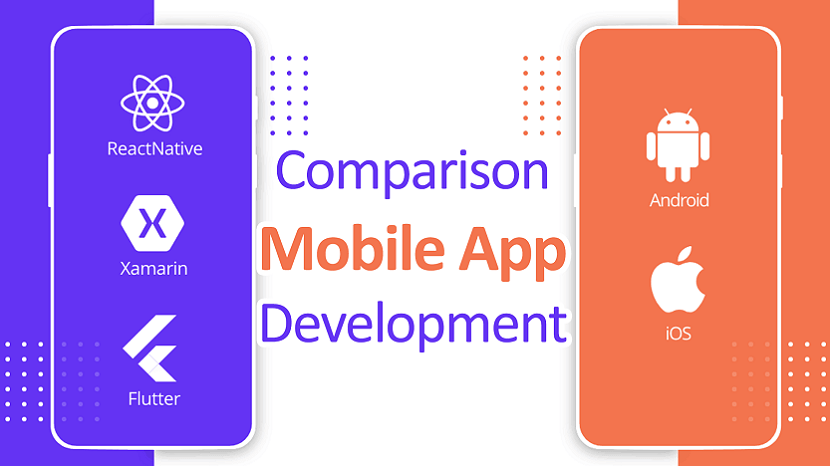
App development today is very different from the past. Historically, low-level coding for native development was the only option. So if you wanted an iOS app for the Apple App Store and an Android App for the Google Play Store, you needed to code two different versions from scratch.
But the barrier to entry for app development today is much lower. App development tools, languages, and platforms are more integrated, and Javascript is used for cross-platform codes.
This makes it much easier for e-commerce companies, existing businesses, and entrepreneurs to develop native apps from scratch.
Here’s a Comparison of App Development and what makes them unique for development:
1. Native Apps
Native apps are developed for specific mobile operating systems such as iOS or Android. Platform-specific language is used to build these apps. For example, (native) Android apps use Java, while iOS apps use Objective – C or Swift.
- Native applications are built using the tools and SDKs offered by platform owners like Apple and Google. These apps run natively on the platform of your choice.
- Native apps offer the best runtime performance.
- Directly use the platform’s data through platform-specific SDKs.
- The cost of building and maintaining different codes for each platform is high.
- Features have to be implemented differently based on the platform’s SDK tools.
Pro
- Best runtime performance
- Direct access to device APIs
Con
- Higher costs when building and maintaining your app
- Multiple code-bases for each platform
2. Cross-Platform Apps
Cross-platform mobile development is the creation of software applications that are compatible with multiple mobile operating systems. Originally, the complexity of developing mobile apps was compounded by the difficulty of building out a backend that worked across multiple platforms.
- Cross-platform mobile applications can be written on various programming languages and then compiled for each platform separately.
- Single code base for multiple platforms.
- A unified user experience can be offered even for different platforms.
- Since native libraries are not available, the dependency is on third-party open-source libraries.
- The code is not written natively. Thus, it has to be complied with and bridged. Which can be bugging.
Pro
- Single code base for multiple platforms
- Easy to build and maintain your app
Con
- Dependents on bridges and libraries for native device features
- Performance limitations due to bridging
3. Hybrid Apps
Hybrid apps are essentially web apps that have been put in a native app shell. Once they are downloaded from an app store and installed locally, the shell is able to connect to whatever capabilities the mobile platform provides through a browser that's embedded in the app.
- Hybrid Applications are built using the latest web technologies like JavaScript, CSS, HTML, and then bundled as mobile applications for the required platforms. Hybrid Apps are different from Cross-Platform Apps in the sense that they work using web containers using browser runtime.
- Codebase is shared between web and mobile apps.
- Web development tools can be used to build mobile applications.
- The performance is not native, as essentially, they are built using technologies for web development.
- Little or no support for native devices.
Pro
- Shared code base between web and mobile apps
- Using web development skill set for building mobile apps
Con
- Lower performance compared to native apps
- Limited support for native device features
4. Progressive web Apps
A progressive web application, commonly known as a progressive web app, is a type of application software delivered through the web, built using common web technologies including HTML, CSS, JavaScript, and WebAssembly.
- Progressive Web Apps don’t require native or cross-platform development. They skip the app store installations and also traditional app delivery channels. They work inside the browser, whether it be mobile or desktop. A link is added to the mobile in the form of an app icon. These are basically web applications that also run on mobile.
- Apps run on the web, as well as mobile.
- No need to install the app. Runs through a browser on URL using the network connection.
- Little or no support for native devices. Runs using browser’s capabilities.
- If the network connection is not available, interactivity is lost to a great extent.
Pro
- Same app is available both for web and mobile
- No installation required, accessible through a URL
Con
- Limited support for native device features
- App capabilities depend on the browser in use
If you found this article helpful, we encourage you to share it on your social media platforms—because sharing is caring! For more information about article submissions on our website, feel free to reach out to us via email.
Send an emailWritten by RGB Web Tech
Latest Technology Trends
Latest technology trends shaping the future, including AI advancements, blockchain innovation, 5G connectivity, IoT integration, and sustainable tech solutions. Explore breakthroughs in quantum computing, cybersecurity, augmented reality, and edge computing. Stay ahead with insights into transformative technologies driving innovation across industries and revolutionizing how we live, work, and connect.
Best Mobile App Development Frameworks
Last updated on January 19, 2025 by RGB Web Tech

Companies have demonstrated that mobile applications are the best way to grow their customer base. There’s never been a lack of original app concepts. Everything functioned to the benefit of application development businesses.
You don’t need to know any complicated computer languages to create an app. There are various app development frameworks for iOS and Android. All you require is a solid grasp of web-based programming languages such as HTML, CSS, or JavaScript.
A mobile app framework is a software creation platform that includes tools and software, compilers, debugging tools, and programming interfaces, among other things. Thus, a developer creates the application’s source code and the framework and uses various elements to generate the application for the different mobile devices.
Best Mobile App Development Frameworks in 2023
Modern-day mobile app development frameworks provide several built-in benefits, like speed, effectiveness, and a bug-free atmosphere. The framework uses pre-built elements, including compilers, debugging tools, and toolkit, to display the application on the target device using the company’s code.
Using the expertise of a reputable mobile app development company may help the firm create mobile applications which are quick, reactive, and provide excellent user interactions. The use of mobile app development platforms speeds up and simplifies the app creation procedure.
Top Mobile App Development Frameworks in 2023
Below are some Modern mobile app development frameworks. These can be very helpful for both android and iOS users.
1. Alpha Anywhere
It is a complete front & back-end and a low-code application development platform. It is widely used for the rapid development, distribution & deployment of mobile applications on both iOS and Android platforms.
It has unique coding-optional technology, which allows developers to achieve high productivity with complete freedom.
Features
- Easy to connect with all SQL and no-SQL databases.
- Flexible conflict resolution and large data storage capacity.
- Enterprise-class data protection and complete administrative control.
- Tightly integrated analytics & charting features.
- Easily add drag-and-drop editor and scheduling to cross-platform apps
2. Flutter
Flutter is the best UI toolkit that helps to build native applications for the web, mobile, and desktop. It comes with fully customized widgets, which help to create native mobile applications in a very short time. Its layered architecture will ensure the fast rendering of components. Here are the top applications developed using Flutter.
Features
- Built-in Cupertino (iOS-flavor) widgets.
- Supports both iOS and Android platforms.
- Can develop high-performance apps.
- Rich motion APIs
3. Mendix
Mendix is the fastest & easiest low-code app development platform. Therefore, it is widely used by businesses to develop mobile & web apps for high performance.
It accelerates the delivery of enterprise applications, from ideation to deployment and operations. It becomes easy to implement both Agile and DevOps with Mendix.
Moreover, it also offers both no-code and low-code tooling in one single fully integrated platform.
Features
- The rapid building, deploying, and operating of enterprise-grade applications.
- Can be used for low-code and no-code platforms.
- Build on unrivaled cloud architecture.
- Best functionalities and exceptional customer support
4. Xamarin
Xamarin supplies add-ins to Microsoft Visual Studio that allows developers to develop Android, iOS, and Windows Apps with C# codebase. The reason behind the preference of using Xamarin is that it allows code sharing in multiple platforms, such as cross-platform mobile app development.
Being a cross-platform and open source app building platform, Xamarin is known for offering a development ecosystem with back-end, API, and components. Here are the top applications developed using Xamarin.
It is also supported by various tools, libraries, and programming languages. Moreover, it also has a cloud service, which allows testing on any number of devices.
Features
- Produce only fewer bugs and faster time.
- Best backend infrastructure.
- Component store with UI controls, cross-platform libraries, and third-party libraries.
- Allows application Indexing and Deep Linking
5.Unity Ads
Unity Ads is an important platform when it comes to integrating video ads into mobile games to increase player engagement. You must have seen the recommendations of seeing a video to get one more life to play the game.
Unity Ads is also known for offering the highest Average Revenue Per User (ARPU) of any global rewarded video ad network. Here are the top applications developed using Unity.
Features
- The setup is simple and easy to implement.
- Helps to engage more players.
- Offers a positive player experience.
- Doesn’t interrupt the gameplay while introducing rewarded gameplay.
6. Ionic
Ionic comes into the picture when you want to build an interactive hybrid mobile and progressive web apps along with cross-platform applications.
The unique benefit of using this open-source framework is that you can create applications and ship them to deployable locations every time you build.
If you want an easy visual development environment, then you can install Ionic Studio, which is the lightning and powerful version of Ionic. This mobile app development software is widely known as a tool for developing hybrid mobile apps as it is an HTML 5 mobile app development framework. Here are the top apps developed using Ionic.
Features
- Ionic is a free and open-source project.
- Fast and powerful development platform.
- Have complete control over app building.
- Can build native and progressive web applications.
- Easily handles all the UI components.
- A developer can build an app for all app stores with a single code base
7. React Native
It is a widely used JavaScript library to create native mobile apps for all devices and platforms. It helps to develop rich apps to give the best user experience.
Moreover, this mobile app development software also allows a developer to create platform-specific versions of various components for native apps with easy use of a single codebase across various multiple platforms. Here are the top applications developed using this platform.
Features
- Low-code requirement.
- Compatible with third-party plugins.
- Declarative API for predictive UI.
- Supports both iOS and Android.
8. Sencha
Sencha Ext JS is an MVC-based JavaScript platform, offering a high level of responsiveness to the application for improving customer satisfaction.
Sencha has merged with Ext JS, and now you can use this for building data-intensive applications for both web and mobile. It is also known for cross-platform mobile development. Here are the top applications developed using Sencha.
Features
- Has the ability to manage millions of data.
- Flexible layout system and data representation.
- Code can be translated with the help of the mobile app development tool.
- Rationalized configuration system.
- Best support with the animations and touch events
9. Adobe PhoneGap
Adobe and Apache both have sponsored Adobe PhoneGap. This platform is widely known for its use in Android development.
The benefit of using PhoneGap is that you can develop a single app that can work on all mobile devices. Moreover, it is an open-source desktop application, and you can link the apps to mobile devices.
Features
- Compatible on all the platforms.
- Works effectively on JavaScript, HTML5,and CSS3.
- Easy to integrate various libraries to enhance app development.
- Can extend the functionality of the app with a plug-in architecture.
- Strong backend and easy to develop an app.
10. NativeScript
NativeScript is one of the preferable platforms to create native mobile applications. This helps to reduce the code and load time of native apps on the system.
Moreover, there are many leading companies, such as Puma and SAP, that love using Native Scripts for their web empowerment platform.
Features
- Native user interface without WebViews.
- Full direct access to Android and iOS APIs.
- Cross-platform mobile app.
- Good backend support.
- Hundreds of NativeScript plugins are available.
- Provides three complete real-world app implementations.
11. Swiftic
Swiftic is one of the best platforms for iOS app development services. It offers an easy-to-navigate interface for everyone to build an app. Swiftic offers a lot of profitable app features, such as unlimited push notifications, advanced analytics, and also makes the app attractive to look at.
Swiftic, an iPhone mobile app development software also offers a 30-day money-back guarantee. Along with that, it has a 6-months of success guarantee scheme. So, if you do not get the result within 6 months, then the service will be free for you.
Moreover, Swiftic has seven different templates and UX/navigation styles and comes in different colors, background pictures, and building blocks.
Features
- Helps to publish apps on the App Store.
- Easy to create a customized app with loyalty programs.
- Attract customers with eye-catching push notifications.
- Implement features to contact via call or email.
- Guarantee app brings results for the business users.
- Third-party integration.
FAQ – Mobile App Development Frameworks
1. Which mobile app development framework should I learn in 2023?
All the above-mentioned mobile applications frameworks (React Native, Flutter, Xamarin, Swiftic, Ionic, Apache Cordova and jQuery Mobile) are essential for any mobile app developer to learn. As of now, changes can take place with time, but the given frameworks are essential.
2. Which is the most used app development framework?
In the software industry, React Native is among the most popular mobile app frameworks. The FB software is an accessible framework that allows you to construct mobile apps for Android and iOS devices.
3. Which are the easy-to-use mobile app development frameworks?
Framework7 is simple to understand and also uses an open-source framework. It enables programmers to create native-looking Android, iOS, and desktop applications utilizing popular online standards like HTML5, JavaScript, or CSS3.
4. Which mobile app development frameworks can be used for cross-platform app development?
React Native, Ionic Framework, Node, Xamarin, NativeScript, Adobe PhoneGap, and Flutter are the best mobile app development frameworks for cross-platform app development.
5. Which frameworks are the best for native app development?
Native Script is an accessible framework that uses Angular, Typescript, JavaScript, and CSS to develop native mobile applications. React Native is the finest JavaScript framework for creating native apps for any platform and operating system. Xamarin is among the most used mobile app development frameworks. Microsoft launched this native framework.
6. Which is the best mobile app development framework?
React Native is among the most commonly utilized mobile applications frameworks, with 42% of programmers globally using it. It was created by Facebook and is built on JavaScript. Using Android and ios platforms, React Native programmers can quickly construct a smartphone application with a native appearance and touch.
7. What technologies or frameworks can be applied to build a mobile application?
Python, Java, Flutter, React Native, Swift, Kotlin, R Programming can be used to develop a mobile application as they are the top mobile app technologies.
8. Which stack is best for Android Mobile App Development?
Java has turned out to be the most widely utilized programming language for creating Android apps. Because it is centered on Android APIs and a large number of built-in Java libraries, it is among the finest choices for developing Android apps.
9. What is a hybrid mobile app framework?
The Hybrid Managed Framework combines the advantages of both Data-Driven as well as Keyword-Driven frameworks. The terms, and the testing dataset, are externalized in this scenario. Test data could be kept in a properties file or perhaps an Excel file, and keywords are kept in a distinct Standard java file.
10. Which framework is best for Mobile App Development?
Flutter is the most popular Android framework out there. It has speedily scaled the list of dominant positions after being recognized as the second most-used framework after React Native. Onsen UI, React Native, NativeScript, Iconic and more are best for mobile app development.
11. How to select the right mobile app framework?
Consider these factors at the time of choosing the right mobile app framework: (1) Platform Feature Support (2) Speed Considerations (3) Cost of Development (4) Security Risk Enhance Efficiency, and After Launch Updates. You should consider these factors at the time of choosing the right app framework for your mobile.
12. Is there any framework for Android development?
Apache Cordova, formerly known as PhoneGap, is a free and open-source Android framework that allows hybrid app development in many basic web-development languages and technologies, like JavaScript, HTML5, and CSS3. It authorizes the construction of multi-platform apps with a single code base, e.g. Appcelerator Titanium.
13. What are the technologies used in iOS mobile app development?
Technologies like UIKit allows you to create a touch-based user interface. Because all iOS apps are based on UIKit, you can’t send an app without this framework. Its interfaces are an integral component and part of the Quartz Core framework.
14. Which programming is best for app development?
Java is best for app development. Java was the official language for Android App Development and it is the most used language. Many of the apps in the Play Store are constructed with Java, and it is also the most reinforced language by Google.
Conclusion
Mobile application development is more accessible than ever. Whether you are a full-stack developer, aspiring engineer, or have decades of experience in the Microsoft ecosystem, you can build great mobile applications that can run on billions of devices today. There may not be a clear winner, each platform has pros and cons, but the important thing is you have a plethora of options. As the old adage goes, "use the right tool for the job". Hopefully you've learned more about native app alternatives and can make an informed decision about developing mobile applications.
If you found this article helpful, we encourage you to share it on your social media platforms—because sharing is caring! For more information about article submissions on our website, feel free to reach out to us via email.
Send an emailWritten by RGB Web Tech
Latest Technology Trends
Latest technology trends shaping the future, including AI advancements, blockchain innovation, 5G connectivity, IoT integration, and sustainable tech solutions. Explore breakthroughs in quantum computing, cybersecurity, augmented reality, and edge computing. Stay ahead with insights into transformative technologies driving innovation across industries and revolutionizing how we live, work, and connect.
Top Mobile App Development Languages
Last updated on January 19, 2025 by RGB Web Tech
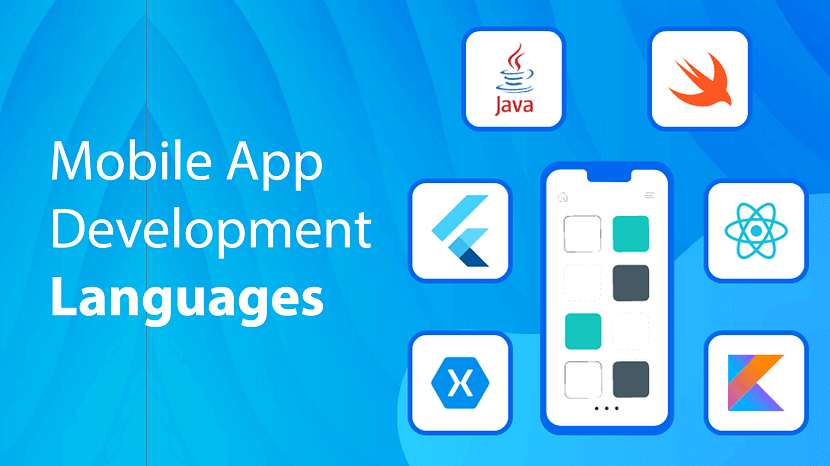
Learning programming languages is a hard nut to crack unless you know the basics.
Every programming language has its building blocks, which help budding programmers learn the language from scratch.
App development languages are no exception. They are, of course, advanced, but the secret to cracking these languages stays the same, you have to learn the basics.
Besides, many mobile app development languages resemble and are even based on languages like C and C++, something you have known for a long time now. Therefore, learning app development languages can be easy and fun if you have mastered these languages.
Which is the best programming language for mobile apps?
There are several programming languages for different sorts of tasks. Choosing the right language for the mobile app is different from choosing one to learn. The right selection yields solutions that are concise, easy to code, easy to scale, easy to debug and fix.
Often people will tell you that there is no choice and that all languages are equal and are developed to fulfill a particular purpose. However, it can be quite confusing, if you are new in the mobile development arena and lack information about programming languages.
So, if you are in a confused mess, the following factors can you help you choose the best language easily:
- The targeted platform.
- Elasticity of the language.
- The time to produce.
- Performance, support, and community.
- The purpose of building the app.
- Efficiencies of the programmer.
Here is a top mobile app development languages
- JavaScript
- Kotlin
- C++
- C#
- Python
- PHP
- Swift
- Objective C
- JAVA
- HTML 5
- Ruby
- Rust
- Lua
- Action Script
- SQL
- Dart
Take a minute to think about how many times you use an app in a day? Multiple times, isn’t it? In fact, there is probably an application waiting to be discovered in your app store for every possible human need. Therefore, it is no surprise that the demand for mobile applications has been on a steady rise ever since the smartphone was invented. Also, the reason why you’ll find hundreds of mobile app development companies in your locality.
No one on the surface doubts the future of mobile application development and mobile programming languages. Gone are the days where businesses could ignore mobile users! Having crossed a milestone already, if your business isn’t mobile-ready, you’re in trouble today.
If you are taking the plunge to build your mobile app to get the user’s attention – you need to focus on choosing the right technology, the right programming language, the right UX design tools, and most important of all, one of the top mobile application development companies to create a robust, innovative and user-friendly app for your business needs.
With several mobile programming languages to choose from, you have to consider multiple factors, pros, and cons, as well as the popularity of the language, before making your decision to build the most popular mobile app. Once you’ve chosen the best mobile programming language and built a business app, you step into the marketing stage which demands a suite of best marketing apps to scale up your development efforts.
In this article, we have curated a list of top 16 mobile app programming languages which will help you choose the best quickly and get you started with your mobile app.
1. JavaScript
William Ting’s once said, “JavaScript will stay relevant as long as people use the internet.” JavaScript is best for cross-platform app development, mobile apps used for various platforms, and web browsing. It smoothly runs in other environments, outside of browsers, and can be compiled from a wide array of programming languages. So, my vote for the best programming language is for JavaScript.
Features
- A lightweight, platform-independent, and prototype-based language.
- Supports dynamic typing and object-oriented programming.
- Can validate user input and client-side calculations.
- Has built-in date and time functions.
Pros
- Versatile and Flexible language and can used in many ways through Node.js
- Faster on the client-side browsing and doesn't need to be compiled.
- Straightforward to work with and easy to control.
- No set standard and plenty of room for variation.
Cons
- Is vulnerable and can be exploited for malicious purposes in some cases.
- You can encounter some browser support issues in some cases.
- Server-side scripts always provide the same output and client-side is a bit unpredictable.
2. Kotlin
Said to be the advanced version of Java – Kotlin is a statistically typed programming language used for developing modern Android applications. Kotlin has the potential to influence other programming languages such as JAVA to make high-performing and robust apps. Some popular apps built-in Kotlin are Trello, Evernote, Coursera, and many more.
Features
- An open-source programming language.
- Reduces startup time for Android apps.
- Has a clean and compact syntax.
- Supports operator overloading.
Pros
- Clean, concise, and perceptive syntax increases team efficiency.
- Interoperable and versatile and can easily overrule the shortcomings of JAVA.
- Has full support from Google and IDE’s installation packages including Android and SDK toolkit.
- Generates compact, simple, and cleaner code as compared to JAVA.
Cons
- Still a new language in the market is so hard to learn, so think before you choose it.
- Sometimes it gets slower.
- There are limited resources for learning.
3. C++
C++ is considered to be an upstanding choice for mobile app development. It is a general-purpose, object-oriented language with generic and low-level memory manipulation features. Used for Android App and Native app development, C++ is used for developing games, GUI-based applications, real-time mathematical simulations, banking apps, etc. C++ is popular with Cloud computing apps as it can quickly adapt to changing hardware or ecosystems.
Features
- A portable, high-level, and object oriented programming language.
- Simple and easy to understand.
- Includes built-in libraries to provide various functions to the programmers.
- A compiler-based language that improves the speed of program execution.
Pros
- Fast and stable and has a vast pool of ready-to-use in-built libraries and compilers.
- If you know C++ you can quickly learn JAVA, C, C#.
- No garbage collector is running in the background.
- You can take full control, and the app can run on any platform and take advantage of any hardware.
Cons
- Complex syntax, small standard library.
- Most complicated programming language to master.
- Cannot support garbage collection or dynamic memory allocation.
- The object orientation is quite essential as compared to other languages.
4. C#
Pronounced as ‘C-sharp’ – this is another object-oriented, general-purpose programming language extensively used for mobile development, majorly for cross-platform and windows app development. C# has everything you want to achieve using other programming languages such as Swift, Objective-C, and JAVA programming languages. If you are planning to develop an interactive and high-performance game app, this is the best language.
Features
- A modern, structured, and scalable programming language.
- Has a function-rich library for programmers.
- Ensures security of a program with type safe code.
- Is interoperable and updateable.
Pros
- Fast, easy-to-use, and quick to deploy
- Generic, strong typing, functional, imperative, declarative, component-oriented, and object-oriented disciplines.
- Simple, modern, and general-purpose language
- Most preferred programming language
Cons
- Intricate and complex language for fresh learners
- Case-sensitive language and creates confusion even if there is a slight miss-match between even alphabets
5. Python
A widely accepted programming language, Python is used for developing web applications, desktop apps, media tools, machine learning, network server, and more. Examples of Python are YouTube, Instagram, and Pinterest. The language provides excellent library support, robust integration, and enhanced control capabilities. If you are a start-up planning to develop your app – Python is the best language!
Features
- Ensures rapid application development.
- Can “glue” existing scripts with each other.
- Has readable and clean code as it uses indentation.
- Can help create GUIs using one of the many standard libraries.
Pros
- Fast, easy-to-use, quick to deploy, easy to learn, and excellent at readability.
- High-level programming language used for analyzing, computing scientific and numeric data, and for software development.
- An interactive language used to build scalable apps and supports GUI applications.
- Supports multiple systems and platforms.
- Has huge-set of frameworks which make programming flexible.
Cons
- Slow execution time.
- Not that great with modern mobile application development.
- Not a great choice with memory-intensive tasks.
- Has some drawbacks with data access.
6. PHP
PHP is one of the most recommended programming languages for mobile apps that need database access. It is an open-source language used for server-side scripting, command-line scripting, and coding applications. Widely used for creating eCommerce applications, content-heavy apps, dynamic web applications, and mobile apps. It is a flexible language that can be easily embedded into HTML or HTML5. A few of the popular websites on PHP are Wikipedia, Facebook, and Yahoo.
Features
- An open-source, interpreted, and loosely typed language.
- Logs real-time access by the users.
- Can generate error messages with predefined reporting constraints.
- Is compatible with all databases and almost all local servers.
Pros
- Easy to learn, is platform-independent, and exceptionally compatible with smooth integration
- Is excellent with content-heavy apps and loads quickly even with a slow internet connection
- In-built security features to protect from complex security threats
- Great language for learners, which can then help them learn complex program development quickly
Cons
- The open-source nature of the language is readily available for all to see and thus bugs can be found quickly to exploit its weakness
- Not suitable for large applications
- Not modular and is difficult to maintain
- The framework needs better error handling.
7. Swift
A prospective game-changer in the mobile app development space – Swift is an open-source programming language specifically designed to work with iOS, OS X, and tvOS platforms. The language is flexible, scalable, and can easily adapt a safe programming pattern to add modern features to any app. Swift is expressive and fun to work with a scripting language, along with having the first industrial-quality systems. Examples of apps developed in Swift are Lyft, LinkedIn, Hipmunk, and more.
Features
- Has a free-standing IDE called Xcode.
- Is type safe and catches minor errors during compilation.
- Has native error handling functionality.
- Has in-built memory management techniques like automatic reference counting (ARC).
Pros
- Can execute on Cocoa and Cocoa Touch platforms
- Requires less, little maintenance, and avoids some of the bugs of Objective C.
- Projects are easier to scale
- Powerful, intuitive, and easy-to-learn programming language
- Writing Swift code is interactive and fun; the syntax is expressive yet concise.
- Has multiple features for seamless and safe design yet produces lightning-fast software
Cons
- Still at a nascent stage and can be considered quite young for development of heavy apps
- Considered an unstable language as its new in the market and needs regular updates
8. Objective C
An extended version of C language, Objective C is a general-purpose, object-oriented programming language with added features like Smalltalk-style messaging. A well-updated and mature programming language, Objective C is mainly used for macOS and iOS app development and operating systems.
>Features
- Supports both static and dynamic typing.
- Message syntax is just like our natural language, thanks to Smalltalk.
- Has an automatic garbage collector.
- Easy to introspect objects.
Pros
- Easy-to-learn and used by most of the developers
- A lot of legacy codes are included to support the nest coding style
Cons
- Does not support any latest features which are then overcome by Swift
- Requires extended coding which is time-consuming
9. JAVA
Java is an official Android development – object-oriented programming language. With in-built open-source libraries readily available for users to choose from, JAVA is easy to handle and offers the best documentation and community support. With JAVA’s vibrant spectrum of features, you can develop the best cross-platform apps, Android apps, games, server apps, embedded space, websites, and more.
Features
- A robust, server-side programming language.
- Is compiled and interpreted.
- Is independent of platforms and environments, meaning architectural neutral.
- Ensures security of programs with access modifiers and virtual machine sandbox.
Pros
- Popular for code reusability and portability
- JAVA codes can run in multiple environments, virtual machines, browsers, and different platforms
- Safeguards developers against issues inherent in native code, memory leaks, etc.
- Flexible, versatile, portable, and platform-independent programming language
- Explicit interface, simplified, and machine-independent language
Cons
- Some bugs may occur while running JAVA in a virtual machine – JVM
- Poorly written class libraries and complex syntax in some cases
- Complex implementations due to poor garbage collection
10. HTML 5
Are you planning to build web-fronted apps or location-based apps for mobile devices? Then the fifth version of HyperText Markup Language – HTML 5 is an ideal option for you. It is not a programming language but a markup language that uses tags to structure and present the content on the webpage. The latest updates of HTML 5 highlights exceptional features like media elements, multi-platform functionality for different programs, and quick market deployment. Examples of HTML 5 are Google Docs and Google Drive.
Features
- Supports vector graphics, enhancing the use of Adobe Flash while creating websites.
- Includes predefined tags to display header and footer information, photos, captions, and other similar elements.
- Has eliminated using the “type” attribute for scripts and links.
- Supports multiple tags and media elements to display content.
Pros
- Compatible with all the browsers and new features and standards already emerge
- In-built capability to support rich media formats like audio and video
- Loads faster using local storage or cache
- Has CANVAS elements used for embedding applications based on geolocations, dynamic graphics, offline/ online games, and animations
Cons
- A vast amount of coding required for each platform
- Does not support old version or systems causing a backward compatibility issue
- It takes a longer time to develop a mobile app as each platform requires its coding
- In case of customization or adding features, HTML5 adjusts the code, and the tools of iOS and Android goes behind the official SDK
11. Ruby
Ruby is a back-end object-oriented scripting language used in the development of web applications, servers, system utilities, and standard libraries. Over the years, Ruby has evolved into a general-purpose, high-level multiple-paradigm, interpreted programming language. It is a functional language that directly executes the instructions rather than compiling the program in machine language. A few of the well-known websites developed using Ruby are Twitter, Bloomberg, Airbnb, and Shopify.
Features
- Supports dynamic and duck typing.
- Has a flexible and compact syntax.
- Features an extensive library of in-built functions and modules.
- Implements exception handling and operator overloading.
Pros
- Supports dynamic typing to make changes on the go without affecting the overall result
- Allows duck typing that focuses on operations rather than class objects
- Easy-to maintain, smooth performance, and intuitive code quality, garbage-collected, and concise
- Easy to learn and execute for beginners
Cons
- Considered as slow language and is not that popular for the development of web apps or mobile apps.
- The shortage of flexibility and the boot time of the framework is quite long.
- Slow runtime speed and low performance
- Development and updates for bug fixes are slow
12. Rust
Rust has been Stack Overflow’s most loved language for four years in a row. Sponsored by Mozilla, Rust is a system programming language having syntax almost similar to C++. With strong compile-time correctness, fast-performance, intuitiveness, and safe memory, Rust is useful in a time-constrained scenario and to develop applications across different fields. Examples of Rust are Dropbox and Yelp.
Features
- Is memory-safe and manages resources with RAII (Resource Acquisition Is Initialization).
- Can extend Rust with the help of procedural macros.
- Uses a foreign function interface (FFI) to call code from Rust to C and vice versa.
- Implements pattern matching to improve the program’s flow.
Pros
- Errors are caught while compiling the code
- Developers are encouraged to write optimized and high-performance code
- Supports functional and imperative procedural paradigm
- Safe, concurrent, and practical language
- Low-level language suited for embedded systems
Cons
- Installation on Windows is not straightforward
- Does not have in-built libraries as compared to other languages
- Difficult to learn and execute for beginners
- A steep learning curve
- Slow to compile
13. Lua
Lua is a light-weight mobile-first enterprise communication solution. It is a cross-platform multi-paradigm programming language. It powers in-built messaging for businesses and is instant, secure, and keeps developers accountable. It is popular for real-time secure messaging, analytics dashboard, easy file sharing, and two-touch conference calling. If you want to improve the speed, extensibility, portability, and reliability of your apps, Lua is perfect for embedded applications.
Features
- An extensible and adaptable programming language.
- Is lightweight and cross-platform.
- Ensures fast execution of programs as it compiles interpreted bytecode.
- Has dynamic data types and freeform syntax.
Pros
- One of the fastest languages which use the least amount of runtime memory
- The smallest memory footprint for bundling and is helpful for error handling
- Lua C API is very well documented and can be easily integrated with C
- Reduces API and lower learning curve
Cons
- Though the documentation has improved, it is still a bit sketchy overall
- Not adequately documented with the least amount of code comments
- Not easy to learn and execute for beginners
- Poor garbage collection capacity
14. Action Script
ActionScript is a popular programming language for Adobe Flash Player and Adobe AIR runtime environments and is a tool in the tech stack – languages category. It is an object-oriented programming language derived from HyperTalk – the scripting language for HyperCard. Looking to use Adobe Flash Player on your website or software? Lua works great with animations or motions in websites and to develop video games.
Features
- An event-based language in which events trigger actions.
- Allows developers to create onscreen environments.
- Protects code with obfuscators that transform code in a way that’s difficult for humans to understand.
- Has both an open-source compiler and an open-source virtual machine.
Pros
- ActionScript versions 1.0 and 2.0 can run on the same machine
- Supports custom classes like external text files structured in a particular way
- Is popular among developers using Adobe Flash Player or Adobe Air
- For data-based applications and basic robotics – ActionScript is the most suitable language.
Cons
- To program with the latest version of ActionScript – Flash player nine or, the higher release is required
- Need to keep things simple as it would be difficult to demonstrate complex content
15. SQL
SQL stands for Structured Query Language used for assessing, communicating, and manipulating the standard database for most applications. SQL is designed to meet specific standards, both ANSI and ISO, and there is extensive support for both on a community and enterprise level. Strength – Relational data model and referential integrity between data, data query, data manipulation, and data access control. With well-defined standards, SQL is widely used in business intelligence tool platforms.
Features
- Is rich in data definition and manipulation commands (DDL and DML).
- Provides vertical scalability to databases.
- Encrypts data to ensure security and authentication.
- Is vendor-independent, making it easy to migrate from one vendor to another.
Pros
- Powerful and one of the most popular query languages
- Optimized for a large number of table rows and supports many different database choices
- Can handle a large number of transactions in a single query
- Fast for retrieving data, search and querying of data from multiple tables
- High availability and consistency of data
Cons
- Difficulty in interfacing, complex to add a few lines of code in between
- A predefined and inflexible data model
- Can be difficult to convert data from objects into database tables
- Vertically scalable. It can only run on one server, so if speed increases, hardware needs to be upgraded.
- Lack of partition tolerance
16. Dart
DART is a client-optimized and open-source programming language focusing on UI, productivity, and speed. It features asynchronous coding and is used on Flutter to make cross-platform apps easily. Apart from client-side and server-side development, Dart is also popular for Native mobile app development. Google developed Dart to accelerate app development on all the platforms.
Features
- Supports iterative changes and “hot reload” to track results on the go.
- Is type safe and allows both static and dynamic typing.
- Provides a feature-rich library that simplifies core programming tasks.
- Has both just-in-time (JOT) and ahead-of-time (AOT) compilers.
Pros
- Accelerates app development on multiple platforms.
- Emphasizes productive and high-quality development.
- Has separate compilers for both native and web platform app development.
- Is easy to learn and has a familiar syntax (of C).
- A detailed description of features and support from a friendly community.
- Programs run fast and are stable.
Cons
- Does not give much importance to the backend.
- Lack of generic and domain packages.
- Is yet to provide native support to bring Dart on browsers.
Conclusion
There are constant evolution’s in the world of programming languages. Some evergreen languages such as JAVA and JavaScript have earned an eternal place in the list, whereas other languages like Kotlin and R have risen at an outstanding pace and have made it to the list of the most popular programming languages.
With a list of questions to ask, factors to consider, and the above-listed pros and cons, we are sure you can make a sensible decision regarding which language to choose. After all, choosing the right mobile programming language will help you develop agile mobile apps that will weather the changes in future business needs.
So, what are you waiting for? Dive into the nitty-gritty of the programming language, choose the best and give your business the most needed mobile application to reach a more substantial mass.
If you found this article helpful, we encourage you to share it on your social media platforms—because sharing is caring! For more information about article submissions on our website, feel free to reach out to us via email.
Send an emailWritten by RGB Web Tech
Latest Technology Trends
Latest technology trends shaping the future, including AI advancements, blockchain innovation, 5G connectivity, IoT integration, and sustainable tech solutions. Explore breakthroughs in quantum computing, cybersecurity, augmented reality, and edge computing. Stay ahead with insights into transformative technologies driving innovation across industries and revolutionizing how we live, work, and connect.
12 Principles of Design & How to works
Last updated on January 19, 2025 by RGB Web Tech

You can’t just flip a switch and create beautiful designs on a whim. Like learning to walk before you run, there are certain fundamentals you’ve got to learn first.
The problem is that if you don’t have the time or inclination to take a design course, resources are pretty scarce. Sure you can rely on Canva templates, but even then you need to know how to use them properly.
This is why we've put together this post. It’s for you if you’ve ever wondered what goes into good design. You'll find it handy whether you're a complete amateur or a budding designer—so let's get stuck in.
What are design principles?
Design principles are guidelines to follow if you want to create effective visuals, from oil paintings and blog graphics to eye-catching social media posts.
Think of design as carpentry and these principles as your toolbox. You can use them to help you during the design process, and unlike hammers, nails and screwdrivers, they can exist entirely inside your head.
These tools give you a better understanding—and appreciation—of what goes into the designs we see every day. As you become acquainted with them, you’ll start to see what does and doesn’t work (and why), as well as how you can apply these principles to your own creative work.
What is "good design"?
We’re told that piece of art is subjective. For the most part, that’s true. But if you’ve ever seen an unintelligible parking sign or a website from the early days of the web, you’ll know there’s definitely such a thing as bad design.
As Jared Spool, an expert on design and usability, says, “good design, when it’s done well, becomes invisible. It’s only when it’s done poorly that we notice it.” This is why good design is tricky to define.
Luckily for us, in the late 1970s, an influential designer named Dieter Rams saw this problem. In response, he asked himself what constituted good design and came up with his own list of ten principles.
Little did he know, they would go on to inspire generations of designers, including Johnny Ive, the mastermind behind Apple’s most famous products.
Rams’s principles are:
- Good design is innovative
- Good design makes a product useful
- Good design is aesthetic
- Good design makes a product understandable
- Good design is unobtrusive
- Good design is honest
- Good design is long-lasting
- Good design is thorough down to the last detail
- Good design is environmentally friendly
- Good design is as little design as possible
You might notice that these principles are aimed at product design. Rams worked at Braun, so products were in his wheelhouse, but these principles are easily adapted to UX, UI, or any other design context.
Rams’s principles aren’t the only principles out there. Other notable design principles include Nielsen’s 10 usability heuristics and Whitney Hess’s five guiding principles for experienced designers.
The 12 principles of design
These are the building blocks graphic designers and artists use to put creative works together; the core principles of art that make up every design, from the fine art of the Louvre to the boxes of Corn Flakes at the local grocery store.
1. Balance
Where objects in real life carry physical weight, elements in design carry visual weight. Large elements are heavier and small elements lighter, with each element having its own "weight" based on how much attention they draw.
Visual balance is about ensuring your design is equally weighted on both sides of the central point. It’s like a seesaw—too much weight on either side and the whole thing becomes unbalanced.
By striking this balance you create visual harmony and stop your design from feeling too chaotic to the viewer. It’s one of the most important parts of visual composition, and comes in three basic forms:
Symmetrical balance

Symmetrical design uses an imaginary vertical (or sometimes horizontal) line to divide a design into two halves around a central point. Elements of equal visual weight are balanced on each side of the axis to create symmetry.
There are two variants of symmetrical balance: Reflectional symmetry, where the two halves are exact mirror images, and translational symmetry, where the same shape or elements are repeated on both sides of the design.
Asymmetrical balance

An asymmetric composition is when a design uses unequal weighted elements. One side might have a visually heavy element, balanced with multiple lighter elements on the opposite side.
To run with the seesaw example, it would be like having a 100kg weight on one side and 100 kg of feathers stacked on the other. It still achieves balance but provides a whole different experience.
Asymmetry is often more visually interesting. Where symmetrical designs can be quite static and predictable, asymmetrical balance can give designs a more dynamic feel.
Radial balance

Radial balance is when elements “radiate” from a point in the centre of a design. Think of rays shining from the sun, petals blossoming from a rose, or a squirt of tomato sauce in the middle of a juicy meat pie.
This form of symmetry is a way to add depth and movement to a design and works to draw attention to an object in the centre of a composition.
2. Emphasis

Emphasis is used to focus the viewer’s attention on a certain part of a composition. The effect is achieved by manipulating elements (like colour, shape and size) to make specific parts of a design stand out.
For example, say you wanted to bring attention to a call to action on a landing page. You could increase the text size and use colours that stand out from the background, emphasising the CTA and making sure visitors can’t miss it.
3. Repetition

As you may have already guessed, repetition refers to when an element is repeated throughout a design. It could be anything, from using a certain font colour to adding a repetitive pattern to a social media post.
Repetition makes designs visually exciting and cohesive. It also creates a sense of consistency by using a repeating motif that the viewer comes to expect. This makes it particularly useful when it comes to creating your distinct brand identity.
Brand identity is the visible element of your brand. The colours; design; logo. It acts to distinguish your company from the millions of others out there, so when folks see your designs they immediately know it’s your business.
Every successful business uses repetition. Why do we equate the swoosh and “just do it” with Nike? The blue can with Pepsi? Because these visuals were repeated so often that eventually they became synonymous with the brands they represent.
So while repetition can just help you make a sweet iPhone wallpaper, it’s a crucial tool for any company looking to build a visual identity and brand recognition.
4. Movement

When we think of movement we think of, well, things moving. A pendulum swinging. A Ferrari roaring down the freeway. But in design, it refers to the path a viewer’s eye takes when they look over a composition.
It’s not just what you look at; it’s the way you look at it. Designers can guide this by using lines, edges, shapes and colours to create focal points and encourage certain ways of seeing.
Movement can be harnessed to distract, direct and pull the viewer’s gaze around a design. By using subtle cues (particularly with lighting and perspective) a savvy artist can control this entire process. You can use lines to create directional cues and make images feel more alive.
5. Proportion

Proportion is the relationship between two or more elements in a design, particularly the size and scale of them. When things are "proportionate”, it means there’s a coordination between them that makes the design look aesthetically pleasing.
For example, when you’re reading a blog post you expect headings to be larger than the body text. Or if you were looking at a realistic drawing of a tortoise and a hare, you expect the hare to be larger than the tortoise.
Proportion is about finding harmony between two elements. You want to make sure things look “right”— that the elements look as if they belong together.
This is something that comes up when creating digital assets and websites online. It’s the bane of many an amateur designer’s existence. Here are a few tips for keeping the elements in your design in proportion:
- Assemble elements that are identical or share a function.
- Establish major and minor areas in the design to prevent monotony and boredom.
- Ensure size variations are subtle (unless the objective is emphasis.) Avoid separating the composition into halves, quarters, and thirds. Try to keep a sense of balance.
You can also play with proportions in a variety of ways to emphasise elements or get a certain message across. It’s a strategy you’ll notice advertisements do often and is usually best used for more creative projects.
6. White Space
\
The region between different design elements is referred to as "negative” or “white” space. This is part of the design that doesn’t contain anything. No images, drawings, shiny colours or text. Nothing.
The name is kind of misleading — it’s not a "negative" thing and it doesn’t have to be "white". It can be any colour: white space refers to what you don’t add; the empty parts around and within your design.
It’s one of the fundamental building blocks of design and is just as important as any elements you do include. Think of it like a diet: what you eat matters, but what you don’t eat matters just as much.
“White Space in design composition is the same as the use of silence in a musical composition. Without proportionate use of silence, music is unstructured. Similarly, without white space, design is unstructured and difficult to consume." — Mark den Hartog
There are two types of white space: micro and macro. Micro white space is the space between small elements (like text), while macro white space refers to the area between large elements or surrounding a design.
7. Contrast

Contrast is produced when two or more visual elements in a composition are different. It can be used to create specific effects, emphasise the significance of certain elements, and add visual appeal to your designs.
Designs that look the same are boring—by experimenting with contrasting colour hues, shapes, sizes, textures and typography, you can liven things up. Humans tend to like contrast. It’s a great way to grab attention, control the visual flow and keep folks engaged.
Keep in mind that adding too many variations can be confusing for viewers (the opposite effect you want to have.) As with most of the different elements of art, it’s about striking a balance.
8. Hierarchy

Visual hierarchy is about organising the value of the elements within your design. By ranking information from most important to least important, you make it easier for the viewer to digest your content.
This plays a critical role in UI and UX design. Ever noticed how most landing pages have the same layout? There’s a logo at the top, a menu at the top and then elements in descending order of importance below.
It’s not because they copied each other's homework—there’s a certain hierarchy that designers stick to in order to draw attention to the right things in the right order (and make it pretty to look at.)
The viewer’s eye should be drawn to the most important element first. These sit atop the throne at the top of the hierarchy, with the elements laid out below ranked in order of importance.
There are a number of visual tricks to influence this flow, including:
- Size and scale: The larger an element is the more likely a viewer is to see it. By making something smaller you can reduce its importance and put the emphasis elsewhere.
- Colour and contrast: A splash of colour makes a big difference. Use bright colours to make certain elements or information pop.
- Fonts: Use different typefaces and stylisations like italics and bold to draw the eye and move text higher or lower on the hierarchy.
- White space: White space enables you to give an element breathing room and make a central element stand out.
Patterns of hierarchy
People read a page in the same way: from top to bottom. But we don’t just stare blankly at s page and wait for information to register, we scan it.
The human eye tends to follow the same path during this process. For that reason, designers stick to two common patterns to make it faster to absorb information: the F-pattern and the Z-pattern.
The F-pattern applies to pages made up mostly of text, like an online or printed article. Readers scan in the shape of an “F”—first, with the headline across the top, then down the left side of the page and to the right as they identify things they find interesting.

Designers use a Z-pattern for layouts with less text and more visuals. With this pattern, viewers scan across the top of the page and then diagonally down towards the opposite corner. They then scan the bottom in the same way as the top.
Most websites are designed in this way (including Paperform). Notice how the most important parts like the logo and navigation menu are at the top, while the secondary information like clients and chatbot is at the bottom.
9. Rhythm

Don’t worry, you can leave your dancing shoes at home. In design, rhythm hasn’t got anything to do with the way you move your hips. It’s about giving your composition a feeling of action and movement.
Designers create rhythm by repeating lines, shapes, colours and other elements. This makes a path for our eyes to follow, builds patterns and imbues the design with a sense of flow. There are a few different types of rhythm:
- Random rhythm: Repeating elements without any regular interval.
- Regular rhythm: When the elements are of a similar size and length and spread out over predictable intervals.
- Flowing rhythm: Natural patterns where the intervals are organic (like a tiger’s stripes or a bunch of flowers in a garden.)
- Progressive rhythm: A gradual change or sequence of elements that change over a series of clear steps (like a colour gradient for example.)
Rather than letting the viewer’s eye settle on a focal point, rhythm encourages viewers to move their eyes across the entire piece, following the lines and forms to their natural endpoints. It’s something you see reflected across nature and works of art.
10. Pattern

People tend to get confused between repetition in patterns, which is understandable, as they both deal with repeated elements. But the similarities end there.
While repetition occurs when the same elements are repeated throughout a design, a pattern is composed of different components repeated in the same way. Think of the way gift wrapping is usually made up of a few different repeated elements—that's a pattern.
You'll also notice patterns commonly used as backgrounds on websites and in mobile applications.
As a general rule, it's best to use colours, textures and shapes to create patterns. Try to avoid doing so with words — it tends to just give folks headaches. Despite the occasional bright colours and wacky designs, the key to creating effective patterns is simplicity.
11. Variety

Variety isn’t just the spice of life—it’s the spice of design too. It’s integral not to revert to the same old elements within a design to make sure things are visually interesting for your viewers.
Variety keeps things engaging. It stops designs from being stagnant, predictable and downright boring — all things you want to avoid. By making sure elements are varied you stop designs from feeling monotonous and uninspired.
The easiest way to do this is through juxtaposition and contrast. Place bright colours next to lighter hues, text next to images, and round shapes next to square ones. By doing so you can keep viewers engaged and your design interesting.
12. Unity

We've put unity last on this list for a reason—it only occurs when all the various elements within a design coexist to form a holistic experience that’s pleasing to the eye.
Unity adds order and makes a piece feel like a coherent whole, instead of a messy combination of individual parts that just so happen to exist on the same page. It's developed both visually and conceptually.
- Visual unity. An extension of “harmony”, is about elements working together, like colour schemes, the use of complementary styles, and in some cases, the repetition of colours and elements to achieve consistency. An example would be using the same colours for all the buttons on a webpage to keep the design cohesive.
- Conceptual unity. Is when you combine elements for the user’s convenience; it’s about blending form and function in a natural way. An example of this is how you can double-tap on Instagram to “Like” an image—it reduces friction and requires less action from the user.
To achieve unity you need to look out for three things: whether the elements you’ve used have a good reason to be there, whether they work together, and whether the message or concept you’re trying to display is communicated clearly.
By making sure your designs unite you reduce cognitive load and ensure viewers actually understand whatever it is your design is trying to achieve.
Put these design principles to work
Hopefully, these 12 design principles can help inspire you to take your creative work to the next level.
No matter what you’re designing—from product pages to actual products—if you take the time to learn and apply these concepts you’ll be firmly set on the path to success.
Remember, design is always evolving. Look at what other people are doing and think about how you can apply their techniques to your own work: it’s a great way to hone your design skills.
Now, all that’s left is to put your creative cap on and create your own work of art. Happy creating!
If you found this article helpful, we encourage you to share it on your social media platforms—because sharing is caring! For more information about article submissions on our website, feel free to reach out to us via email.
Send an emailWritten by RGB Web Tech
Latest Technology Trends
Latest technology trends shaping the future, including AI advancements, blockchain innovation, 5G connectivity, IoT integration, and sustainable tech solutions. Explore breakthroughs in quantum computing, cybersecurity, augmented reality, and edge computing. Stay ahead with insights into transformative technologies driving innovation across industries and revolutionizing how we live, work, and connect.
17 Best FREE Web Hosting Services
Last updated on January 19, 2025 by RGB Web Tech

Is free website hosting any good? Well, “free” is always good but not always worth it in the long run. Let me explain:
In short, if you want to run a test website, you’re not expecting to get much from it, and you don’t want to invest any money into it at all, then free website hosting might indeed work for you!
In 95% of other cases, you’re going to be better off with a cheap website hosting plan like Bluehot, Hostinger etc. no more expensive than $2.75 or even $1.99 per month (small businesses or online stores often choose something in this price range).
If you’re in a hurry, here’s a summary of our findings based on the analysis below:
Free website hosting is okay for a hobby project or a proof-of-concept type of project. It’s okay if you want to run a site for a short while, get your data and then shut it off.
For any sort of serious website building project or a site that’s meant to stay online for a long while, you’re better off with an affordable web hosting plan or even a pick from the very best web hosting services out there.
For example, Bluehost is our recommended self-hosted website server. If you check them out through our link, you’ll unlock a special discounted price of $2.75 / mo vs the $3.75 standard entry-level price. You also get a free domain name bundled in.
Alternatively, you might opt for an all-in-one solution. For example, Wix is a good choice for a quick start, covering both hosting and website builder in one place. Although there is a free plan, you can try any premium plan offering 14 days of money-back.
Want to get the full story? We compared 17 best free website hosting options to help you make your decision.
The limitations of free website hosting
In life, you tend to get what you pay for, and web hosting is no exception. If you choose the free hosting route, be prepared for some common issues that come along with it.
Even the best free hosting tends to be fairly unstable, which can result in downtime. Also, providers typically place restrictions on storage space and bandwidth, limiting your site’s growth and traffic capacity. Your personal website or business website may also have slow performance.
That said, there are times you may want to consider free hosting. For a personal project, it may be all you need. The same is true if you’re practicing your web design and web development skills and just want a space to try out new ideas.
Perhaps you’re setting up an area to test new plugins or themes. In that case, the limitations of free hosting shouldn’t be a barrier to what you want to accomplish. Of course, if you simply need a staging site, you may want to use a local development tool, such as Local, and not worry about hosting at all.
However, if you need a live site and don’t want to deal with the drawbacks of free web hosting, there are some affordable alternatives to consider. A cheap host can help you keep your budget low while avoiding poor site availability.
17 Best FREE Website Hosting Services
The good news is that you can test drive free website hosting at no cost to see if it might work for you. If you’ve decided to give it a try, here are 17 options to consider.
1. InfinityFree
InfinityFree is a free web hosting service that boasts a 99.9% uptime guarantee. It offers users:
- An auto-installer with more than 400 different apps, including WordPress
- Free subdomains
- 5 GB disk space
- Unlimited bandwidth
- 400 MySQL databases
- Knowledge base support
You’ll also have access to the Softaculous Script Installer to set up WordPress. This hosting service provider doesn’t offer domain registration, but you can use one you’ve acquired from another registrar.
Once your website is published, your visitors won’t see ads. However, there will be ads in cPanel on the back end. Your site is also limited to 50,000 hits per day.
2. Wix
Wix is a drag-and-drop website builder – similar to tools like Weebly or Squarespace; and yup, you don’t need to be familiar with PHP, like you do with other solutions (e.g. – Joomla).
However, we’re featuring Wix on this list because it’s kind of an all-in-one solution for both a website platform and server space to host that website. Since Wix does come with a free plan, this makes it a free website hosting service as well. This free website builder is a unique way to enjoy awesome site-building features backed by enterprise-grade reliability. On that free plan, you get:
- Wix.com subdomain
- Beautiful templates
- 500 MB disk space
- 500 MB bandwidth
- Global content delivery network
- Free SSL and security monitoring
- Knowledge base and customer support
- Decent load times
Unfortunately, if you’re expecting no ads, you will be disappointed. Just like most of the free web hosting providers, Wix places their own ads on free plan sites. You can only connect a Wix subdomain and would have to move to a paid plan for connecting a custom domain.
The eCommerce functionality is also unavailable in the free version. However, you can still set up things like bookings, events, and forums, and fill in your site with SEO-friendly content with just a few clicks.
3. ByetHost
ByetHost is another free hosting service that you could use. Its plan features:
- Five subdomains
- 1 GB disk space
- 50 GB monthly transfers
- One MySQL database
- 24/7 support via ticket system and knowledge base
ByetHost offers solid support for its free plan, which can be rare. You can access a self-service knowledge base and video tutorials, but a ticketing system is also available.
In addition, you’ll receive usage statistics such as disk space, bandwidth usage, and daily hits. You can find this data in VistaPanel, which is ByetHost’s free hosting control panel. Then, you can use the information to help budget your resources.
4. 000WebHost
000WebHost is a free hosting option from Hostinger. Some of its features include:
- One website
- 300 MB disk space
- 3 GB of bandwidth
- One MySQL database
- Community forum
000WebHost comes with the Zyro website builder, which should make designing your site less intimidating. Like InfinityFree, visitors to your website won’t see ads, but there will be ads in your WordPress dashboard.
Free hosting from 000WebHost doesn’t even require a credit card to set up, and you can use it as long as you like. Also, if you outgrow your free plan, you can easily upgrade to a cheap plan from Hostinger. Hostinger plans start at $1.99 / month for your first billing cycle.
5. Google Cloud Hosting
Google Cloud Hosting isn’t technically free. However, it does offer a one-year free trial that includes:
- One website
- Unlimited storage
- Extensive support documentation
While Google Cloud Hosting is tailored towards large businesses, anyone can use it. To get started, all you need is a Google account.
The free trial lasts for 12 months, or until you’ve used up the $300 credit it includes. After this, you only pay for the resources you use. Google offers a price calculator to help you estimate your costs.
6. AwardSpace
AwardSpace offers a variety of hosting services. It’s best known for its free plan, which includes:
- One website
- Three subdomains
- 1 GB disk space
- 5 GB bandwidth
- MySQL database
- 24/7 live chat
Awardspace includes one-click content management system (CMS) installation as well as the Zacky website builder. Also, the 24/7 live chat is available to free plan users if you have questions.
Once launched, your own website will be ad-free. Plus, you can place ads to monetize it. AwardSpace provides you with the ability to monitor your bandwidth usage as well, which may help you budget your resources.
7. Freehostia
Freehostia offers paid and free hosting. The free plan, called ‘Chocolate’, provides:
- Five websites
- 250 MB disk space
- 6 GB bandwidth
- One MySQL database
- FAQ and ticket support system
Freehostia’s cluster platform aims to offer more reliability from its free hosting. Hopefully, this results in less downtime for your website.
You’ll have access to a website builder complete with templates. If you run into issues, you can have an answer to your support ticket in one hour, even with the free plan.
8. FreeWebHostingArea
FreeWebHostingArea is a volunteer-maintained free hosting service. It offers:
- 1.5 GB disk space
- Unmetered traffic
- MySQL databases
- Free email support
9. W3Schools Spaces
W3Schools Spaces features of the free plan:
- Free templates
- Allow 500 requests/month
- Allow 100MB data and storage/month
- Free SSL
10. Glitch
Glitch features of the free plan:
- Provide 4000 requests/hour
- The server processes 512MN of RAM
- Storage capacity 512MB
- Unlimited static sites
- Support import/export Github function.
11. Fleek
Fleek features of the free plan:
- Support to edit domains
- Provide services https
- 3GB of storage
- Unlimited websites
- Automatically deploy on Git
- 250 minutes to build and 50GB of bandwidth
- Free SSL
12. Netlify
Netlify features of the free plan:
- Automatically built from Git
- Deployed on the global edge network
- Bandwidth: 100GB/Month
- Number of websites: Unlimited
- Restorable to any version
- Provides a free CLI.
13. Render
Render features of the free plan:
- 100GB/month for bandwidth and storage
- Lightning-fast CDN
- Can custom domain with full SSL functionality
- Automatically deploy on Git
14. Surge
Surge features of the free plan:
- Provides 404.html page functionality
- Unlimited websites and APIs
- Can custom domain
- Easy to deploy via CLI
- Unlimited websites.
15. Vercel
Vercel features of the free plan:
- Improve website performance with Edge Network
- Unlimited websites and APIs
- Can custom domain with full SSL functionality
- Provides Serverless Functions
- 100GB bandwidth/month
- Automatically optimize images (1000 images for the free version)
16. Firebase
Firebase features of the free plan:
- 10 GB of storage
- 360MB Bandwidth/day
- You can edit your website’s domain name
- Allows multiple pages to be added to the same project
- SSL support.
17. HyperPHP
HyperPHP is a free hosting and domain service for personal websites. Its plan offers:
- 1 GB disk space
- Free subdomains
- MySQL database
- Free tech support and community forums
HyperPHP offers a few ways to make launching a new website easy. Firstly, a free domain transfer is available. This host also offers an automatic script installer, which you can access through VistaPanel.
FAQs - Free Web Hosting
1. Is free web hosting reliable?
Answer : No, free web hosting isn’t reliable. Most free web hosting has absurdly limited resources and you’re also likely to run into multiple issues. This includes poor performance, complicated interface, compromised security, and ads on your website. Not to mention questionable terms of service.
2. Can I get free hosting and a domain?
Answer : Free hosting and domain is rarely possible, none of the providers here has such a deal. However, many hosts offer free subdomain hosting. You can choose a desired name for your site, but it will look something like this: desiredname.freehosting.com.
3. Can I use free hosting for selling online?
Answer : Yes, as long as you can host WordPress and install WooCommerce on your paid plan, it's possible to sell online using free hosting. Yet, it’s extremely likely to cause many problems and potentially ruin the seller/buyer relationship. If your online store is always down or very slow, the buyers will simply go to more professional sites.
4. Can I host my own website?
Answer : Yes, you can host your own website if you have the tech skills and 100% uninterrupted network. It will require significant skills, technical know-how, resources, and time among other things. Plus, many Internet service providers also forbid personal hosting.
5. Does it matter where you host your website?
Answer : Yes. With a bad hosting provider, your website may be plagued with slow loading times, a lack of proper security, and extensive downtime. It’s really important to choose a web host with a discerning eye.
Conclusion
While your free web hosting platform might not be perfect, it can be a viable option in some scenarios. However, finding a quality provider that delivers on its promises is no easy task.
In this article, we shared our opinions on the 17 best free website hosting options available. You have nothing to lose by giving one a try. Our top pick in the category of best free web hosting is AwardSpace for its 24/7 live chat support and easy WordPress installation.
However, for any type of serious project, we recommend using at least a cheap paid shared hosting service. In our collection of cheap web hosting sites, you’ll find services that cost just a few dollars per month.
As we mentioned earlier in this post, you can get quality, affordable website hosting like Bluehot, Hostinger etc. for $2.75 or even $1.99 per month
Recommendation - Paid Web Hosting Service Providers
If you are looking for safe and secure website hosting, we recommend to use paid web hosting services.
Read More : You can explore here 30+ Best Web Hosting Providers 2023
Video - Best Web Hosting For Small Business
Affordable Website Hosting for your domainIf you found this article helpful, we encourage you to share it on your social media platforms—because sharing is caring! For more information about article submissions on our website, feel free to reach out to us via email.
Send an emailWritten by RGB Web Tech
Latest Technology Trends
Latest technology trends shaping the future, including AI advancements, blockchain innovation, 5G connectivity, IoT integration, and sustainable tech solutions. Explore breakthroughs in quantum computing, cybersecurity, augmented reality, and edge computing. Stay ahead with insights into transformative technologies driving innovation across industries and revolutionizing how we live, work, and connect.
Build eCommerce Website with Shopify - FREE Trial
Last updated on January 19, 2025 by RGB Web Tech

Introduction of Shopify
Shopify is a leading eCommerce website builder that empowers businesses of all sizes to establish and manage their online stores. With a user-friendly interface and a wide array of customizable themes and templates, Shopify simplifies the process of creating professional and visually appealing online stores. It provides a comprehensive suite of features, including inventory management, secure payment options, order fulfillment, and customer support tools. Shopify offers seamless integration with numerous third-party applications, enabling businesses to enhance their store's functionality and scalability. Its robust analytics and reporting tools help businesses gain valuable insights and make data-driven decisions. With its extensive range of features and user-friendly interface, Shopify is a go-to platform for anyone seeking to launch and grow their eCommerce business.
Table of Article Contents
- How does Shopify work?
- Pros and cons of Shopify
- What can you sell on Shopify?
- What is Shopify POS (Point of Sale)?
- Alternatives of Shopify
- FAQ - Shopify Online Store
- Final Verdict Shopify
How does Shopify work?

Shopify works as an all-in-one eCommerce website builder, providing businesses with the tools they need to create and manage their online stores. Here's a simplified overview of how Shopify works:
1. Sign up and create a store: To get started, you sign up for a Shopify account and go through the setup process. This involves selecting a store name, customizing the design with themes and templates, and adding products.
2. Product management: With Shopify, you can easily add, edit, and organize your products. You can upload product images, set prices, manage inventory, create product variations, and categorize items into collections.
3. Store customization:Shopify offers a range of customizable themes and templates. You can modify the design elements, such as colors, fonts, and layouts, to match your brand and create a unique online store.
4. Payment processing:Shopify integrates with various payment gateways, allowing you to accept online payments securely. It supports popular options like credit cards, PayPal, Apple Pay, and more.
5. Order management: When customers make purchases, Shopify helps you manage the orders efficiently. You can view and process orders, track shipments, send notifications to customers, and handle returns and refunds.
6. Marketing and SEO:Shopify provides built-in marketing tools and SEO features to promote your online store. You can create discount codes, run marketing campaigns, optimize product pages for search engines, and integrate with social media channels.
7. Apps and integrations:Shopify offers an extensive app store where you can find additional functionalities and integrations. These apps can enhance your store's features, such as email marketing, customer support, analytics, and inventory management.
8. Analytics and reporting:Shopify provides detailed analytics and reports to track your store's performance. You can monitor sales, visitor behavior, conversion rates, and other key metrics to make data-driven decisions and optimize your business strategy.
9. Security and reliability:Shopify ensures the security of your store and customer data. It includes features like SSL certificates, PCI compliance, and automated backups, providing a secure shopping experience.
10. Scaling your business:Shopify is built to scale with your business. Whether you're starting small or growing rapidly, it offers flexible plans and options to accommodate your needs, including advanced features like multi-channel selling and enterprise solutions.
Pros and cons of Shopify
Pros of Shopify
- User-friendly interface:Shopify is known for its intuitive and easy-to-use interface, making it accessible for beginners with no coding experience.
- Extensive customization options: It offers a wide range of customizable themes and templates, allowing businesses to create unique and visually appealing online stores.
- Robust features:Shopify provides a comprehensive set of features, including inventory management, secure payment options, order fulfillment, and customer support tools, enabling businesses to efficiently run their operations.
- App ecosystem: The Shopify App Store offers a vast selection of apps and integrations to enhance the functionality of your store, allowing you to add features and integrate with third-party tools.
- Reliable and secure:Shopify takes care of hosting, security, and updates, ensuring that your online store is reliable, secure, and PCI compliant.
- Mobile-responsive design:Shopify themes are optimized for mobile devices, providing a seamless shopping experience for customers on smartphones and tablets.
- Scalability:Shopify can accommodate businesses of all sizes, from small startups to enterprise-level operations, providing scalability and flexibility as your business grows.
- Excellent customer support:Shopify offers 24/7 customer support through various channels, including live chat, email, and phone, ensuring that assistance is available when you need it.
Cons of Shopify
- Transaction fees:Shopify charges transaction fees for every sale made through a third-party payment gateway, which can add up and impact profitability, although using Shopify Payments eliminates these fees.
- Cost: While Shopify offers various pricing plans, some businesses may find the subscription fees and additional costs for themes and apps to be relatively higher compared to other eCommerce platforms.
- Customization limitations: While Shopify provides a range of customization options, businesses with more complex or specific design requirements may find certain limitations in modifying the themes and templates.
- Learning curve for advanced features: While the basic setup is user-friendly, some advanced features may require technical knowledge or additional learning to utilize effectively.
- Migration challenges: If you already have an existing eCommerce platform and want to migrate to Shopify, the process may involve some complexities, especially when it comes to transferring data and preserving SEO rankings.
What can you sell on Shopify?
Shopify is a versatile eCommerce website builder that allows you to sell a wide range of products and services. Here are some examples of what you can sell on Shopify:
1. Physical products: This includes tangible items such as clothing, electronics, home goods, accessories, beauty products, and more. You can set up product variations, manage inventory, and fulfill orders for physical goods.
2. Digital products:Shopify supports the sale of digital products like e-books, software, music, videos, courses, and graphic designs. Customers can download or access these products electronically after purchase.
3. Services:Shopify enables businesses to sell services, such as consulting, coaching, graphic design, web development, event planning, and various professional services. You can create service listings and accept bookings or appointments through the platform.
4. Subscriptions: With Shopify's recurring billing feature, you can sell subscription-based products or services. This includes subscription boxes, memberships, software licenses, or any product that customers can subscribe to on a recurring basis.
5. Dropshipping:Shopify integrates seamlessly with dropshipping apps and platforms, allowing you to sell products from suppliers without having to handle inventory or fulfillment. You can create a store, choose products to sell, and the supplier ships the products directly to customers.
6. Handmade and crafts: If you create handmade products or crafts, Shopify provides a platform to showcase and sell your unique creations. This can include items like jewelry, artwork, ceramics, candles, and other artisanal products.
7. Wholesale and B2B:Shopify offers features for businesses that want to sell products in bulk or target other businesses as customers. You can set up wholesale pricing, create customer-specific catalogs, and manage bulk orders.
8. Events and tickets:Shopify allows you to sell tickets for events, concerts, workshops, or any kind of ticketed experience. You can manage ticket inventory, set pricing tiers, and handle ticket delivery or check-in through the platform.
These are just a few examples, and the flexibility of Shopify allows you to sell almost any type of product or service. Whether you have a physical store and want to expand online or you're starting a brand new eCommerce business, Shopify provides the tools and features to support a wide range of product offerings.
What is Shopify POS (Point of Sale)?
Shopify POS (Point of Sale) is a system that enables businesses to sell products and accept payments in-person, whether it's at a physical retail store, pop-up shop, trade show, or any other offline location. It seamlessly integrates with the Shopify eCommerce platform, providing a unified system for online and offline sales. Here are key features and benefits of Shopify POS:
1. Hardware integration:Shopify POS works with a range of hardware devices, including iPads, iPhones, Android devices, barcode scanners, receipt printers, and cash registers. This allows businesses to set up a complete point-of-sale system tailored to their needs.
2. Centralized inventory management: With Shopify POS, inventory management becomes centralized across online and offline channels. It automatically updates inventory levels in real-time, ensuring accurate stock counts and avoiding overselling.
3. Product and order management: You can easily add products, set prices, and organize them into collections within the Shopify POS system. It also enables you to create orders, apply discounts, and manage customer information for in-person transactions.
3. Omnichannel selling:Shopify POS enables businesses to seamlessly switch between online and offline sales. You can sell products from your online store in-store and vice versa, providing a consistent shopping experience for customers.
4. Payment options:Shopify POS supports various payment methods, including credit cards, debit cards, cash, gift cards, and digital wallets. It integrates with leading payment providers, ensuring secure and reliable payment processing.
5. Customer management: You can create customer profiles, track purchase history, and collect customer information at the point of sale. This data can be utilized for personalized marketing, loyalty programs, and customer support.
6. Offline capabilities: In case of an internet outage, Shopify POS has offline capabilities. It allows you to continue accepting payments and processing orders, which will sync with the Shopify platform once you're back online.
7. Reporting and analytics:Shopify POS provides detailed reports and analytics, giving insights into sales, inventory, and customer behavior. This data helps businesses make informed decisions and optimize their operations.
Shopify POS offers a seamless integration between your online and offline sales channels, providing a unified system for inventory management, order processing, and customer engagement. It simplifies the process of selling products in-person and ensures a cohesive experience for both merchants and customers.
Alternatives of Shopify
There are several alternatives to Shopify as eCommerce website builders. Here are some popular ones:
1. BigCommerce: BigCommerce is a scalable eCommerce platform that provides a comprehensive set of features to build and grow an online store. It offers a wide range of customizable templates and integrates with various third-party tools.
2. PrestaShop: PrestaShop is an open-source eCommerce platform that provides a flexible and customizable solution for building online stores. It offers a range of features, modules, and templates.
3. Squarespace:Squarespace is a popular website builder that includes eCommerce functionality. It offers visually appealing templates and a user-friendly interface to create and manage an online store.
4. Volusion: Volusion is a comprehensive eCommerce platform that provides tools for building and managing an online store. It offers customizable templates, marketing tools, and various integrations.
5. WooCommerce:WooCommerce is a powerful plugin for WordPress that allows you to turn your WordPress website into a fully functional eCommerce store. It offers a wide range of themes and extensions to customize your online store.
These are just a few alternatives to Shopify, and each platform has its own strengths and target audience. When choosing an eCommerce website builder, consider factors such as your business needs, budget, scalability requirements, customization options, and the level of technical expertise required.
FAQ - Shopify Online Store
Here are some frequently asked questions (FAQs) about Shopify as an eCommerce website builder:
1. What is Shopify?
Answer :Shopify is an eCommerce platform that allows businesses to create and manage online stores. It provides a user-friendly interface, a wide range of customizable themes, and a robust set of features to sell products or services online.
2. How much does Shopify cost?
Answer :Shopify offers different pricing plans to cater to various business needs. The plans range from Basic Shopify ($29/month) to Shopify ($79/month) and Advanced Shopify ($299/month). There is also Shopify Plus, an enterprise-level solution with custom pricing.
3. Can I use my own domain name with Shopify?
Answer :Yes, you can use your existing domain name or purchase a new one through Shopify. You can either connect your domain to your Shopify store or purchase a domain directly from Shopify.
4. Is Shopify secure for online transactions?
Answer : Yes, Shopify prioritizes security and provides SSL encryption for all online stores. It is Payment Card Industry Data Security Standard (PCI DSS) compliant, ensuring that customer payment information is securely handled.
5. Can I sell products in multiple currencies?
Answer : Yes, Shopify supports selling products in multiple currencies. This feature is available on Shopify's higher-tier plans and allows you to expand your business globally and cater to customers in their preferred currency.
6. Does Shopify integrate with third-party apps and services?
Answer : Yes, Shopify has an extensive App Store with a wide range of apps and integrations. You can find apps for various purposes, such as marketing, analytics, customer support, inventory management, shipping, and more.
7. Can I migrate my existing online store to Shopify?
Answer : Yes, Shopify provides migration tools and resources to help you transfer your store from other platforms. You can import your product data, customer information, and other relevant data to Shopify.
8. Does Shopify offer customer support?
Answer : Yes, Shopify offers 24/7 customer support through various channels, including live chat, email, and phone. They also provide extensive documentation, tutorials, and a community forum to help users navigate the platform.
9. Can I sell both physical and digital products on Shopify?
Answer : Yes, Shopify supports the sale of both physical and digital products. You can create product listings for physical items with inventory management features, and sell digital products by offering downloadable files or access codes.
10. Does Shopify provide marketing and SEO tools?
Answer : Yes, Shopify offers built-in marketing and SEO features to help you promote your online store. This includes options for creating discounts, running promotions, generating discount codes, optimizing product listings for search engines, and integrating with social media platforms.
Final Verdict Shopify
In summary, Shopify is a top-notch eCommerce website builder that offers a user-friendly interface, a wide range of customizable themes, and powerful features to create and manage online stores. It provides scalable solutions for businesses of all sizes, with reliable security measures for online transactions. While the cost and specific needs of a business may vary, Shopify's extensive integrations, app ecosystem, and strong customer support make it a popular choice. Overall, Shopify is a reliable and comprehensive platform that empowers businesses to establish and grow their online presence with ease.
If you found this article helpful, we encourage you to share it on your social media platforms—because sharing is caring! For more information about article submissions on our website, feel free to reach out to us via email.
Send an emailWritten by RGB Web Tech
Latest Technology Trends
Latest technology trends shaping the future, including AI advancements, blockchain innovation, 5G connectivity, IoT integration, and sustainable tech solutions. Explore breakthroughs in quantum computing, cybersecurity, augmented reality, and edge computing. Stay ahead with insights into transformative technologies driving innovation across industries and revolutionizing how we live, work, and connect.
How to Sell or Promote your Shopify Store?
Last updated on January 19, 2025 by RGB Web Tech

Promoting your Shopify store is vital for driving traffic and increasing sales. Utilize social media marketing by creating engaging content and collaborating with influencers. Implement content marketing through blogging and guest posting to boost visibility. Leverage email marketing to nurture customer relationships and provide exclusive promotions. Optimize your store for search engines with SEO techniques and consider running targeted paid advertising campaigns. Explore influencer partnerships and seek customer reviews and referrals to build trust. Regularly analyze the performance of your promotional efforts and make data-driven adjustments to optimize your store's growth.
How to Sell or Promote your Shopify Store?
Promoting your Shopify store is crucial to driving traffic, increasing sales, and growing your business. Here are some effective strategies to promote your Shopify store:
1. Social Media Marketing
- Create business accounts on popular social media platforms like Facebook, Instagram, Twitter, and LinkedIn.
- Regularly post engaging content related to your products, industry, and brand.
- Use high-quality images, videos, and compelling captions to grab attention.
- Engage with your audience by responding to comments, messages, and mentions.
- Collaborate with influencers or micro-influencers in your niche to reach their followers.
- Run targeted paid advertising campaigns on social media platforms to reach a wider audience.
2. Content Marketing
- Start a blog on your Shopify store and publish informative, valuable, and engaging content related to your products or industry.
- Optimize your blog posts for search engines by incorporating relevant keywords.
- Share your blog posts on social media and encourage readers to visit your store.
- Consider guest posting on relevant industry websites or collaborating with other bloggers to expand your reach.
3. Email Marketing
- Build an email list by offering incentives such as discounts, free guides, or exclusive content in exchange for email addresses.
- Send regular newsletters to your subscribers with updates, promotions, and new product announcements.
- Personalize your emails based on customer preferences, purchase history, and behavior.
- Use automated email sequences for abandoned cart reminders, customer follow-ups, and post-purchase emails.
4. Influencer Marketing
- Identify influencers or bloggers in your niche who have a significant following and align with your brand.
- Reach out to them and propose collaborations, such as product reviews, sponsored posts, or giveaways.
- Offer them free products or commissions on sales generated through their unique referral codes or affiliate links.
5. Search Engine Optimization (SEO)
- Optimize your Shopify store for search engines to improve organic visibility.
- Conduct keyword research to identify relevant and high-volume search terms related to your products.
- Incorporate these keywords in your product titles, descriptions, meta tags, and URLs.
- Generate high-quality backlinks by reaching out to industry blogs or websites for guest posting or collaborations.
6. Paid Advertising
- Consider using platforms like Google Ads or Facebook Ads to run targeted advertising campaigns.
- Set a budget, define your target audience, and create compelling ad copies and visuals.
- Monitor the performance of your ads and optimize them based on key metrics such as click-through rate (CTR) and conversion rate.
7. Collaborations and Partnerships
- Identify complementary businesses or brands with a similar target audience and explore partnership opportunities.
- Cross-promote each other's products or run joint marketing campaigns.
- Participate in local events, trade shows, or online marketplaces to gain exposure and connect with potential customers.
8. Customer Reviews and Referrals
- Encourage satisfied customers to leave reviews on your Shopify store or popular review platforms.
- Offer incentives or loyalty programs for customers who refer their friends or family members to your store.
Remember, it's important to track and analyze the results of your promotional efforts. Monitor website analytics, conversion rates, and customer feedback to understand what strategies work best for your store and make data-driven adjustments accordingly.
Conclusion
Promoting your Shopify store is an ongoing process that requires a strategic and multi-faceted approach. By utilizing social media marketing, content marketing, email marketing, SEO, paid advertising, influencer collaborations, and customer referrals, you can effectively drive traffic and increase sales. Regularly analyze the performance of your promotional efforts and make data-driven adjustments to optimize your store's growth. Remember to engage with your audience, provide valuable content, and prioritize customer satisfaction. With consistent effort and adaptability, you can successfully promote your Shopify store, expand your reach, and achieve long-term success in the competitive e-commerce landscape.
If you found this article helpful, we encourage you to share it on your social media platforms—because sharing is caring! For more information about article submissions on our website, feel free to reach out to us via email.
Send an emailWritten by RGB Web Tech
Latest Technology Trends
Latest technology trends shaping the future, including AI advancements, blockchain innovation, 5G connectivity, IoT integration, and sustainable tech solutions. Explore breakthroughs in quantum computing, cybersecurity, augmented reality, and edge computing. Stay ahead with insights into transformative technologies driving innovation across industries and revolutionizing how we live, work, and connect.
Best Employee Monitoring Software
Last updated on January 19, 2025 by RGB Web Tech

Introduction of SentryPC - Employee Monitoring Software
SentryPC is an advanced employee monitoring software designed to enhance productivity and security in the workplace. With its powerful features and intuitive interface, SentryPC allows employers to monitor and manage employee activities on company devices effectively. From real-time monitoring to comprehensive activity logs, this software offers valuable insights into employee behavior and helps enforce compliance with company policies. Whether you need to track time spent on applications, monitor web browsing, or control access to certain websites or applications, SentryPC provides a comprehensive solution for employee monitoring and productivity optimization.
Table of Article Contents
- Cost for SentryPC
- Features of SentryPC
- How to Setup SentryPC
- Pros and Cons of SentryPC
- FAQs for SentryPC
- Conclusion
Cost for SentryPC - Remote Employee Monitoring Software
Although many employee monitoring software solutions have seemingly affordable rates like $10 per user per month, many plans require you to have a certain minimum number of users, which drives up the total cost. For a smaller business with few employees, it can be difficult to find the right monitoring software for your team.
SentryPC solves that problem by eliminating user minimums; companies can purchase a single license for a flat annual rate. Each additional license is steeply discounted from the initial rate, making it a scalable solution that won’t cut too deeply into a small business’s budget.
Here’s what you will pay for each of SentryPC’s six plans:
- Single License - Manage 1 device
- $69.95 / year - $29.95 each additional license
Basic Plan
- 50 Licenses - Manage up to 50 devices
- $1,495.00 / year - ($29.90 per license)
Business 50
- 100 Licenses - Manage up to 100 devices
- $2,495.00 / year - ($24.95 per license)
Business 100
- 250 Licenses - Manage up to 250 devices
- $4,995.00 / year - ($19.98 per license)
Business 250
- 500 Licenses - Manage up to 500 devices
- $7,495.00 / year - ($14.99 per license)
Business 500
- 1,000 Licenses - Manage up to 1,000 devices
- $9,995.00 / year - ($9.99 per license)
Business 1,000
Additional screenshots: With any SentryPC plan, you can add extra screenshots in increments of 500 for a one-time fee of $19.95. You’ll have access to the extra screenshot capabilities for the entirety of your subscription.
Features of SentryPC - Best Employee Monitoring Software
SentryPC offers a range of robust features that enable efficient employee monitoring and management. Here are some key features:
1. Real-time Monitoring: SentryPC provides live monitoring of employee activities, allowing you to view their screens in real-time. This feature enables supervisors to stay updated on work progress and identify potential issues or distractions.
2. Application and Website Tracking: The software tracks and records the applications and websites accessed by employees, providing detailed insights into their digital activities. This helps identify time wastage, unproductive habits, and potential security risks.
3. Keystroke Logging: SentryPC captures all keystrokes made by employees, allowing you to review typed messages, emails, and other textual content. This feature is useful for compliance purposes, troubleshooting, and detecting unauthorized activities.
4. Time Tracking: The software records the time spent by employees on specific applications and websites. It enables you to monitor productivity levels, identify time-consuming tasks, and optimize workflow efficiency.
5. Screenshots and Remote Viewing: SentryPC captures periodic screenshots of employee screens, allowing you to review their activities visually. Additionally, you can remotely view employee screens in real-time, promoting transparency and accountability.
6. File and Document Monitoring: This feature tracks file and document access, modification, and transfer activities. It helps prevent data breaches, intellectual property theft, and ensures compliance with data security protocols.
7. Internet Usage Controls: SentryPC allows you to block or restrict access to specific websites or categories, promoting responsible internet usage and minimizing distractions.
8. Alerts and Notifications: The software can generate alerts and notifications for specified activities or events, such as accessing prohibited websites or attempting to bypass security measures. This enables prompt action and intervention.
9. Reporting and Analytics: SentryPC generates comprehensive reports and analytics, providing detailed insights into employee productivity, usage patterns, and trends. These reports facilitate informed decision-making and performance evaluations.
10. Stealth Mode and Security: The software operates in stealth mode, remaining hidden from employees to ensure unbiased monitoring. It also offers password protection and encryption features to safeguard sensitive data.
Overall, SentryPC offers a comprehensive suite of features to help employers effectively monitor and manage employee activities, enhance productivity, and maintain a secure work environment.
How to Setup SentryPC - Employee Monitoring Software Small Business
To set up SentryPC, follow these general steps:
1. Purchase and Obtain License: Visit the official SentryPC website and select the appropriate pricing plan for your organization. Complete the purchase process and obtain the necessary license or activation key.
Download and Install: After purchasing, download the SentryPC software from the official website. Run the installer and follow the on-screen instructions to install the software on the computers you wish to monitor. Ensure that you have administrative privileges on the target devices.
Create an Account: Launch SentryPC on the target device, and you will be prompted to create an account. Provide the required information, such as your email address and password, to create a new account.
Configure Monitoring Settings: Once logged in, you can customize the monitoring settings according to your organization's requirements. This includes options such as website and application tracking, keystroke logging, screenshots, internet usage controls, and more. Set up any desired restrictions or permissions.
Install SentryPC Agent: To enable monitoring, you need to install the SentryPC Agent on each target device. From your SentryPC account, access the "Add Computer" or similar option and follow the instructions to install the agent on the respective devices. The agent installation process may vary depending on the operating system (e.g., Windows or macOS).
Customize Monitoring Policies: After the agent is installed, you can further customize monitoring policies. This includes setting up specific websites or applications to track, defining internet usage restrictions, configuring alert notifications, and adjusting other parameters based on your organization's needs.
Monitor and Manage: Once the setup is complete, you can log in to your SentryPC account from any device with an internet connection to monitor and manage employee activities. Access real-time data, review logs and reports, and utilize the various features offered by SentryPC.
Remember to comply with applicable privacy laws and regulations when monitoring employee activities. It's essential to inform your employees about the monitoring practices and obtain any necessary consent or legal requirements before implementing such software.
Pros and Cons of SentryPC - Top Employee Monitoring Software
Pros of SentryPC:
- Increased Productivity:SentryPC provides real-time monitoring and tracking of employee activities, helping to identify time-wasting behaviors, minimize distractions, and optimize productivity levels.
- Security Enhancement: The software allows you to monitor file access, detect unauthorized activities, and prevent data breaches or intellectual property theft, thus enhancing overall security.
- Policy Enforcement: SentryPC enables you to enforce company policies by monitoring and controlling employee internet usage, restricting access to certain websites or applications, and promoting responsible digital behavior.
- Compliance and Audit Support: The comprehensive monitoring and logging features of SentryPC help organizations maintain compliance with regulatory requirements and facilitate audits by providing detailed activity logs.
- Remote Monitoring: SentryPC allows supervisors or managers to remotely monitor employee activities, making it convenient for distributed or remote teams.
- Insights and Analytics: The software generates reports and analytics, providing valuable insights into employee productivity, usage patterns, and trends. This data can inform decision-making, identify areas for improvement, and facilitate performance evaluations.
Cons of SentryPC:
- Privacy Concerns: Implementing employee monitoring software like SentryPC raises concerns about employee privacy. It is important to inform employees about the monitoring practices, obtain necessary consents, and ensure compliance with applicable privacy laws.
- Trust and Morale Impact: Continuous monitoring may negatively impact employee trust and morale if not communicated and implemented transparently. Employees may perceive it as intrusive or a lack of trust from the employer.
- Potential for Misuse: If not used responsibly, employee monitoring software can be misused by employers to engage in unfair practices or invade employee privacy. Clear policies and guidelines should be established to prevent misuse.
- Technical Limitations: Depending on the specific system configurations and network environments, certain technical limitations may arise, such as compatibility issues, false positives, or limitations in tracking certain activities.
- Cost: Implementing employee monitoring software like SentryPC incurs costs for purchasing licenses, training, maintenance, and ongoing subscription fees. Organizations need to evaluate the cost-effectiveness of the software based on their specific needs and budget.
- Limited Effectiveness for Remote Workers: While SentryPC supports remote monitoring, it may have limitations when monitoring employees working outside the office, such as on personal devices or through personal internet connections.
Overall, the implementation of SentryPC and similar employee monitoring software should be approached with careful consideration of both the benefits and potential drawbacks, taking into account legal, ethical, and organizational factors.
FAQs - SentryPC Employee Monitoring Software
Here are some frequently asked questions (FAQs) about SentryPC - Employee Monitoring Software:
1. Is SentryPC legal to use?
Answer : Using SentryPC or any employee monitoring software must comply with applicable laws and regulations. It is important to consult with legal professionals to ensure compliance with local, state, and national laws regarding employee privacy, consent, and monitoring practices.
2. Can employees detect or bypass SentryPC?
Answer : SentryPC operates in stealth mode and remains hidden from employees. However, it is important to note that technically skilled employees may attempt to bypass or disable monitoring software. Implementing appropriate security measures and educating employees about monitoring policies can help mitigate such risks.
3. Does SentryPC support remote monitoring?
Answer : Yes, SentryPC supports remote monitoring. It allows supervisors or managers to remotely monitor employee activities, making it convenient for distributed or remote teams. However, limitations may exist for monitoring employees working on personal devices or through personal internet connections.
4. What data does SentryPC capture and track?
Answer : SentryPC captures various types of data, including application and website usage, keystrokes, screenshots, file and document access, and time tracking. The specific data captured can be customized based on your monitoring settings and preferences.
5. How does SentryPC handle data privacy and security?
Answer : SentryPC takes data privacy and security seriously. It offers features like encryption, password protection, and secure data storage to safeguard sensitive information. It is important to review the software's privacy policy and security features to ensure they align with your organization's requirements and industry standards.
6. Can SentryPC be used on multiple devices?
Answer : Yes, SentryPC can be used on multiple devices within your organization. Depending on your licensing plan, you may need to purchase additional licenses for each device you wish to monitor.
7. Does SentryPC offer reporting and analytics?
Answer : Yes, SentryPC provides reporting and analytics features. It generates comprehensive reports and analytics, offering insights into employee productivity, usage patterns, and trends. These reports can assist in decision-making, performance evaluations, and identifying areas for improvement.
8. Can SentryPC be used for remote workforce management?
Answer : Yes, SentryPC can be used to monitor and manage remote workers. It allows supervisors to monitor employee activities and track productivity levels, regardless of their location. However, it's important to establish clear policies and guidelines to ensure transparency and compliance with privacy regulations.
Remember to consult with the official SentryPC website or contact their support team for the most accurate and up-to-date information regarding their software and its features.
Conclusion - SentryPC Employee Monitoring Software
In conclusion, SentryPC is a powerful employee monitoring software designed to enhance productivity, security, and compliance in the workplace. With features such as real-time monitoring, application and website tracking, keystroke logging, and time tracking, it provides valuable insights into employee activities and helps optimize productivity levels. SentryPC offers remote monitoring capabilities and generates comprehensive reports and analytics, enabling informed decision-making and performance evaluations. While implementing employee monitoring software like SentryPC can bring benefits such as increased productivity and enhanced security, it is important to address privacy concerns, establish transparent communication, and comply with applicable laws and regulations. Exploring alternatives and considering specific organizational needs will assist in making an informed decision about choosing the most suitable employee monitoring software.
If you found this article helpful, we encourage you to share it on your social media platforms—because sharing is caring! For more information about article submissions on our website, feel free to reach out to us via email.
Send an emailWritten by RGB Web Tech
Latest Technology Trends
Latest technology trends shaping the future, including AI advancements, blockchain innovation, 5G connectivity, IoT integration, and sustainable tech solutions. Explore breakthroughs in quantum computing, cybersecurity, augmented reality, and edge computing. Stay ahead with insights into transformative technologies driving innovation across industries and revolutionizing how we live, work, and connect.
Best eCommerce Website Builder
Last updated on January 19, 2025 by RGB Web Tech
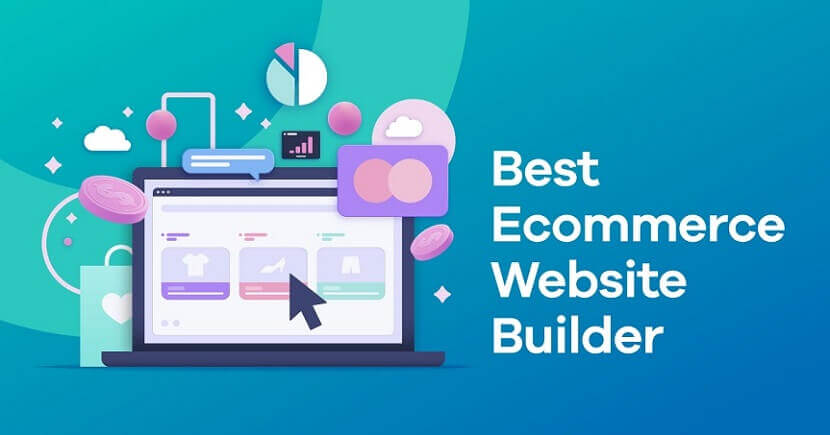
Introduction of eCommerce Website Builder
An eCommerce website builder is a powerful tool that enables individuals and businesses to create and manage their own online stores without extensive technical knowledge. It provides a user-friendly interface, pre-designed templates, and integrated features for setting up product listings, managing inventory, processing payments, and handling shipping. With an eCommerce website builder, users can customize the design of their online stores, optimize them for search engines, and leverage various marketing tools to attract and engage customers. These platforms offer a cost-effective and efficient solution for establishing a professional online presence and tapping into the vast potential of the eCommerce market.
Table of Article Contents
- Top 10 eCommerce Website Builder
- Key Features and Benefit of eCommerce Website Builder
- Pros and Cons of eCommerce Website Builder
- Paid V/S Free eCommerce Website Builder
- FAQs
- Conclusion
Top 11 eCommerce Website Builder
Here are the top 10 eCommerce website builders.
1. Shopify:Shopify is one of the most popular and widely used eCommerce website builders. It offers a user-friendly interface, a wide range of templates, and robust features to build and manage an online store.
2. BigCommerce: BigCommerce is a scalable eCommerce platform that provides a comprehensive set of features to build and grow an online store. It offers a wide range of customizable templates and integrates with various third-party tools.
3. PrestaShop: PrestaShop is an open-source eCommerce platform that provides a flexible and customizable solution for building online stores. It offers a range of features, modules, and templates.
4. Squarespace:Squarespace is a popular website builder that includes eCommerce functionality. It offers visually appealing templates and a user-friendly interface to create and manage an online store.
5. Renderforest AI Website Builder: Renderforest offers an AI-driven website builder specifically for creating polished and efficient online platforms quickly. Ideal for those looking to streamline the design process, it features a host of templates and tools that adapt to your content, making it easier to launch a professional website with minimal effort.
6. Volusion: Volusion is a comprehensive eCommerce platform that provides tools for building and managing an online store. It offers customizable templates, marketing tools, and various integrations.
7. WooCommerce:WooCommerce is a powerful plugin for WordPress that allows you to turn your WordPress website into a fully functional eCommerce store. It offers a wide range of themes and extensions to customize your online store.
8. 3dcart:3dcart is a feature-rich eCommerce platform that caters to businesses of all sizes. It offers a wide range of customizable templates, SEO tools, and integrations to create a successful online store.
9. Weebly:Weebly is a beginner-friendly website builder that includes eCommerce capabilities. It offers a drag-and-drop interface, mobile-responsive templates, and various features for building an online store.
10. Magento:Magento is an open-source eCommerce platform known for its scalability and flexibility. It offers a wide range of features and customization options for building robust online stores.
11. Wix:Wix is a versatile website builder that offers eCommerce functionality. It provides a drag-and-drop interface, a variety of templates, and a range of features to create an online store.
Key Features and Benefits of eCommerce website builders
1. User-friendly interface: Website builders offer intuitive interfaces that allow users to easily create and customize their online stores. They often use drag-and-drop functionality, enabling users to add and arrange elements on their webpages without any coding knowledge.
2. Templates and design customization: eCommerce website builders offer a range of professionally designed templates to choose from. These templates are customizable, allowing users to personalize their store's appearance, including colors, fonts, layouts, and branding elements, to match their unique style and brand identity.
3. Product management: A website builder provides tools for managing product listings, including adding product descriptions, images, pricing, and inventory tracking. Some builders also offer options for categorizing products, creating variants (e.g., different sizes or colors), and managing product attributes.
4. Payment and checkout integration: Integration with popular payment gateways allows customers to make secure online payments, while offering multiple payment options such as credit cards, PayPal, or other digital wallets. eCommerce website builders often provide pre-built checkout pages and streamlined purchasing processes.
5. Order and inventory management: Builders include features for tracking and managing orders, inventory levels, and shipping. This helps businesses stay organized by providing real-time updates on order status, stock availability, and automated notifications for customers.
6. SEO optimization: Website builders often include built-in SEO tools to optimize your online store for search engines. They provide features such as customizable meta tags, URL structures, and site maps to improve visibility and rankings in search engine results.
7. Mobile responsiveness: With the increasing use of mobile devices for online shopping, eCommerce website builders ensure that websites are mobile-responsive. This means that the design and layout of the store automatically adjust to fit various screen sizes, providing a seamless browsing and shopping experience on smartphones and tablets.
8. Analytics and reporting: Builders offer built-in analytics tools that provide insights into customer behavior, sales data, and website performance. These analytics help store owners make informed decisions and optimize their marketing and sales strategies.
9. Support and security: eCommerce website builders often provide customer support through various channels such as live chat, email, or phone. They also prioritize security measures like SSL certificates and data encryption to protect sensitive customer information and ensure safe transactions.
Pros and Cons of eCommerce Website Builder
Using an eCommerce website builder has its own set of pros and cons. Let's explore them:
Pros:
- User-friendly: Website builders are designed to be intuitive and user-friendly, making it easier for individuals with little to no technical skills to create and manage their online stores.
- Cost-effective: Compared to hiring a professional web developer or agency, using an eCommerce website builder is often more affordable. Many builders offer cost-effective plans and eliminate the need for extensive custom coding.
- Quick setup: Website builders provide pre-designed templates and drag-and-drop functionality, allowing you to quickly set up your online store without starting from scratch. This can save you significant time and effort.
- Customization options: eCommerce website builders typically offer a range of customizable templates and design options, allowing you to create a unique and branded store that suits your business needs.
- Integrated features: Builders often come with built-in features like inventory management, order tracking, payment gateways, and shipping integrations. These features streamline the management of your online store and provide a cohesive experience for your customers.
- Updates and maintenance: Website builders usually handle updates, security patches, and maintenance, so you don't have to worry about technical aspects or backend management.
Cons:
- Limited customization: While website builders offer customization options, they may have limitations compared to custom-coded websites. You might face restrictions in modifying certain design elements or adding complex functionality.
- Template-based designs: Since website builders provide templates, your store's design might not be completely unique. There is a chance that other websites may use the same template, affecting your store's visual distinctiveness.
- Scalability limitations: Some website builders may have scalability limitations as your business grows. If your store experiences significant growth or requires advanced functionality, you might eventually need to migrate to a more scalable platform.
- Dependency on the builder: When using a website builder, you are dependent on the platform's infrastructure and availability. If the provider experiences downtime or discontinues its services, it could impact your store's uptime and accessibility.
- Subscription costs: While website builders offer cost-effective solutions, ongoing subscription costs can accumulate over time. Additionally, some advanced features or integrations may require higher-priced plans or additional fees.
- Less flexibility: If you have specific, unique requirements for your online store, website builders may not always provide the flexibility to fulfill them. Custom coding or advanced development might be necessary, which may not be easily achievable within the builder's framework.
Considering these pros and cons, it's important to assess your specific business needs, technical expertise, and long-term goals when deciding whether an eCommerce website builder is the right choice for you.
Paid V/S Free eCommerce Website Builder
Choosing between a paid and a free eCommerce website builder depends on various factors, including your budget, business needs, and desired level of customization and support. Let's explore the pros and cons of each option:
Paid eCommerce Website Builder:
Pros:
- Advanced features: Paid website builders typically offer more advanced features, integrations, and customization options compared to free options. This can be beneficial if you have specific requirements for your online store.
- Professional support: Paid website builders often provide dedicated customer support, which can be invaluable if you encounter technical issues or need assistance with your online store. They usually offer faster response times and more comprehensive support compared to free platforms.
- Enhanced security: Paid builders often prioritize security measures and provide SSL certificates, data encryption, and regular backups to protect your store and customer data. This can give you peace of mind and help establish trust with your customers.
- Scalability: Paid website builders generally offer scalability, allowing you to handle increased traffic and product catalogs as your business grows. They provide the infrastructure and resources to accommodate higher demand.
- Custom domain: Many paid website builders allow you to use a custom domain name, which helps create a professional and branded online presence.
Cons:
- Cost: The primary drawback of a paid website builder is the cost. You need to factor in the ongoing subscription fees and any additional costs for premium features, themes, or integrations. This might be a concern, especially for businesses with tight budgets.
- Learning curve: While paid website builders aim to be user-friendly, some platforms may have a steeper learning curve compared to free options. You may need to invest time in understanding the platform and its features.
Free eCommerce Website Builder:
Pros:
- Cost savings: Free website builders eliminate the upfront costs associated with building an online store. This makes them an attractive option for budget-conscious businesses or those starting out with limited resources.
- Quick setup: Free website builders usually provide ready-made templates and drag-and-drop functionality, allowing you to quickly set up your online store without much technical knowledge or coding.
- Basic functionality: If you have simple eCommerce needs, a free website builder can often provide the essential features required to get your store up and running. This includes product listings, payment options, and basic inventory management.
Cons:
- Limited features: Free website builders typically have limitations in terms of available features, customization options, and integrations. Advanced functionality and specialized features may be absent or available only with paid upgrades.
- Branding and advertisements: Some free website builders may display their branding or advertisements on your website, which can detract from your store's professionalism and brand image.
- Support limitations: Free platforms usually offer limited customer support, which means you may have to rely on community forums or self-help resources for troubleshooting or assistance.
- Custom domain restrictions: Free website builders often provide a subdomain for your store (e.g., yourstore.freewebsitebuilder.com) instead of a custom domain, which may impact the perception of your business.
Ultimately, the decision between a paid and a free eCommerce website builder depends on your specific needs, budget, and long-term goals. If you require advanced features, scalability, and professional support, a paid builder may be worth the investment. However, if you have simple requirements and want to minimize costs, a free builder could be a suitable option. Assess your priorities and evaluate the available options to make an informed decision.
FAQs - eCommerce Website Builder
Certainly! Here are some frequently asked questions (FAQs) about eCommerce website builders:
1. What is an eCommerce website builder?
Answer : An eCommerce website builder is a platform or tool that enables individuals or businesses to create and launch their own online stores without extensive coding or technical expertise. It provides pre-designed templates, drag-and-drop functionality, and integrated tools for managing products, payments, and shipping.
2. Do I need coding skills to use an eCommerce website builder?
Answer : No, coding skills are generally not required when using an eCommerce website builder. These platforms offer user-friendly interfaces and drag-and-drop functionality, allowing users to create and customize their online stores without writing code.
3. Can I customize the design of my online store?
Answer : Yes, eCommerce website builders typically provide customizable templates and design options. You can personalize the appearance of your online store by selecting colors, fonts, layouts, and adding your branding elements to match your unique style and brand identity.
4. Can I sell physical and digital products with an eCommerce website builder?
Answer : Yes, most eCommerce website builders support the sale of both physical and digital products. They provide features for managing product listings, descriptions, pricing, and inventory tracking. Some builders also offer options for selling services or memberships.
5. How do I accept payments on my online store?
Answer : eCommerce website builders integrate with various payment gateways, allowing you to accept secure online payments from customers. Popular payment options include credit cards, PayPal, and other digital wallets. You will need to set up an account with the chosen payment gateway and connect it to your online store.
6. Can I track inventory and manage orders with an eCommerce website builder?
Answer : Yes, eCommerce website builders typically provide inventory management features that allow you to track product availability, set stock levels, and receive notifications for low inventory. They also offer order management tools to track and fulfill customer orders.
7. Can I optimize my online store for search engines?
Answer : Yes, many eCommerce website builders offer built-in SEO tools to optimize your online store for search engines. These tools include options for customizing meta tags, URLs, and sitemaps to improve your store's visibility and rankings in search engine results.
8. Can I get support if I have issues or questions?
Answer : Most eCommerce website builders provide customer support through various channels such as live chat, email, or phone. They often have extensive documentation, tutorials, and community forums to help users troubleshoot issues or find answers to their questions.
9. Can I switch eCommerce website builders later?
Answer : Yes, it is possible to switch eCommerce website builders, although the process may involve migrating your store's data and settings to the new platform. It's important to carefully evaluate your needs and research the migration process before making a switch.
10. How much does an eCommerce website builder cost?
Answer : The cost of an eCommerce website builder varies depending on the platform and the plan you choose. Prices can range from free (for limited features) to monthly or annual subscription fees that can vary based on features, storage, and transaction fees. Some builders also offer premium plans with additional features or enterprise-level options for larger businesses.
Conclusion
In conclusion, eCommerce website builders provide an accessible and convenient solution for creating and managing online stores. They offer user-friendly interfaces, customizable templates, and integrated features that simplify the process of establishing an online presence. Shopify, WooCommerce, BigCommerce, Wix, and Squarespace are among the top choices, each with their own strengths and suitability for different needs. It's essential to consider factors like ease of use, customization options, scalability, pricing, support, and integrations when selecting the right eCommerce website builder. By making an informed decision and continually optimizing your online store, you can create a successful and professional eCommerce business.
If you found this article helpful, we encourage you to share it on your social media platforms—because sharing is caring! For more information about article submissions on our website, feel free to reach out to us via email.
Send an emailWritten by RGB Web Tech
Latest Technology Trends
Latest technology trends shaping the future, including AI advancements, blockchain innovation, 5G connectivity, IoT integration, and sustainable tech solutions. Explore breakthroughs in quantum computing, cybersecurity, augmented reality, and edge computing. Stay ahead with insights into transformative technologies driving innovation across industries and revolutionizing how we live, work, and connect.
10 Best Practices for Secure Online Payment Processing
Last updated on January 19, 2025 by RGB Web Tech
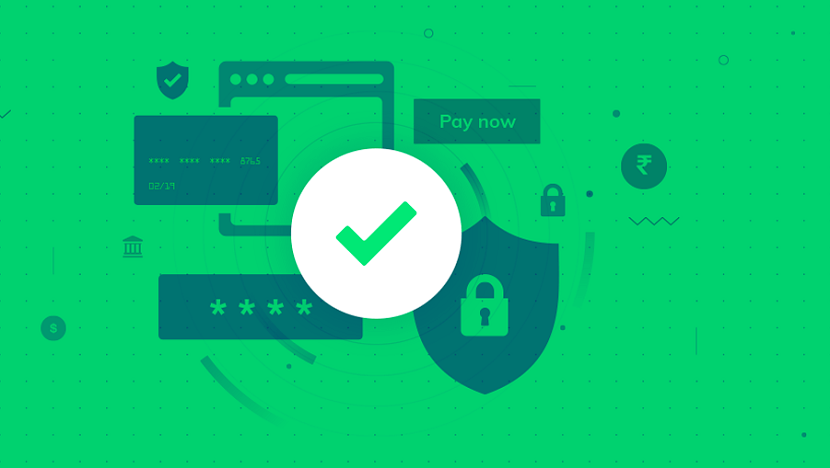
Learn how secure online payment processing protects your customers and business from risk and fraud.
There are so many brands and businesses selling products and services online. This makes it easy for customers or consumers to have access to varying choices when they want to make purchases. Customers need the assurance that when they share their payment details online in an e-commerce store their details will not be compromised.
However, hackers are constantly looking for ways to steal the banking and payment details that are shared on websites. It makes it increasingly important for e-commerce owners to ensure that payment processing is secure and that customers’ data are not breached because doing so will lead to a dent in the brand’s reputation. Therefore, we will be sharing with you the 10 best practices that you can implement for secure online payment processing. They include:
1. Match the IP and Billing Address Information
During online payment processing, matching the IP and billing address information is frequently done because it helps to prevent fraud and ensure that the payment is secure. To match the IP and billing address information, customers must first input their billing information while making the payment online; this includes details like their address, city, state, country, and postal code. While this is being input, the IP address of the customer will be simultaneously captured. This IP address is usually a numerical label that has been given to the customer’s device once connected to the internet. With the help of geolocation services, the billing and IP address will be compared to see if it matches. Where this does not match, there is a possibility that it is a fraud and the customer can be notified. Including matching IP address and billing address helps secure online payment processing for both the e-commerce store and the customer shopping.
2. Encrypt Data
Another best practice for secure online payment processing is by encrypting data. With the use of TLS and SSL on the websites, data can be encrypted which makes it difficult or impossible for hackers to access the data and make use of it.
The benefit of using an SSL certificate is that customers can share data securely with a website while trying to make online payments. This data can be the card number, pin, CVV codes, expiration date, and other information that if it falls into the wrong hands, can be bad. Here, SSL can be either domain validated, extended validated (EV) or organization validated (validation types). It depends upon the type of SSL certificate that a payment process has in built. Most payment processors go with an EV SSL certificate that provides the highest authentication and security. Many resellers offer low priced or cheap EV SSL certificate in the market.
When a customer’s browser and your company’s website server want to communicate data between both ends, no hacker can intercept that data. It also ensures there is no interception or decryption of data that is shared with you.
3. Use Payment Tokenization
With the use of payment tokenization, payment processing is made secure. How this works is that immediately the card details are inputted on the seller’s server, and a unique token is assigned to it and used while processing the transaction. This token is often randomly generated and a reference is made between the card details and generated token to keep it safe. Therefore, when this token is being communicated to the seller’s server, the seller cannot see the original information on the card detail, but can only see the payment token. So, it becomes impossible for hackers to access the original card details because of the payment token.
4. Require Strong Passwords
Ask your customers to input strong passwords when they want to sign into the payment option of their website. The password should not be something that can be easily guessed by hackers like the birthdates of the customer or that of their loved ones. It is better if the password is something randomly generated but strong. A strong password is usually eight characters long and made up of numbers, alphabets, and symbols. There are times that up to eight characters may not be accepted, but you should still use a strong password. It is advisable to have a password manager to store your passwords, and if you ever have to click on the ‘forgot password’ option, ensure that the OTP that will be sent is to your email address or the phone number you are currently using.
5. Implement 3D Secure
You have to choose a payment service provider (PSP) that supports and allows 3D secure, because it will help to secure payment processing. When you settle on the PSP, you have to sign up and fully get on to make use of it and that will involve supplying relevant data like business name and banking information. With the 3D secure fully integrated on your website, each time a customer provides their card details to make payments, the request for payment and the cardholder's data will be sent directly to your payment service provider's API.
If their card is enrolled in 3D secure, a redirect URL will be given to them to initiate the 3D secure authentication process where they will be asked to enter a one-time password (OTP). After the customer inputs the OTP, he will be directed to the website to complete the payment process. Some cards are not enrolled in 3D secure and it is usually a bit good because of the high risk and the potential of hackers accessing the data. So, implementing 3D secure will help to secure payment processing.
6. Request the CVV
CVV stands for card certification value. It is usually made up of 3 or 4 digits and at the back of a credit card. Ecommerce store owners have seen and agreed with the need of asking customers to input this CVV code for secure online payment processing. The benefit of customers inputting the CVV is to prevent fraudulent transactions because even when someone can access your payment details if they do not have your card, they will not be able to add the CVV hence the payment transaction will not go through.
7. Use Strong Customer Authentication (SCA)
Based on your state or country, there are different strive customer authentication (SCA) guidelines or procedures that you can make use of to secure payment processing. There are certain monetary thresholds that when it is exceeded, you have to make use of SCA. Therefore, on your website, you have to make use of two-factor authentication, and appropriate authentication methods, which can involve you including third parties, authentication methods on your website.
SCA methods are constantly evolving so for the benefit of your customers you should keep abreast with it and educate your customers on setting up authentication methods and its importance. When your customers have an idea and implement authentication methods, it makes it easier for you both to work together towards securing payment processing.
8. Monitor Fraud Continuously
To monitor fraud for secure online payment processing, you have to make use of real-time monitoring and proactive measures to watch out for this fraud. There are fraud detection tools, address verification systems (AVS), two-factor authentication, chargebacks and refunds, data analysis, and other things you can do to monitor fraud. If you want to monitor fraud in real time, you have to employ a data analyst who can go through all incoming data. Spending the time and resources to do this will help you spot fraudulent activities and any form of hacking attempt during payment processing.
9. Manage PCI Compliance
As an e-commerce store owner or any person who is accepting credit card payments online, you have to comply with Payment Card Industry Data Security Standards (PCI DSS). The standards that must be covering protecting the data of customers and credit cards being used on your website. It ensures that some security systems and networks have been built, and regularly looks out for malicious software that tries to access your website or data. The team should look for who can access sensitive data on your website, each time you notice unauthorized access quickly take notice of it and put a security system in place to prevent an attack and if there is an attack, try to respond immediately to rectify it. Doing all these will help secure online payment processing for your business and customers.
10. Train Employees
Securing payment processing is the work of customers, e-commerce store or website owners, and employees. When your employees are trained on how to secure online payment processing, it will help minimize payment insecurities and hackers accessing sensitive data. So, teach your employees to log out of their accounts when they leave their workstations, not keep work USB drives unattended, and watch out for phishing emails or spam so that they do not click on them. They should not give anyone their accounts or log in details to prevent unauthorized access to their information. Employees should frequently keep abreast of how to secure payment processing.
Rapyd Offers Built-In Payment Fraud Protection with Advanced Features, which will be beneficial to your website or e-commerce stores each time someone wants to make a payment. Additionally, you can download the useful guide: How to Reduce Your Payment Risks for Cross-Border e-commerce. This guide will help you need to secure online payment processing. Know that you can keep or lose your customers online based on the security measures you implement to process payments.
Conclusion
Securing online payment processing is important for a business or brand that does not want to lose customers' data and harm their brand's reputation in the process. So, as an e-commerce store owner, make use of these 10 steps to secure payment processing. Do not fail to keep abreast with relevant and innovative ways to secure payment processing online.
If you found this article helpful, we encourage you to share it on your social media platforms—because sharing is caring! For more information about article submissions on our website, feel free to reach out to us via email.
Send an emailWritten by RGB Web Tech
Latest Technology Trends
Latest technology trends shaping the future, including AI advancements, blockchain innovation, 5G connectivity, IoT integration, and sustainable tech solutions. Explore breakthroughs in quantum computing, cybersecurity, augmented reality, and edge computing. Stay ahead with insights into transformative technologies driving innovation across industries and revolutionizing how we live, work, and connect.
Image SEO : How to Optimize Images for the Web
Last updated on January 19, 2025 by RGB Web Tech

Image SEO, or Search Engine Optimization, is the practice of optimizing images to enhance a website's visibility and ranking in search engine results pages (SERPs). It involves various strategies aimed at making images more accessible and understandable to search engine algorithms. This includes optimizing image filenames, alt text, captions, and descriptions with relevant keywords. Additionally, image size and format optimization, as well as proper use of structured data markup, contribute to better image SEO. Effective image SEO not only improves website visibility but also enhances user experience by providing visually appealing and relevant content in search results.
What is Image SEO?
Image SEO, or Image Search Engine Optimization, refers to the process of optimizing images on a website to improve their visibility and ranking in search engine results pages (SERPs). It involves various techniques and best practices aimed at making images more accessible, understandable, and relevant to search engine algorithms.
Image SEO Techniques
Image SEO encompasses various techniques to optimize images for search engines and enhance their visibility. Here are some effective techniques:
- Optimize Image File Names: Use descriptive filenames that include relevant keywords related to the image content. For example, instead of "IMG_1234.jpg," use "red-rose-bouquet.jpg."
- Utilize Alt Text: Add concise and descriptive alt text to describe the image content accurately. Alt text helps search engines understand the context of images and improves accessibility for users with disabilities.
- Compress Images: Reduce image file sizes by compressing them without compromising quality. Smaller file sizes improve page loading speed, which is crucial for both user experience and SEO.
- Choose the Right Image Format: Use appropriate image formats such as JPEG, PNG, or WebP based on the content and purpose of the image. WebP offers better compression and quality compared to JPEG and PNG.
- Optimize Image Size: Resize images to match the dimensions required on your website. Avoid using oversized images that slow down page loading times.
- Implement Responsive Images: Use responsive design techniques to ensure images adapt to different screen sizes and devices, providing an optimal viewing experience for users on various devices.
- Include Captions and Descriptions: Add captions and descriptive text near images to provide additional context and improve user engagement. Search engines may also use this information to understand the image content better.
- Utilize Structured Data Markup: Implement schema markup for images to provide search engines with more information about the image, such as the subject, location, or author. This helps search engines display rich snippets in search results.
- Image Sitemap: Create an image sitemap and submit it to search engines to ensure all images on your website are indexed properly.
- Optimize Thumbnail Images: If your website uses thumbnail images, ensure they are optimized for both SEO and user experience. Use descriptive filenames and alt text for thumbnails as well.
FAQs - Image SEO
Certainly! Here are some frequently asked questions (FAQs) about Image SEO:
1. What is Image SEO?
Answer : Image SEO, or Image Search Engine Optimization, refers to the process of optimizing images on a website to improve their visibility and ranking in search engine results pages (SERPs).
2. Why is Image SEO important?
Answer : Image SEO is important because it helps improve the visibility of images in search engine results, driving organic traffic to your website. It also enhances user experience by ensuring faster loading times and providing relevant image content.
3. What are some key elements of Image SEO?
Answer : Key elements of Image SEO include optimizing image file names, adding descriptive alt text, compressing images for faster loading times, choosing the right image format, and implementing structured data markup.
4. How do I optimize image file names for SEO?
Answer : Optimize image file names by using descriptive filenames that include relevant keywords related to the image content. Avoid generic filenames like "IMG_1234.jpg" and instead use descriptive names like "red-rose-bouquet.jpg."
5. What is alt text, and why is it important for Image SEO?
Answer : Alt text is a brief description of an image that is displayed when the image cannot be loaded or viewed. It is important for Image SEO because search engines use alt text to understand the context of images and improve accessibility for users with disabilities.
6. How can I improve the loading speed of images on my website?
Answer : You can improve the loading speed of images by compressing them without sacrificing quality, optimizing image size, choosing the right image format, and implementing responsive design techniques.
7. Should I use thumbnails on my website, and how can I optimize them for SEO?
Answer : Thumbnails can be useful for displaying images in a compact format, but they should be optimized for SEO. Use descriptive filenames and alt text for thumbnails, and ensure they are appropriately sized and compressed for faster loading times.
8. What role does structured data markup play in Image SEO?
Answer : Structured data markup provides search engines with additional information about the images on your website, such as the subject, location, or author. This helps search engines understand the image content better and may result in rich snippets displayed in search results.
Conclusion of Image SEO
In conclusion, Image SEO is a vital aspect of optimizing websites for search engines and enhancing user experience. By implementing techniques such as optimizing image file names, adding descriptive alt text, compressing images, and utilizing structured data markup, websites can improve the visibility and relevance of their images in search engine results. Image SEO not only drives organic traffic to websites but also ensures faster loading times and better accessibility for all users. By prioritizing image optimization alongside traditional SEO practices, website owners can create a more engaging and effective online presence, ultimately leading to increased visibility, traffic, and conversions.
If you found this article helpful, we encourage you to share it on your social media platforms—because sharing is caring! For more information about article submissions on our website, feel free to reach out to us via email.
Send an emailWritten by RGB Web Tech
Latest Technology Trends
Latest technology trends shaping the future, including AI advancements, blockchain innovation, 5G connectivity, IoT integration, and sustainable tech solutions. Explore breakthroughs in quantum computing, cybersecurity, augmented reality, and edge computing. Stay ahead with insights into transformative technologies driving innovation across industries and revolutionizing how we live, work, and connect.
How to Choose the Best Programmatic Ad Platforms for Your Strategy
Last updated on January 19, 2025 by RGB Web Tech

In today's digital world, programmatic advertising has become essential to any successful marketing strategy. This automated method allows advertisers to reach targeted audiences with precision and efficiency. However, with the plethora of programmatic ad platforms available, choosing the right one for your needs can be overwhelming. In this post, we will explore key factors to consider when selecting a programmatic ad platform, ensuring you make an informed decision. So, read on and gain valuable insights from professionals who are well-versed in the art of programmatic ad platforms.
1. Understanding Programmatic Advertising
Before diving into the selection process, let's briefly understand what programmatic advertising entails. Essentially, it refers to automated buying and selling instead of digital ads in real-time using algorithm-based decisions. It streamlines the ad-buying process across multiple platforms and publishers, enabling marketers to optimize their campaigns more effectively.
2. Identify Your Advertising Goals
To select the best programmatic ad platforms for your strategy, it is crucial to define your advertising goals clearly. Consider whether you aim to increase brand awareness, drive website traffic, generate leads, or boost conversions. Understanding your objectives will help you identify which features and functionalities are critical for success.
3. Compatibility with Your Target Audience and Channels
Every business has its unique target audience and preferred channels for engagement. While evaluating programmatic ad platforms, prioritize those that align seamlessly with your target demographics and channels. Check if they offer targeting options such as age group, gender, location targeting, and interest-based targeting data segments – all essential for reaching your ideal customers.
4. Transparency in Data Insights
Data plays a pivotal role in optimizing advertising campaigns. Ensure that your chosen platform provides comprehensive data insights that allow you to track performance at various levels—from campaigns to individual placements or creative elements. Transparent reporting will enable you to measure campaign success accurately and make data-driven decisions regarding future optimizations.
5. Ad Inventory Quality
Not all programmatic ad platforms provide access to high-quality ad inventory. To safeguard your brand reputation, assess the platform's inventory partners and ensure they align with your brand standards. Look for platforms that offer ad verification tools and inventory quality controls.
6. Advanced Targeting Capabilities
Effective targeting is crucial for campaign success. Consider platforms that offer advanced targeting capabilities, such as contextual, device-specific, or behavior-based targeting. Reaching the right audience at the right time significantly enhances campaign performance and ROI.
7. Ad Formats and Creative Customization
Diversifying your ad formats can help you better engage with your audience. Assess whether the programmatic ad platform supports a wide range of ad formats, such as display ads, video ads, native ads, or even emerging formats like OTT (Over-The-Top) advertising. Additionally, evaluate whether the platform allows creative customization options to stay consistent with your brand identity.
8. Support and Account Management
When investing in a programmatic ad platform, it is essential to consider the platform provider's level of support and account management. Check whether they have a dedicated support team to assist you whenever needed. Clear communication channels alleviate any roadblocks while maximizing the effectiveness of your campaigns.
9. Pricing Structure
Programmatic advertising offers various pricing models, such as cost per thousand (CPM), cost per click (CPC), and cost per acquisition (CPA). Understand the pricing structure offered by different platforms and assess which model best suits your budget and marketing goals. Remember that pricing transparency should be a key factor when comparing options.
Conclusion
Selecting a programmatic ad platform that aligns with your advertising goals is imperative for delivering successful campaigns. By assessing factors such as compatibility with target audiences, transparency in data insights, quality of ad inventory, advanced targeting capabilities, customizable creative options, excellent customer support, and suitable pricing structures - you will be well-equipped to make an informed decision on choosing the best programmatic ad platform for your strategy. Remember to continually evaluate and optimize your campaigns as you progress, ensuring the utmost effectiveness in reaching your business objectives.
If you found this article helpful, we encourage you to share it on your social media platforms—because sharing is caring! For more information about article submissions on our website, feel free to reach out to us via email.
Send an emailWritten by RGB Web Tech
Latest Technology Trends
Latest technology trends shaping the future, including AI advancements, blockchain innovation, 5G connectivity, IoT integration, and sustainable tech solutions. Explore breakthroughs in quantum computing, cybersecurity, augmented reality, and edge computing. Stay ahead with insights into transformative technologies driving innovation across industries and revolutionizing how we live, work, and connect.
Transforming Retail Spaces with Interactive Digital Signage
Last updated on January 19, 2025 by RGB Web Tech

Retailers today need to do more with less and maximize the value of every square foot of their stores.
One of the best ways to accomplish this is through the use of interactive digital signage solutions.
Using the latest in top digital signage software and hardware technology, it’s possible to create engaging, interactive and personalized customer experiences that will delight visitors and increase revenue.
Interactive Digital Signage
Interactive digital signage goes beyond traditional static displays by incorporating elements like touchscreens and motion-detecting sensors, allowing customers to actively engage with the information presented.
Modern cloud server digital signage software enables instant updates and customization of media across multiple locations.
| Interactive Element | Examples and Uses |
|---|---|
| Touchscreens | 1. Product Information Stations:Shoppers can tap product images to read detailed descriptions, view specs, and see customer reviews. 2. Self-Service Kiosks:Customers can check prices, search for product availability, and locate items within the store. 3. Ordering Systems:In restaurants and quick-service locations, touchscreens allow customers to customize orders and complete the checkout process themselves. 4. Wayfinding Displays:Large touchscreen maps help visitors navigate large retail spaces like malls or department stores. |
| Motion Sensors | 1. Entrance Displays: Motion-triggered welcome messages or promotions displayed as customers enter the store, creating an inviting atmosphere. 2. Interactive Showcases:As a customer approaches a merchandise display, information about the product is automatically shown on nearby screens. |
| QR Codes for Mobile Integration | 1. Product Details:Customers scan QR codes beside products to access extensive details, how-to videos, ingredient lists, and user guides on their mobile devices. 2. Digital Coupons: Instantly apply discounts or special offers directly from their phones by scanning QR codes on in-store signage. 3. Loyalty Programs:Quick sign-up for loyalty programs or integration with existing digital accounts for personalized shopping experiences. 4. Surveys and Feedback: Conduct instant surveys to gather customer feedback through easily accessible mobile interfaces. |
| Interactive Kiosks | 1. Virtual Fitting Rooms: Customers can simulate trying on clothes using AR technology in fashion stores, minimizing the need for physical fitting rooms. 2. Check-In Points:In service environments like airports or hotels, kiosks streamline check-ins or reservations. 3. Feedback and Surveys:Easily collect customer opinions right after their shopping experience with dedicated feedback kiosks. |
While the cost is often substantial, interactive digital signage solutions simply offer advantages impossible for more traditional means.
Such a digital approach:
- Captures customer attention more effectively
- Enhances shopping experience with engaging content
- Allows for actions like entering contests or giving feedback
Level of Customer Engagement
Strategically placed digital signage enhances customer engagement by embedding interactivity within the shopping journey.
Powered by the best systems on the market, touchscreens at key points allow shoppers to dig deep into product details, including specifications, user reviews, video demos, and even compare different models without needing assistance from sales staff.
This self-service approach helps consumers to make confident purchase decisions while creating an enriching shopping atmosphere.
Moreover, integrating augmented reality (AR) features can revolutionize the retail experience. In the home decor and furniture stores, AR applications let customers visualize products within their own living spaces.
This capability drastically reduces uncertainty and returns, as buyers can better assess whether a piece fits both stylistically and spatially in their home environment.
Key engagement strategies:
- Information-rich touchpoints at product displays
- Interactive style recommendations based on customer data
- Loyalty program integration for personalized offers
- Event-driven content updates (sales, holidays)
Such dynamic approaches encourage not just browsing but active participation, further enhancing dwell time and increasing the likelihood of purchase.
Additionally, personalized messages and recommendations driven by past purchasing behavior ensure that each customer's interaction feels unique and valued.
Cloud Server Digital Signage
Adopting cloud server digital signage is a strategic move for retailers aiming to simplify operations while offering customizable customer experiences.
Cloud-based systems enable centralized management, allowing owners to update content across multiple stores simultaneously from any location.
Of course, cloud-based digital signage has other advantages that go beyond just operating everything from one location:
- Cost efficiency: Reduces the need for manual updates and physical infrastructure.
- Rapid content deployment: Timely changes for timely needs, such as holiday promotions or flash sales.
- Scalability: Easily adaptable to new locations without extensive setup.
Another standout feature of cloud-based solutions is their capacity for data integration, which can yield highly tailored experiences.
In simple terms, the data pulled from customer accounts can be synced with digital signage software to offer personalized content.
For instance, the system can display loyalty points, recommend products based on purchase history, or highlight ongoing promotions that align with a customer's preferences.
Additionally, integrating external data sources such as weather forecasts can dynamically alter displays to show relevant products - like umbrellas on rainy days - further personalizing the shopping environment.
Track Performance
The ability to track performance through interactive digital signage offers substantial benefits for retailers aiming to optimize their marketing strategies.
Detailed analytics provide insights into customer interactions - such as which call-to-action buttons are most effective or which types of content drive longer engagement times.
This data is invaluable for refining marketing efforts and improving overall efficacy of the digital signage strategy.
Other key metrics that can be effortlessly tracked include:
- Click-through rates on interactive elements
- Dwell time on displayed content
- Conversion rates from interaction to purchase
- Popularity metrics of different types of showcased products
Comprehensive analytics dashboards offered by cloud server digital signage platforms can compile these metrics into easy-to-understand reports that highlight key performance indicators.
The continuous feedback loop generated by this data allows businesses to iterate quickly and improve user experiences consistently. All of which has a positive effect on sales and customer satisfaction.
The Future is Bright
Interactive digital signage is set to become even more influential as associated technologies evolve.
Artificial intelligence (AI) and machine learning will play increasingly significant roles in optimizing customer experiences based on behavioral data analysis.
These systems will be capable of adjusting content dynamically in response to real-time shopper behaviors, further tailoring the shopping experience.
The incorporation of Internet of Things (IoT) devices can transform regular stores into smart stores where everything from lights to interactive screens adjusts according to consumer presence and needs.
- Imagine sensors guiding customers to less crowded aisles or dynamically changing offers based on inventory levels detected by smart shelves.
- Similarly, smart dressing rooms equipped with interactive mirrors could suggest complementary accessories based on items brought into the fitting room.
While this might sound like science fiction as of 2024, customer expectations are constantly rising. Staying ahead by innovating and experimenting will be crucial for long-term success.
Final Thoughts
Interactive digital signage offers a multifaceted solution, merging cutting-edge technology with practical functionality to transform the shopping experience.
Investing in cloud server digital signage helps retailers create deeply personalized and engaging customer journeys that can adapt in real-time to shopper behaviors and external data.
Moreover, the integration of advanced technologies such as AI, machine learning, and IoT devices promises even greater possibilities for enhancing customer interaction and operational efficiency.
These tools enable a level of personalization and immersion that traditional retail methods simply cannot match - from helping customers visualize products in their living spaces to providing real-time product recommendations based on purchasing history.
As we look ahead, we can safely say that the future of retail is undoubtedly digital, interactive, and intelligent.
If you found this article helpful, we encourage you to share it on your social media platforms—because sharing is caring! For more information about article submissions on our website, feel free to reach out to us via email.
Send an emailWritten by RGB Web Tech
Latest Technology Trends
Latest technology trends shaping the future, including AI advancements, blockchain innovation, 5G connectivity, IoT integration, and sustainable tech solutions. Explore breakthroughs in quantum computing, cybersecurity, augmented reality, and edge computing. Stay ahead with insights into transformative technologies driving innovation across industries and revolutionizing how we live, work, and connect.
Innovative Ways AI is Transforming Everyday Life
Last updated on January 19, 2025 by RGB Web Tech

Artificial Intelligence (AI) is no longer confined to the realms of science fiction—it is an integral part of our daily lives, subtly enhancing the way we work, live, and interact with the world. From healthcare to agriculture and retail, AI is driving innovations that make everyday tasks more efficient, precise, and enjoyable. Here’s an in-depth look at how AI is transforming everyday life across various industries.
1. Autonomous Vehicles: Redefining Mobility
Self-driving cars and drones represent one of the most visible examples of AI innovation. Companies like Tesla and Waymo use AI for advanced navigation, obstacle detection, and safety measures. AI-powered systems analyze vast amounts of data from sensors and cameras to make real-time decisions, ensuring safer and more efficient transportation. Drones equipped with AI are not just delivering packages but are also used for mapping, surveillance, and even aiding emergency responders.
2. AI Video Security Systems: Smarter Surveillance
AI-powered video security systems have revolutionized traditional surveillance, bringing an unprecedented level of efficiency and precision. Leveraging advanced AI algorithms, these systems analyse video feeds in real-time, identifying potential threats such as unauthorized access, suspicious behavior, or even environmental hazards like fires.
A prime example is AI NVR (Network Video Recorder) technology, which goes beyond passive monitoring. It actively analyzes footage, detects anomalies, and triggers instant alerts to ensure timely responses. This advanced capability is particularly vital for securing high-risk areas such as airports, financial institutions, and critical infrastructure facilities, where proactive threat detection is essential.
3. Smart Manufacturing: Efficiency in Factories
In the manufacturing sector, AI-powered robots are streamlining production lines and enhancing precision. Tasks like assembling complex components, quality control, and predictive maintenance are now automated with AI, reducing errors and downtime. Advanced robotics, guided by AI, ensure that factories operate more efficiently and cost-effectively, paving the way for Industry.
4. Healthcare Robotics: Enhancing Patient Outcomes
AI has brought transformative changes to healthcare, especially through robotics. Surgical robots guided by AI assist doctors in performing intricate procedures with unparalleled precision. Rehabilitation devices powered by AI adapt to patients' progress, offering personalized therapy. AI also helps in diagnosing diseases, analyzing medical images, and predicting patient outcomes, making healthcare more proactive and effective.
5. Agriculture Drones: Revolutionizing Farming
Agriculture has embraced AI to address challenges like food security and resource management. AI-powered drones monitor crops, identify pest infestations, and assess soil health, enabling farmers to take timely action. These drones collect data that AI algorithms analyze to optimize irrigation, fertilization, and overall yield, ensuring sustainable farming practices.
6. Smart Traffic Systems: Reducing Urban Congestion
Traffic congestion is a common challenge in urban areas, but AI is providing solutions. Smart traffic systems analyze real-time data from cameras and sensors to manage traffic flow dynamically. AI optimizes traffic light timings and predicts congestion patterns, reducing delays and fuel consumption. Cities like Singapore and Los Angeles are already using AI to improve urban mobility and reduce environmental impact.
7. Retail Automation: A New Shopping Experience
AI is redefining the retail experience through automation. Stores like Amazon Go have introduced cashier-less shopping, where AI tracks items picked up by customers and automatically processes payments. AI-powered recommendation engines provide personalized shopping experiences online and in-store, enhancing customer satisfaction and driving sales.
8. Energy Optimization: Powering Sustainability
The energy sector is leveraging AI to improve efficiency and sustainability. AI predicts energy demand, optimizes power generation, and balances loads on power grids. Renewable energy systems, such as solar and wind, use AI to forecast weather patterns and adjust operations accordingly. These innovations are helping reduce energy waste and promote cleaner alternatives.
9. Construction Robotics: Building the Future
AI is transforming construction by automating labor-intensive tasks. Robotics guided by AI handle tasks like bricklaying, welding, and 3D printing of structures, speeding up the building process and improving precision. AI also aids in planning and monitoring construction projects, ensuring timely completion and cost savings.
10. Home Automation: Smarter Living Spaces
AI has brought intelligence to our homes through devices like smart thermostats, vacuum cleaners, and voice assistants. Products like Roomba adapt to cleaning schedules, while Nest thermostats learn user preferences to optimize energy usage. These devices not only make life more convenient but also contribute to energy efficiency and cost savings.
Conclusion
AI is a silent force driving innovation in everyday life, transforming how we live, work, and interact with the world. From healthcare and transportation to retail and home automation, AI's influence is undeniable. As technology continues to advance, AI will further integrate into our lives, making tasks more efficient and experiences more personalized. This AI-driven evolution holds the potential to solve global challenges and create a smarter, more sustainable future.
If you found this article helpful, we encourage you to share it on your social media platforms—because sharing is caring! For more information about article submissions on our website, feel free to reach out to us via email.
Send an emailWritten by RGB Web Tech
Latest Technology Trends
Latest technology trends shaping the future, including AI advancements, blockchain innovation, 5G connectivity, IoT integration, and sustainable tech solutions. Explore breakthroughs in quantum computing, cybersecurity, augmented reality, and edge computing. Stay ahead with insights into transformative technologies driving innovation across industries and revolutionizing how we live, work, and connect.
Webflow vs WordPress vs Custom Dev: Which Is Best?
Last updated on January 19, 2025 by RGB Web Tech

Comparing Webflow, WordPress, and Custom Development: Which One is Right for You?
Selecting the appropriate web development approach is crucial in establishing a strong online presence. WordPress.org led the global website builder market with over 68% market share as of 2024. On the other hand, no-code Webflow enjoys a smaller market share but is favored by users who require design freedom without writing code. Ultimate control and flexibility are offered by custom development at the expense of huge resources. This article takes these three approaches into account to help you decide on the most appropriate solution for your unique needs.
Webflow: The Power of No-Code Flexibility
Webflow is a no-code web development tool in which designers can design, develop, and deploy websites without writing code. It is more design-oriented than other website builders but also generates clean, production-level code automatically. With its built-in content management system (CMS), hosting, and responsive design features, it is an all-in-one solution for businesses, marketers, and designers. Webflow is a revolutionary site builder that harmonizes the visual and the programming worlds, therefore a healthy substitute for WordPress and coding.
How It Works
Webflow is an online platform that integrates design, development, and hosting as part of a single system. With its visual editor, users can create sites through drag-and-drop interfaces while progressively creating clean HTML, CSS, and JavaScript automatically. The process provides artists with freedom without requiring hand-coding.
The platform includes a native CMS, where dynamic content like blogs, portfolios, and product catalogs can be managed without third-party plugins. Host services are also integrated, with instant load times, security, and auto-scaling without the need for third-party providers.
With responsive design functionality, Webflow causes websites to seamlessly change according to screen sizes, which improves the user experience across any device. While primarily a no-code tool, it is also compatible with custom code, which makes it a flexible tool for those needing greater customization. For a deeper understanding of how Webflow works, you can check out popular Webflow agencies, which offer insights, case studies, and expert guidance on making the most of the platform.
Advantages of Webflow
Some major advantages of utilizing Webflow include:
- User-Friendly Interface: The visual editor provided by Webflow makes web designing easier work, and the activity is now on offer for people with no programming knowledge.
- One-Stop Platform: Webflow integrates design, CMS, and hosting into a single platform, obviating the necessity of multiple tools and integrations.
- No Plugin Dependencies: Contrary to other platforms that rely on third-party plugins, Webflow features built-in functionalities, which reduce the risk of security vulnerabilities and maintenance issues.
- Custom Code Integration: Webflow includes support for integration of custom code for experienced users, with room for particular design and functionality requirements.
- Strong Community Support: There is an active community and plenty of resources, including tutorials and forums, to guide and motivate users at any level.
WordPress: The Industry Standard for Content-Driven Websites
WordPress is one of the most widely used content management systems (CMS), with simplicity that is matched with amazing flexibility in customization. First launched in 2003 as a blogging platform, it soon evolved to become a full system for hosting advanced websites, ranging from e-commerce sites, forums, to business solutions. Its open-source based platform allows users to develop sites without limitations, and with a huge library of plugins and themes available, it is the perfect tool for use in various industries. Small businesses to large businesses, WordPress provides a scalable and versatile platform for developing professional websites.
How It Works
WordPress is an open-source platform through which users are able to design and customize websites from a basic dashboard. It has a massive theme and plugin collection, and web designing and customization is easy without coding. Users can choose between free and paid themes to customize the appearance and feel of their site, and plugins add features such as SEO optimization, integration with e-commerce, analytics, and security enhancement.
Compared to traditional web development, WordPress makes content management easy with an easy-to-use editor that can handle text, images, video, and interactive media. Gutenberg block editor simplifies writing, and the media library enables smooth file management.
For professional users, WordPress also offers the use of custom coding, which facilitates advanced editing via HTML, CSS, JavaScript, and PHP. The WordPress REST API allows developers to incorporate other third-party apps, further broadening the flexibility of the platform. Business and agencies can also host several sites using multisite functionality offered by WordPress.
Benefits of WordPress
Here are some of the key benefits of WordPress:
- User-Friendly Interface – Its basic dashboard makes the website easy to operate, hence making it easily accessible to users of varying technical expertise.
- Increased Customization – It offers thousands of themes and plugins by which users are able to customize their websites as per their needs and demands.
- SEO-Friendly Organization – WordPress is SEO friendly and top-ranked websites on search engines.
- Responsive Design – The themes are all responsive, and websites are displayed well and feel awesome on all devices.
Custom Development: Full Control with Maximum Effort
Custom web development is creating a site from the ground up, tailored specifically to fit an organization's specific requirements. The process is more customizable and flexible than any other process, as organizations are able to create stand-alone features and functions in whatever manner they wish that react specifically to their goals. Although costly and time-consuming, the payoff is an authentic presence on the Internet that exerts power in a hyper-competitive cyberlife.
How It Works
The process of custom web development begins with a thorough examination of the client's needs and goals. Stakeholders collaborate hand-in-hand with developers to outline the architecture, design, and functionality of the site. Developers code using programming languages such as HTML, CSS, JavaScript, and frameworks such as React or Angular to build the front-end and back-end components of the site.
This methodology ensures that every part of the website is developed to perform, be secure, and scale. Continuous testing and quality assurance are part of the development cycle, catching issues and resolving them prior to deployment. Once the site is live, routine maintenance and updates are essential to address shifting business needs and technology changes.
Advantages of Custom Development
Some of the key benefits of opting for custom web development:
- Unique Brand Personality: A website according to your requirements reflects the personality of your brand, which differentiates it from the rest by using generic templates.
- Customizability: Solution-oriented solutions can grow with your company, so it's easy to introduce new features and integrations as needed.
- Optimized Performance: Websites that are personalized and have fewer features will load faster and provide superior user experiences.
- SEO Benefits: By using search engine visibility-optimized site structures and clean code, custom development can enable higher rankings.
- Improved Security: With custom development, it is feasible to include high-level security features that are applicable to your site.
Conclusion
The choice between Webflow, WordPress, and custom development depends on your project needs, technical skills, and long-term goals. Webflow offers a technical no-code solution, which is ideal for designers and marketers who need creative freedom without coding. WordPress, the most widely used CMS, offers themes and plugin flexibility, which is best for content sites and businesses looking for scalability. Custom development provides the most control, with very customized solutions, but is more expensive and time-consuming.
If you found this article helpful, we encourage you to share it on your social media platforms—because sharing is caring! For more information about article submissions on our website, feel free to reach out to us via email.
Send an emailWritten by RGB Web Tech
Latest Technology Trends
Latest technology trends shaping the future, including AI advancements, blockchain innovation, 5G connectivity, IoT integration, and sustainable tech solutions. Explore breakthroughs in quantum computing, cybersecurity, augmented reality, and edge computing. Stay ahead with insights into transformative technologies driving innovation across industries and revolutionizing how we live, work, and connect.






